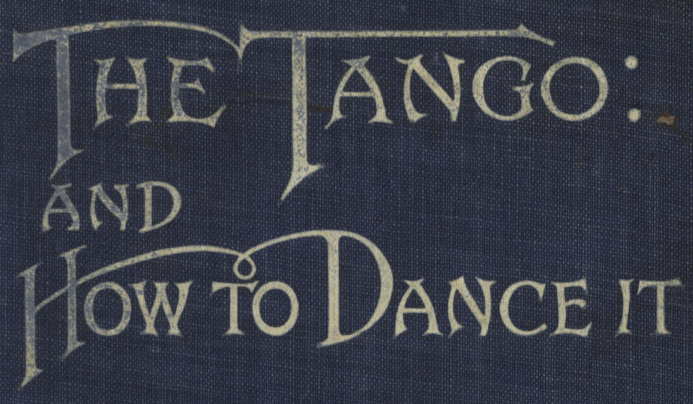

A reconstruction of the dance by
Nick & Melissa Enge
One hundred years later
Note: Due to the illustrations, this page is very large (~ 1 GB)
and may take a while to load depending on your connection.
On this page, you will find our ongoing effort toward a comprehensive reconstruction of the Tango as it was danced during the Tangomania in the early 1910s, when Tango spread from Argentina to the rest of the world. In piecing together this reconstruction, we have drawn from the written descriptions of 50 different Tango teachers from the era, on four continents—Europe, North America, Australia, and of course, South America.
At the top of the page, you will find a brief lexicon of Early Tango variations. The descriptions you will find there are written in shorthand and are meant only as brief reminders of the steps you may have already learned. For more complete reconstructions, and the original sources, scroll down further, or simply click on the linked names (e.g., Crozier), which serve as interactive inline citations. Where available, videos of the variations can be viewed by clicking on the corresponding video icon (e.g., 📽). (Embedded playlists for each family of variations can also be found at the bottom of each section.)
The most complete description of the Tango we have comes from a dance manual entitled El Tango Argentino de Salon: Método de Baile Teórico y Práctico, written by an Argentine, Nicanor Lima, in Buenos Aires, c. 1916. Therefore, in the lexicon below, we will use Lima's version of the Tango from Argentina (which we have previously reconstructed) as a framework for organizing the Tango variations that were danced around the world, including Europe, the United States, Canada, and Australia.*
* With due respect to George W. Salinger and M. Volinen, who wrote dance manuals for Sydney and Melbourne in Australia, we will use the abbreviation "Northern Hemisphere" to refer to this group, which is fair, because both Salinger and Volinen were also originally from "the Continent," i.e., Europe.
Before we describe the individual steps, here's a video that illustrates the basic character of the dance as it was described in the Northern Hemisphere.
For a full song video of Lima's Buenos Aires Tango, visit the page for that source, or simply click here.
The music is "Tango Argentino," composed in 1913 by Arthur Green and performed by Mary Lea and Friends on the CD "Cascade of Tears."
The location is the Elizabethan Room of the Historic Davenport Hotel in Spokane, built in 1914.
In El Tango Argentino, Lima suggests a variety of different dance positions for the Tango, including Closed Position, Parallel Position, Promenade Position, and Counter Promenade Position.
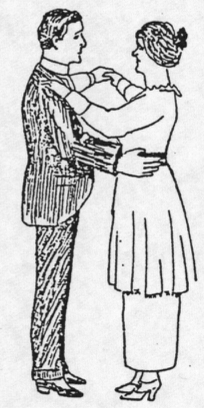
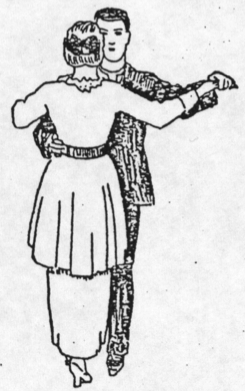

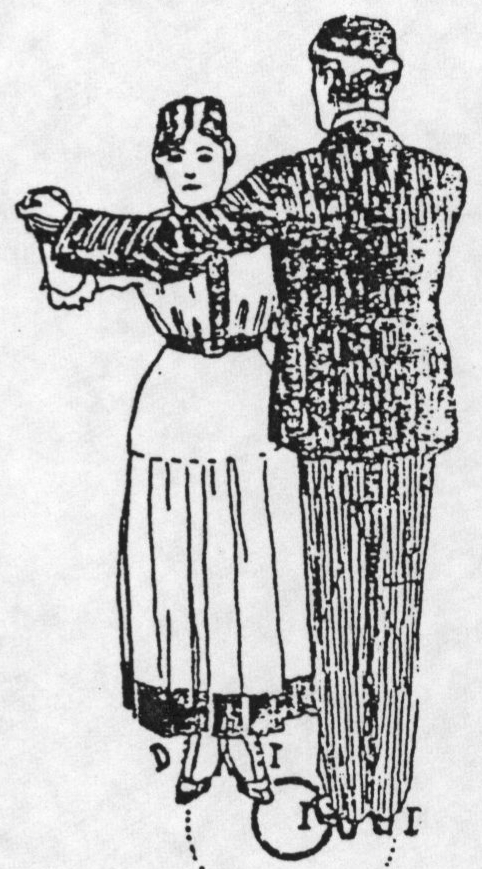
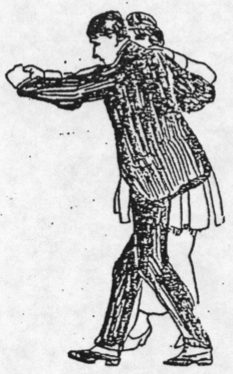
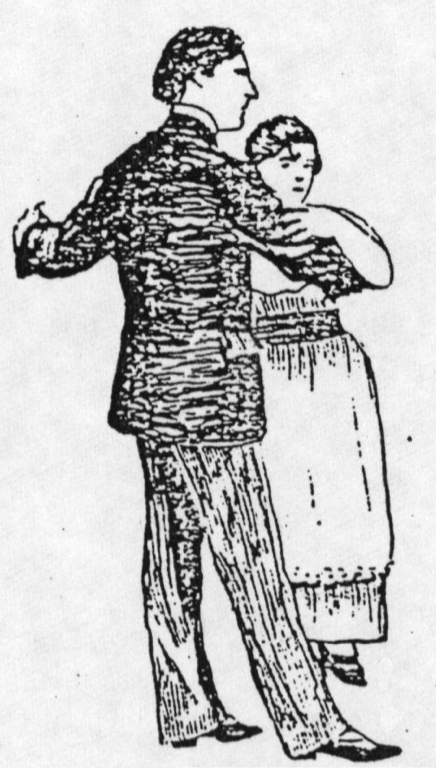
With regard to the positions of the hands, Lima writes that the Lead places his right hand on the Follow's waist, higher than the hip, while the Follow places her left hand on his right shoulder, without resting her elbow on his arm. The Lead holds the Follow's right hand in his left, his palm over her fingers, both hands facing down, at the level of his shoulder, with both arms almost fully extended.
In the Northern Hemisphere, all of these positions were used as well. With regard to the hands, a variety of different positions were suggested. Here is a sampling of representative pictures:
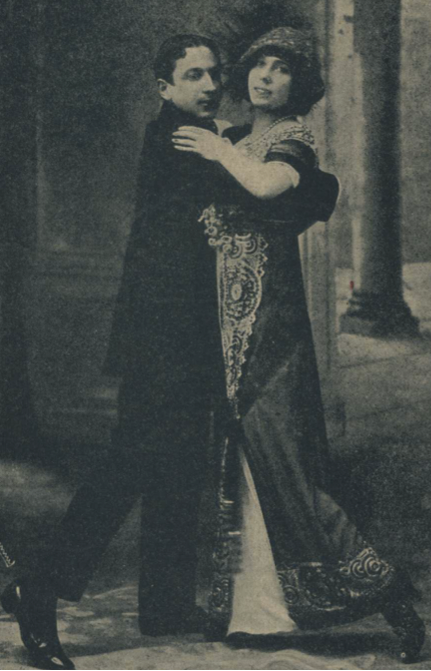
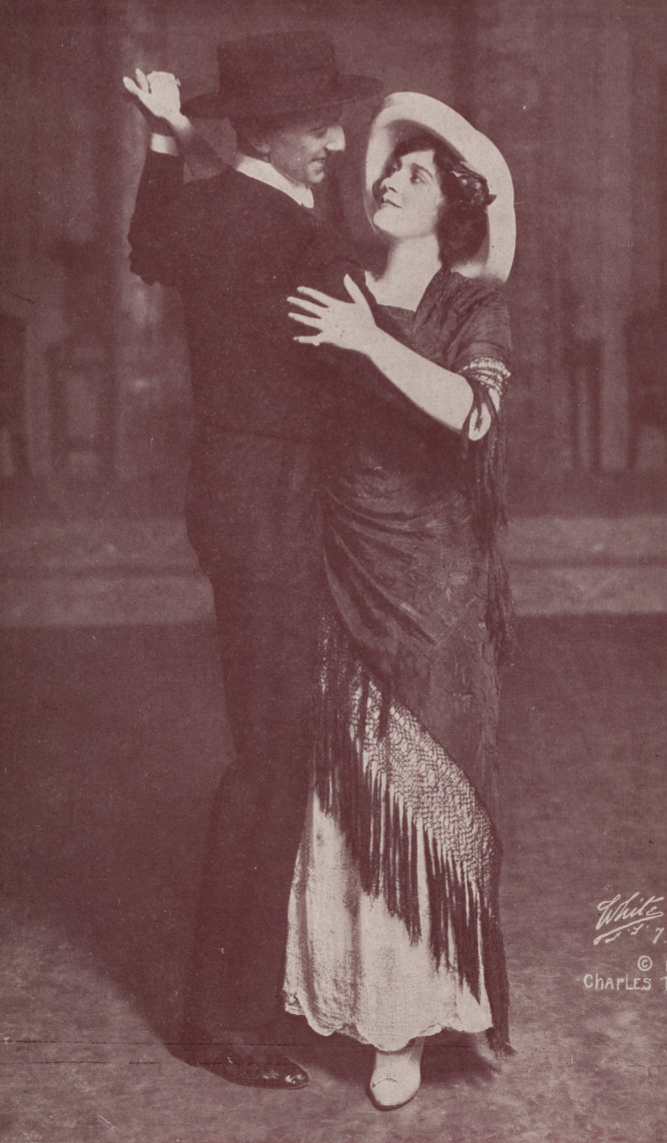
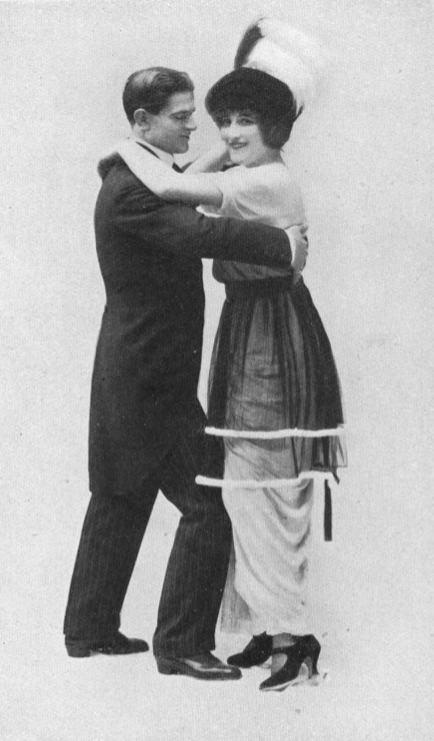
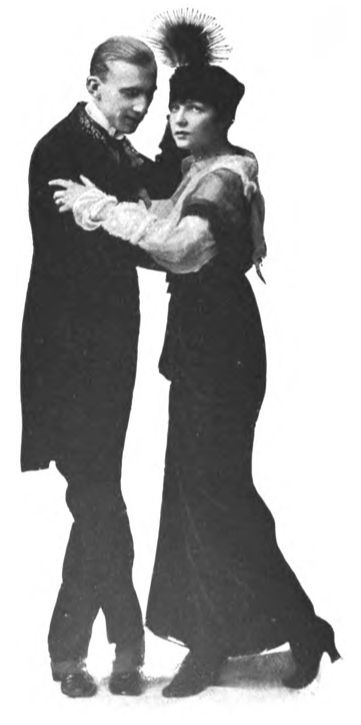
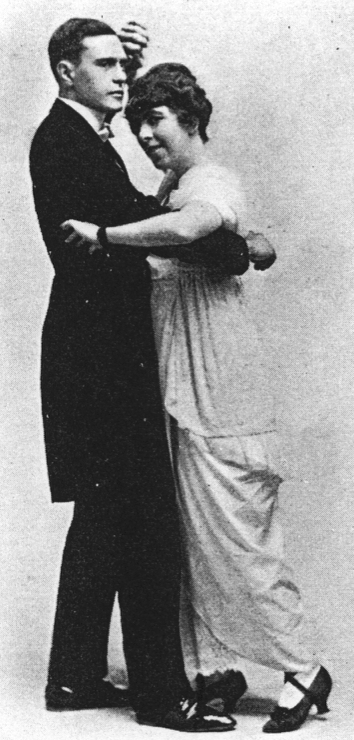
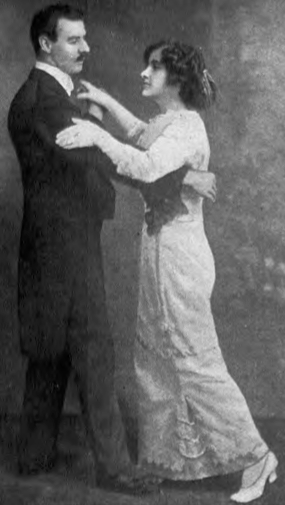
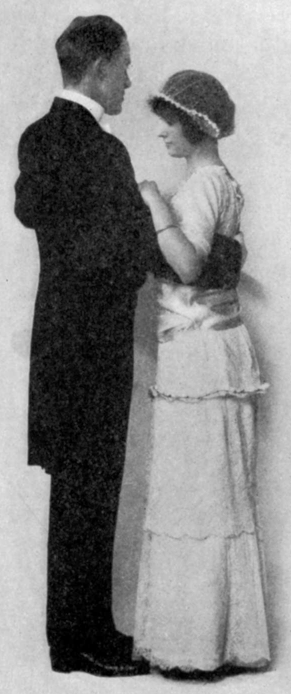
Most Northern sources have the Lead's right hand high on the Follow's back: on, or just under, her shoulder blade. The hand may either be flat on the Follow's back, or may have only the thumb and first finger on her back, palm down. The Follow's left hand may be anywhere on his right arm from behind his shoulder, to the top of his shoulder, to his bicep, to his elbow. The other arms are generally bent at around a 90° angle, and the hands are generally held palm to palm at around shoulder level.
A prominent similarity between all of the early descriptions of the Tango is that the Early Tango position is not a close embrace. In fact, several Northern sources explicitly state that in the Tango, there is more space between the bodies than there is in the Waltz, so as to allow space for the feet to cross through the center of the frame.
The basic step of Early Tango is simply a slow walk in time with the music.
In El Tango Argentino, Lima notes this basic walk can be performed in any closed dance position (Closed, Promenade, Counter Promenade, Parallel), in any direction (all points of the compass), with any number of steps (as long as the musical phrasing works out in the end). According to Lima, when the Follow is backing, the Lead starts on his left foot (📽), and when the Lead is backing, he starts on his right (Lima).



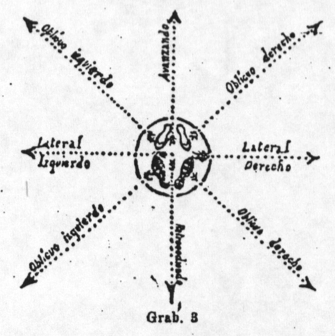
The following playlist shows the basic walking step danced in all five of Lima's dance positions:
| Author, Year | Location | Back the _____ | starting Lead's _____ Foot | for _____ steps |
| Robert, 1911 | Paris | Follow | Right | |
| Lefort, c. 1911 | Paris | Lead | Left | |
| Grossmith, 1911 | London | Follow | Left | |
| Bottallo, 1912 | Paris | Follow | Right | |
| Minchin, 1912 | Paris | Follow | Right | An Odd # of (last one begins Corte) |
| Parmentier, c. 1912 | Paris | Follow | Right | |
| Bayo, 1913 | Paris | Follow | Right | Four |
| Carpenter, 1913 | Philadelphia | Lead | Left | |
| Crozier, 1913 | London | Follow | Right | Four |
| Guerite, 1913 | New York | Follow | Right | Four |
| Koebner, 1913 | Berlin | Follow | Right | Four |
| Montel, 1913 | New York | Follow | Right | Unlimited |
| Nathan, 1913 | St, Louis | Follow | Left | Four |
| Neerman, 1913 | Paris | Follow | Right | |
| Neronde, c. 1913 | Paris | Follow | Right | Four |
| Rivera, 1913 | Paris | Follow | Right | Four |
| Sawyer, 1913 | New York | Lead (Promenade) |
Right (Left) |
Four |
| Sheafe, 1913 | Boston | Lead | Left | |
| Weissbart, 1913 | Berlin | Follow | Left | Four |
| Alvez, 1914 | Paris | Either | Left | |
| Barrasa, 1914 | London | Follow | Right | Four |
| Bell, 1914 | New York | Follow | Left | Four |
| Castle, 1914 | New York | Follow | Left | |
| Clendenen, 1914 | St. Louis | Follow | Right | Four |
| d'Albert, 1914 | London | Follow | Right | |
| Downes, 1914 | Worcester, MA | Follow | Right | Unlimited |
| Franklin, 1914 | New York | Follow | Left | Four |
| Giraudet, 1914 | Paris | Follow | Right | Eight |
| Givre, 1914 | Paris | Follow | Right | |
| Hopkins, 1914 | Chicago | Follow | Left | Four |
| Humphrey, 1914 | London | Follow | Right | Seven |
| Johnson, 1914 | Chicago | Lead | Left | Four |
| Kinney, 1914 | New York | Either | Left | Unlimited |
| Mentel, 1914 | Cincinnati | Promenade | Left | Eight |
| Miller, 1914 | Lead | Left | Five | |
| Mouvet, 1914 | Chicago | Lead | Right | Four or Eight |
| Newman, 1914 | Philadelphia | Follow (Promenade) |
Left (Left) |
Four (Two) |
| Norman, 1914 | Montreal | Follow | Right | |
| Pichetti, 1914 | Rome | Follow | Right | Four |
| Simmons, 1914 | Paris | Follow | Right | Four |
| Vandyck, 1914 | London | Follow | Right | Four |
| Volinen, 1914 | Melbourne | Follow | Right | Four |
| Walker, 1914 | Chicago | Follow | Left | Four |
| Weissbart, 1914 | Berlin | Follow | Left | Four |
| ANAMD, 1915 | New York | Follow | Right | An Odd # of (last one begins Corte) |
| Manassero, 1915 | Milan | Follow | Right | Four |
| Mouvet, 1915 | Chicago | Follow | Right | Four |
| Pellicer, 1915 | Madrid | Follow | Left | Three |

Called El Corte (The Cut) in Northern dance manuals (sometimes hypercorrected to El Corté), and La Sentada (The Sitting) by Lima, these steps are often said to be the defining characteristic of Tango. For this reason, Tango has sometimes been called "baile con corte."
In the Pocket Tango Guide (1914) from Melbourne, Australia, M. Volinen writes:
Of all the figures the most important and at the same time the most characteristic is "El Corte." The pupil who has mastered the peculiar time and rhythm of this figure will have practically overcome the greatest difficulty of dancing the Tango, as it should be danced. After doing a step you always come back to the "corte." This gives the gentleman time to consider which figure to do next.In El Tango Argentino, Lima describes seven different versions of the Corte, which he calls La Sentada. All of these Sentadas end with a step forward or backward, and a pause of one or two counts to fill out the phrase of the music.
* According to Lima, all of these Sentadas can be danced with either foot in either direction (forward or back). If described as forward or back above, simply replace "forward" with "back," and vice versa. In addition, Lima proposes other substitutions, for example, a cross in front on the first count of Sentada No. 5. Basically, as long as it ends with a step forward or back, and a pause of the appropriate length to finish out the phrase, it's probably a Sentada in the eyes of Lima.
This is in contrast to the approach of the Northern dance masters, who usually presented only one or two Cortes, claiming that their chosen Cortes were, in addition to walking, the basic steps of the Tango. As Volinen explains,
There are a great many so-called Tango teachers, but many of them unfortunately only teach their own versions, with the result that the pupils find, although he or she can Tango quite excellently in the particular style in which their teacher has taught them, when they enter a ballroom they discover that their partners "Tango" in an entirely different manner.While we certainly believe Volinen when he says this was a problem (because we often see the same thing happen today), one of the most interesting findings of this project has been that while the Cortes initially appeared quite different from each other when they were scattered across a variety of sources, when we actually sat down and compared them all, we found out that most of them are only slight variations of each other, and entirely consistent with Lima's Sentada framework.
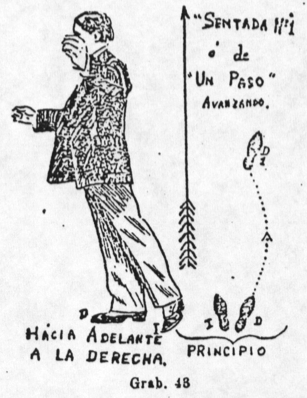
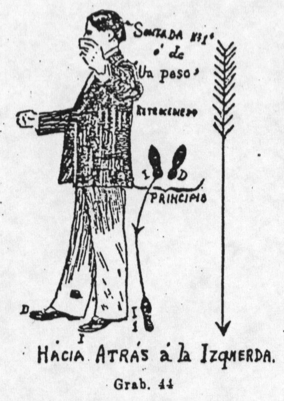

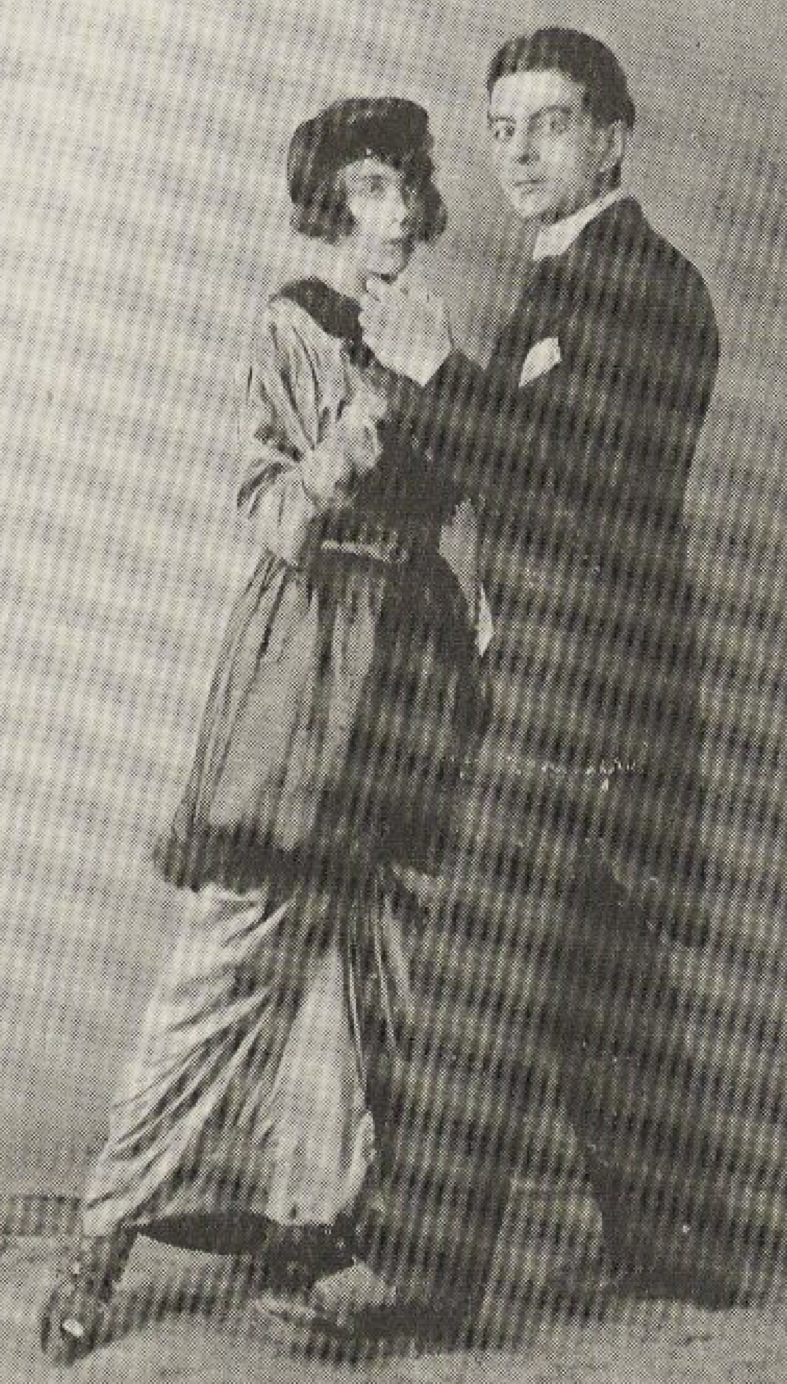
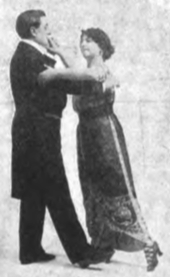
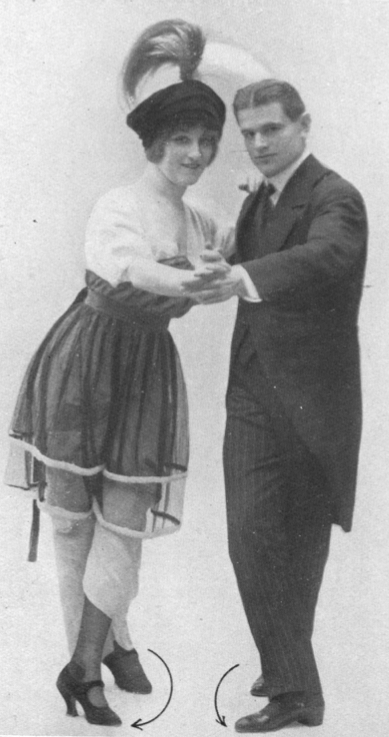
El Ocho (The Eight, Le Huit) is another step that is highly characteristic of Early Tango.
In El Tango Argentino, Lima describes one style of El Ocho (cross, side, close), with two possible timings (SQQ and SSS). Regarding its popularity, Lima writes that El Ocho is a very beautiful figure, but that it is rarely used in Buenos Aires, either because the dancers don't know the figure, or they don't want to dance it.
In the Northern Hemisphere, El Ocho appears to have exploded in popularity, with at least one version of it appearing in almost every major description of the Tango. In addition, in the North, there were many different variations of El Ocho. Without a time machine, we can't be sure exactly what happened, but it appears that in this case, the Northern tangueros decided to get creative, inventing new versions of this classic step. Here is a sampling of the different stylings described:
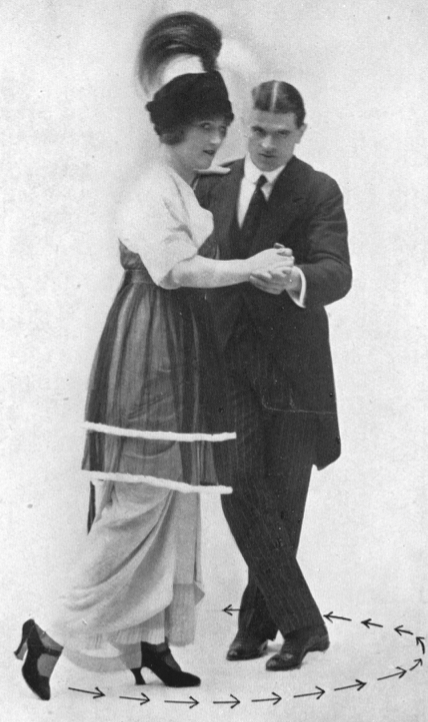
La Rueda (The Wheel, La Roue) is another classic figure found in many descriptions of the Early Tango. The first four versions below are described by Lima, and the others are from Northern sources. The only major difference here is that in the Northern versions, someone is usually pivoting on crossed feet, while in Lima's versions, both partners are stepping the whole time.
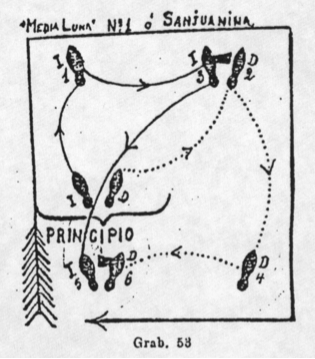
Media Lunas (Half Moons) are short figures (between 4 and 8 counts) that you repeat opposite, forward then backward, or to one side and then the other.
Richard Powers has given them the nickname "puzzle steps," writing:
Occasionally a Tango aficionado will describe tango as a "chess game of the feet," like figuring out a puzzle. It's fun to solve puzzles, and sometimes that takes trying out a few possible solutions, until you solve it. In Tango, you can puzzle out a somewhat tricky figure until your partner gets it, so it works even better with steps that can be repeated a few times, like these.In El Tango Argentino, Lima describes fourteen different Media Lunas. But as always, he notes that they can be done in a variety of different positions and directions, starting on either foot, meaning that in reality, the possibilities are nearly limitless.
The story in the Northern Hemisphere is similar to that of the Cortes: consistent with Lima's framework, but more limited. Each dance master presented one step called "El Media Luna," (The Media Luna), as if there was only one. And while these steps were usually consistent with Lima's definition of a Media Luna, they weren't always the same step.
In the minds of many Northern dance masters, a Media Luna was defined as a Corte forward, followed by a Corte backward (or more accurately, the first half of a Corte, forward and backward). As a result, their Media Lunas usually resemble their Cortes.
Here's a sampling of Northern Media Lunas, almost all of which begin going forward on the Lead's right.
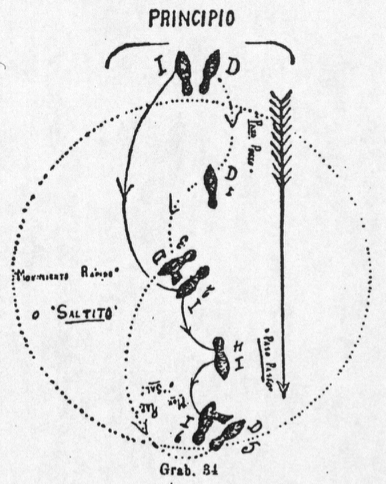
Another common family of Tango steps is the Tango Waltz, or traveling turn. Lima notes that these Tango waltzes (or at least his versions of them) are some of the most beautiful, difficult, and important figures in the Tango.
In addition to Lima's Tango waltz, which is a left- or right-turning waltz in SQQ timing, Northern sources describe several more possibilities.


Grapevines are another classic element of Tango. Here is a collection of steps that have been called a Grapevine, or resemble one.

Another popular family of Tango variations includes a Chassé, in which one foot closes to the other.
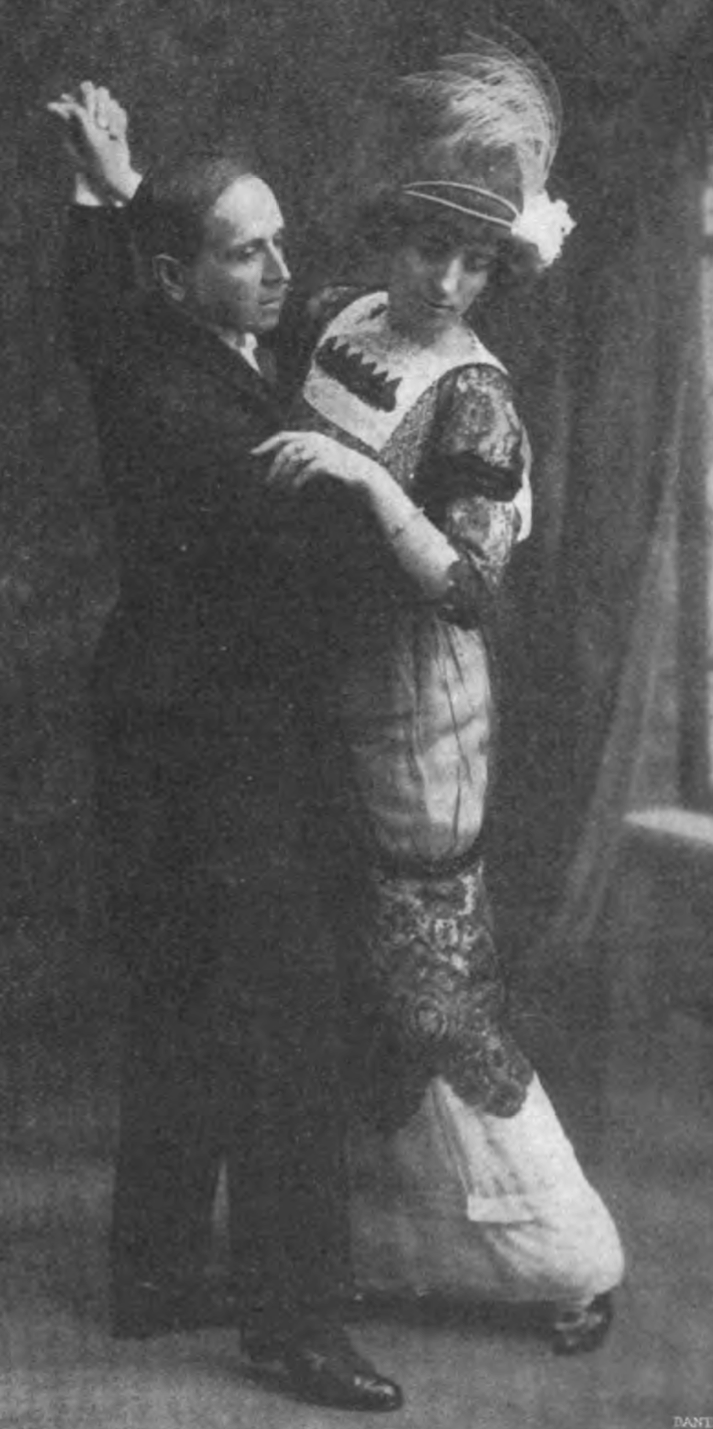
Early Tango figures often involve Floorplay, for example, touching the foot to, or sweeping the foot along, the floor.
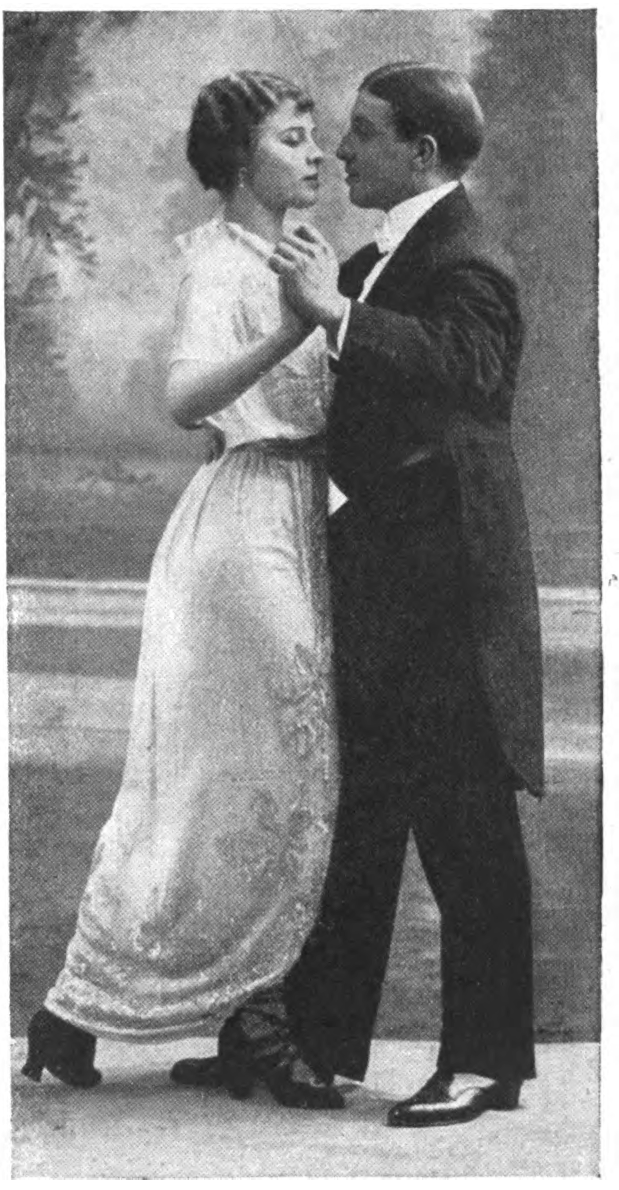
Another family of Tango figures are Rocking Steps that oscillate back and forth.

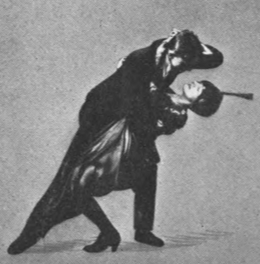
Although they do not appear in Lima's first volume of El Tango Argentino, lunges and dips are now classics in Tango, and they appeared in several Northern descriptions of the Early Tango. Given that we only have only the first volume of Lima's work (his promised second volume has yet to be found), it's possible that figures like these were going to appear in his chapter on Terminaciones (Endings) in Volume 2 (he promised to describe 20 of them). But it's also possible that they were a Northern invention, borrowed from the Parisian Apache dance. Without a time machine, it's impossible to say definitively. But in the descendants of the Early Tango in the North, these figures are absolute classics.
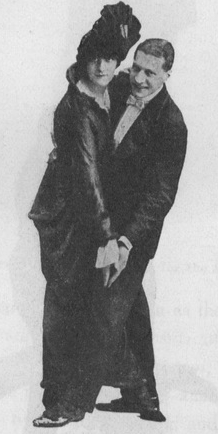
In dancing the early Tango, one of the most difficult challenges is figuring out how to mix variations that start on the right foot with those that start on the left foot, and to do so musically. Here are a few of the variations that were described as being useful for getting the other foot free.
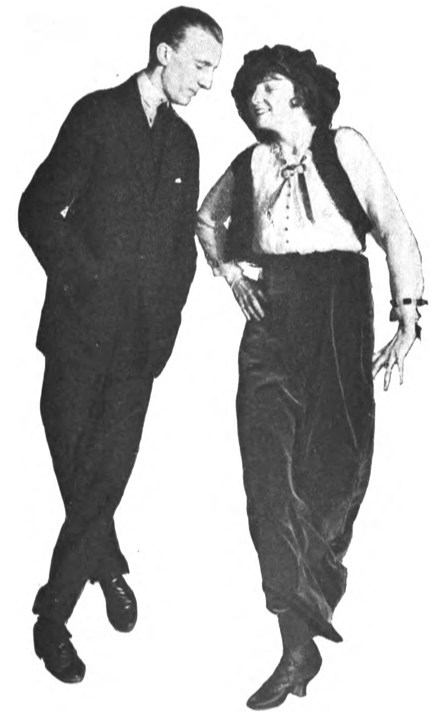
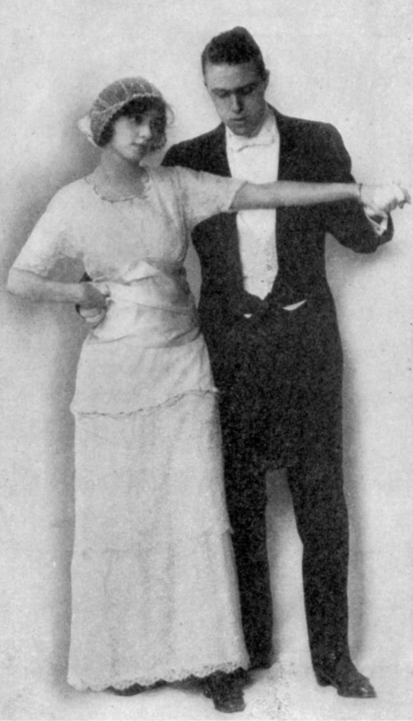
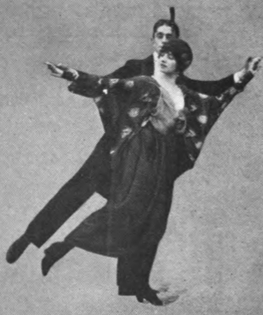
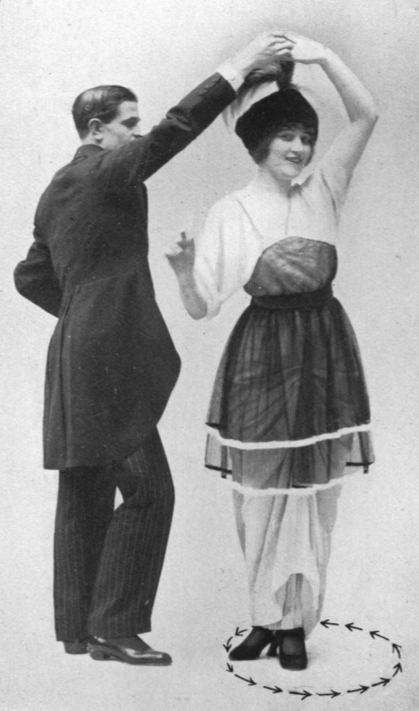
In the Northern Hemisphere, things sometimes got a bit creative, breaking out of the traditional mold of Tango entirely. Take, for example, these fanciful variations:
What, in the end, should we take away from this analysis?
In answering this question, it's instructive to look at Lima's stated motivation for writing El Tango Argentino, c. 1916, after the rest of these sources were published:
Es necesario poner las cosas en su lugar, y por consiguiente, decirle a Europa cuál es nuestro verdadero tango, pues en el otro hemisferio, y aún en nuestro propio país, en su afán de crear muchas y diversas "figuras", no han vacilado en aplicarle á nuestra bella danza cualquier disparate imaginario o antojadizo, ridiculizando la postura de la pareja y por ende el baile, y haciendo alarde a la vez de que eran "figuras" propias o personales y que pertenecían al tango, cuando en mi opinión desconocían científicamente el mismo, habiéndóme llevado esta circunstancia a la publicación del presente libro, para reglamentar y difundir el conocimiento del verdadero "Tango Argentino", único y nato, pues no hay tal tango "Parisien", y de haber éste, sería una degeneración de aquél.It seems that in Lima's eyes, the Tangomania was, in fact, a "mania." And it's easy to see why he might have felt this way: compared to Lima's obsessively (and wonderfully) scientific account of the Tango, the Northern sources could be seen as simultaneously too limited and too creative.
It is necessary to put things in their place, and consequently, to tell Europe what our true tango is. In the other hemisphere, and even in our own country, in their eagerness to create many different figures, they have not hesitated to apply to our beautiful dance any imaginary or fanciful nonsense, making the posture of the partners, and in the end, the dance itself, ridiculous. They brag that these figures are proper or personal figures that belonged to the tango, when in my opinion, they never knew the dance scientifically. It is these circumstances which led me to the publication of the book, to regulate and spread the knowledge of the true Argentine Tango, the one and only, because there is no such thing as Parisian Tango, and if there were, it would only be a degenerate copy of Argentine Tango.
Click the title of the source to jump straight to the reconstructions of that source.

These 10 variations are accompanied by sheet music for El Choclo by A. G. Villoldo.
In recommendation of this music, Robert writes:
Le Tango, d'origine sud-américaine, se danse dans un rythme très lent, genre habanera. Beaucoup de compositeurs ont écrit de la musique pour accompagner cette danse. Peu ont réussi et nous recommandons à nos élèves de ne danser que sur les vrais tangos El Choclo et El Esquinazo du maître Argentin A. G. Villoldo."El Choclo" was premiered in Buenos Aires in 1903, and remains one of the most popular Tangos in Argentina and around the world today.
The Tango, of South American origin, is danced at a very slow pace, genre habanera. Many composers have written music to accompany this dance. Few have succeeded and we recommend the our students dance it to the authentic tangos "El Choclo" and "El Esquinazo" by the Argentine master A. G. Villoldo.
In his Complete Dance Instructor (1914), Frank H. Norman provides an English translation of Robert's descriptions, which helped in their reconstruction.
Favart's Il Tango (1913) also includes a translation of Robert's descriptions into Italian.
Both translations are included in the "Historical Descriptions" section below.
The dance position is illustrated above.
The Lead's right hand is high on the Follow's back, the Follow's left on top of the Lead's shoulder.
Back the Follow, starting on the Lead's right. Then Lead steps forward with his right foot, side with his left, closes right to left, then steps back left, slightly flexing the left knee. The Follow dances opposite.
The timing is unspecified.
The Lead crosses right behind left, then places the left foot to the left side, then steps back on it, leaving the right foot in front, and slightly flexing the left knee. The Follow dances opposite, crossing in front to begin.
The timing is unspecified.
The Lead crosses left over right, points right foot to the right, and steps forward right, slightly flexing the right knee, and slightly lifting the left leg behind. The Follow dances opposite, crossing behind to begin.
Robert notes that while one dancer executes Figure 2 or Figure 3, the other is executing the other figure.
The timing is unspecified.
This is a left-turning waltz step, interspersed with Figures 2 and 3.
The timing is unspecified.
Lead crosses right over left, steps side left, and steps back right, then crosses left over right, steps side right, and forward left.
The timing is unspecified.
Cross right over left, touch left out to side, cross right over left, touch right to side.
The timing is unspecified.
Not entirely clear, but possibly: walk, walk, two-step forward, and repeat with the other foot.
Not entirely clear, but it might be an extremely vague description of the Tango Waltz (L'Eventail beginning on the cross-step). It's described as a walk that connects all the figures, the partners alternating passing in front of each other.
Both partners chassé to the side, then the Lead stands on tiptoes, turning on the spot, while the lady continues to chassé around him.
Lead steps forward right, side left, close, back left, side right, close.
The timing is unspecified.
Le Vrai Tango Argentin (L. Robert, Théorie du Vrai Tango Argentin, 1911, p. 1):
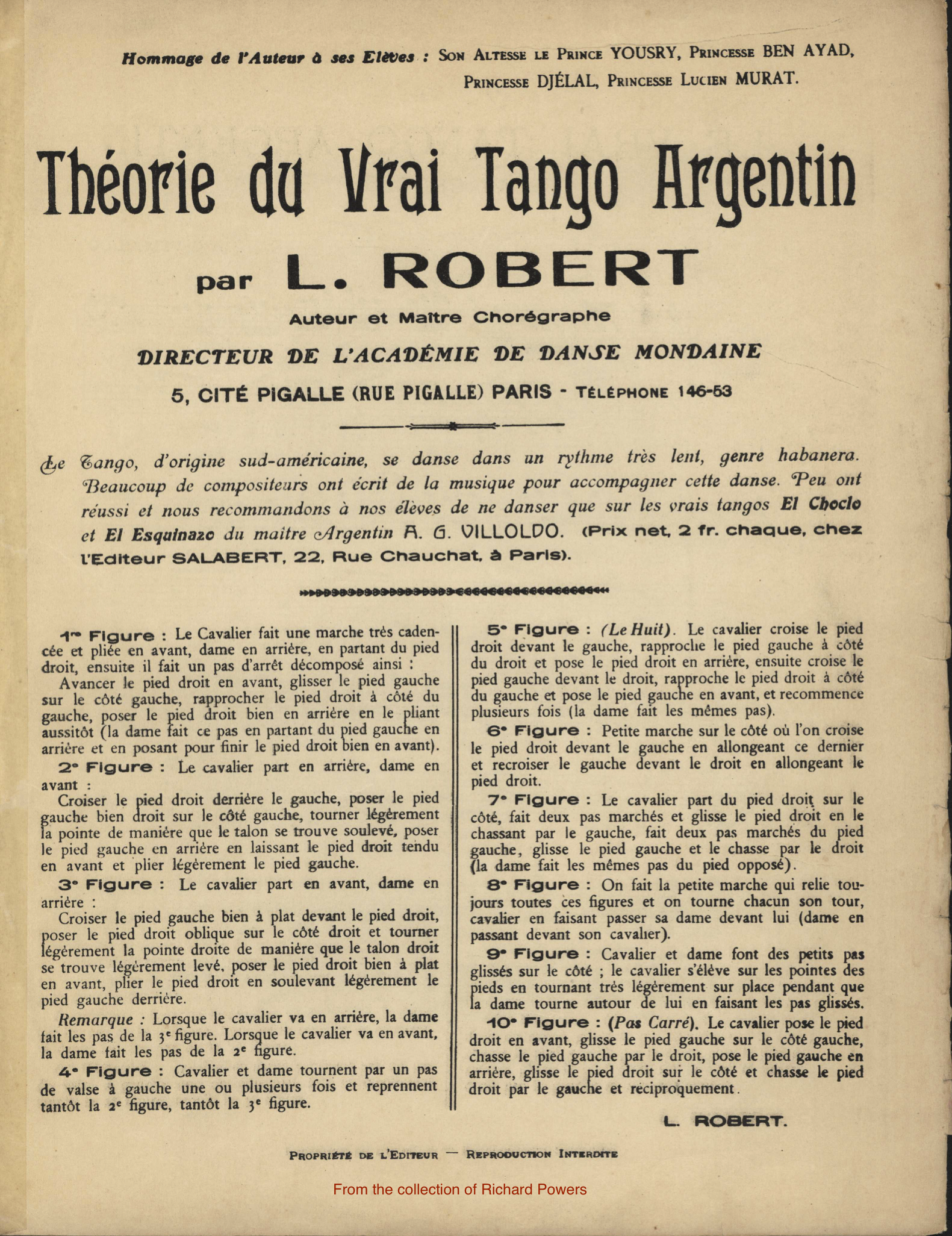
Il Tango (Favart, Il Tango, 1913, p. 41):
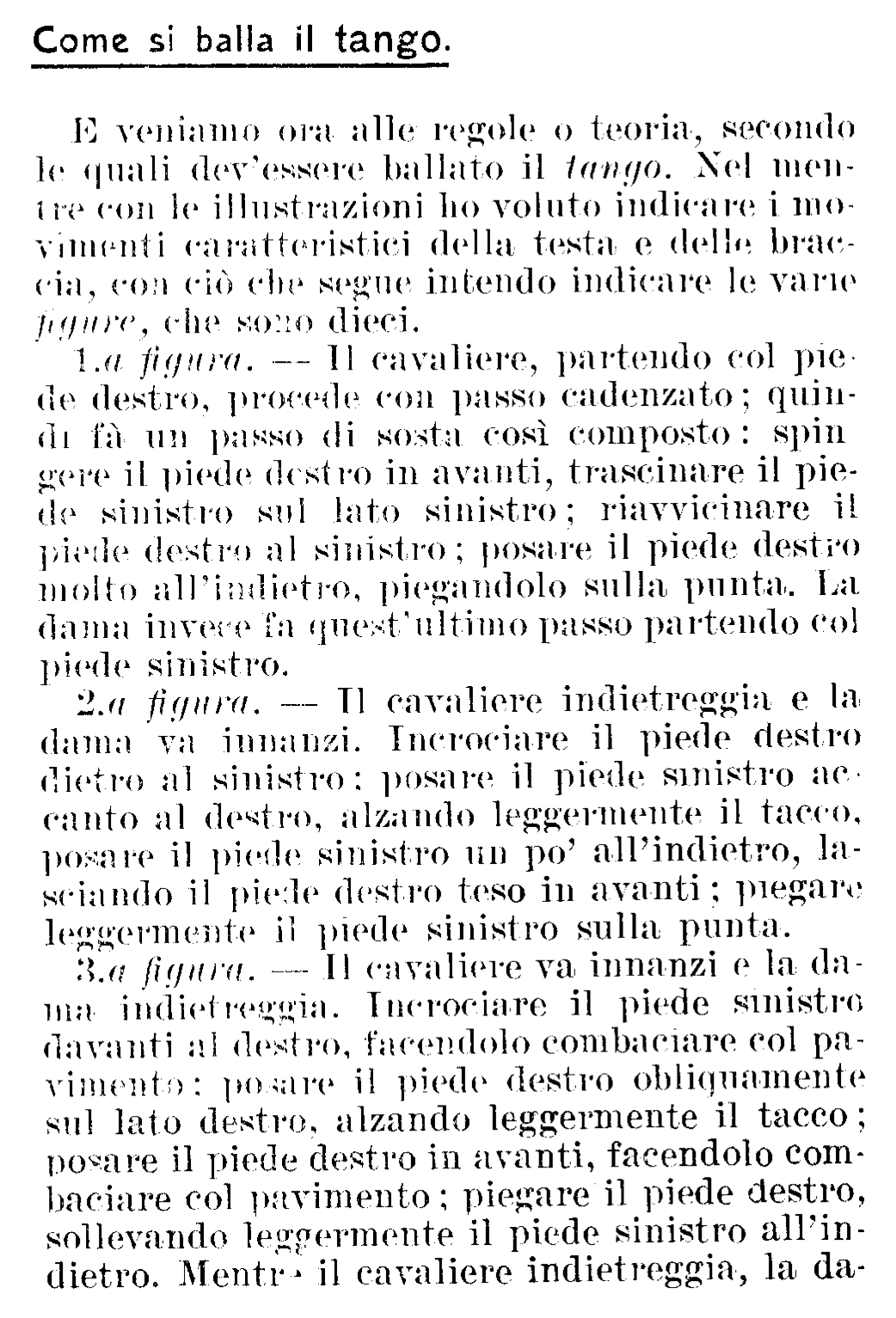
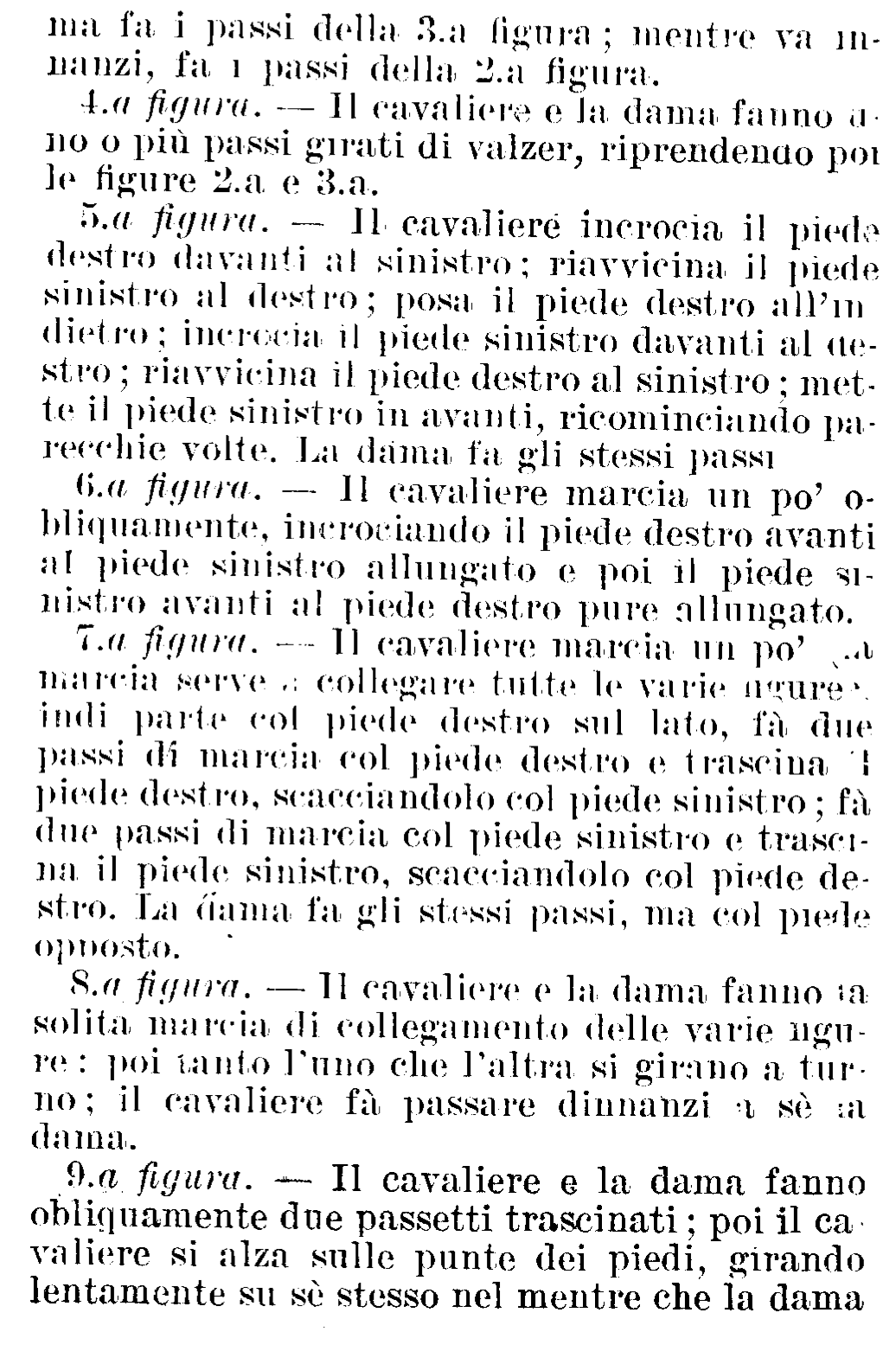
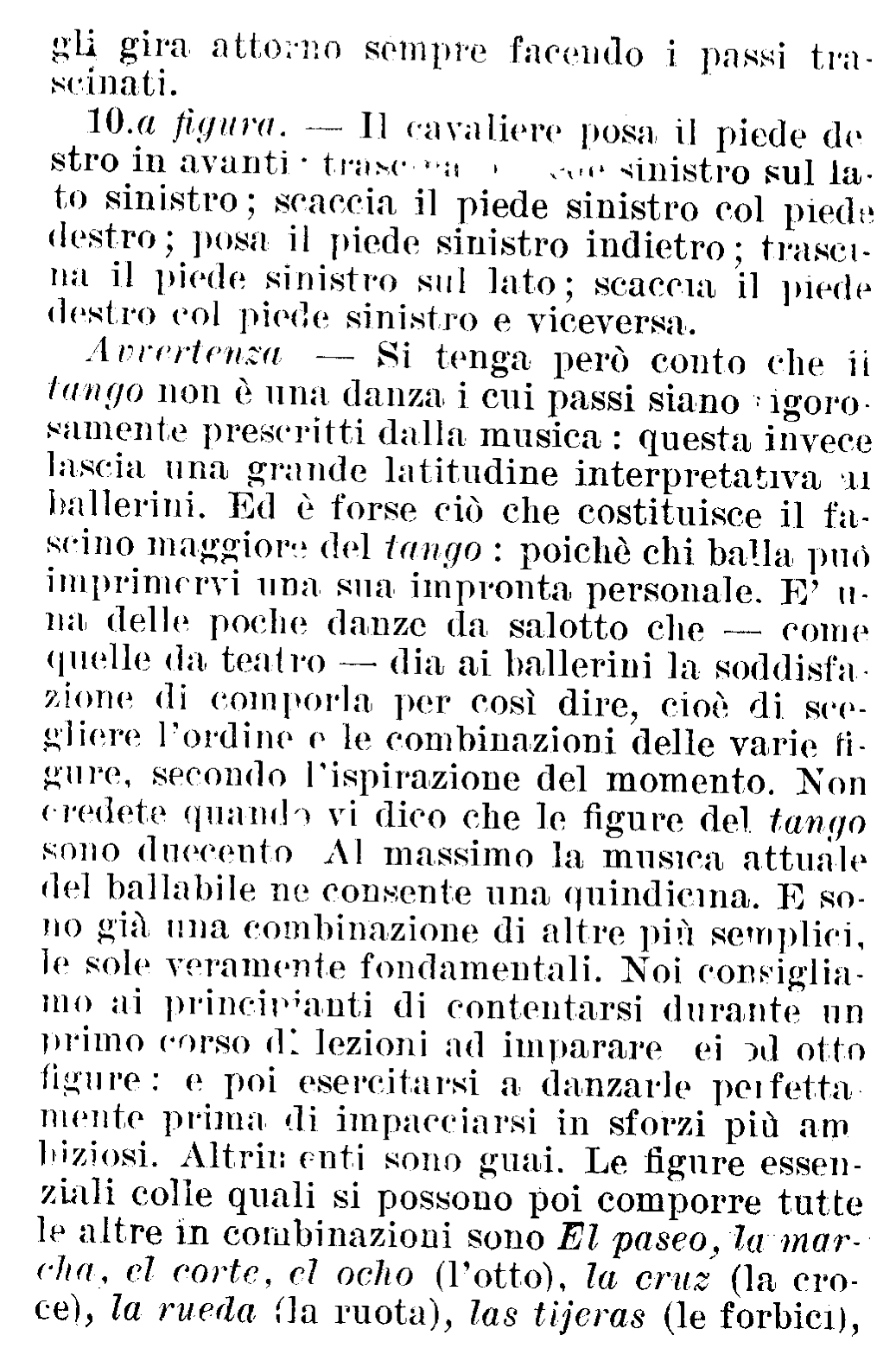
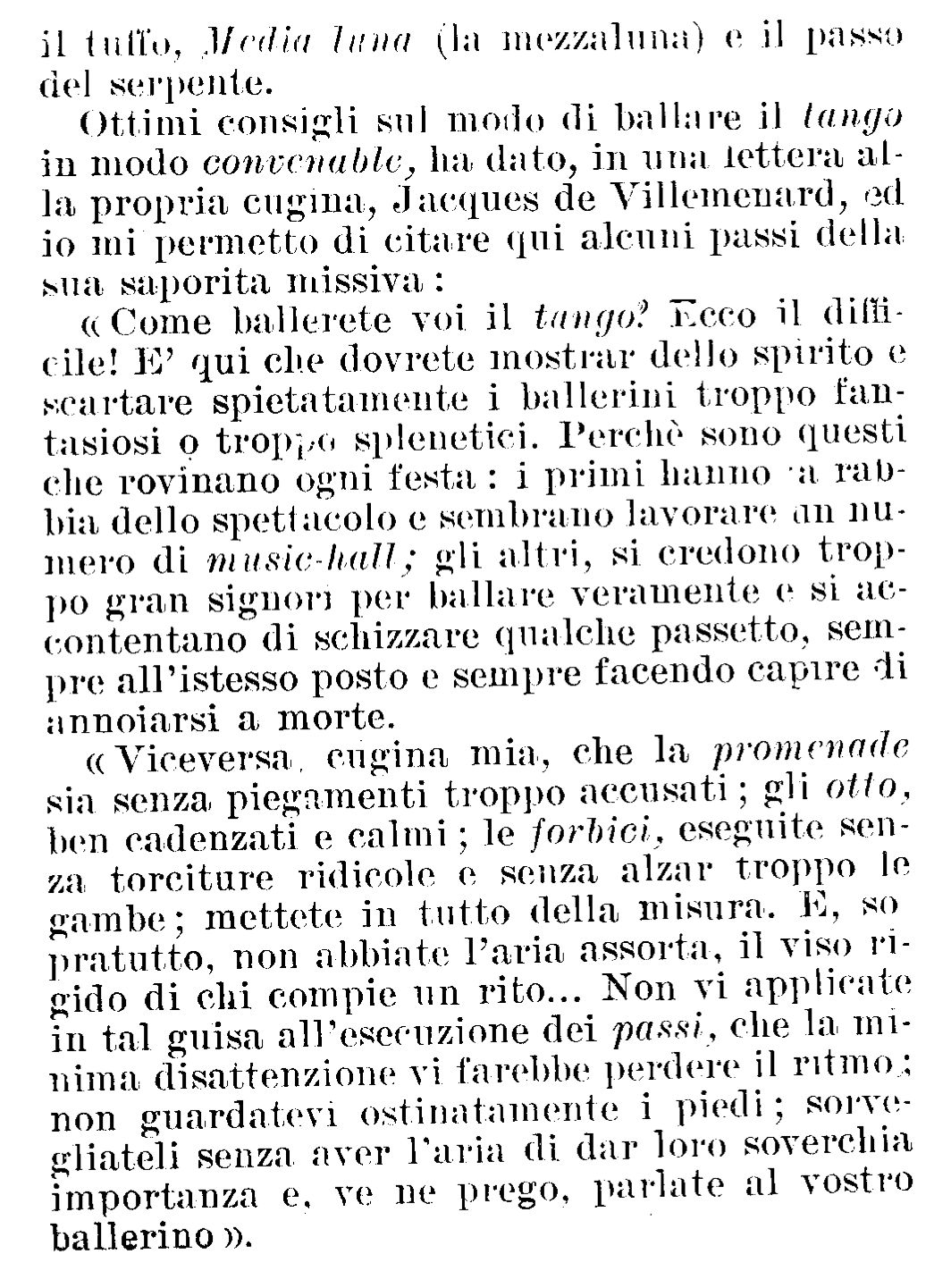
Parisian Tango (Norman, Complete Dance Instructor, 1914, p. 31):
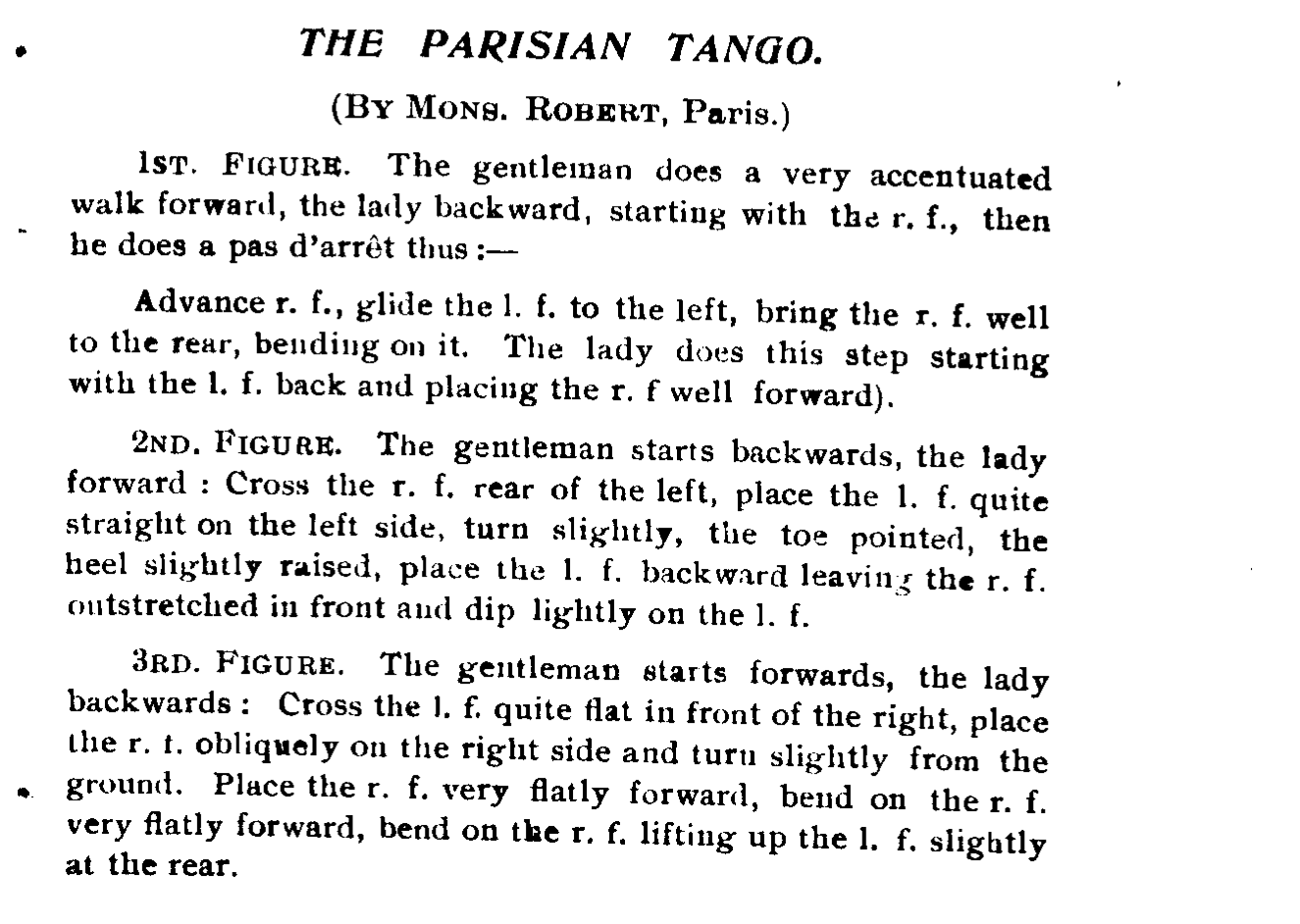
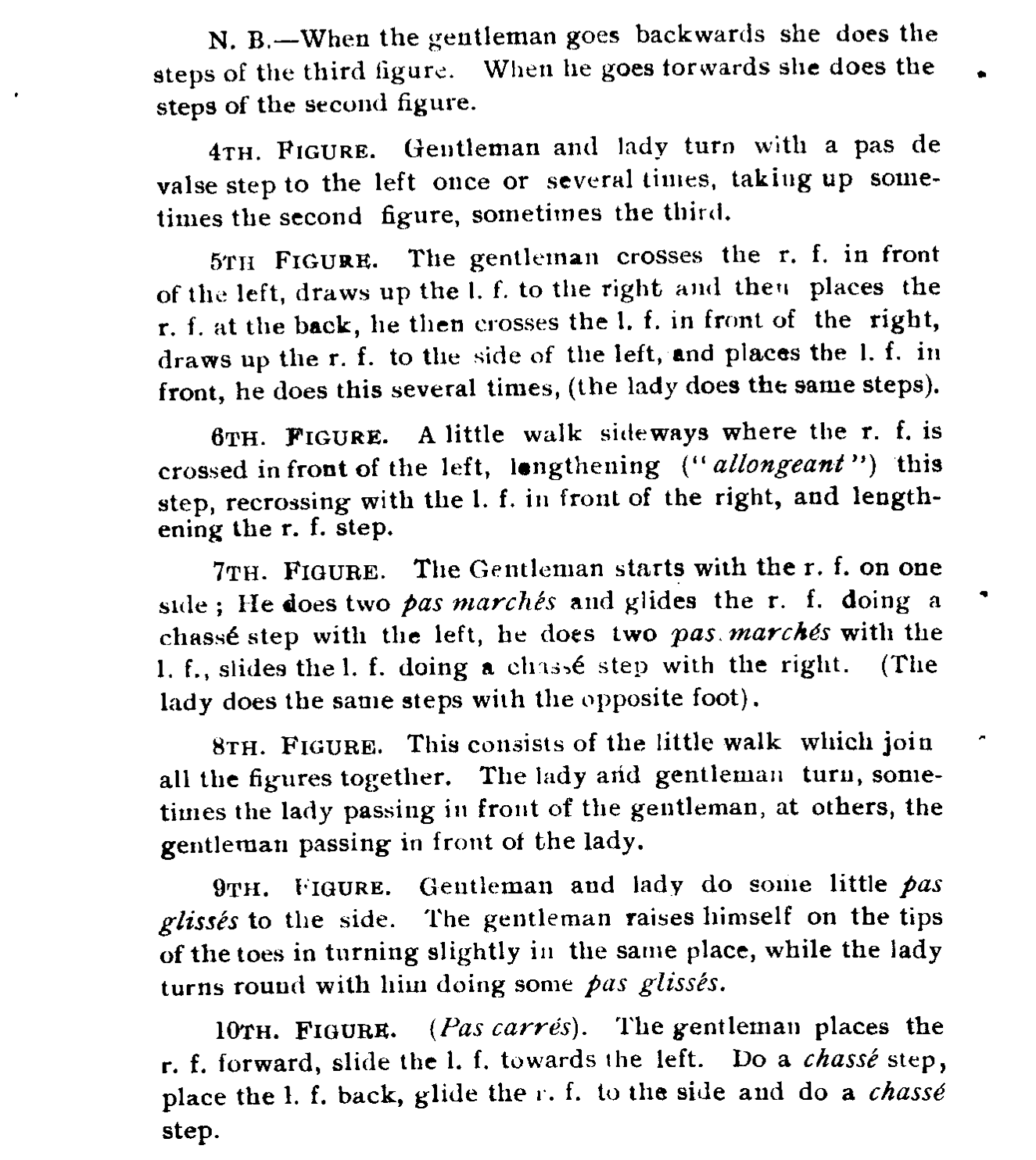
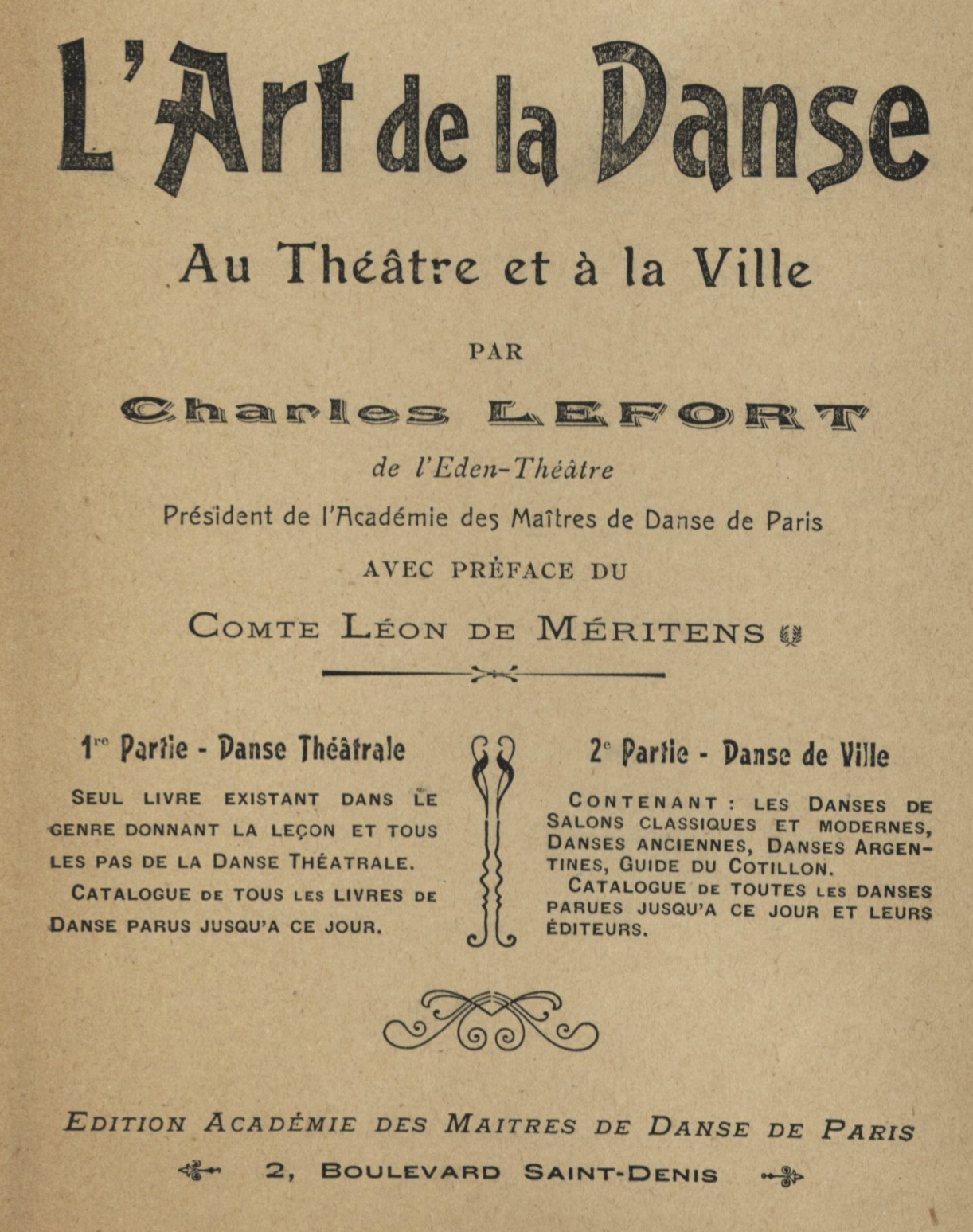
Back the Lead four steps, starting Lead's left, pass the left elongated behind (without weight), bending the right and leaning forward, then pass the left foot forward, putting weight on it.
Then Back the Follow four steps, starting Lead's right, pass the right elongated in front (without weight), bending the left (no lean specified), then pass the right elongated back, putting weight on it.
It appears to be an extended version of Lima's Vai Ven with four walking steps inserted in the middle.
The timing isn't immediately clear. It's specified as 10 measures (20 counts), which suggests each part gets 5 counts, but there are six movements. If we make the fifth and sixth movements quick-quick, it's 5 counts, but that feels too fast, and is totally unmusical (later, Lefort notes that musical phrasing is important). It feels (and fits) better with 6 counts per part (12 measures total). In a later description, Lefort suggests that this figure takes 16 measures.
Starting Lead's right, cross in front, step side, cross in front, then walk two steps (where exactly is unspecified, but an about face is made with them).
This appears to be a kind of Four Count Scissors, but the exact footwork of the change at the end is unclear. The most logical interpretation is to simply step forward left and about face to step forward right (making the last three steps like an Open Ocho).
The timing is also unclear, but it takes 2 measures (4 counts). To work out musically and be consistent with later Parisian versions, it's probably SSSQQ.
It is to be repeated 10 or 8 times. Then repeat the first motif (for 16 measures, which is odd, as the first motif was supposed to be 10 measures).
A very slow (2 count) step with Lead's left back along LOD (facing outside wall), then a very slow step back along LOD with Lead's right (facing center). Repeat these two steps.
Then back the Lead 4 slow (1 count) steps, turning halfway to the left on the fourth step, and back the Follow 4 slow (1 count) steps. Repeat the whole thing, Lead starting in front (in which case the way the person backing in the first part is different). Another interpretation could have the last Follow backing step turn (to the right) to repeat the whole figure exactly as described.
Then repeat the first motif, which is interspersed between the others.
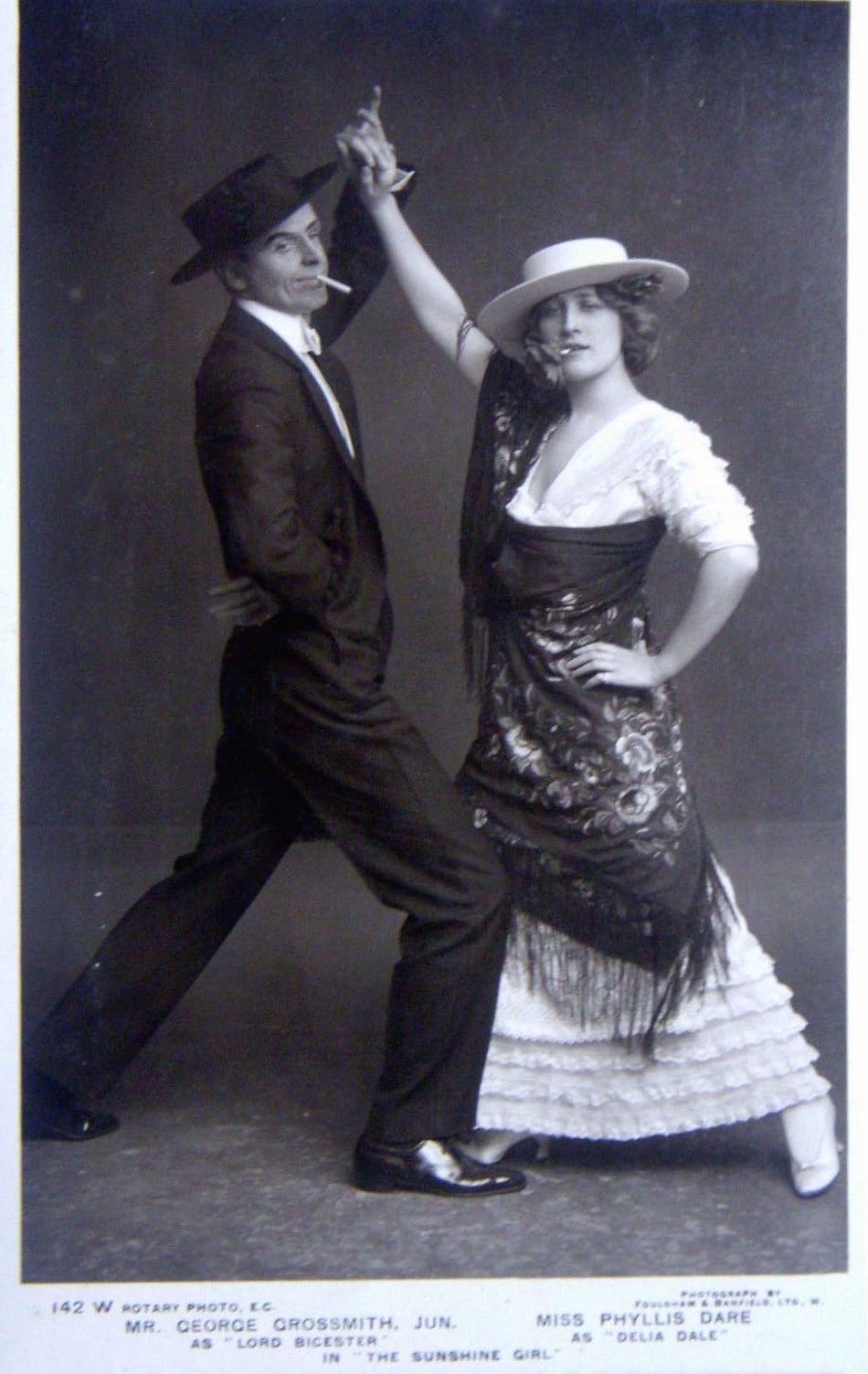
This is an early description of the The Argentine Tango "as demonstrated by George Grossmith." George Grossmith was an English actor who starred alongside Phyllis Dare in "The Sunshine Girl," a musical which introduced the Tango to British audiences. At right is a picture of Grossmith and Dare, courtesy of Richard Powers.
This isn't a particularly good source in terms of reconstructable descriptions, but it's an important one, historically.
The tango position is an interesting one:
The gentleman should face his partner squarely, place his right arm around the lady's waist and allow the back of his thumb only to rest there, the open palm of his right hand being parallel with the floor. He should hold the lady's right hand with the first and second finger and thumb only of his left hand, the bend of his left elbow and that of the lady's right elbow being at right angles and on a level with the shoulders.
Forward left, forward right, back left. This is presumably a corte with a hold on count 4, but the timing is unspecified. The style is specified as supporting knee bent, and free toe lightly touching the floor.
The Lead crosses right over left, then sweeps left around in a circular motion to cross left over right. The Follow dances opposite, also crossing in front.
Cross inside foot through, then sweep outside feet out and forward, with inward turned toes, then take two steps, leaning forward and bending the knees. Then cross outside foot through to become new inside foot and repeat opposite.
It is noted, that the "movement of brushing the ground with the inward-turned toe" is "the actual 'Tango' step," and "occurs in all the figures. Although apparently against all orthodox rules of dancing, both knees are bent inwards and the toes turned inwards throughout the 'Tango' dance."
A position in which the Lead stands behind the Follow, holding right hands, left hands free, is described, as is a movement in which the trailing foot "is brought up with a sharp click alongside and parallel to the other foot, the latter immediately being advanced as it it were 'kicked away'."
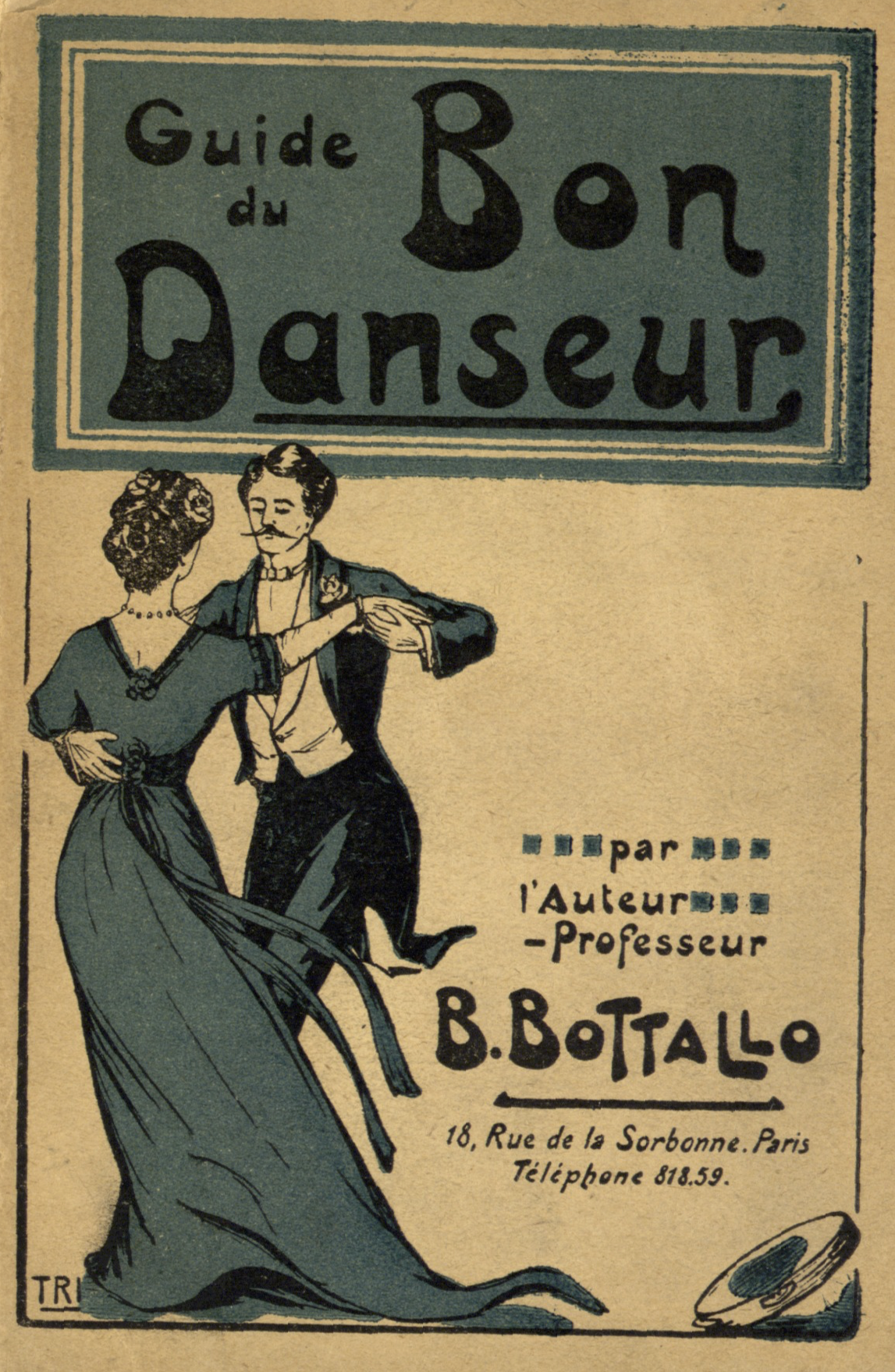
Bottallo's Guide du Bon Danseur mostly contains descriptions of late-19th century dances, but also includes three figures of the "Tango-Argentin."
Bottallo promises to give the Tango a full treatment in his next dance manual, but as far as I'm aware, he only published this one.
He describes the Tango as a dance which consists of two different kinds of Corte, interspersed with walking steps. He also notes that the Parisian Tango has many variations that pleasantly embellish it, including the commonly described Le Huit, Le Croise, La Demi-Lune, and La Roue, but that many teachers have their own versions of the Tango which do not resemble the original.
Lead steps forward right (1), side left (2), close (3), back left, flexing the knee, and raising the right heel, right knee pointed in (4)
Three gliding steps backward on the right foot (1, 2, 3), side (4), close (and), back left (5), with right heel raised and right knee turned in (6).
It is noted that Le Corte and Le Demi-Corte are interspersed between walking steps in all directions. It is also noted that all movements in the Tango are elastic, and originate from the hips, with no oscillation of the shoulders.
A gliding walk, flexing the knees, which are turned in.
Bottallo notes that all of the steps of the Tango are short and gliding, and that all of the movements are elastic, performed from the hips, without any oscillation of the shoulders.
Minchin notes that each of these figures is repeated several times, and that they can be combined in any order.
Back the Follow, starting Lead's right, an odd number of steps (seven is the most common).
Forward right (1), side left (2), close right (and), back left (3), hold (4).
A Back and Forward Ocho starting forward left: forward left (1), cross right in front (2), side left (3), back right (4), cross left in front (5), side right (6).
A SQQ box step (non-turning), starting forward right.
Side left (1), cross right in front (2), side left (3), fall back on right without weight (perhaps a stamp?) (and). Repeat opposite, traveling to the right.
A Four-Count Scissors with Points starting with an extra step at the beginning: side left, then Four Count Scissors as usual.
A Two-Count Scissors (Ochos with Points) is also mentioned.
A parallel Grapevine starting side left and crossing Lead's right in front, Follow's left behind.
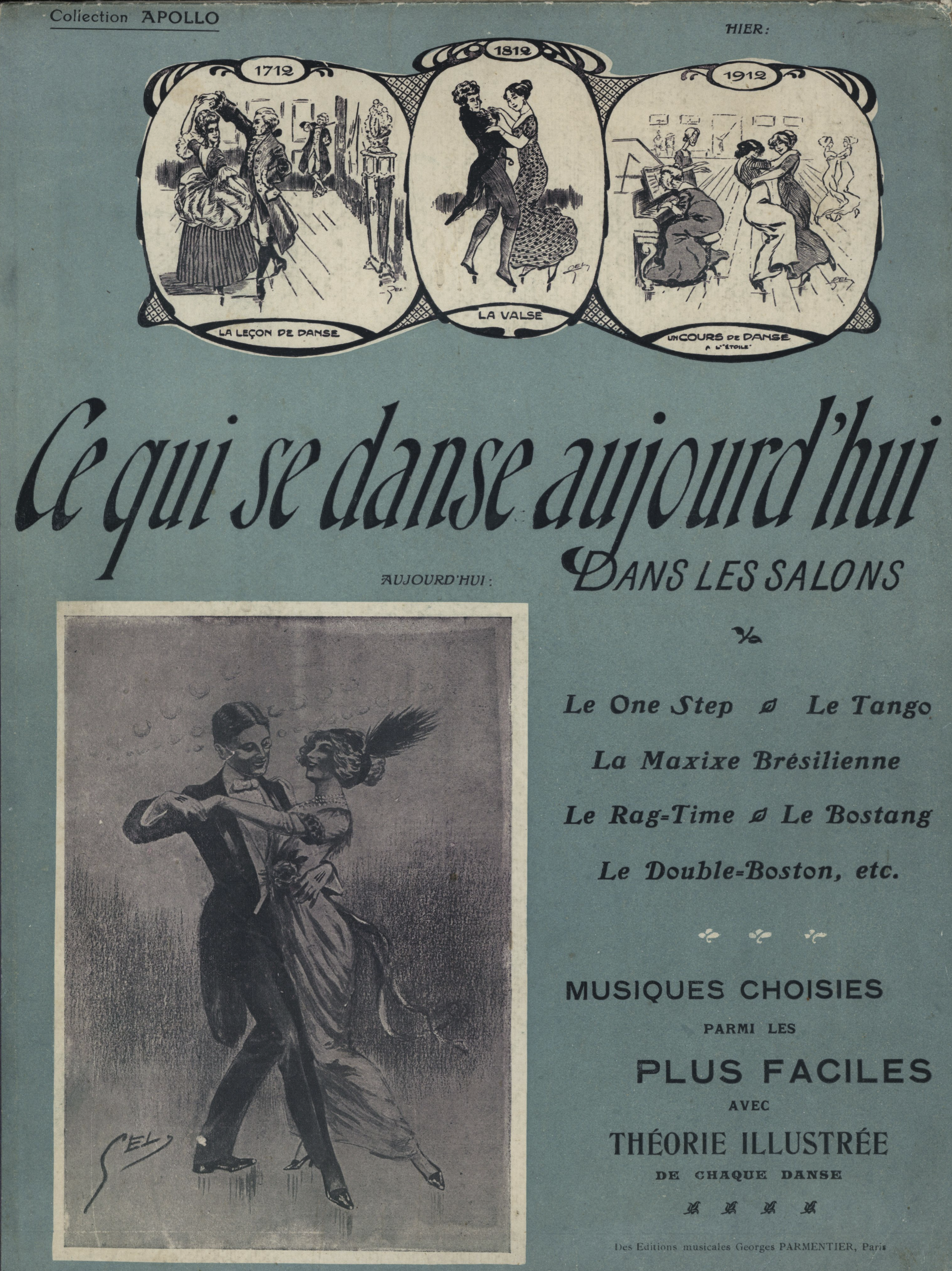
Unclear.
Unclear.
Unclear.
Unclear.
Unclear.
Unclear.
Unclear.
Back the Lead three steps, then turn 1/4 to back the Follow three steps, turning 1/4 to repeat, forming a square.
Unclear.
Unclear.
Promenade two steps, then side, close. Timing unspecified. The name suggests there should be a stamp at some point.
After dancing Figure 3 twice, Lead crosses right over left and pivots to unwind, as the Follow chassés around him.
The classic right-footed box step. Timing unspecified.
Grapevine to the left, starting side left, cross right in front.
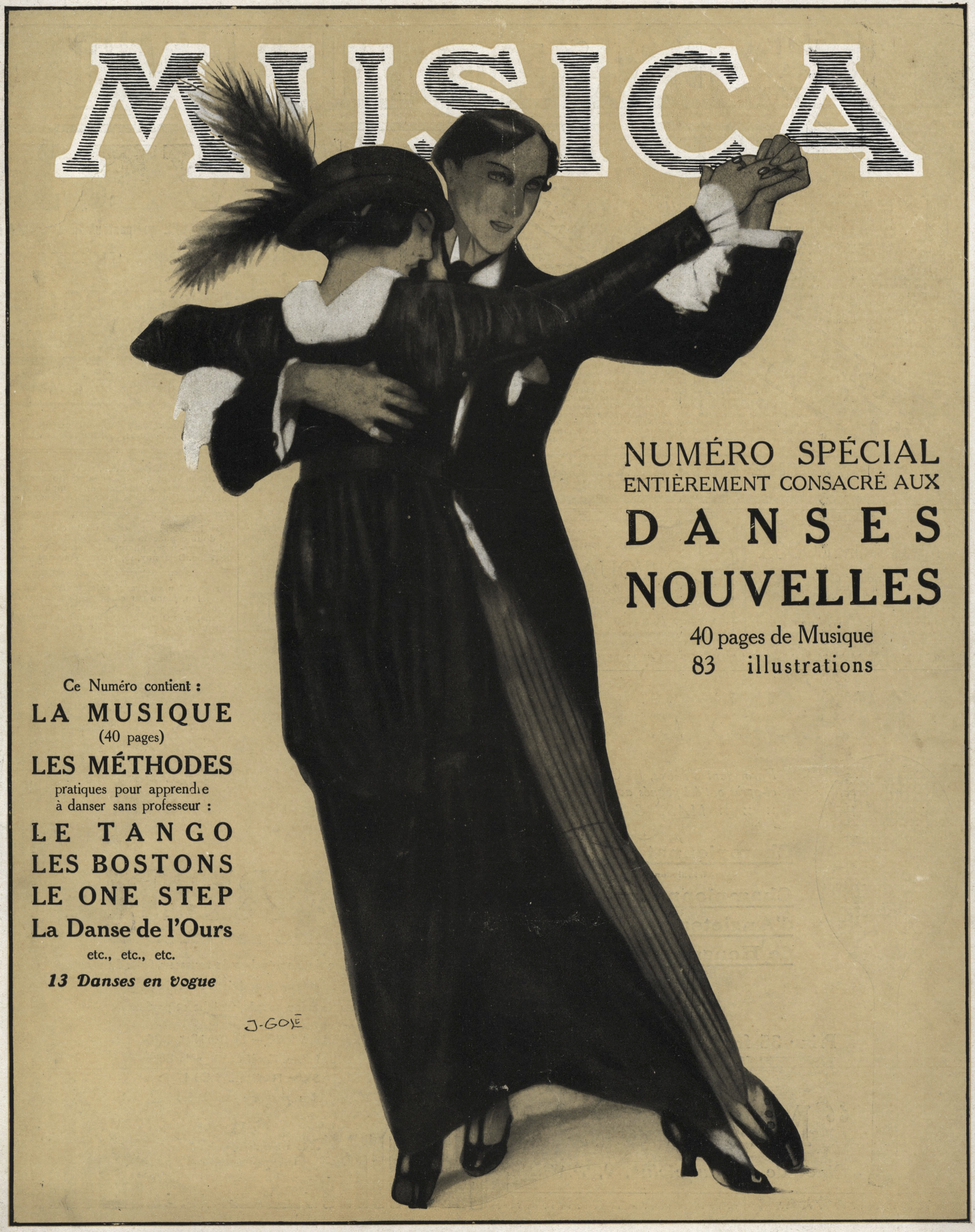
Back the Follow four steps, starting Lead's right (1, 2, 3, 4), then step forward (1), forward (6), replace (7), back (8).
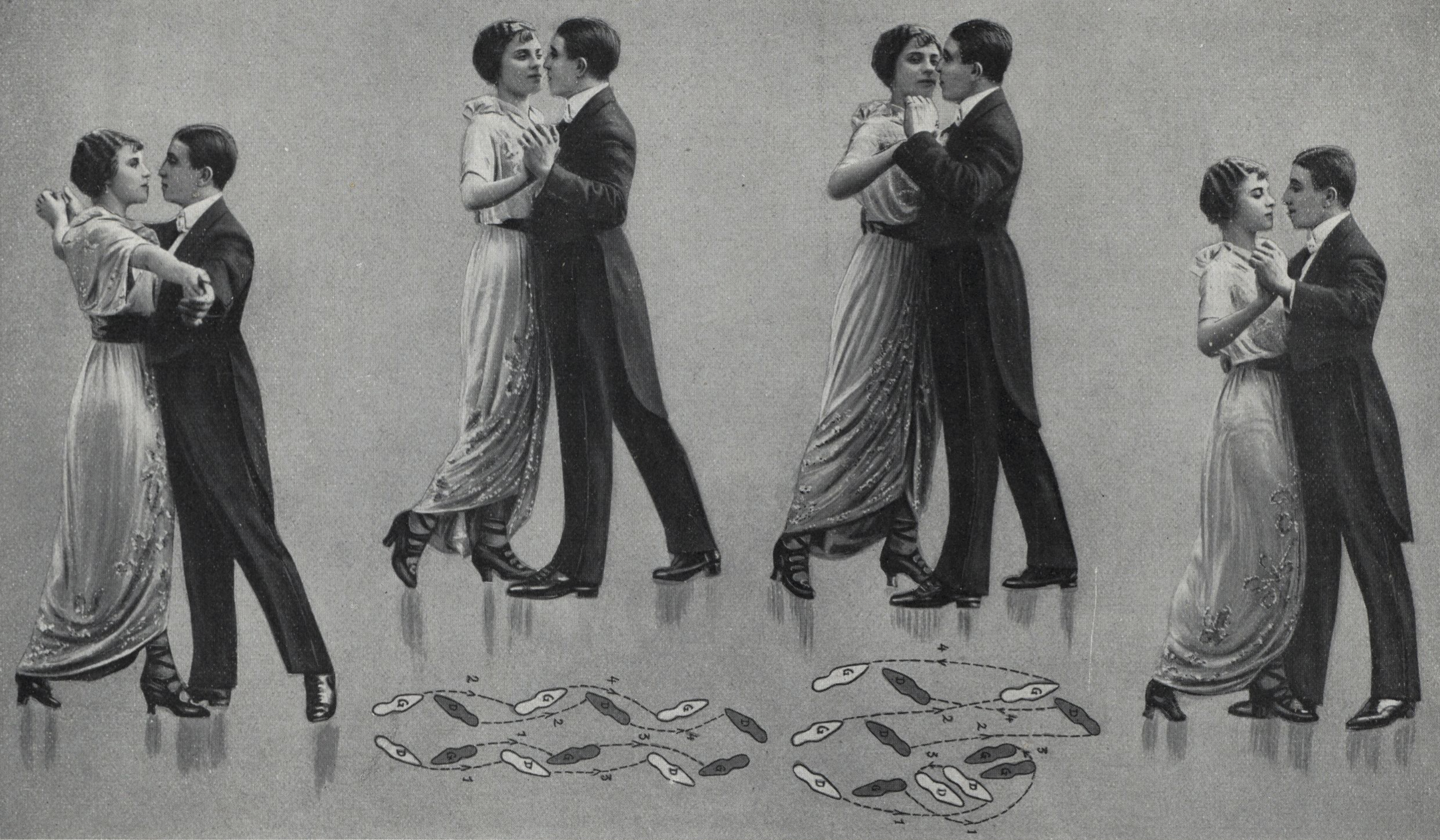
Four Count Scissors to the right, starting with left crossed in front of right, changing direction with a chassé (1, 2, 3, 4, and), and repeat opposite (5, 6, 7, 8, and). The ending of the figure (with four chassés) isn't clear.
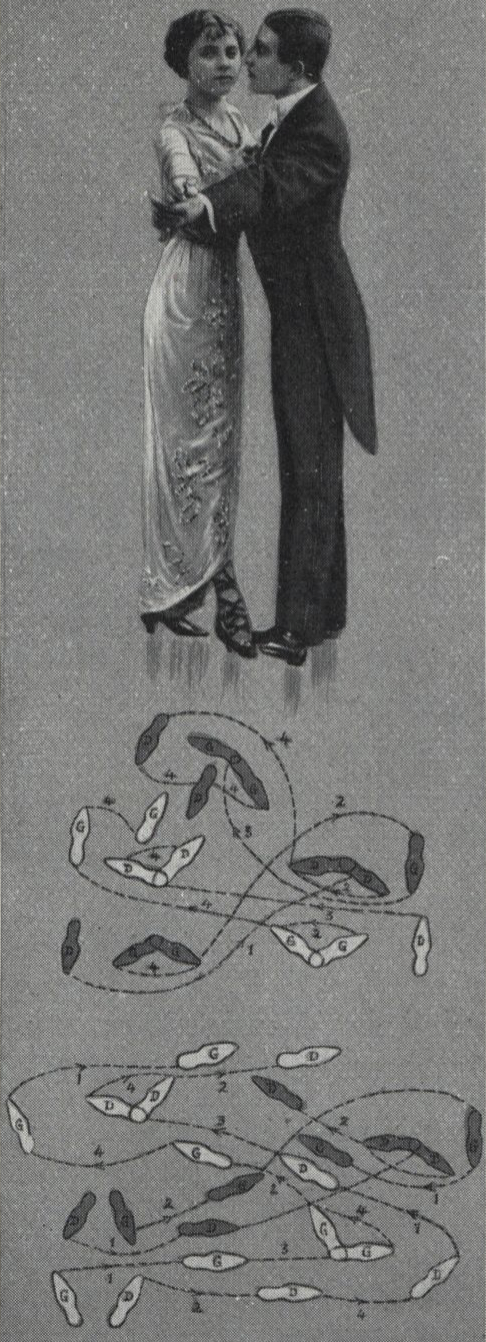
Written description is simply Back and Forward Ochos, starting with the left crossing over right. The illustration shows a longer sequence: Promenade three steps over elbows (1, 2, 3), then Lead steps forward left as Follow steps back right (4). Cross inside foot through (5), step side toward the hands (6), then the Lead steps back right as the Follow steps forward left (7). Cross outside foot through (8), step side toward the elbows (9), and the Lead steps forward left as the Follow steps back right (10). Cross inside foot through (11), and close outside foot to inside with an outward sweep (12).
This is illustrated in the top of the diagram below.

Unclear.
This is illustrated in the bottom of the diagram below.

Forward right, close left beside without weight, back left, close right beside without weight.
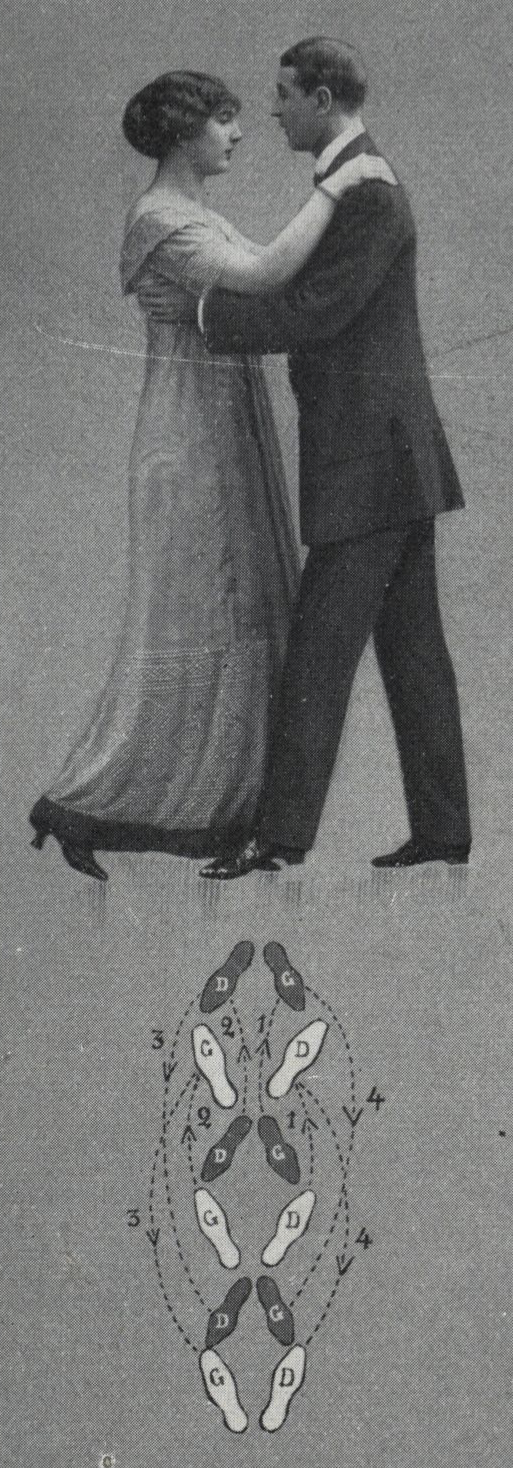
The classic pivoting Rueda.
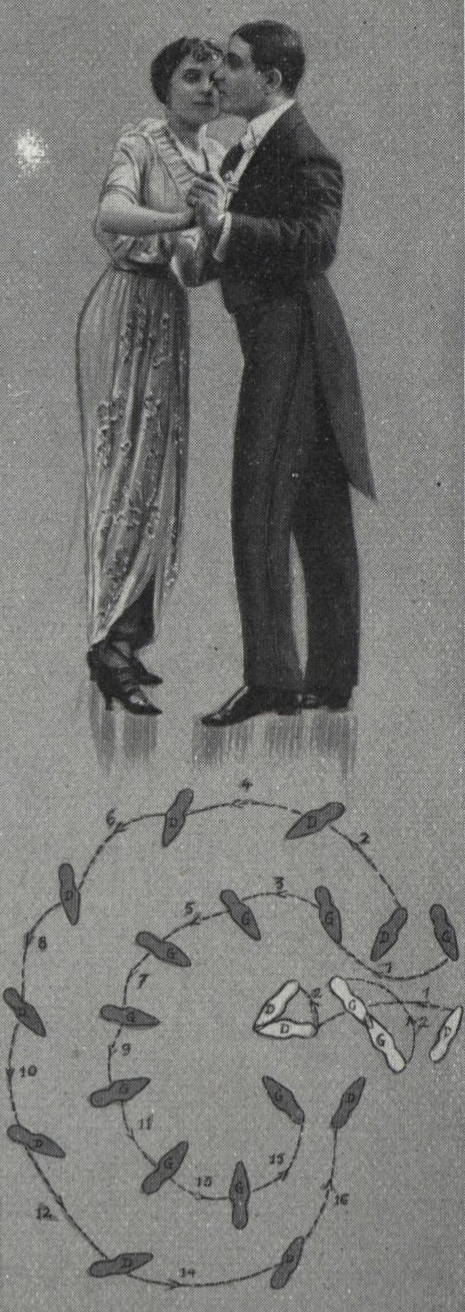
Unclear.
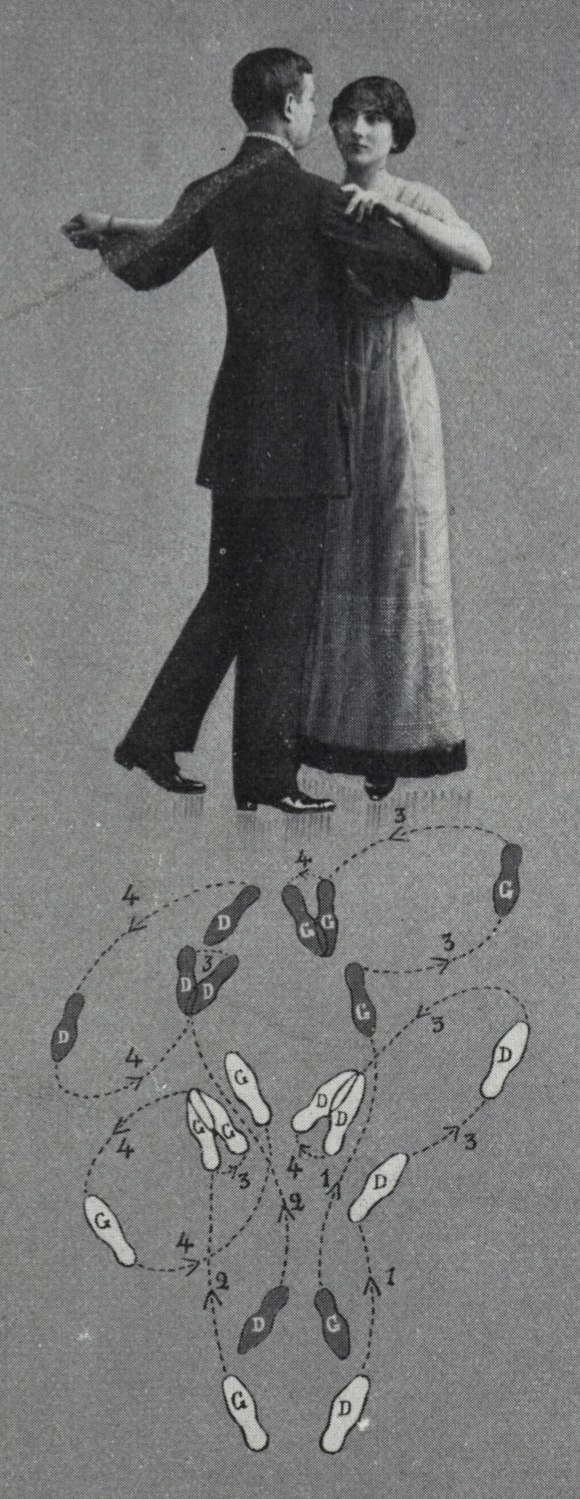
Unclear.
There are two additional diagrams, presented without written descriptions.

This is a short description of a brief Tango sequence involving Two-Step, which isn't clear enough to conclusively reconstruct.
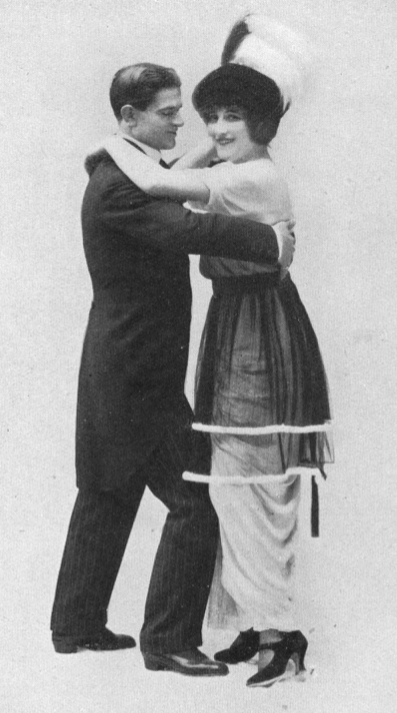
This is a huge (180 pages), and hugely important, Tango manual with many unique figures. In addition to a large collection of unique tango figures, this books includes information on tango music, tango dance venues, tango attire, and even "tango dancing on roller skates."
Crozier's Tango position is a typical closed position, with the Lead's right hand on her back, just under the Follow's shoulder, and the Follow's right hand on his arm, just under his shoulder. The other hands are held at the level of the shoulders. When promenading, the arms point in the direction of travel.
The heads are erect (with chin slightly tilted upwards) and they always face the direction of travel (with the exception of the Follow's when she is backing). The dancers should never glance down at their feet.
Crozier advises that the dancers hold each other "rather further apart than in an ordinary waltz, leaving space between them for the execution of certain figures in which the feet are crossed over one another in front."
In the Tango, the dancers "must appear perfectly at ease, and quite oblivious to the steps their feet meantime perform—an attitude of mind by no means easy of attainment during the earlier stages of mastering the entangling intricacies of the Tango!"
The whole body turns as one, using the waist as a pivot, and the shoulders never move up and down: "they must be kept perfectly level throughout the dance."
Crozier quotes the Tango performers, Les Almanos, as saying to "imitate the sinuous grace of the tiger," noting that "embryonic 'Tangoists' cannot do better than bear that graceful animal in mind while attempting to follow their advice."
Back the Follow four steps, Lead starting with his right foot, Follow with her left.
Then proceed into Le Corté
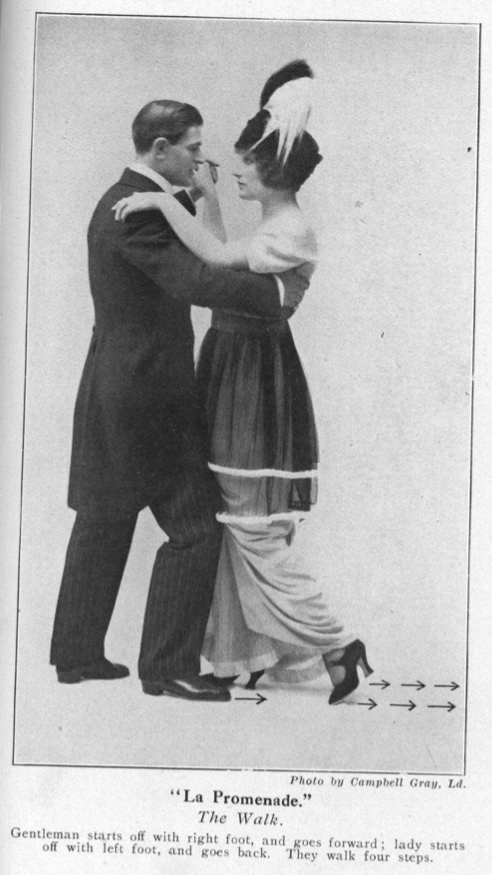
The Lead takes a short step forward with his right (1), brings his left forward without weight (2), then swings it back (3), resting his weight back on his left foot (4), right foot resting lightly on the heel, toe in the air.
The Follow takes a short step back with her left (1), brings her right back without weight (2), then swings it forward (3), resting her weight forward on her right foot (4), left foot resting lightly on the toe, heel in the air.
After Le Corté, La Promenade is repeated, followed by another Corté. Then Le Corté is repeated twice, forming a separate figure.
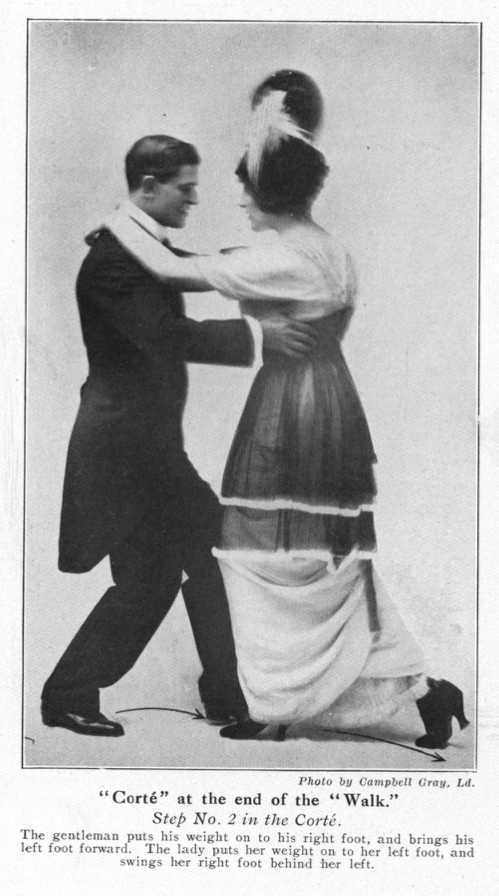
With the Lead's weight on his right foot, he swings his left foot forward without weight (1), then swings it back, taking weight on it (2). He swings the right foot back without weight (3), then swings it forward, taking weight on it (4).
The Follow dances opposite (starting on the Lead's count 3).
The Media Luna is repeated twice.
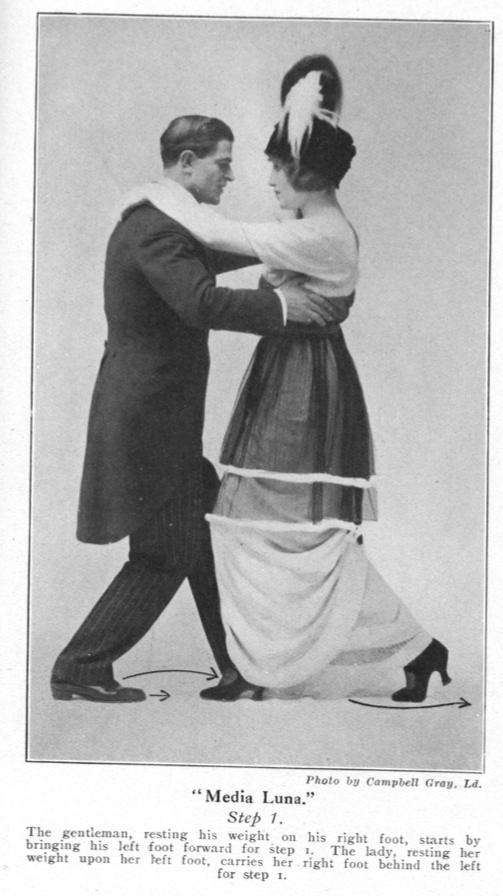
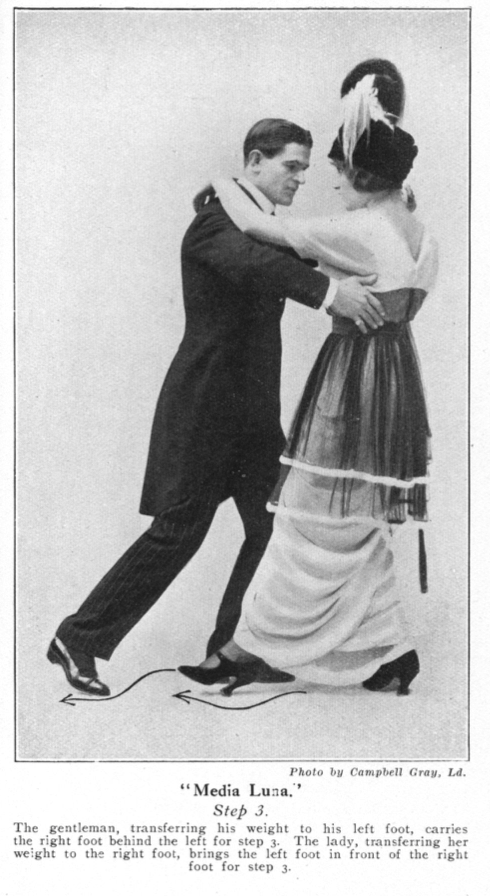
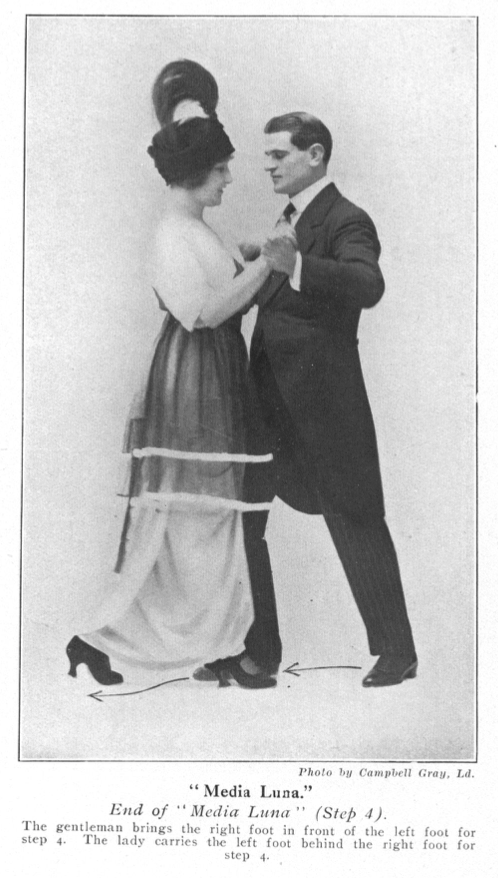
The Lead promenades with inside foot (1), draws outside foot up behind it (2), pauses (3), then promenades with inside foot again (4).
Repeat with outside foot, moving in the same direction. Then repeat it all.
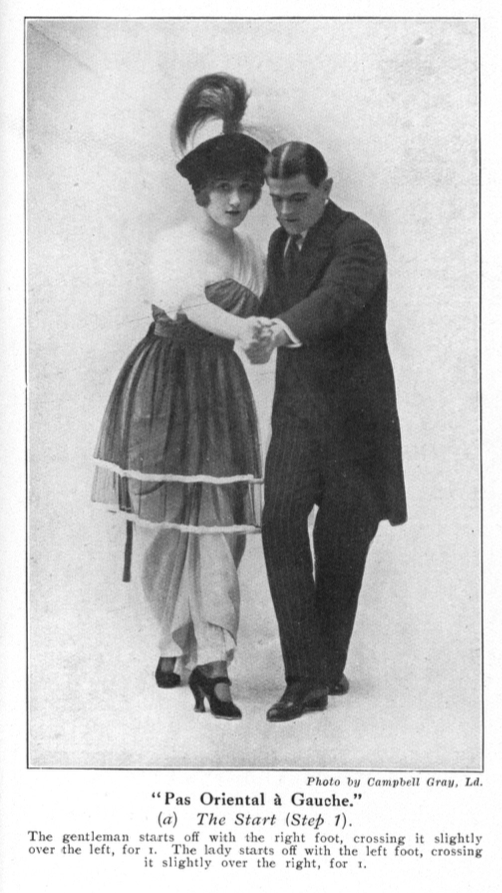
Fourth Figure - Pas Oriental À Gauche (Oriental Steps to the Left) (Crozier, The Tango and How to Dance It, 1913, p. 30):

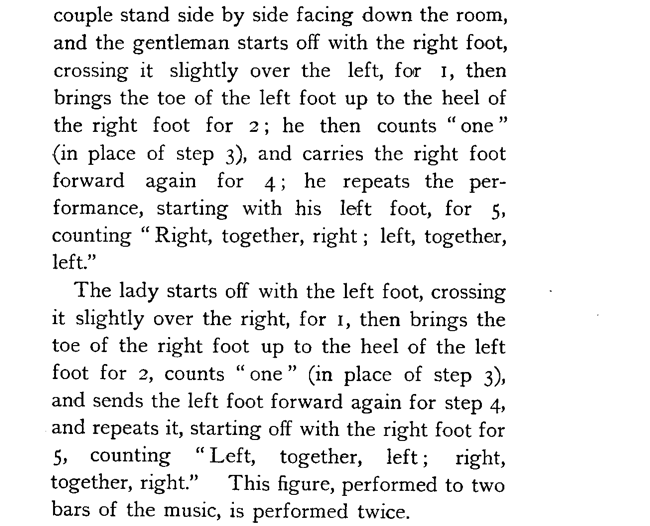

This is the same as Figure 4, but promenading over the elbows, starting with the Lead's left crossing through.
As illustrated, the hands are brought into the frame, pointing towards the side of the elbows.
This figure is performed after Figure 4. Perform Figure 4, then at the very end, turn to face the elbows, and dance Figure 5.
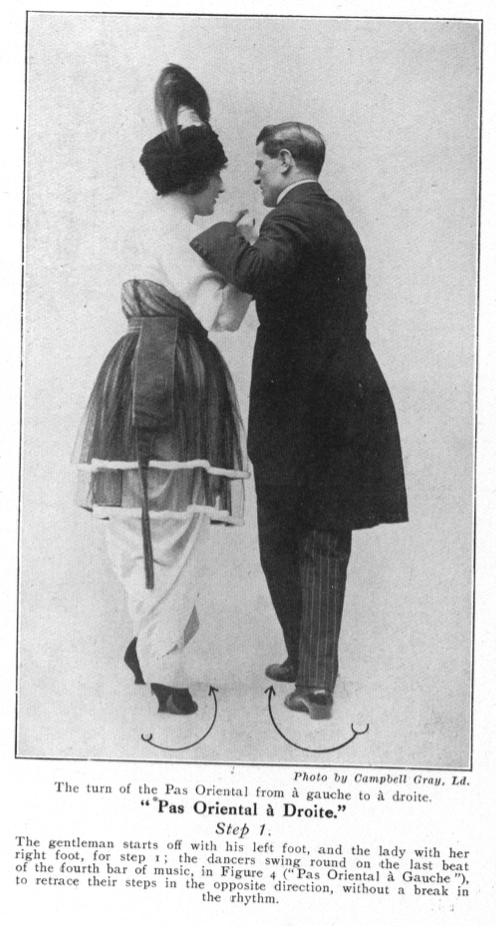
Fifth Figure - Pas Oriental À Droite (Oriental Steps to the Right) (Crozier, The Tango and How to Dance It, 1913, p. 31):
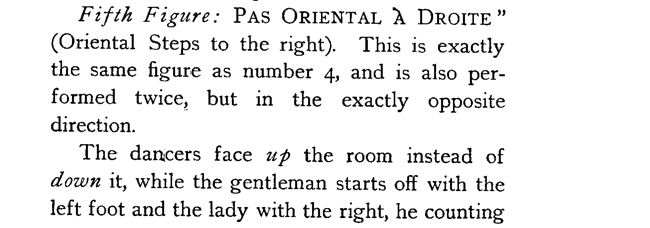
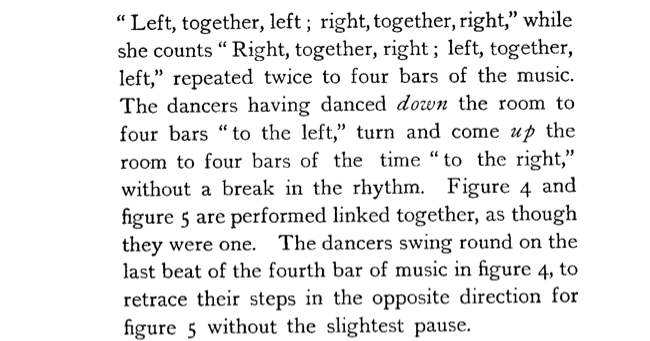

Lead sweeps left around in front of right, crossing it in front of right, taking weight on count 3, then repeat opposite, sweeping the right around to cross it in front of the left.
This is the same step, and even the same timing as Grossmith's Movement 3, it simply omits the first cross step on count 1, joining Grossmith on count 3.
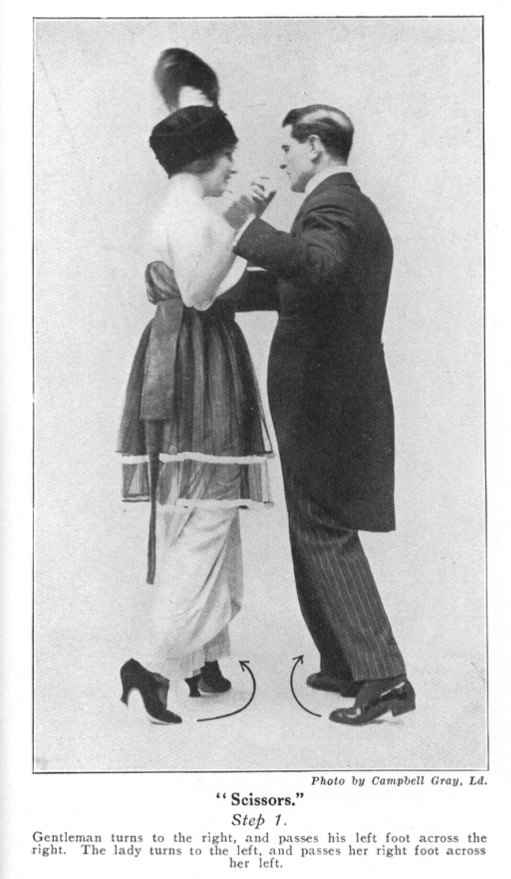
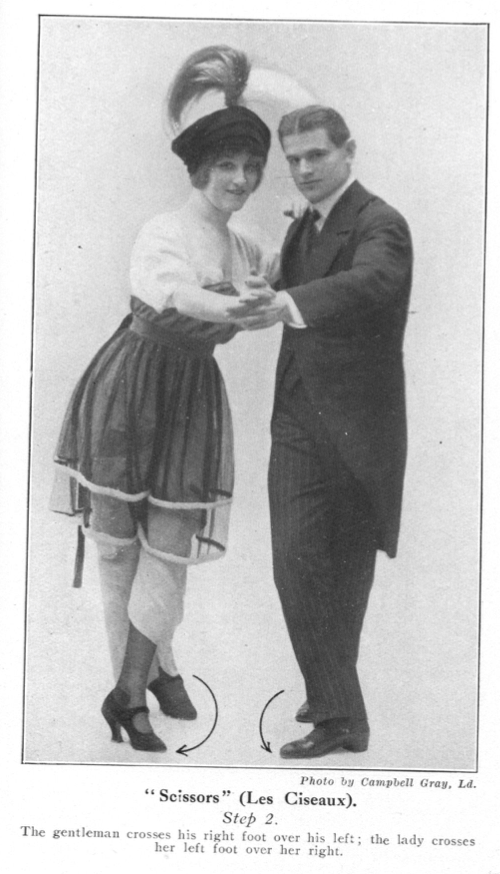
The Lead steps back right (1), brings the left heel even with the side of the right toe without weight (2), pauses for one count (3), and steps back left (4). Repeat this (5, 6, 7, 8).
Then waltz in slow even timing (1, 2, 3, 4, 5, 6), ending up with the Lead's weight back on his left (7), and hold with the Lead's right toe raised, and the Follow's right heel raised (8).
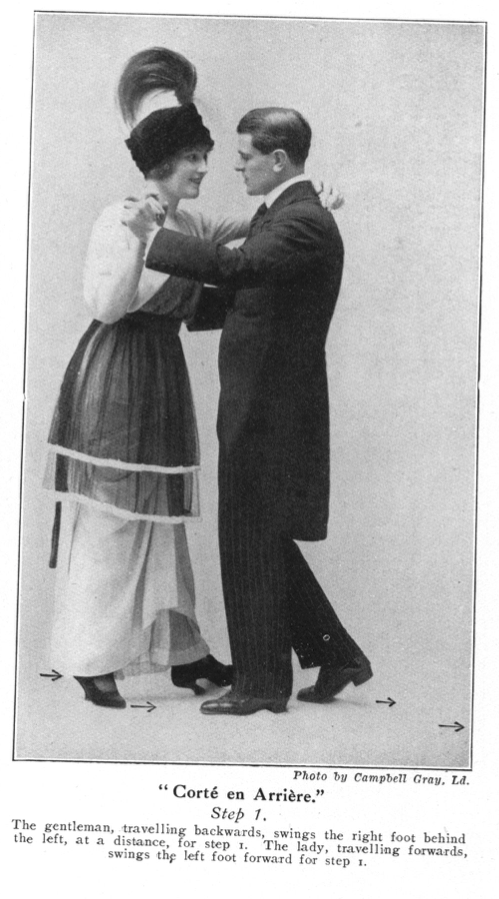
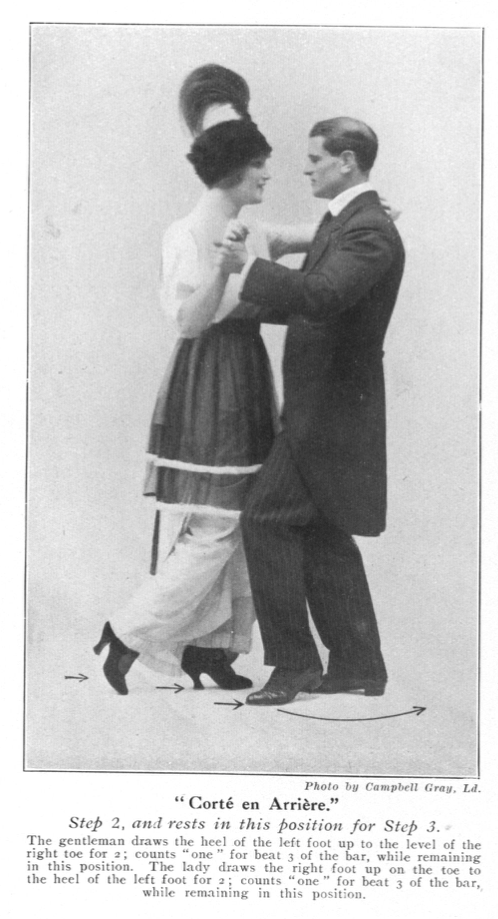

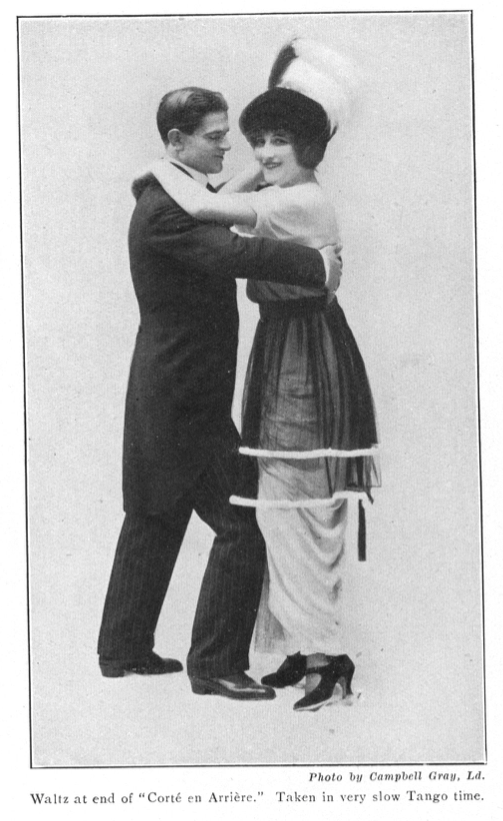
Seventh Figure - Corté En Arrière (Corté Performed Backwards) (Crozier, The Tango and How to Dance It, 1913, p. 33):
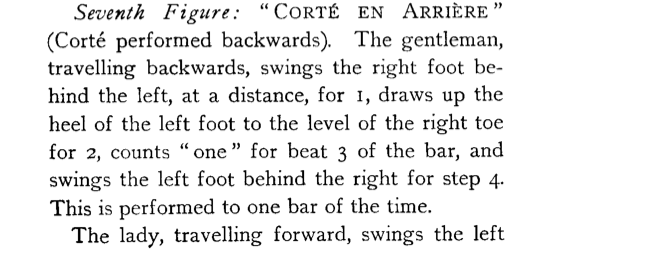
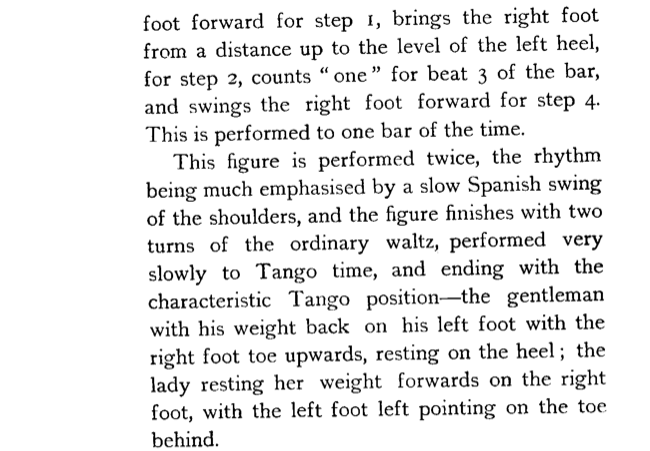




This isn't 100% clear, but it appears to be six counts of right-turning Tango Waltz, followed by six counts of left-turning Tango Waltz, forming the shape of a Figure 8 on the floor, followed by a four count Corté.
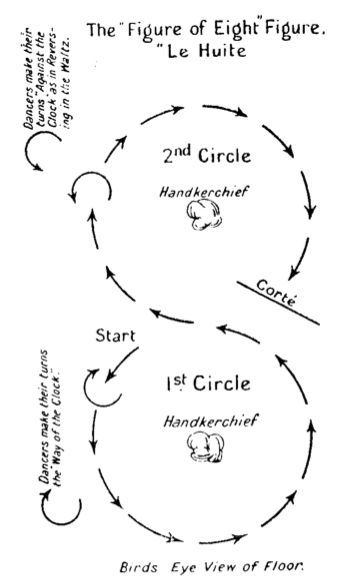
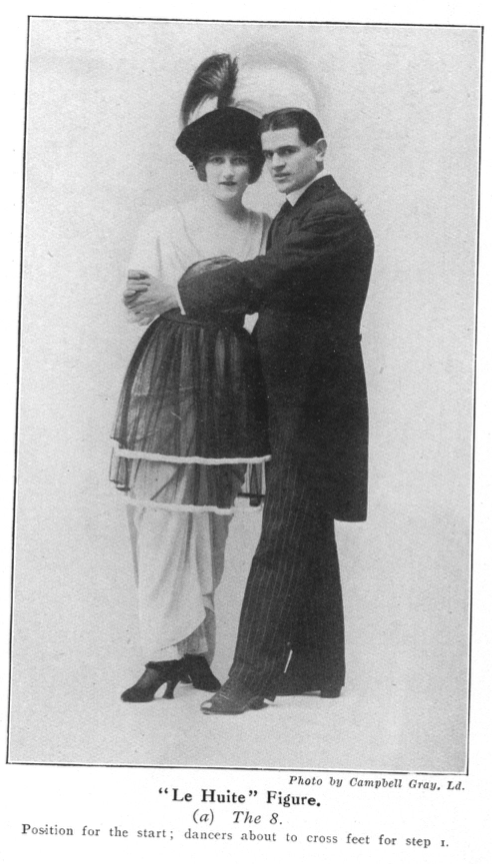
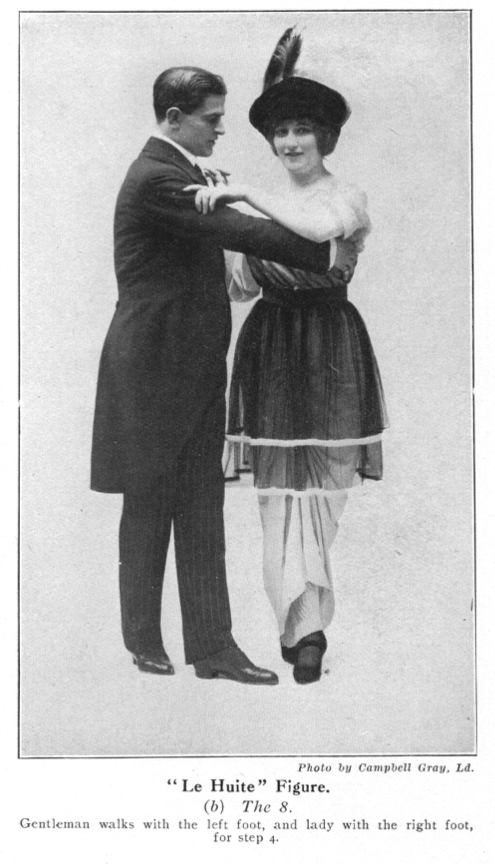
NOTE: According to Crozier, the eight numbered figures above are the essential figures of the Parisian Tango. The following six figures are "Fantaisies" on the Tango, figures improvised by the Parisian Tango performers "Les Almanos." The variations following those are "Other Popular and Attractive Tango Figures."
With open two hands, facing the usual direction, sweep a small circle in front of you, starting forward and outward (1, 2), then dip forward (3), and rise to face the hands on the elbows side (4). Repeat opposite (5, 6, 7, 8), bringing the hands up in a high arch on count 8.
Then the Follow paddle turns (pivoting on her left and paddling four times with her right) under the Lead's right arm, which is holding her left (9, 10, 11, 12). Finally, retake closed position, and finish with a Corté (13, 14, 15, 16).
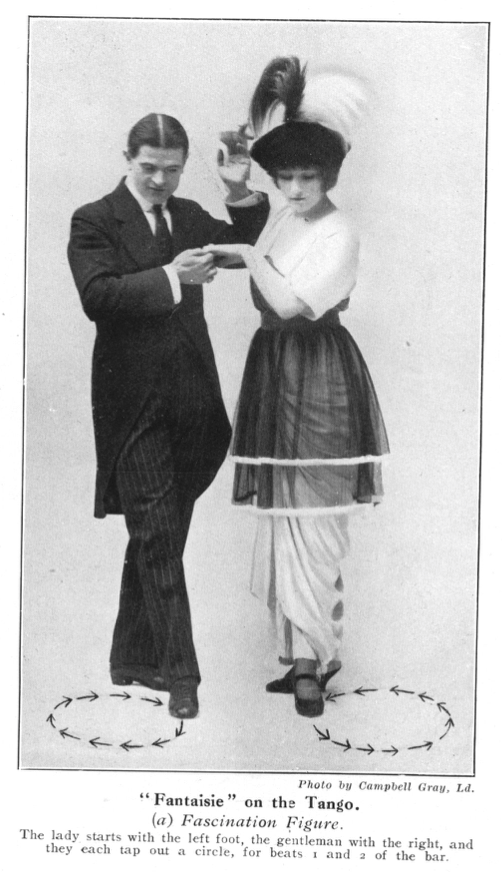
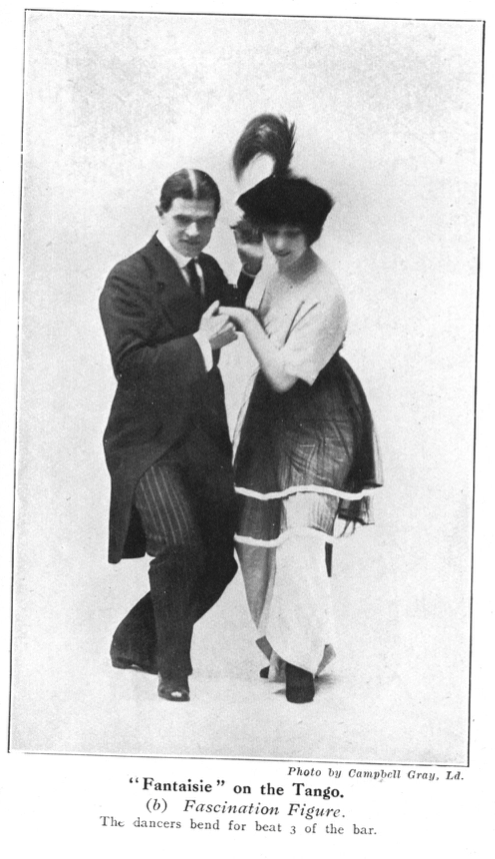
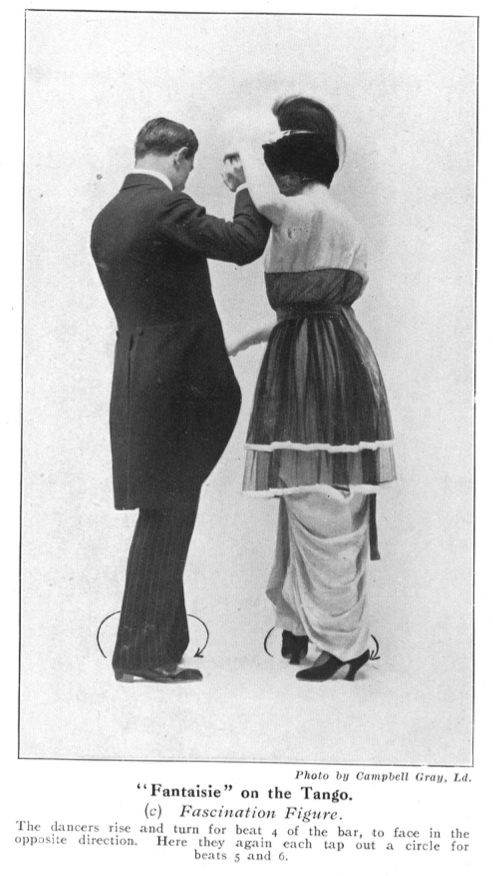
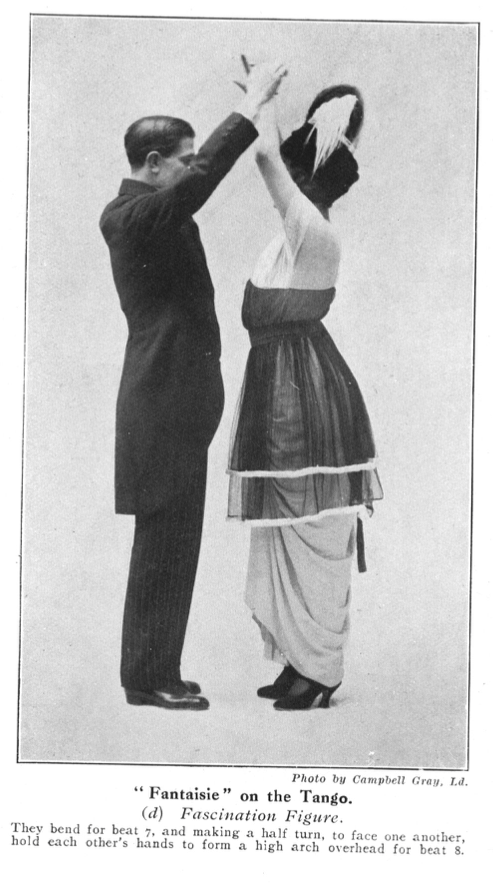
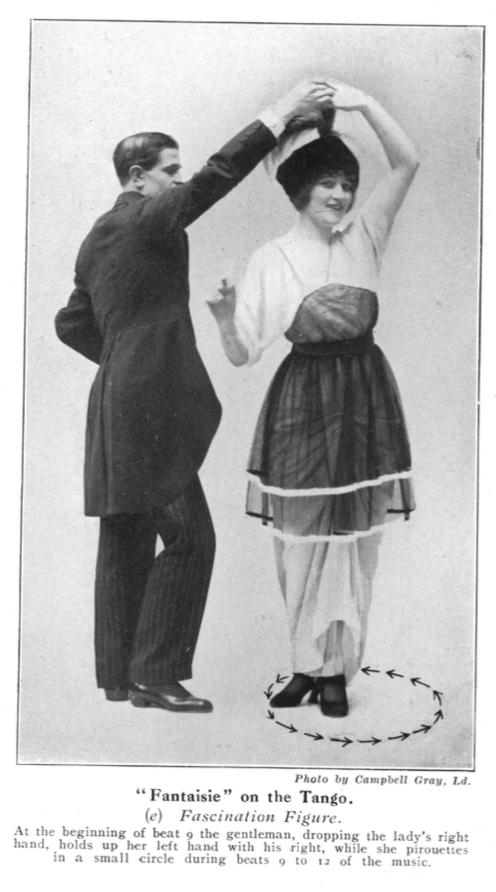
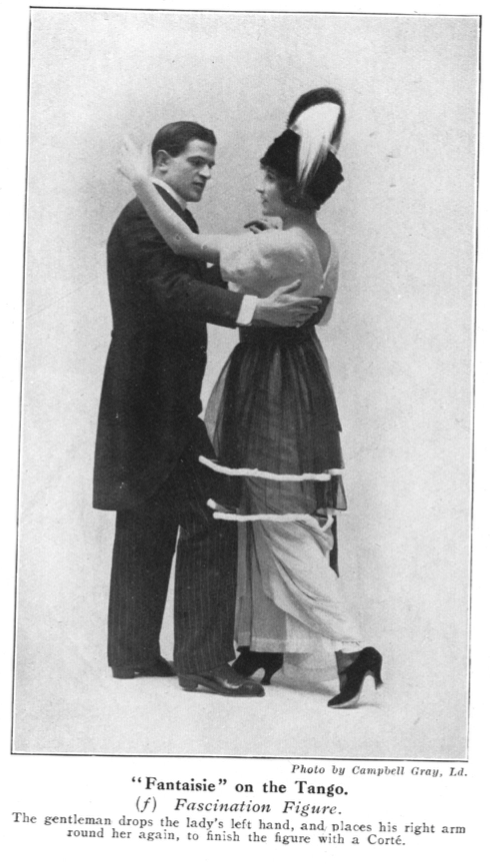
The Lead dances Scissors, as he Leads the Follow to cross back instead of in front. Repeat, and end with a Corté.
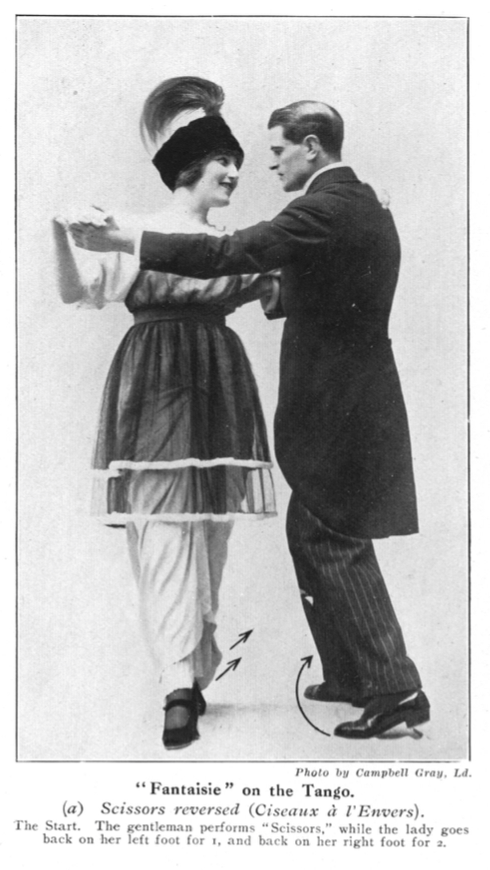
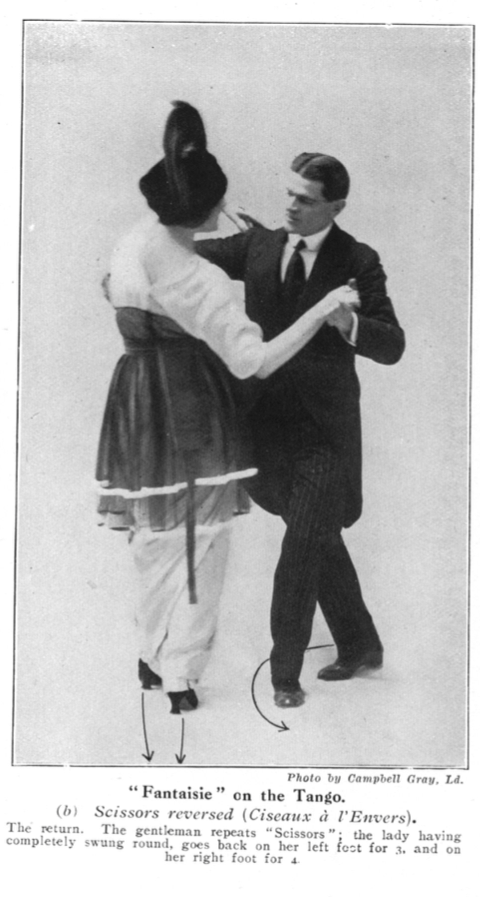
"Ciseaux à l'Envers" Figure (Scissors Reversed) (Crozier, The Tango and How to Dance It, 1913, p. 39):
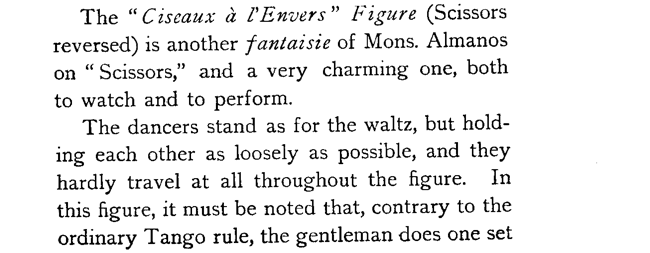
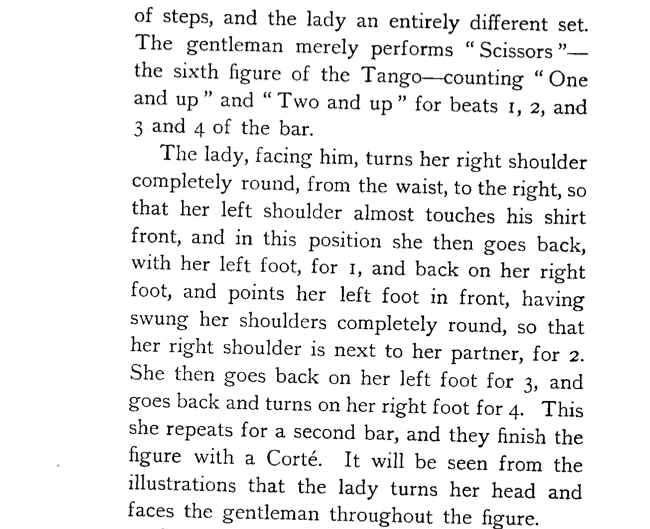


With outside heels raised and apart (as in the first illustration), promenade on the heel straight forward (bringing outside feet together as in the second illustration) (1), then close up inside foot behind outside foot (2). Promenade with heels diagonally forward away from partner (3), then close up inside foot behind outside foot (4). Repeat first two counts (5, 6). Then the Lead steps back left away from the Follow, raising the right toe, as the Follow steps forward into the Lead, raising the left heel (7), and pause (8).
As the heel moves from out to in, it scrapes the floor, hence the name of the figure. The inside feet are always flat to the floor.
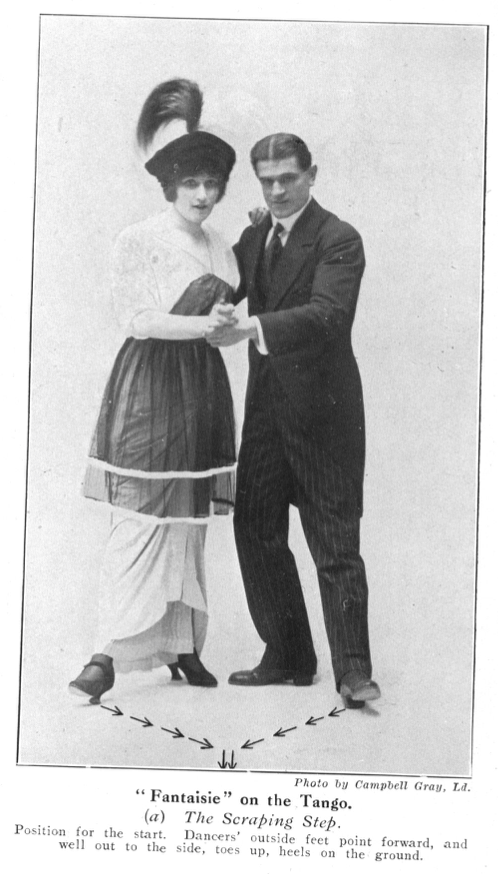
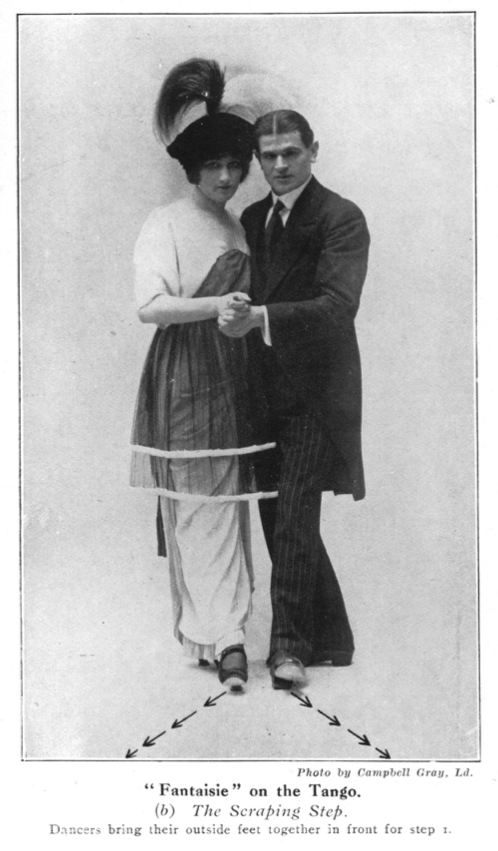
This is a 6 count version of Le Corté, but there is a "half turn towards partner" that is unclear.
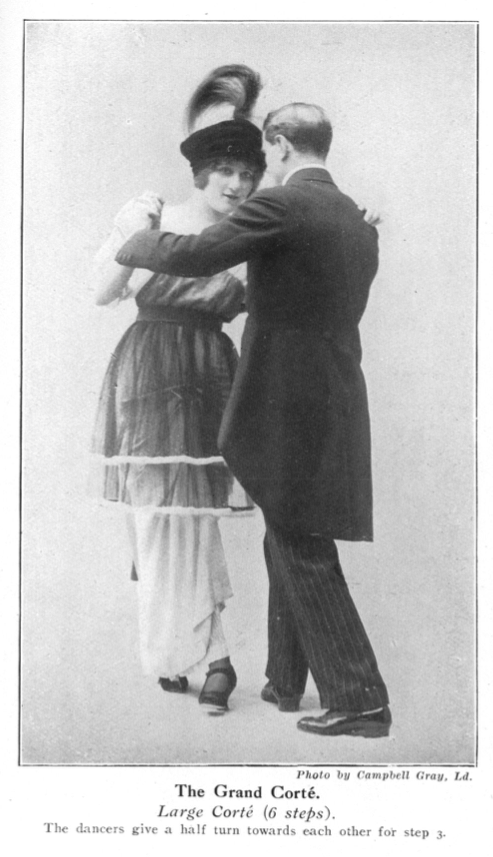
Unclear.
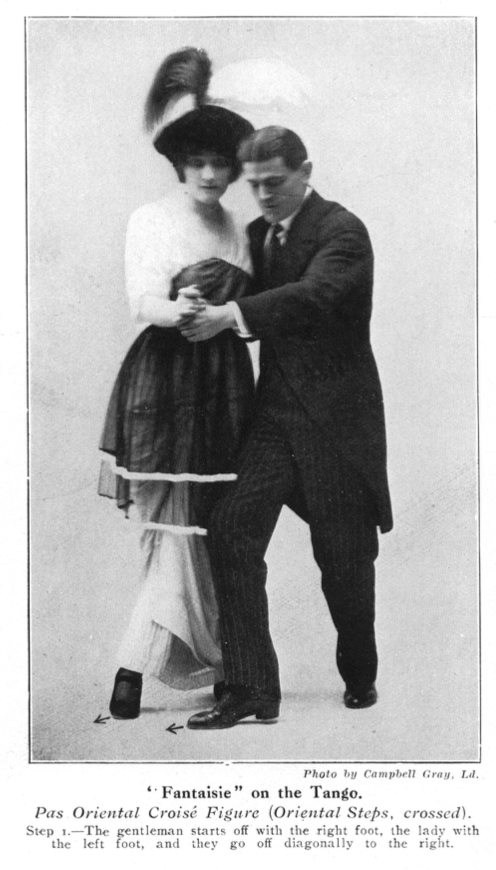
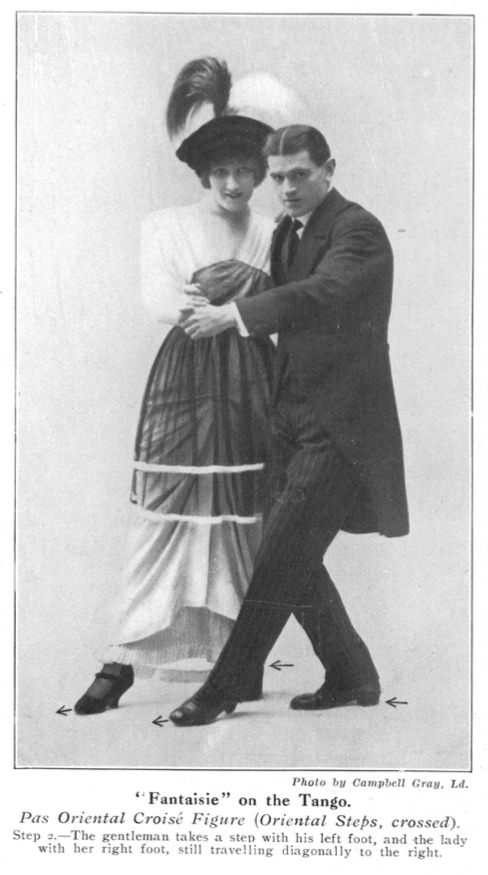
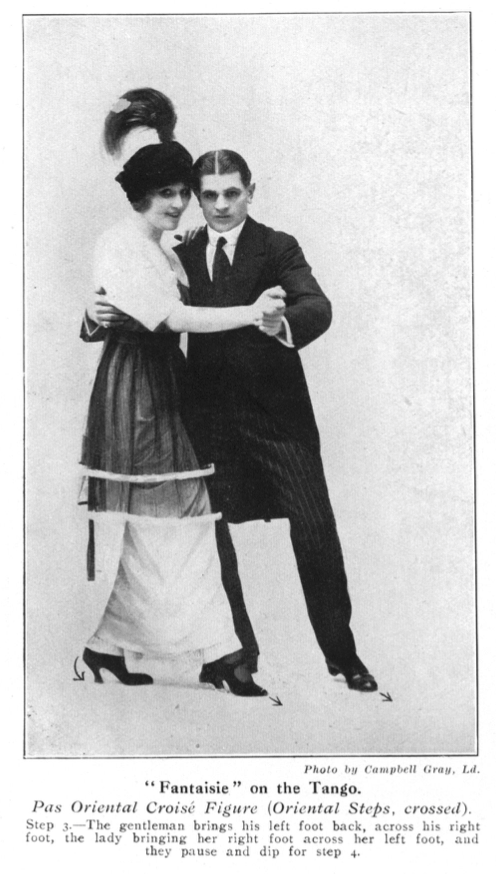
"Pas Oriental Croisé" Figure (Oriental Steps, Crossed) (Crozier, The Tango and How to Dance It, 1913, p. 42):

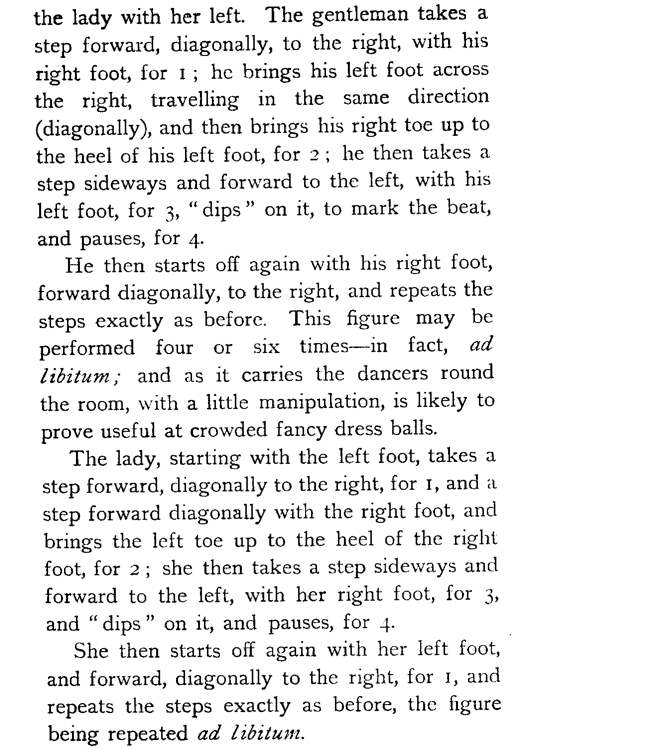



The Lead crosses right over left and pivots in place as the Follow walks six steps around him counterclockwise.
Then she turns to walk six steps clockwise around him, before finishing with a Corté.
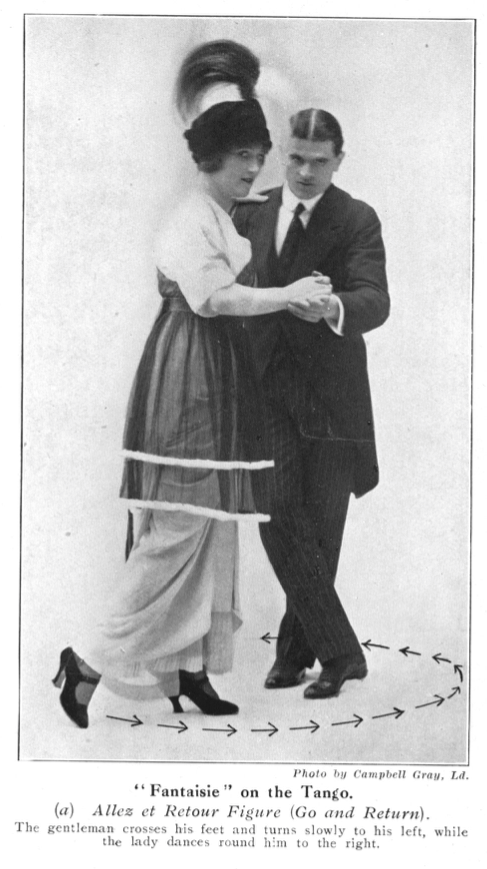
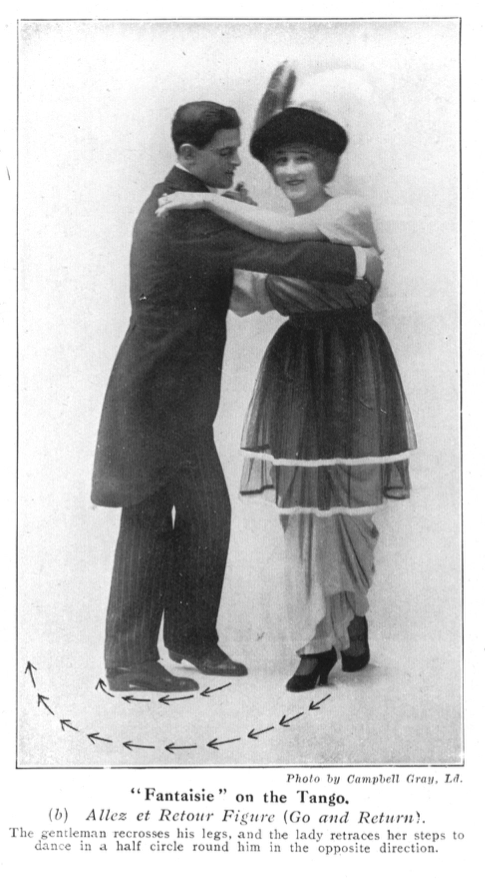
Back the Follow two steps, starting Lead's right, then cross Lead's right over left (3), and points left to the side, turning to the right (4). Then cross left over right (5), and point right to the side, turning left (6). Repeat these two crosses (7, 8, 9, 10). The Follow dances parallel, always crossing behind, and retreating up as the Lead advances.
Repeat the whole figure and end with a Corté, for a total of 24 counts.
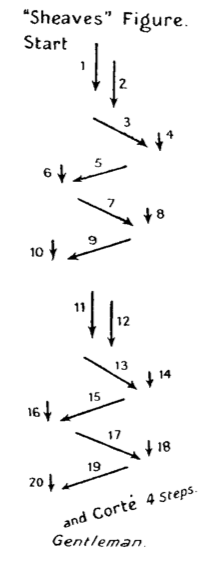
Promenade two steps along LOD starting outside feet (1, 2), then touch outside feet forward (3), and behind (4), turning slightly in to face partner when the outside foot is forward, and slightly away when the outside foot is behind.
Promenade two steps along LOD with outside foot (5, 6), pivot halfway around on count 7 (the diagram implies it is a left turn, but the written description strongly implies a right turn), and point new outside foot (Lead's right and Follow's left) along LOD (8).
Repeat opposite, continuing along LOD.
Repeat from the beginning, then end with a Corté.
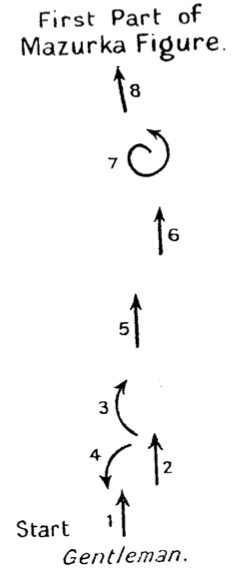
The Lead crosses right over left (1), promenades two steps (2, 3), and touches his left foot to the side, turning on it (4), to repeat opposite by crossing the left over right (5, 6, 7, 8).
Then do it in two counts instead of four: cross right (1), point left (2), cross left (3), point right (4). Then finish with a cross (5), forward into Follow (6), close (and), back left (7), and pause (8), leaving the right heel forward, toe raised.
"Scissors, Big and Small" Figure (The Farmyard Figure, The Hen) (Crozier, The Tango and How to Dance It, 1913, p. 52):
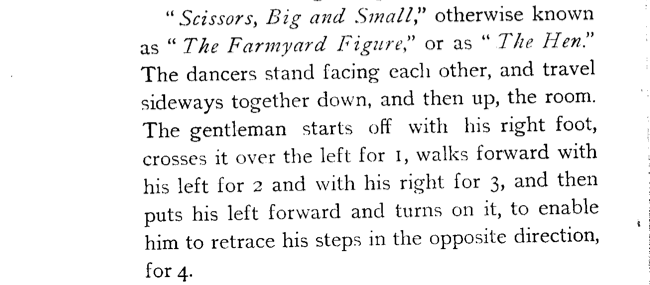
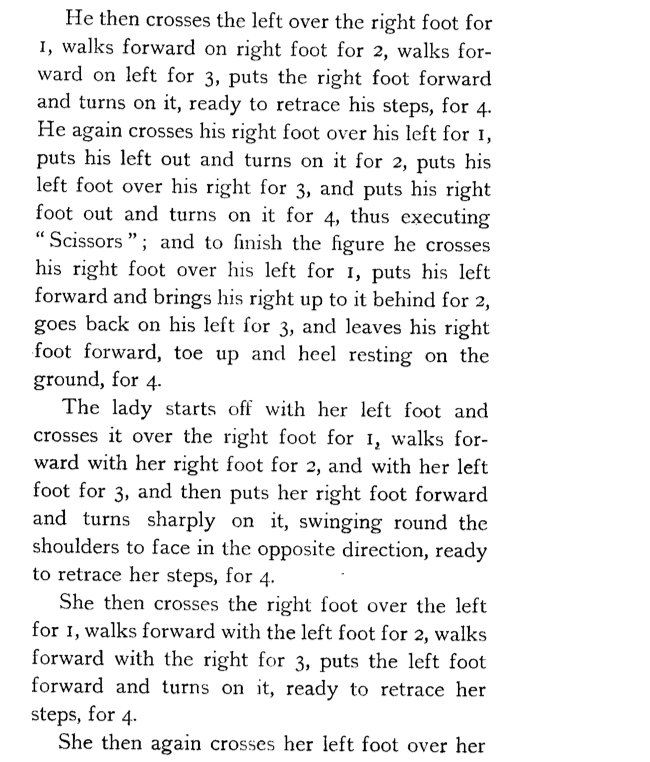
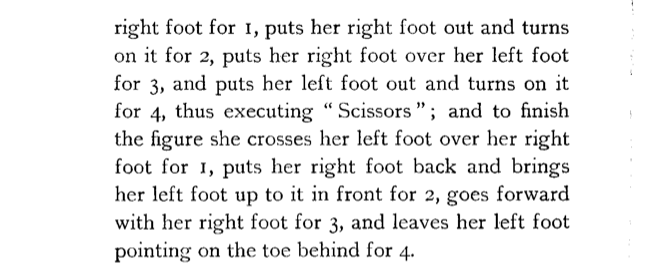
This begins with two single cross-points from the previous figure: cross (1), point (2), cross (3), point (4). Then cross (5), walk (6), dip/lunge (7), hold (8).
Rise and repeat opposite. Finish with the two cross points and Corté that ends the previous figure. (The Corté here is slightly different: cross, side, close, back, hold, instead of cross, forward, close, back, hold.)
This is a slow, turning, traveling Cross-Step Waltz, exactly as it is danced today. Cross (1), around (2), side (3), cross (4), between (5), side (6).
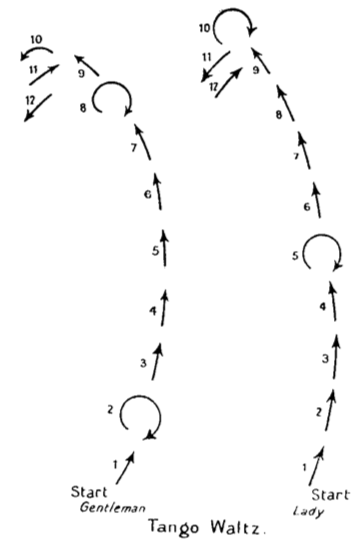
This is a non-turning box step in QQS timing, starting back on the Lead's left.
Repeat several times, and finish with a Corté.
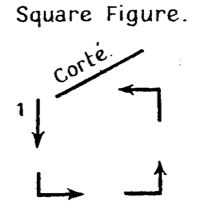
Promenade four half-time steps, starting with a cross of inside feet (1, 3, 5, 7), turning to face partner on the fourth step. Then close inside foot to outside foot (1), rock Lead back on outside foot (3), forward on inside foot (5), back on outside foot (7). Then step back with inside foot (1), side with outside foot (3), then finish with a four-count Corté (5, 6, 7, 8).
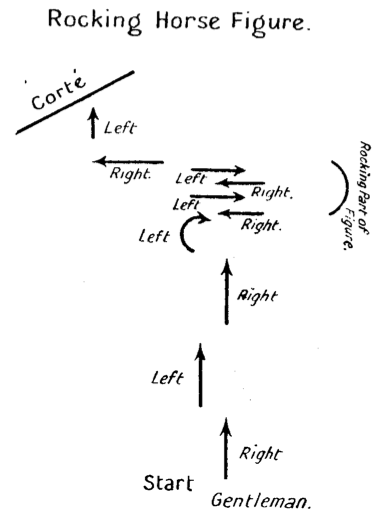
Promenade two steps, starting outside feet (1, 2), then touch outside foot forward (3), and back (4). Repeat (5, 6, 7, 8). Then finish with a Corté.
During the touches, there is a slight rise and fall on the supporting foot "to emphasize the rhythm."
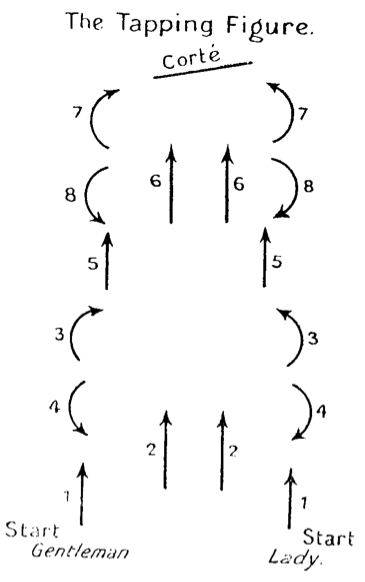
Promenade one step, starting inside foot (1), touch outside to the side (away from partner) with toe and knee inwards, kneecap facing the floor (2), then step forward on it (3) and pause (4). Repeat twice, and end with a Corté.
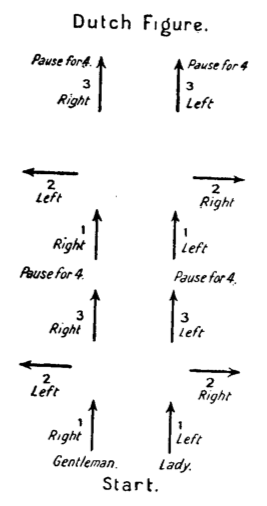
Do the Tapping Figure twice (1-8), then promenade two steps (1, 2), touch forward (3), and put weight onto it, turning to face the elbows (4). Then promenade two steps (5, 6), and touch side (7) and step forward (8) as in the Dutch Figure. Continue to perform the Dutch Figure as usual, starting inside foot (Lead's left) (1, 2, 3, 4). Finish with a Corté.
Promenade two steps, starting inside feet (1, 2), then point the inside foot forward (3), and swing it around the outside foot, rolling away from partner, stepping in the opposite direction with it (4). Repeat opposite (5, 6, 7, 8), and finish with two Cortés.
The arms are unspecified, but must necessarily disengage on the rollaway.
The description contradicts itself, but here's the gist: Promenade four steps in half time, starting inside feet (1, 3, 5, 7), then touch outside feet forward (8). Step back on outside feet (1), step back on inside feet (and), and close outside feet to inside feet, kicking the inside feet slightly up behind (2). Repeat this chasséing kick opposite, forward inside, forward outside, close inside and kick outside foot (3, and, 4). Repeat the kicking part back and forward again (5, and, 6, 7, and, 8). Finish with a Corté.
Promenade inside foot (1), outside foot (and), close (2), turn outside foot in to partner (3), and point out to the side (4), cross outside foot over (5), cross inside foot over (6), point outside in front (7), and step on it (8).
Promenade three steps diagonally forward, starting outside foot (1, 2, 3), then touch behind (4). Repeat opposite, traveling back to place over the elbows (5, 6, 7, 8), taking weight on the outside foot at the end. Then do three steps of a grapevine, Lead crossing back right (1, 2, 3), and kick the left foot up in front on count 4. Then do a three-step grapevine back to place beginning with the Lead crossing the left foot behind (5, 6, 7), and kick the right foot up in front (8). Finish with a Corté
Promenade two steps starting outside foot (1, 2), then point outside foot forward (3), twist it in toward partner (and), and flick it up (4). Repeat twice, and finish with a Corté, or go straight into the Scissors.
Similar to the Corté, but instead of the Lead bringing the left foot forward on count 2 (and the Follow backward), both tap the foot out to the side on count 2, before going back/forward on it on count 3, and holding 4.
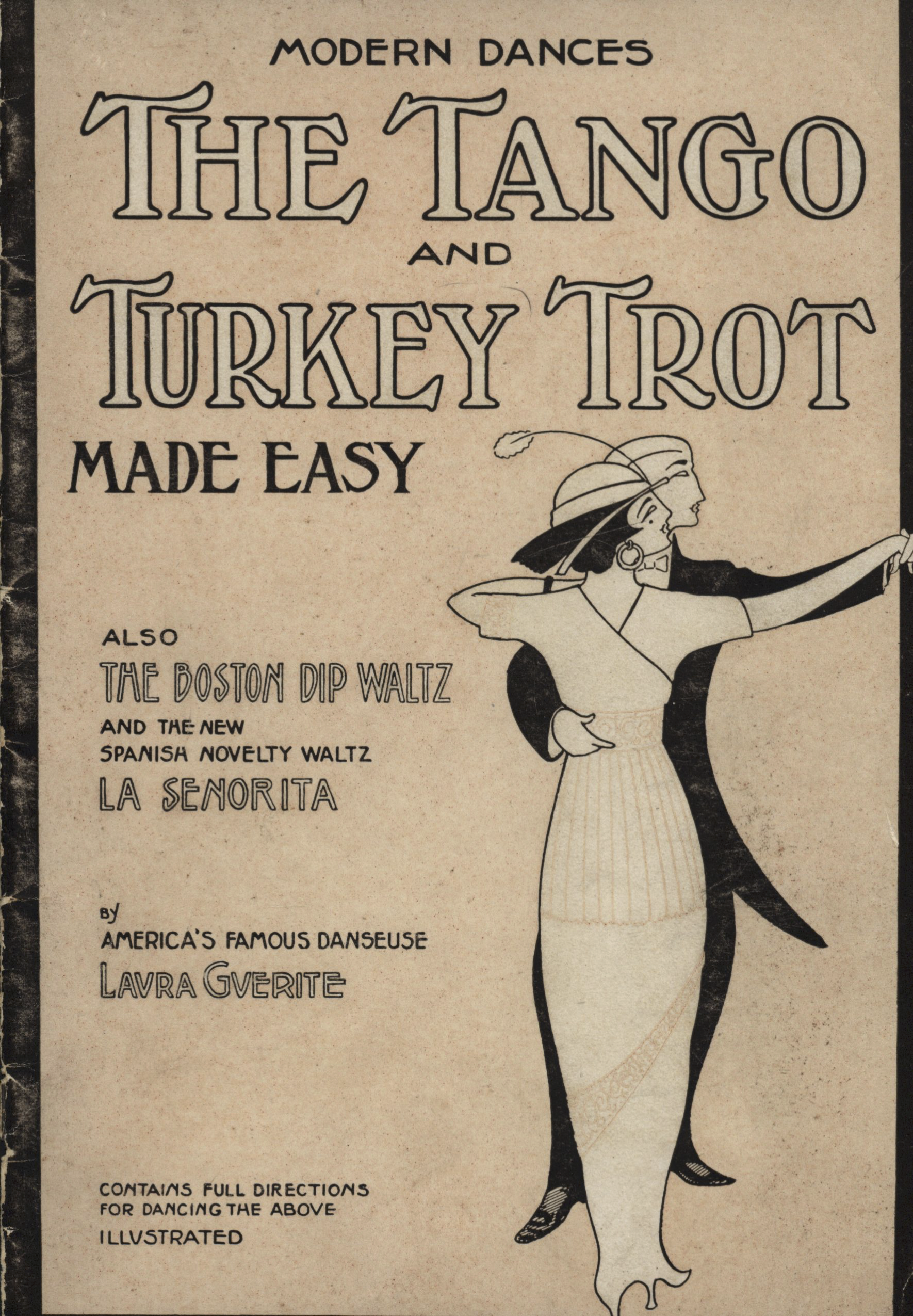
With all due respect to Ms. Guerite, this source is a mess. The majority of the written descriptions are entirely unclear, and the illustrations do not match the figures. For example, the second figure explicitly references the second illustration, which shows a cross step, even though there is no cross step in the second figure. Furthermore, there are no references to illustrations 3 through 8 anywhere in the text. For this reason, we've simply collected them at the bottom.
The Lead's right arm is around the Follow's waist, and her left hand is on his shoulder.
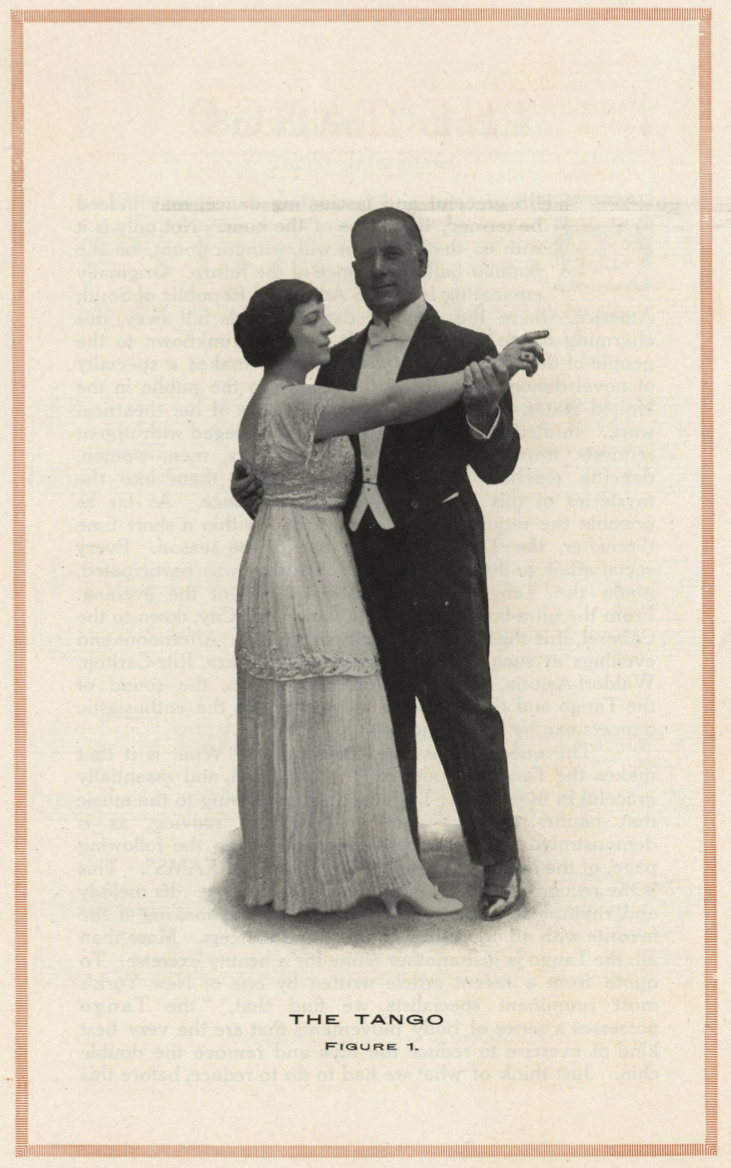
Back the Follow four steps, starting Lead's right, ending with Lead's left in front.
Lead steps forward right (1), brings the left up in line with the right (2), steps back on the left (3), and holds (4).
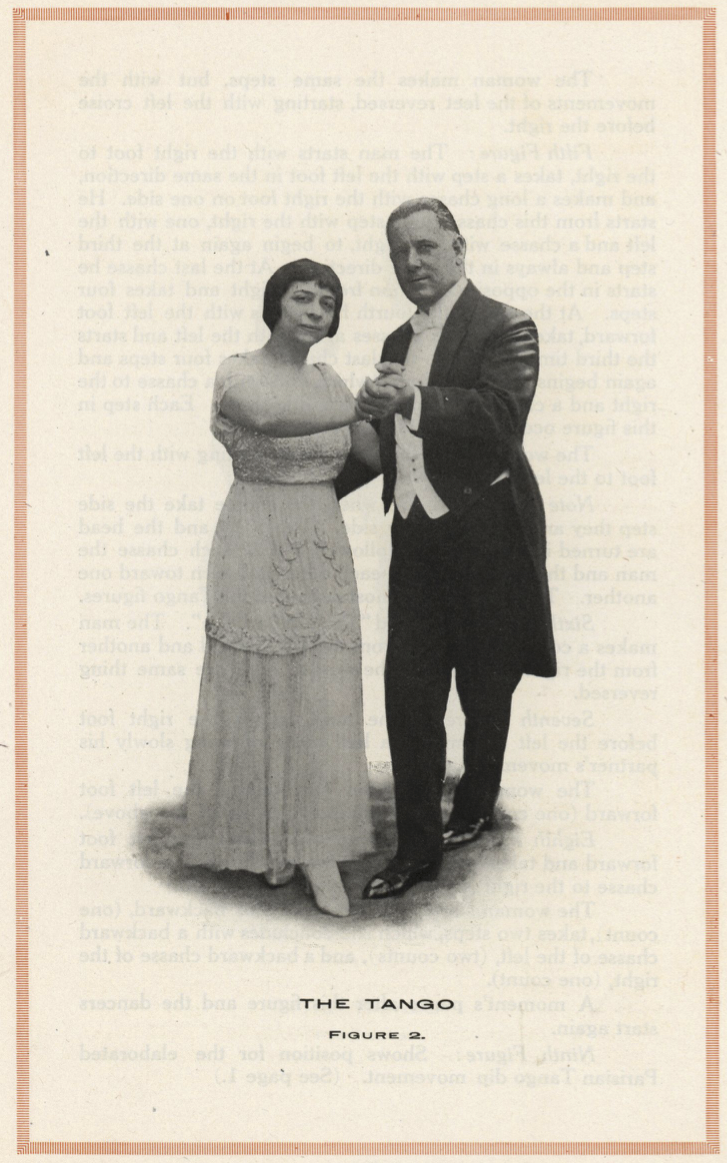
Unclear.
The shape is that of the Back and Forward version Ochos, starting with a cross to the left, but the timing is odd.
Not entirely clear, but involving chassés;.
This is described as a Corté forward on the left for the Lead, followed by a Corté backward on the right.
It's unclear exactly what that means, but it could be: Lead's left forward (1), bring right up to it without weight (2), Lead's right back (3), bring left up to it without weight (4).
The Lead crosses right over left, and leads the Follow to walk forward around him.
This is another unclear chassé figure.
This says that the ninth illustration (below) shows the "position for the elaborated Parisian Tango dip movement."
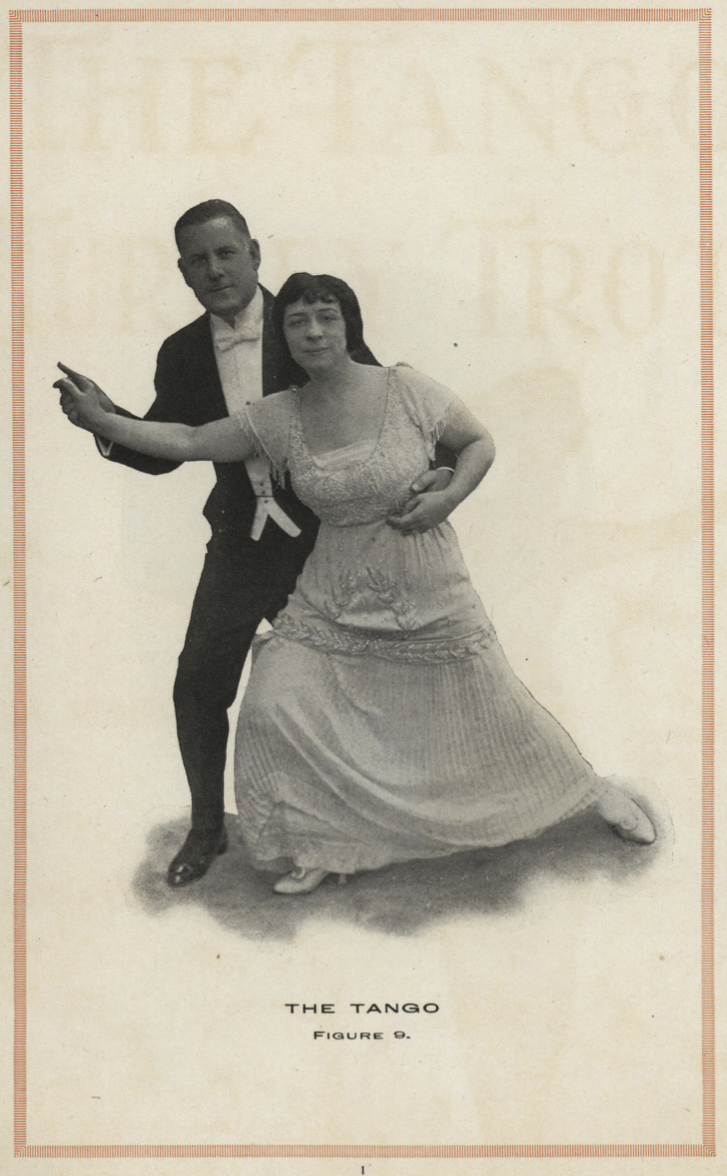
Unclear.
Unclear.
Unclear.
Unclear.
Unclear.
Unclear.
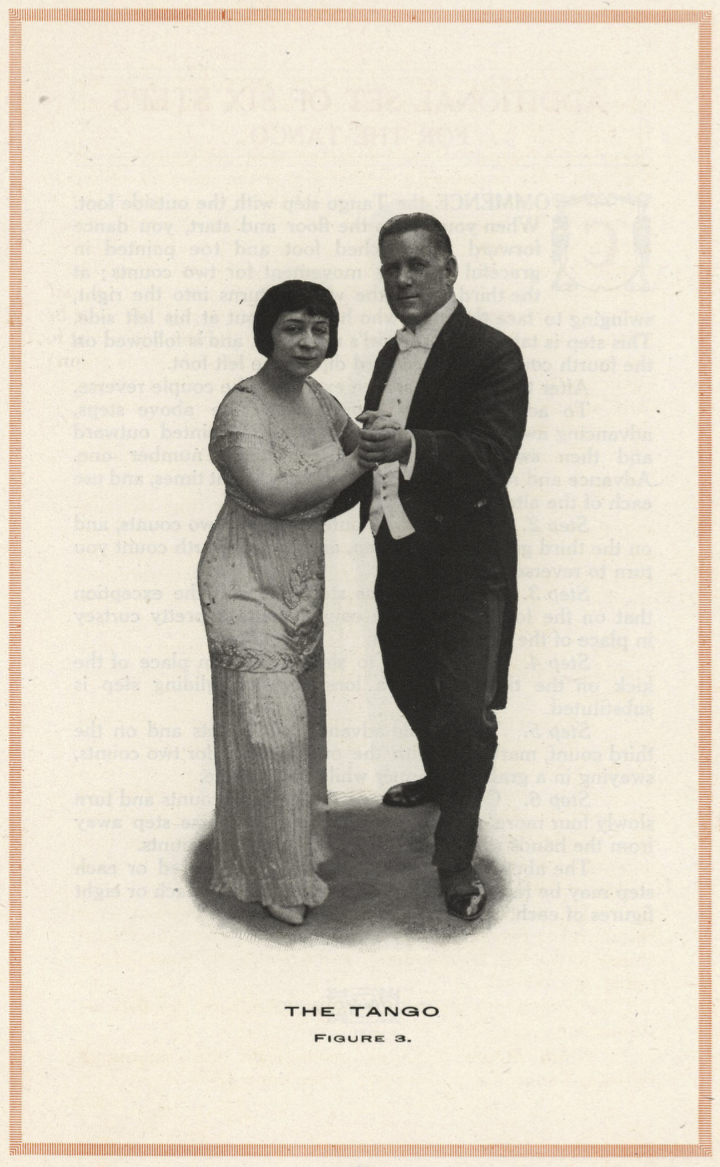
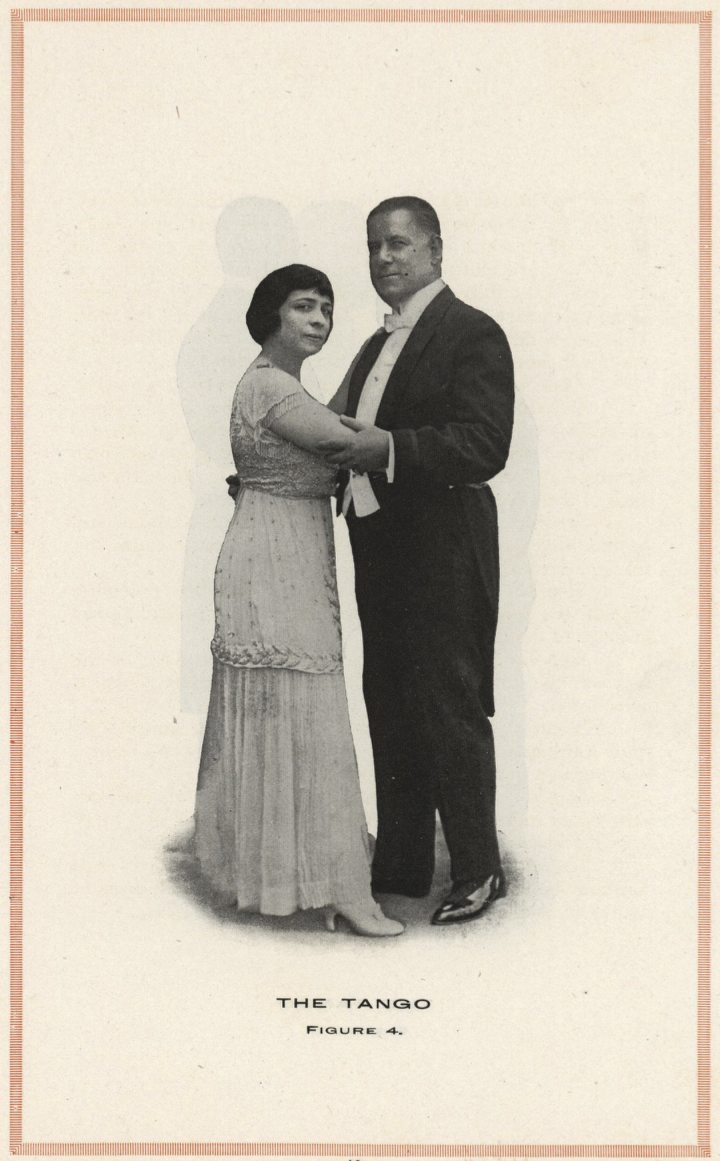
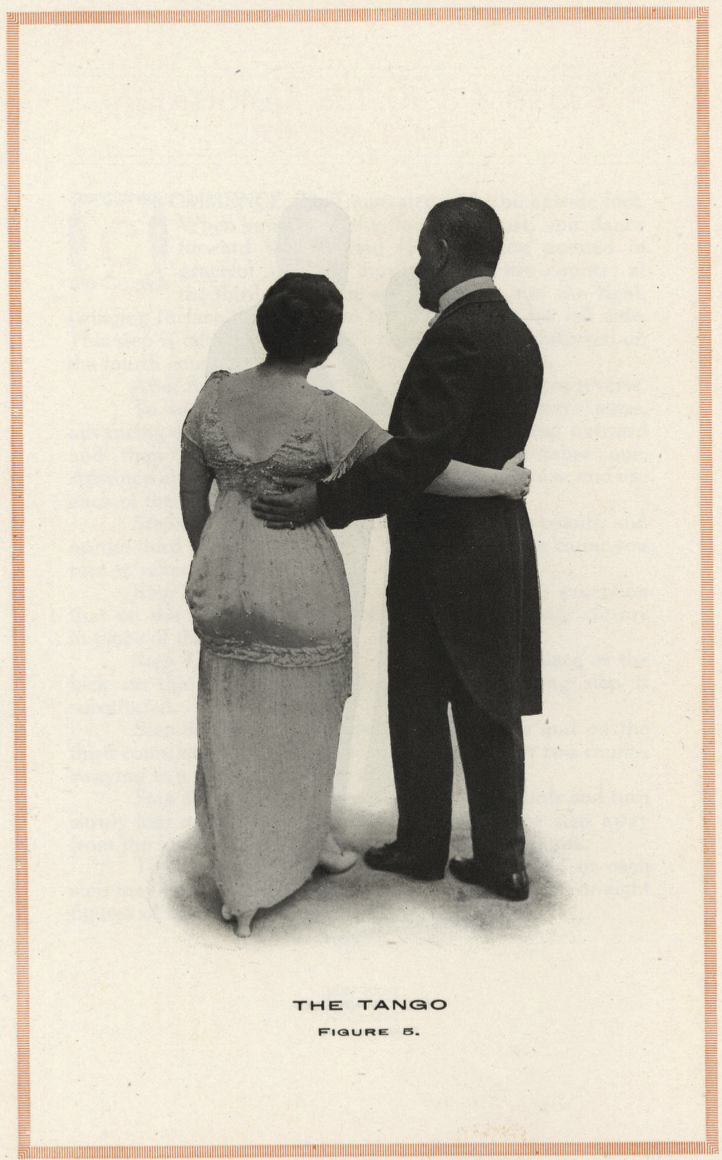
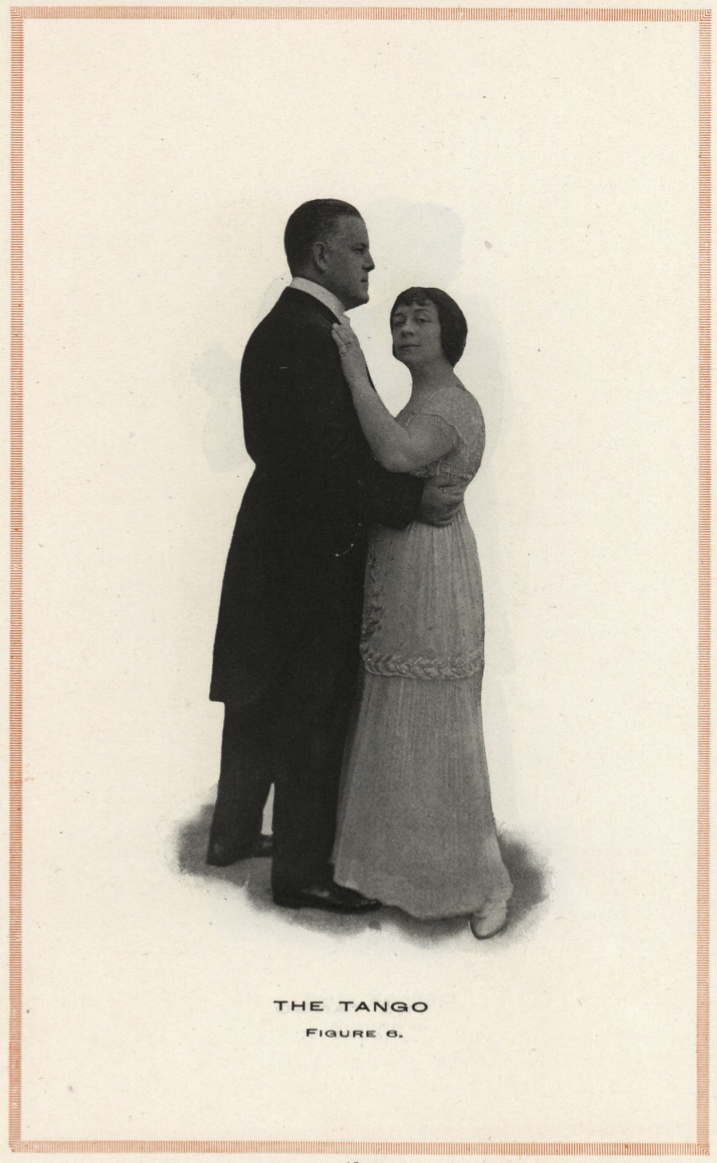
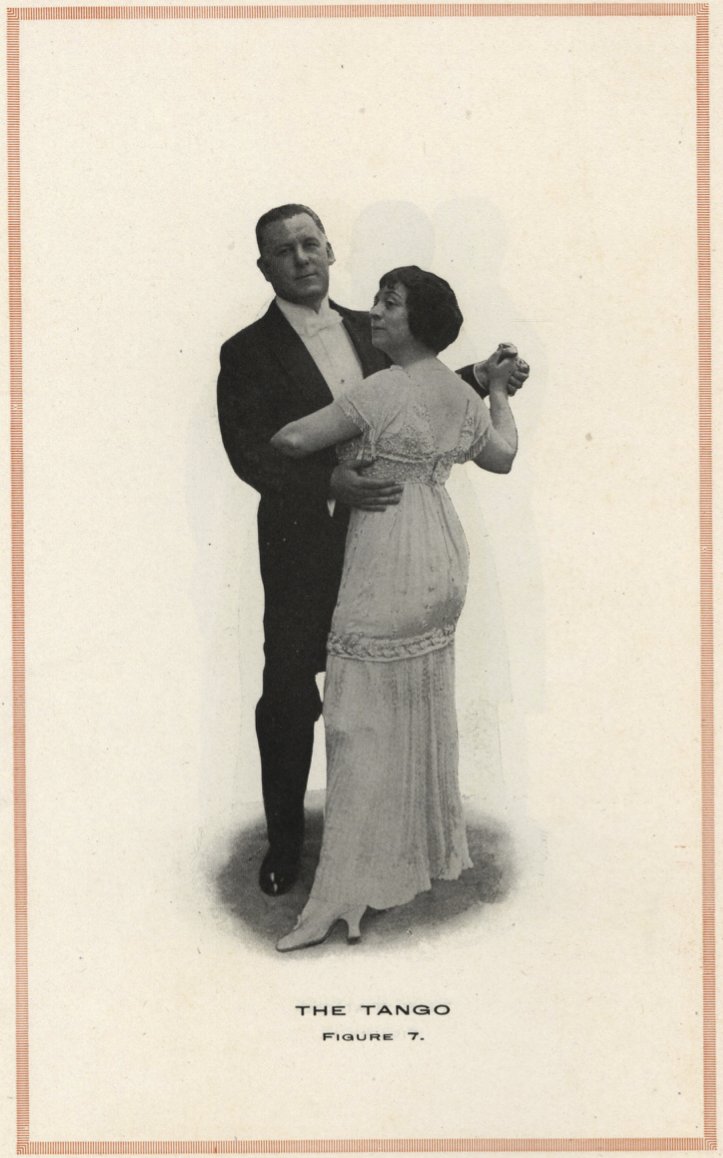
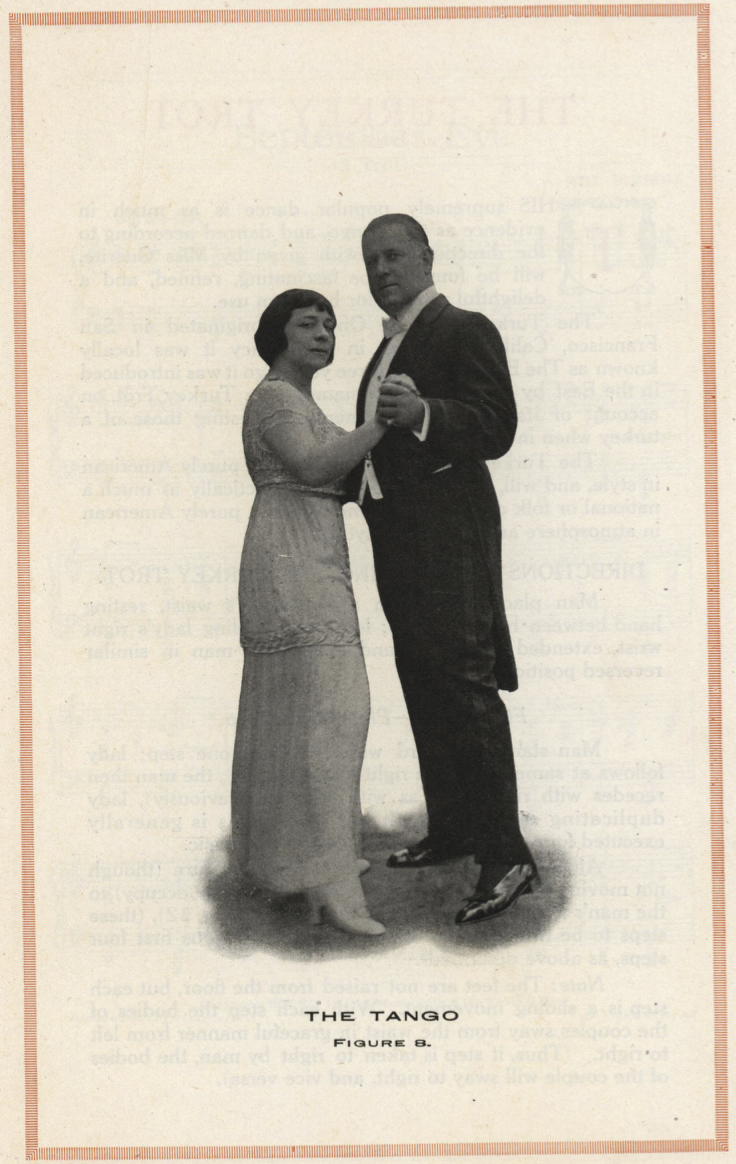
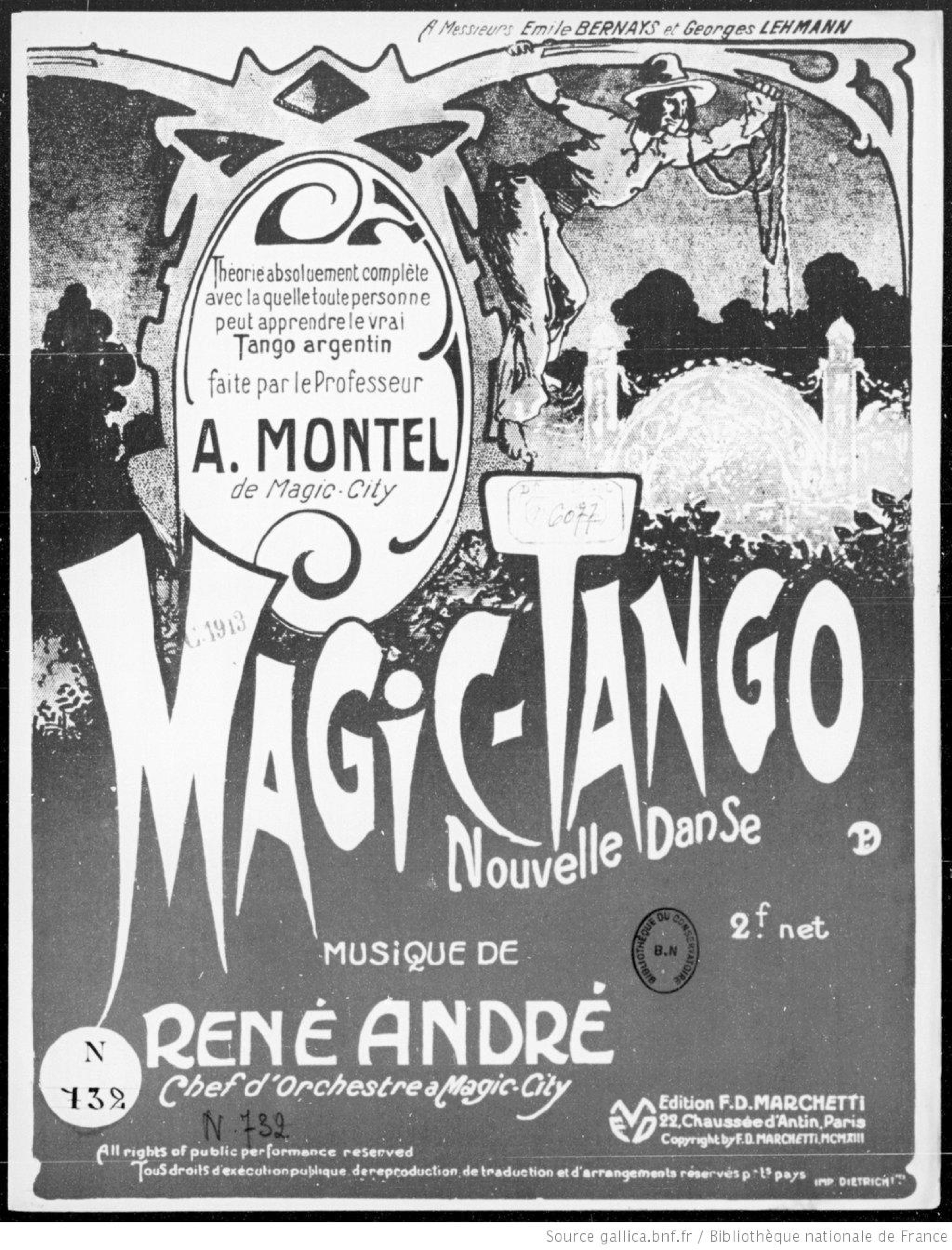
This is a description of 10 Tango steps accompanying sheet music for René André's Magic-Tango.
Back the Follow or back the Lead, any number of steps, starting on the Lead's right.
Forward right (1), side left (2), close right (and), back left (3), flex left (4).
Back right (1), side left (2), close right (and), back left (3), flex left (4).
Do the first three steps of the Corté to get outside feet free in Promenade position.
The promenade two steps (1, 2), and chassé (3, and).
This can also be done to the right, after doing Le Pas de Changement.
Cross right over left (1), touch left to side and pivot on it (2), cross left over right (3), touch right to side and pivot on it (4).
Lead crosses right over left, and pivots in places, as the Follow circles him with cross-swivels (cross left, close right behind).
Pas Oriental is the name that Montel gives to the Follow's cross-swiveling steps in La Roue.
Cross right over left (1), step side left (2), right back (3), cross left over right (4), step side right (5), forward left (6).
Forward right (1), side left (2), close right to left (and), back left (3), side right (4), close left to right (and).
After the first two counts of a Corté to get the outside feet free, promenade three steps forward (1, 2, 3), pivoting around on the third step to promenade forward with new outside feet (4, 5, 6).
This is like a Cross-Step Waltz that starts on count 6.
To change which foot is free on the first beat of the bar (from right foot to left foot), step back right (1), side left (2), and close right to left (and), and have left foot free for count 3.
To change back, step forward left (1), side right (2), close left to right (and), and have right foot free for count 3.
Le Rondo is simply a Pas de Changement from right to left, followed by a Pas de Changement from left to right, i.e., a box step starting back right.
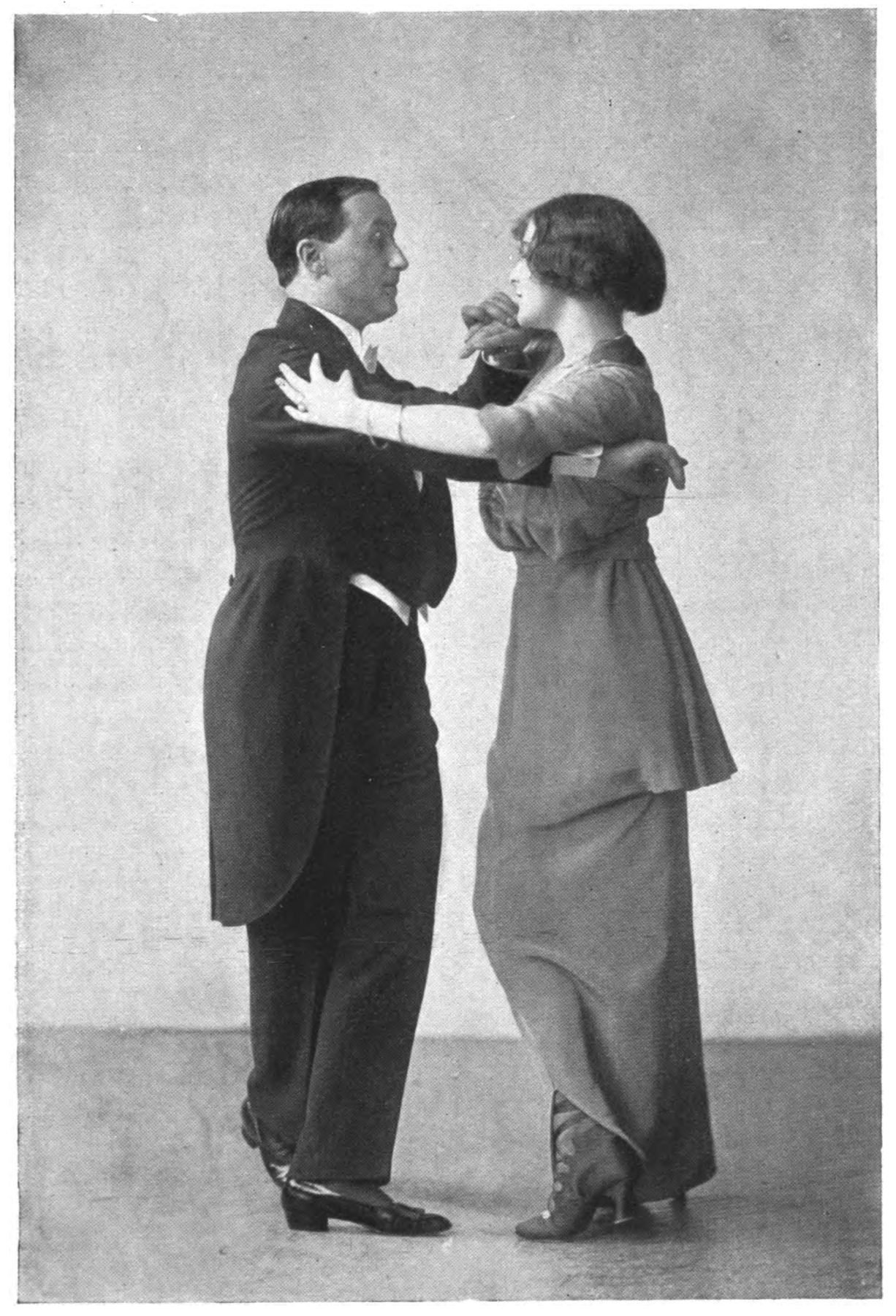
The first variation appears to back the Follow five steps, starting Lead's right, then bring the left foot up beside the right on count 6, and back into a corte on count 7.
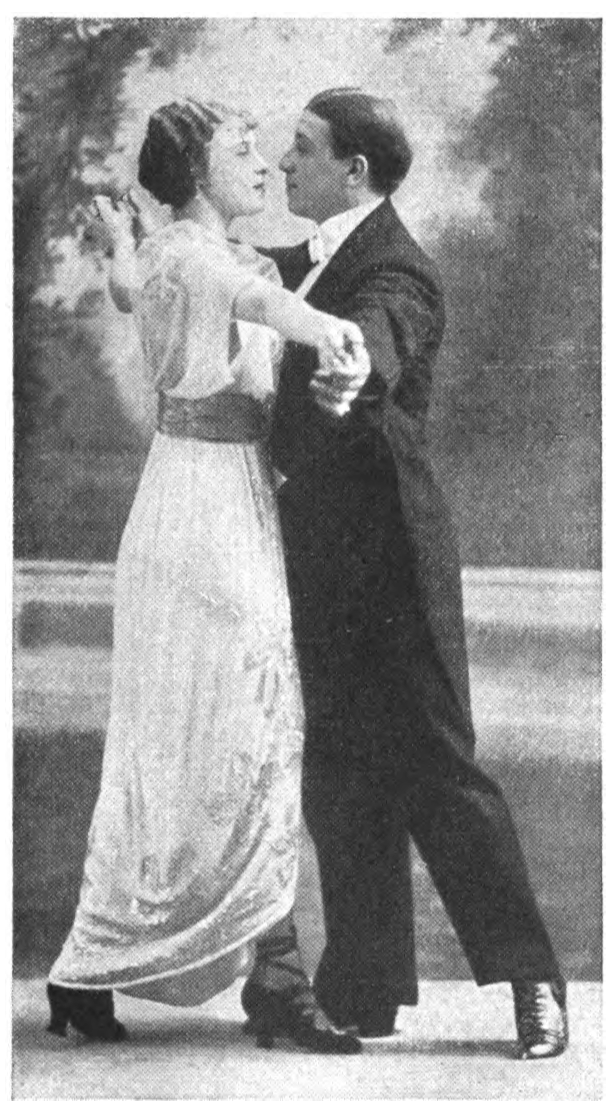
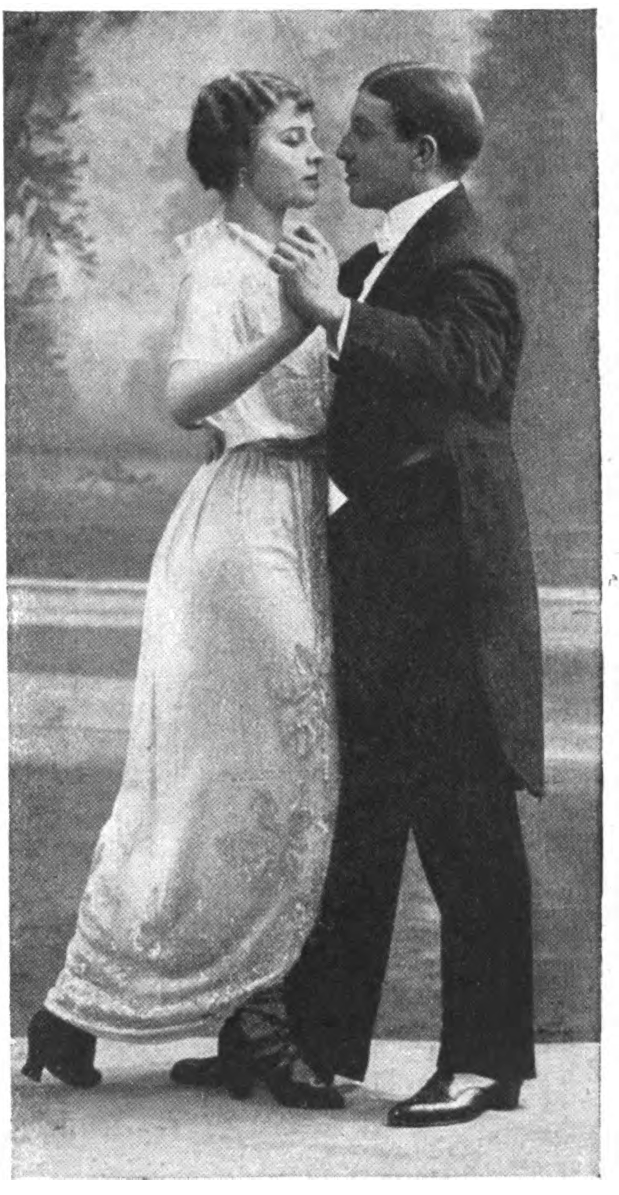
Another version appears to back the Follow four steps, starting Lead's right, then step back right (5), bring the left back past the right (6), and into a corte (7).
Unclear, but it might be a rocking turn, with the Lead's left foot behind, turning 1/4 every repetition.

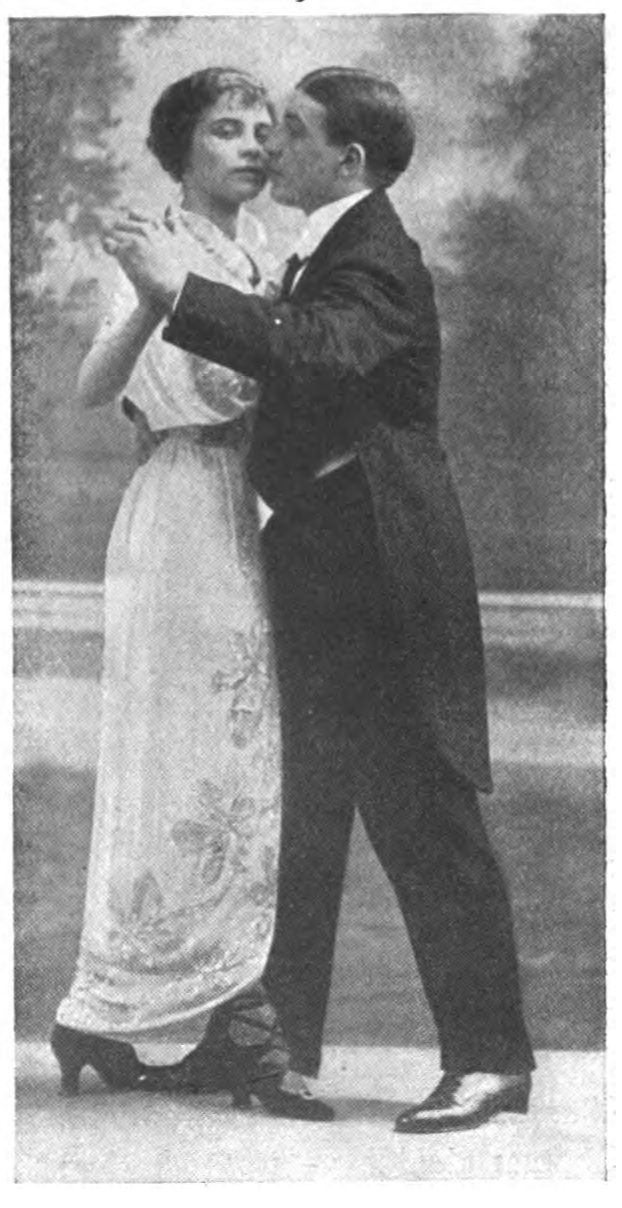
The top illustration isn't clear.
The bottom illustration shows a four-count Scissors with points, starting by crossing the Lead's left over right.
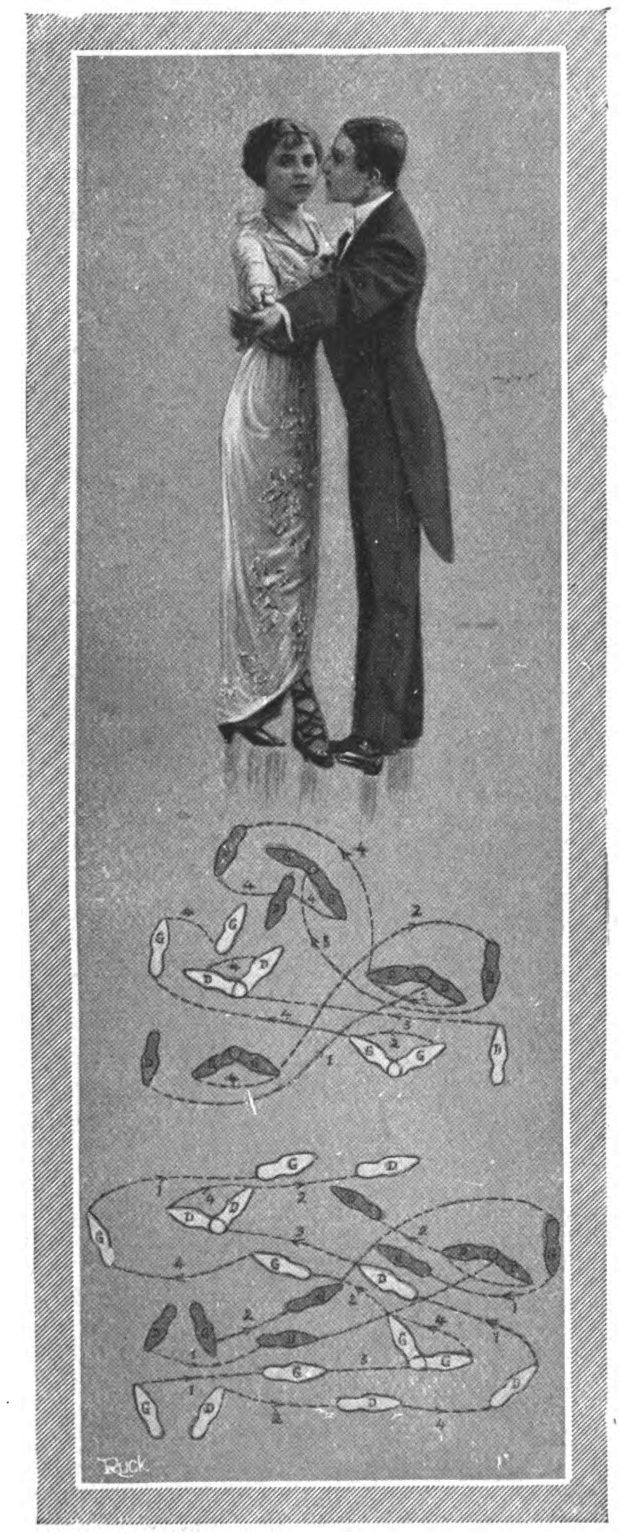
This is the classic Rueda step, with the Lead crossing right over left and pivoting to unwind, as the Follow dances forward around him.
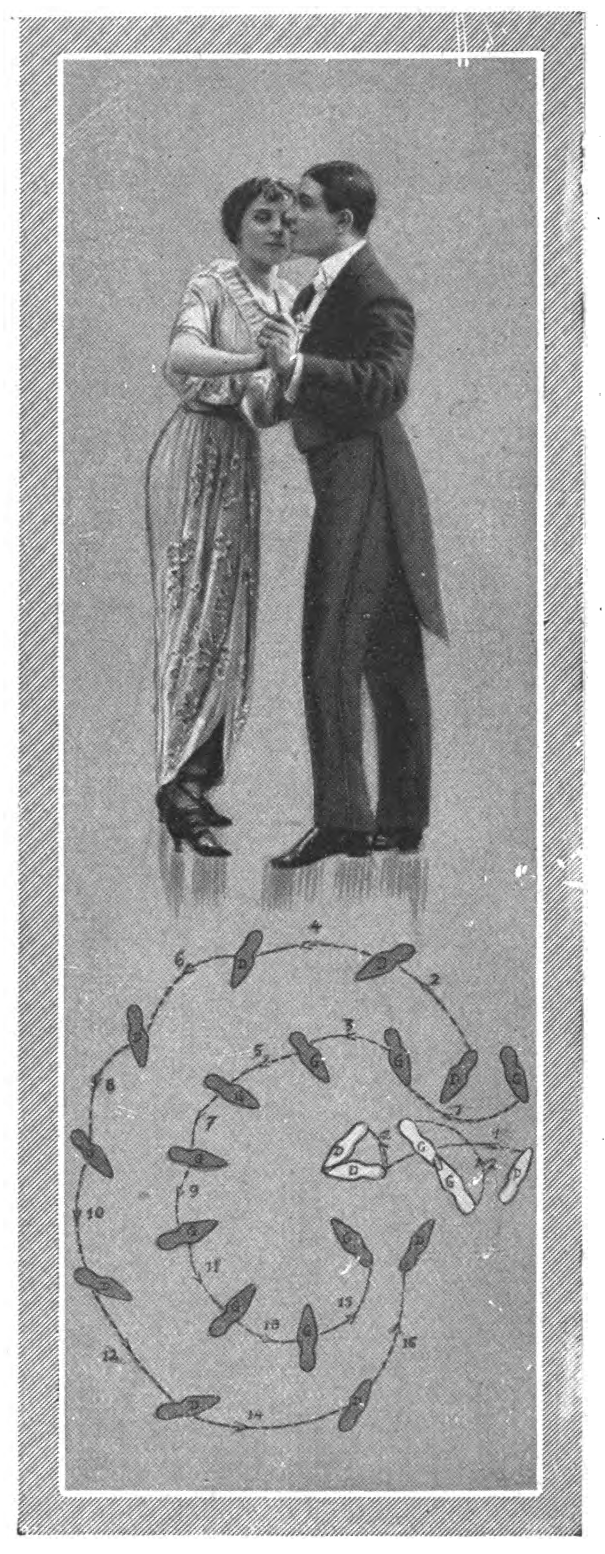
Top of the illustration below.
Promenade three steps over elbows (1, 2, 3), then Lead steps forward left as Follow steps back right (4). Cross inside foot through (5), step side toward the hands (6), then the Lead steps back right as the Follow steps forward left (7). Cross outside foot through (8), step side toward the elbows (9), and the Lead steps forward left as the Follow steps back right (10). Cross inside foot through (11), and close outside foot to inside with an outward sweep (12).

Unclear.

The lead steps forward right (1), brings left up next to right without weight (2), steps back left (3), and closes right back to left without weight (4).
Illustrated in barrel hold.
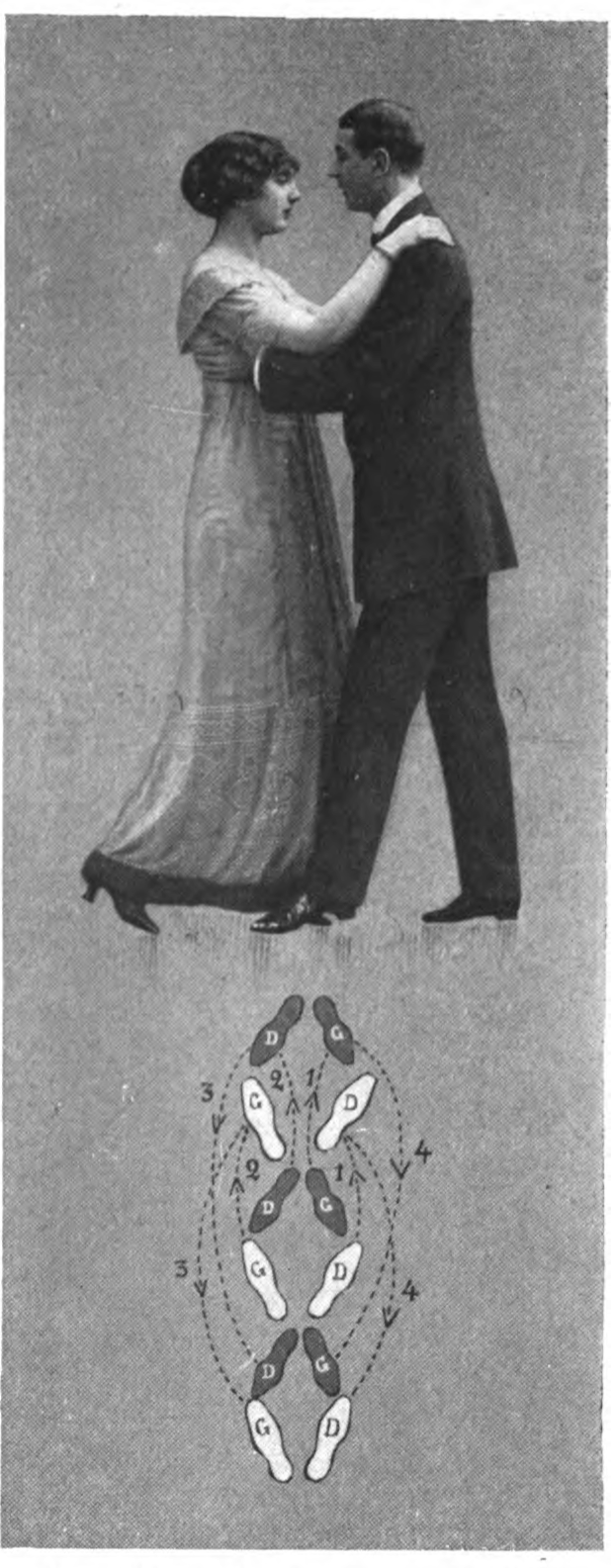
Note: There is no Figure VI.
Unclear.
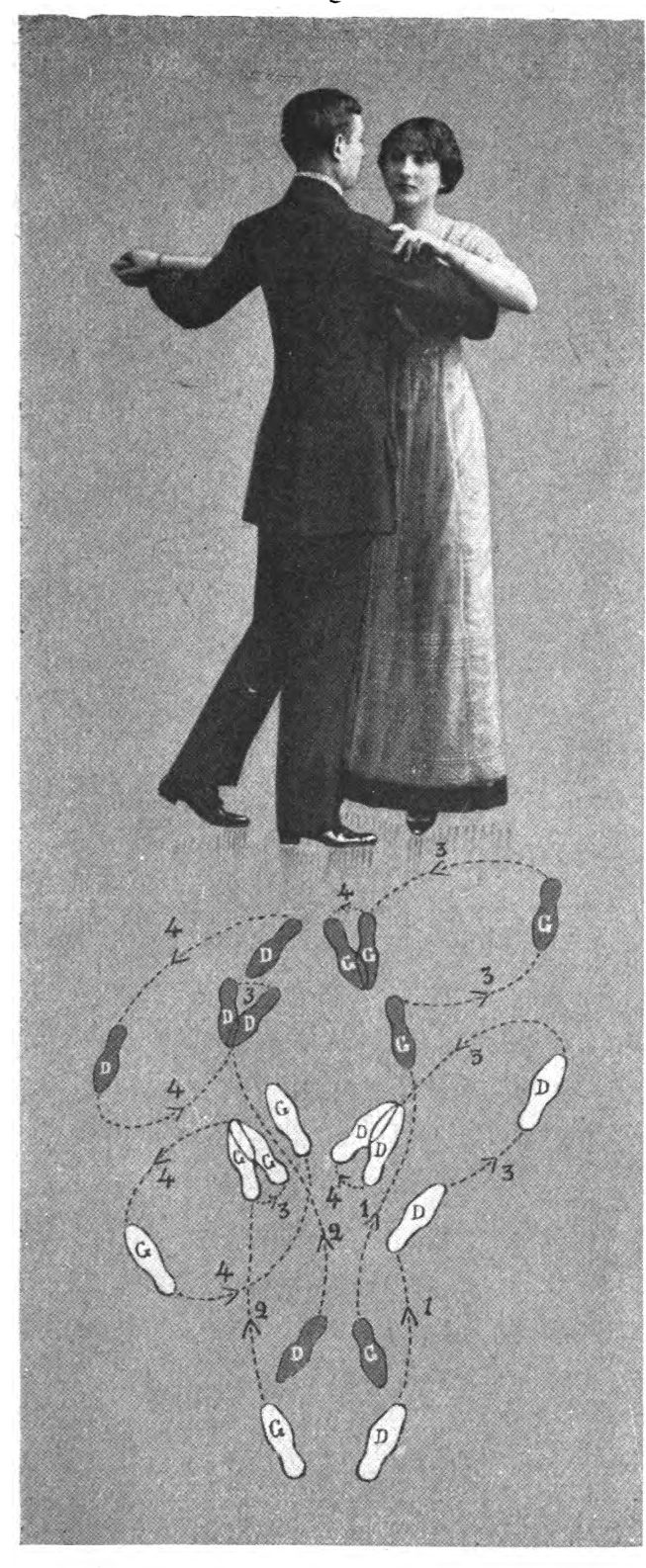
The top illustration below shows a pointed walk forward: back the Follow starting Lead's right on 1, then point the left out and forward on 2, stepping straight forward on it on count 3. Then do the same pointed step onto his right on 4 and 5, then again onto his left on 6 and 7, and onto his right 8 and 1. From here, you can just walk normally.


Neerman notes that each of these figures can be repeated (an average of four times per step), and that they are danced in the order below (or inverted order). The couple always turns to the left.
Forward, side, close, back. Timing unspecified.
A flexed version of El Paseo, starting Lead's right, stretching on the first count, and bending on the second.
Unclear.
Lead's pivoting Rueda with the Follow chasséing around him (it's unclear with kind of chassé).
Promenade three steps to the left on outside feet (1, 2, 3), then stamp closed without weight (and) to repeat to the right (4, 5, 6, and).
Unclear.
The standard Four Count Scissors with Points.
Side left, cross right over, side left, back right. Possibly Figura del Ebrio, but could also simply be a Grapevine.
Not entirely clear, but most likely an Open Ochos.
Back the Follow four steps, starting Lead's right.
Unclear.
Unclear.
The classic Northern rueda with Lead crossing right foot over and the Follow circling him.
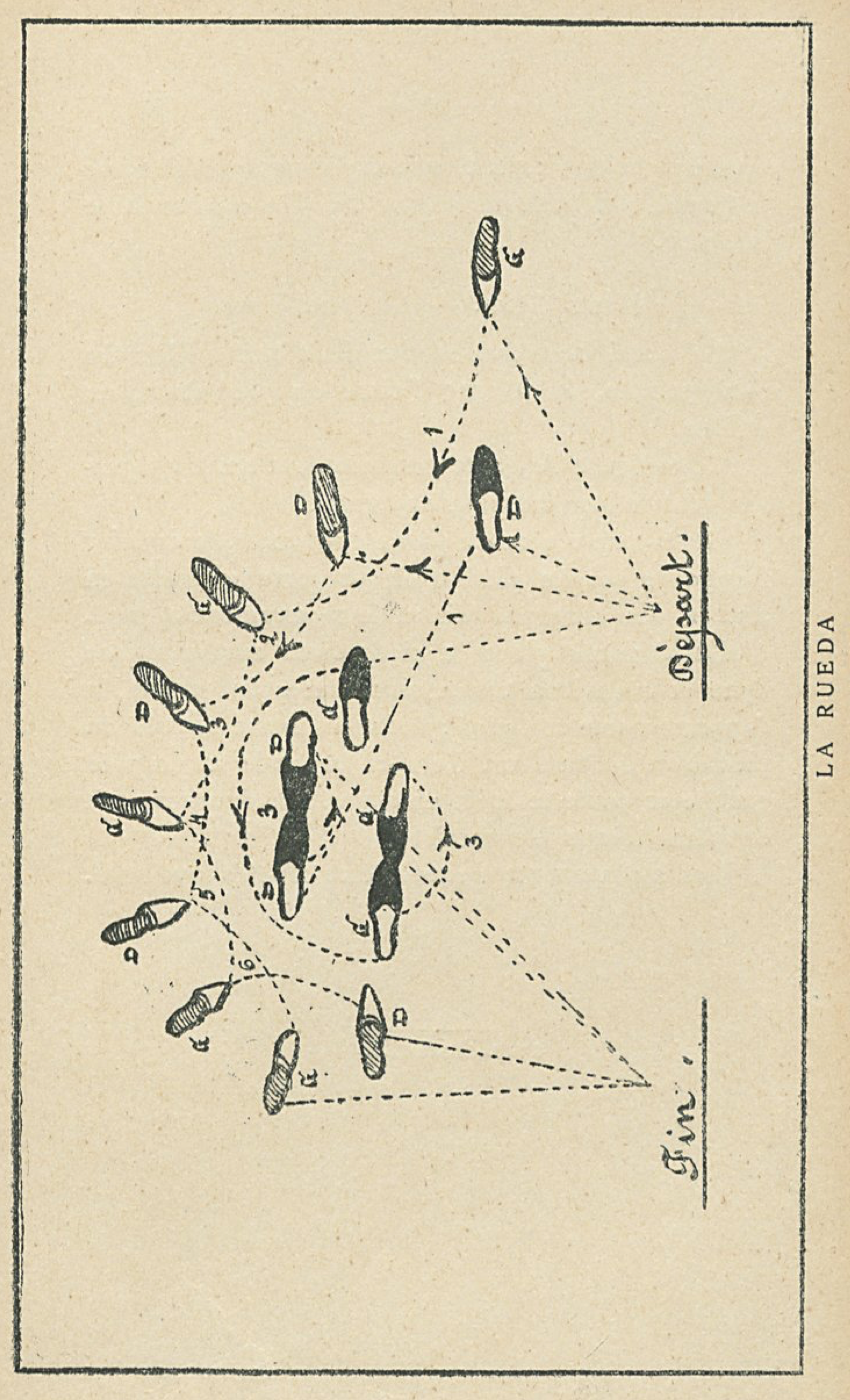
Unclear.

Unclear.
Advancing cross-steps backing the Follow, perhaps changing directions to back the Lead.
Unclear.
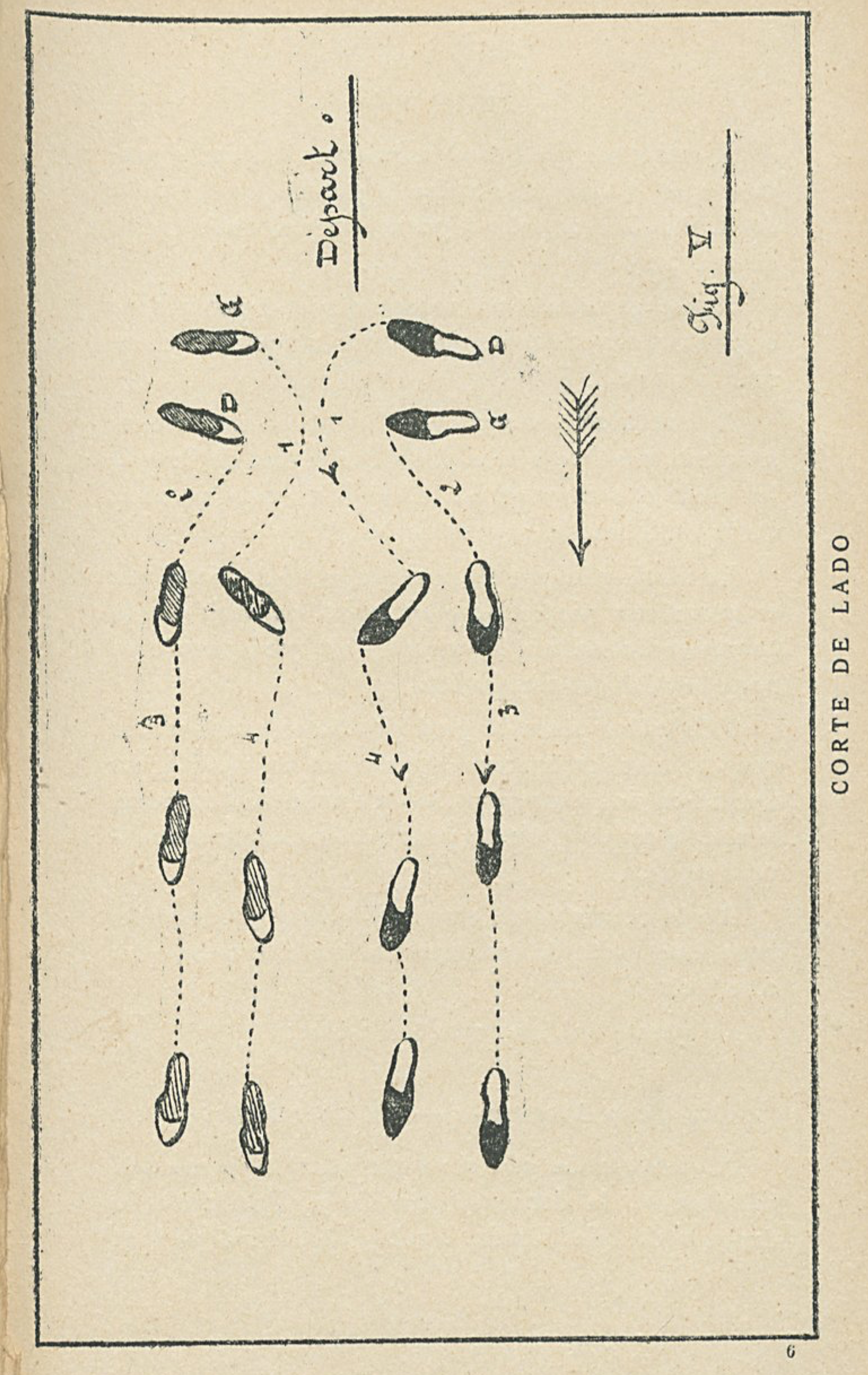
Unclear.

The classic Northern rueda with Lead crossing right foot over and the Follow circling him.

Unclear.
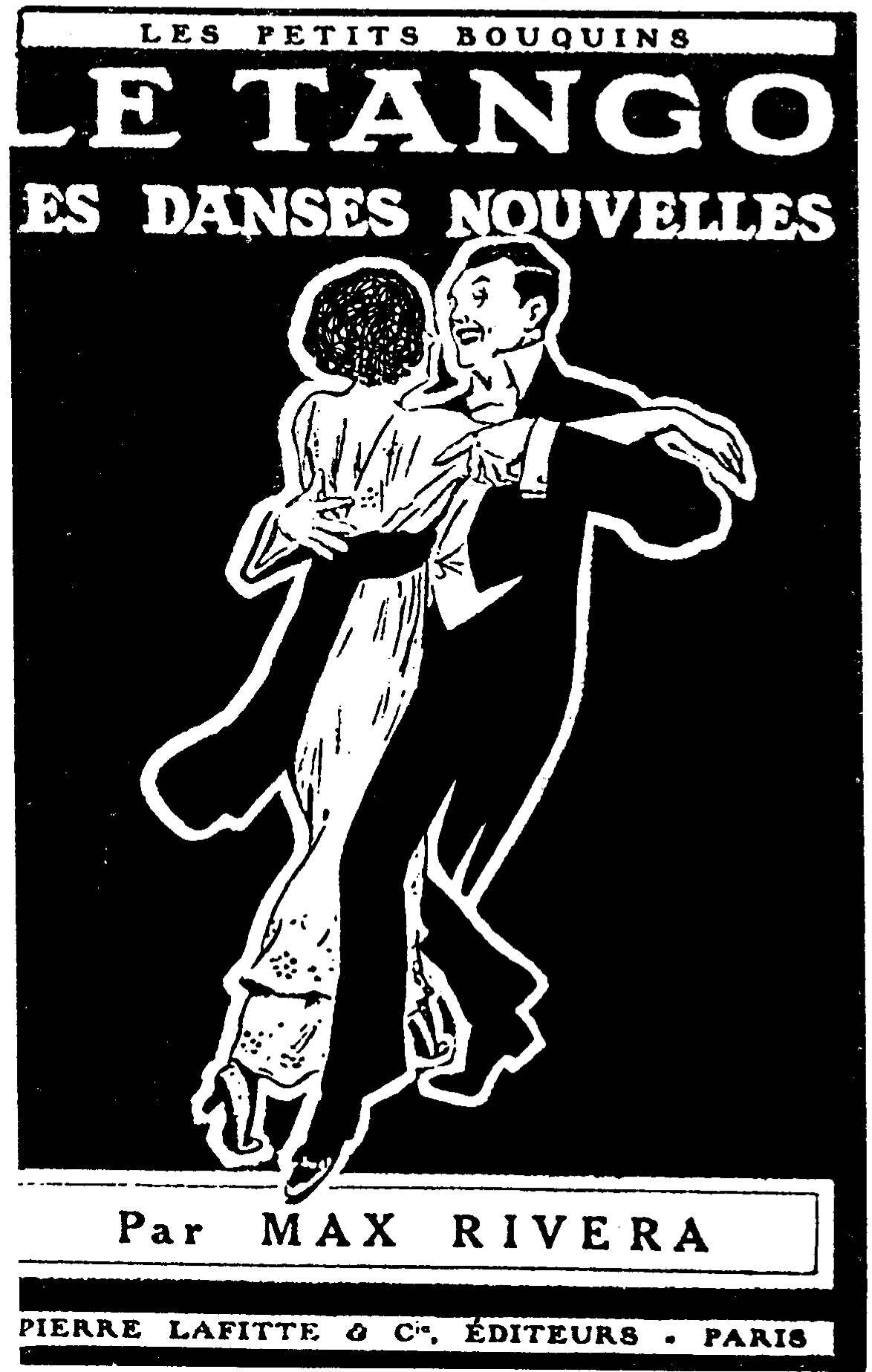
Back the Follow four steps, starting Lead's right, then step forward right, bring left up beside the right, and step back left, with an imperceptible undulation of the whole body.
This figure starts with a four count Scissors crossing left over right, changing directions with a chassé (perhaps like Lima's Closed Ochos). What happens after that isn't clear.
This is the Back and Forward version of Ochos, starting on the left cross, and finishing with a chassé to the left.
Unclear, but involves chassés facing your partner.
Half of a Corte forward, and half of a Corte backward, i.e., forward right, draw left up beside it, then back left, and draw right up beside it.
The Lead crosses right over left and pivots in place to unwind, as the Follow chassés around him, left foot in front.
Unclear, but involves chassés forward and back.
Unclear.
Unclear.
The classic Tango Chassé.
A different version of the Rueda, with a crossed "chassé" (cross left, side right) for the Follow. He joins her on the final chassé to finish.
A waltz, convenient for transitioning between figures. But it is described as a right waltz for the Lead while simultaneously being a left waltz for the Follow (?).
Not entirely clear, but seems similar to Sawyer's Throwaway.
Unclear.
Unclear. Appears to be a four step promenade into a lunge, followed by a barrel roll (?).
Not entirely clear. Open two hands, stepping away from each other. For both, footwork is back, back (corte), forward.
Alternating right and left foot Cortes for the Follow (not entirely clear).
After a heel rap, a four step run into an inside foot lunge, rising immediately.
Unclear.
These variations appeared in the form of a series of short dance descriptions—entitled "Up-to-the-Minute Dances"—that appeared in the New York Globe in late 1913 to early 1914. They were collected and generously provided by Richard Powers.
This isn't entirely clear, but it's most likely "walk, walk, pivot, pivot." One part of the description references a "left pivot movement," but the rest of the description is more consistent with a traditional right pivot. From the Follow's perspective, stepping into the Lead and pivoting past him to the left side could be described as a "left pivot movement."
Back left (1), rock right (2), rock left (and), step back left (3), and hold, posing the right foot in front (4). (Note: The description has the Lead posing the right foot back, and the illustration has it in front. The latter makes more sense.)
It is noted that the held hands are point horizontally out to the side from the shoulder, and that there should be no movement above the hips in any Tango step.
The Cortez or Five (Sawyer, "Up-to-the-Minute Dances," New York Globe, November 24, 1913):
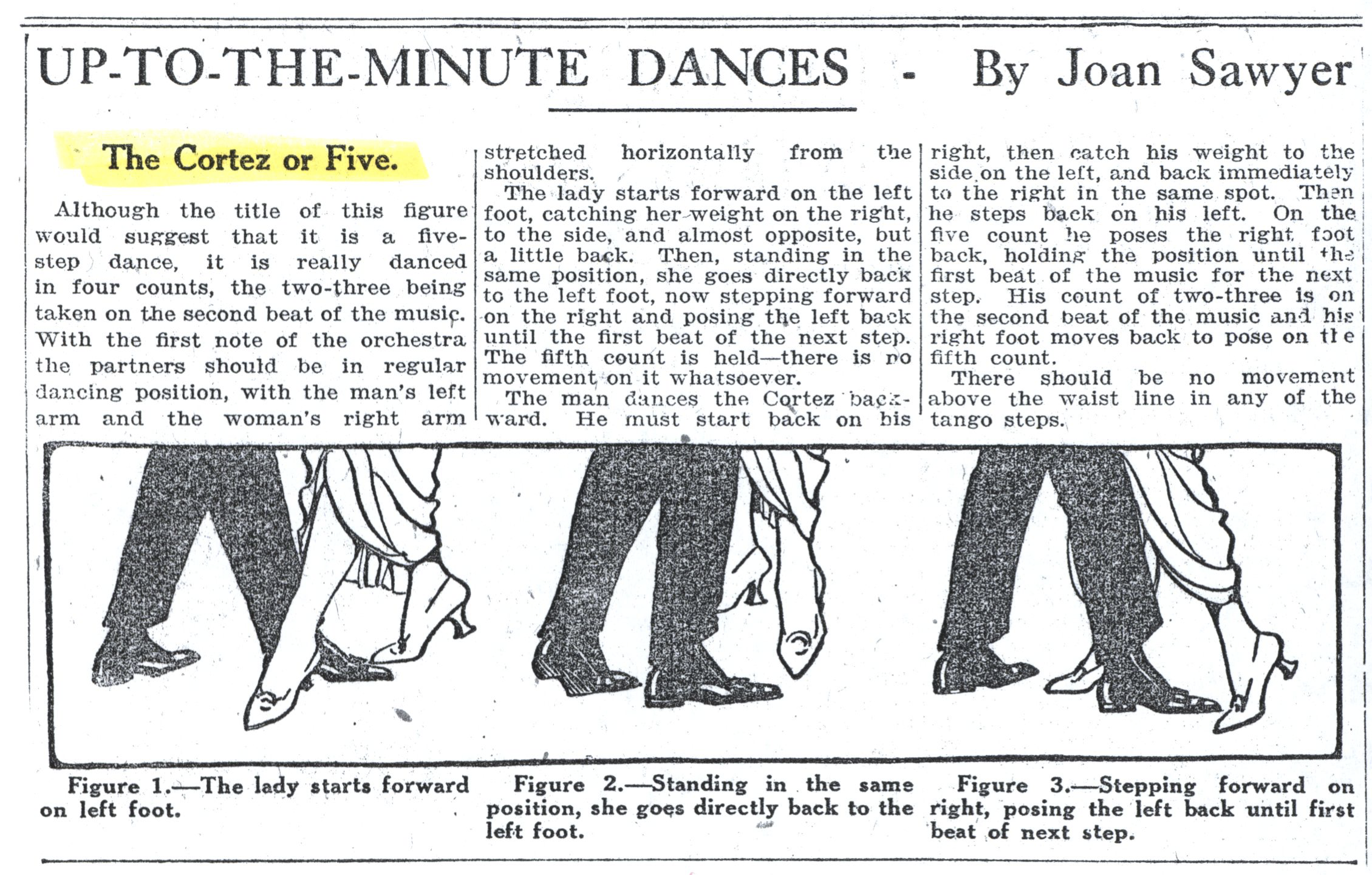
Cortez of the Tango (Sawyer, "Up-to-the-Minute Dances," New York Globe, February 3, 1914):
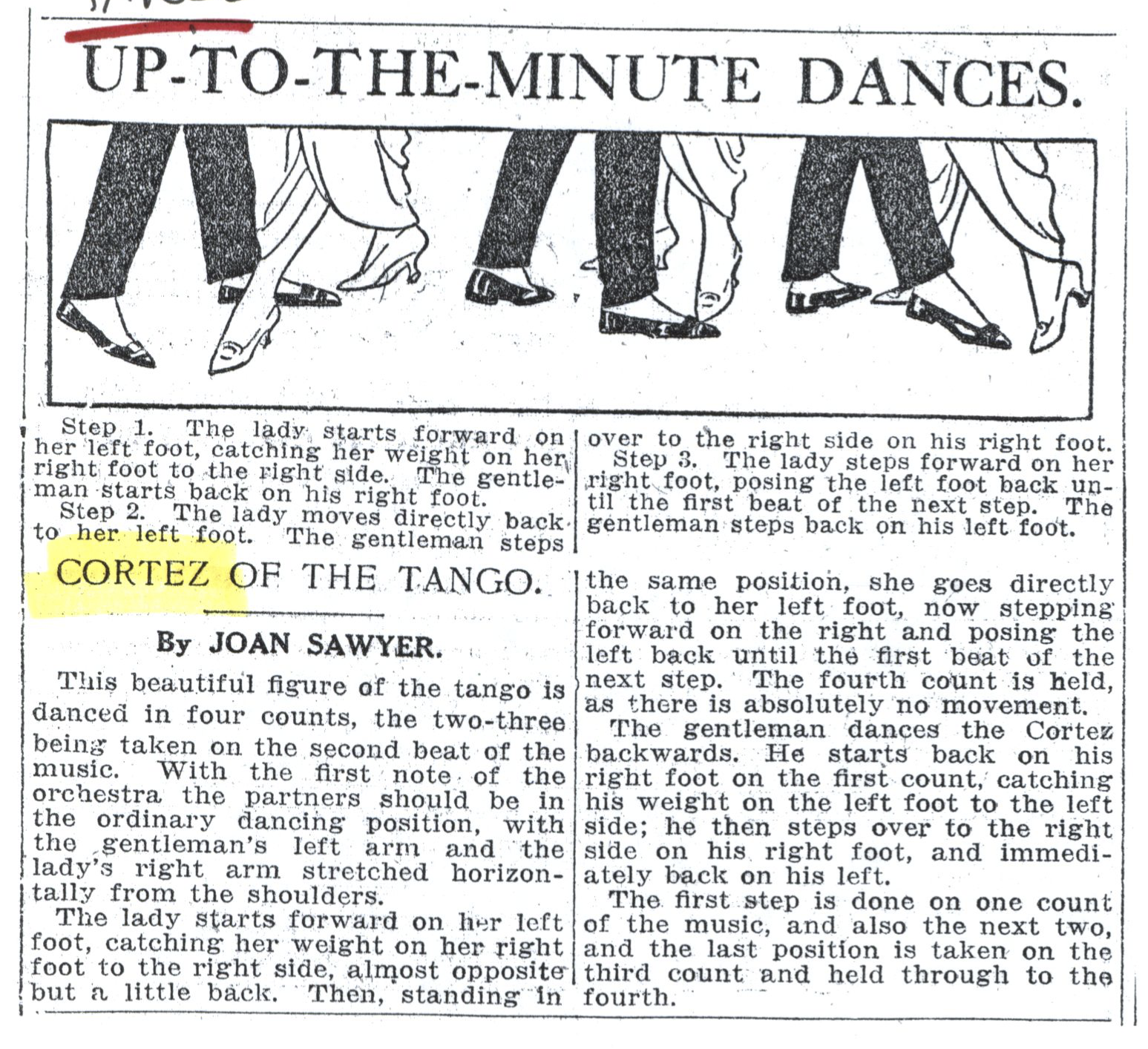
Back the Lead with slow steps starting on his right.
Promenade three steps over and three steps back, extending the arms straight behind on the second half. This is essentially equivalent to an Open Ocho in SSS timing.
To get back on the music, she suggests that you can simply pause for a few counts.
This is like a Tango Chassé, but facing forward the whole time: promenade two steps (1, 2), then rock forward and back (3, and).
Repeat five or six times, then finish with three complete steps (ending with weight on outside feet).
The Lead steps back left (1), back right (2), forward left (and), then forward right (3), forward left (4), and back right (and).
Anachronistically, this is like a Salsa basic that starts on the third step (if you break on 1).
There are two interesting notes at the end of this description:
First, Sawyer notes that "it should be remembered that at the end of each figure it is always possible to hold back for two beats in order to make progression into the next change easy and graceful."
Second, she notes that "the lady should never undertake to lead the man unless he requests her to do so. But a lady who dances well may always make the beginnings less difficult for her partner if he will let her lead and do his best to follow."
The Major Luna (Sawyer, "Up-to-the-Minute Dances," New York Globe, November 28, 1913):
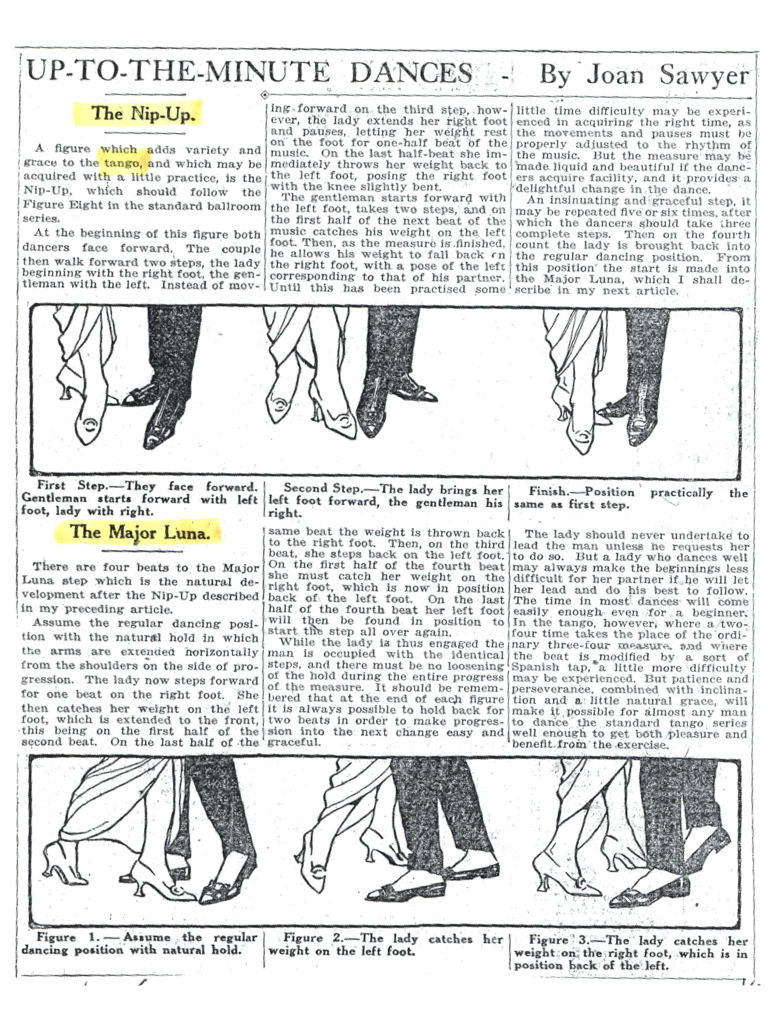
The Luna of the Tango (Sawyer, "Up-to-the-Minute Dances," New York Globe, February 4, 1914):
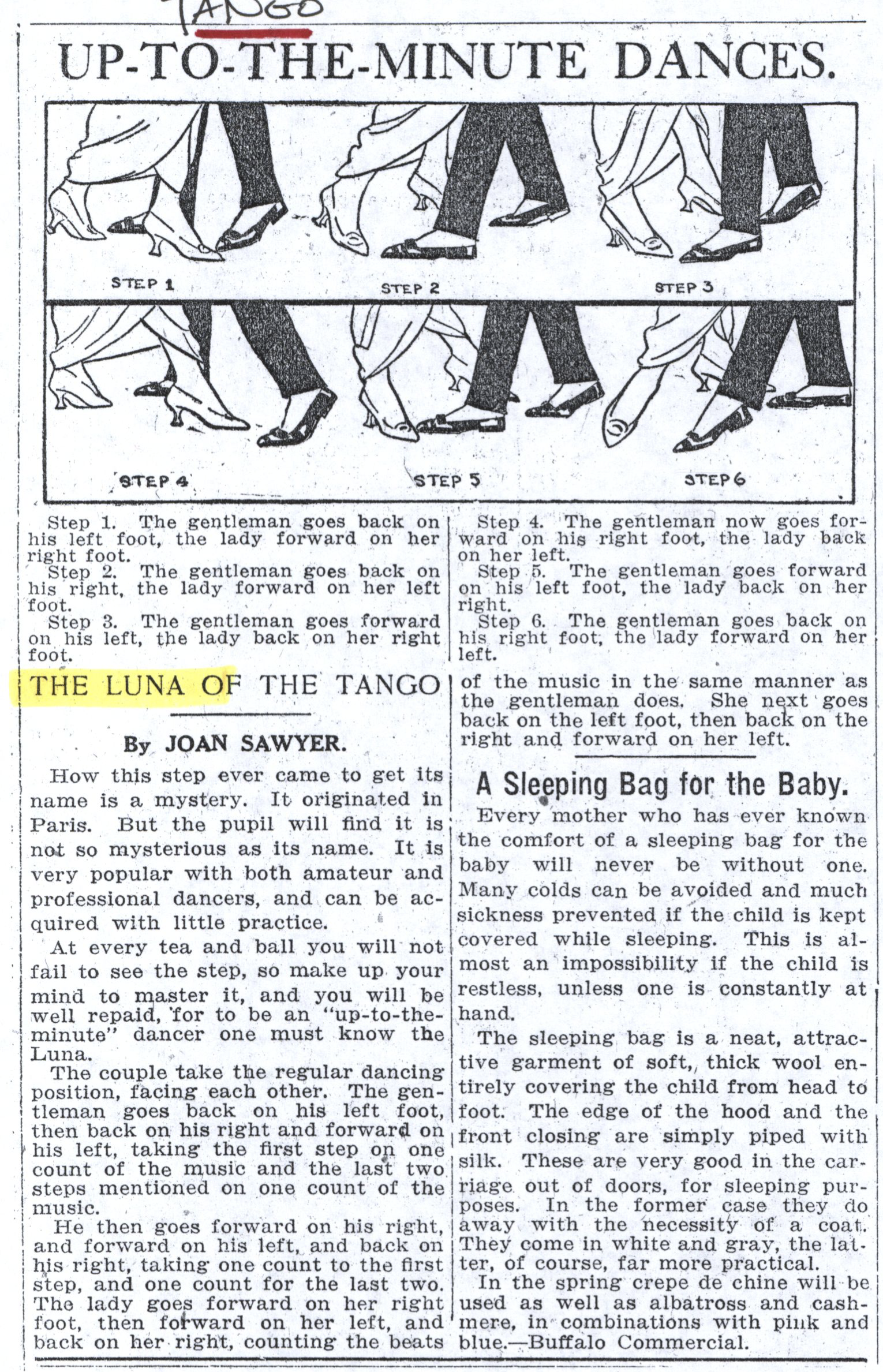
Simply promenade four steps, both facing forward, starting outside feet.
This description is followed by a brief essay on the mental and physical benefits of dancing.
The Slow Walk Forward (Sawyer, "Up-to-the-Minute Dances," New York Globe, November 29, 1913):
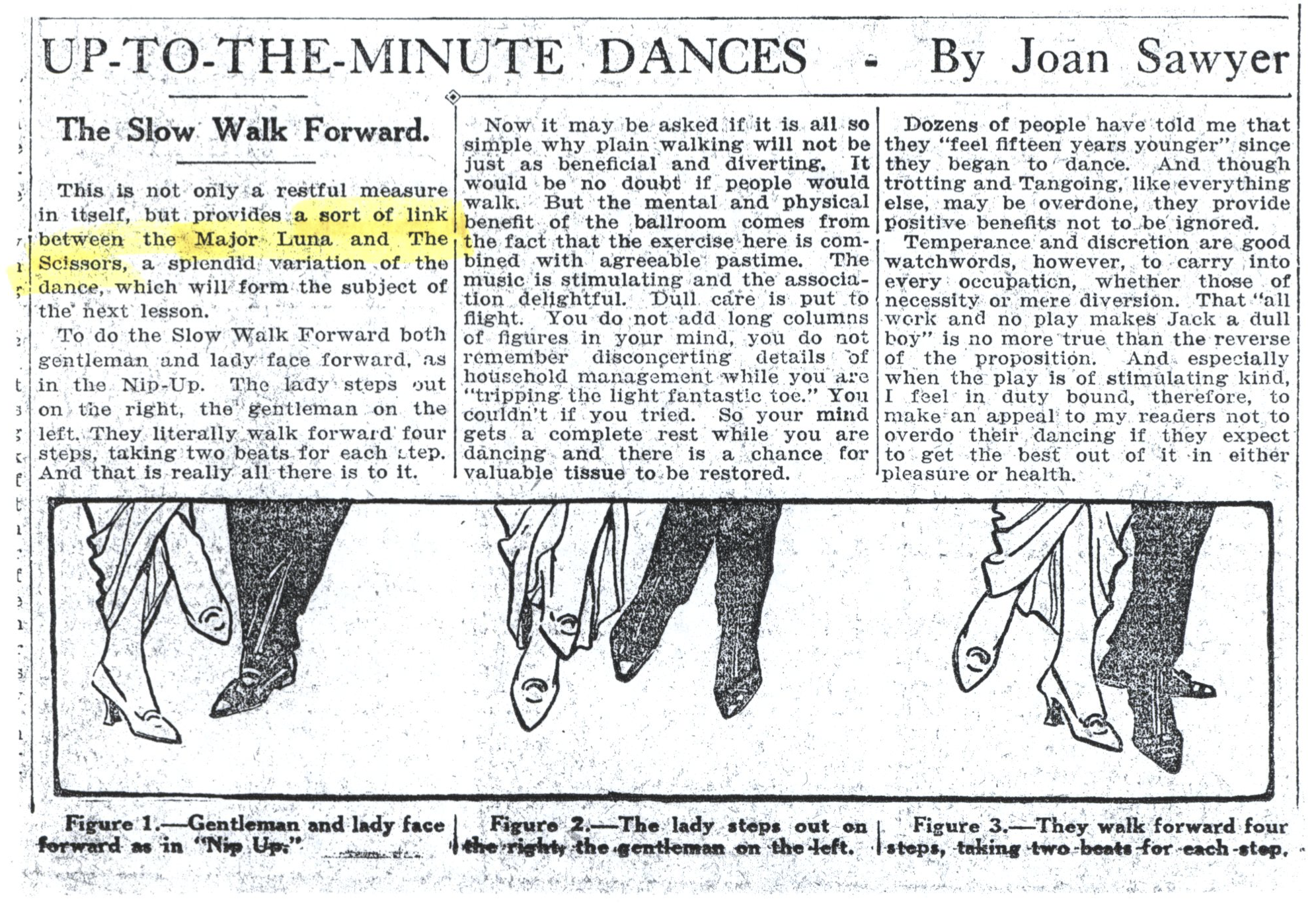
The Slow Walk (Sawyer, "Up-to-the-Minute Dances," New York Globe, February 2, 1914):
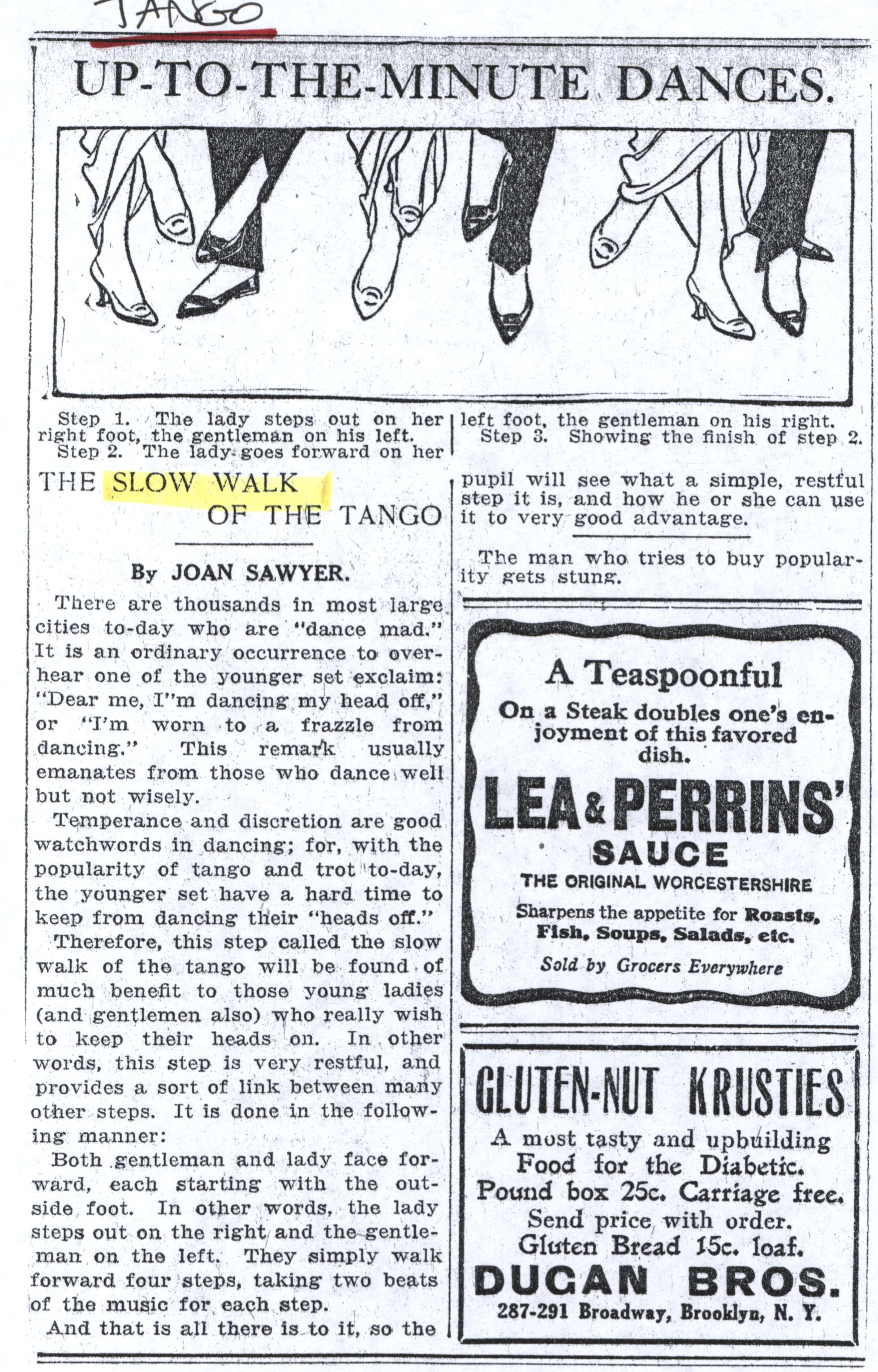
The Follow does half of an Open Ocho (cross, side, replace), then half of a Sweeps Ocho (cross, swee, eep).
The Lead steps forward right (1), crosses left over right (2), side (and), then steps forward left (3), and swings forward right (4).
The Feather Stitch (Sawyer, "Up-to-the-Minute Dances," New York Globe, December 13, 1913):
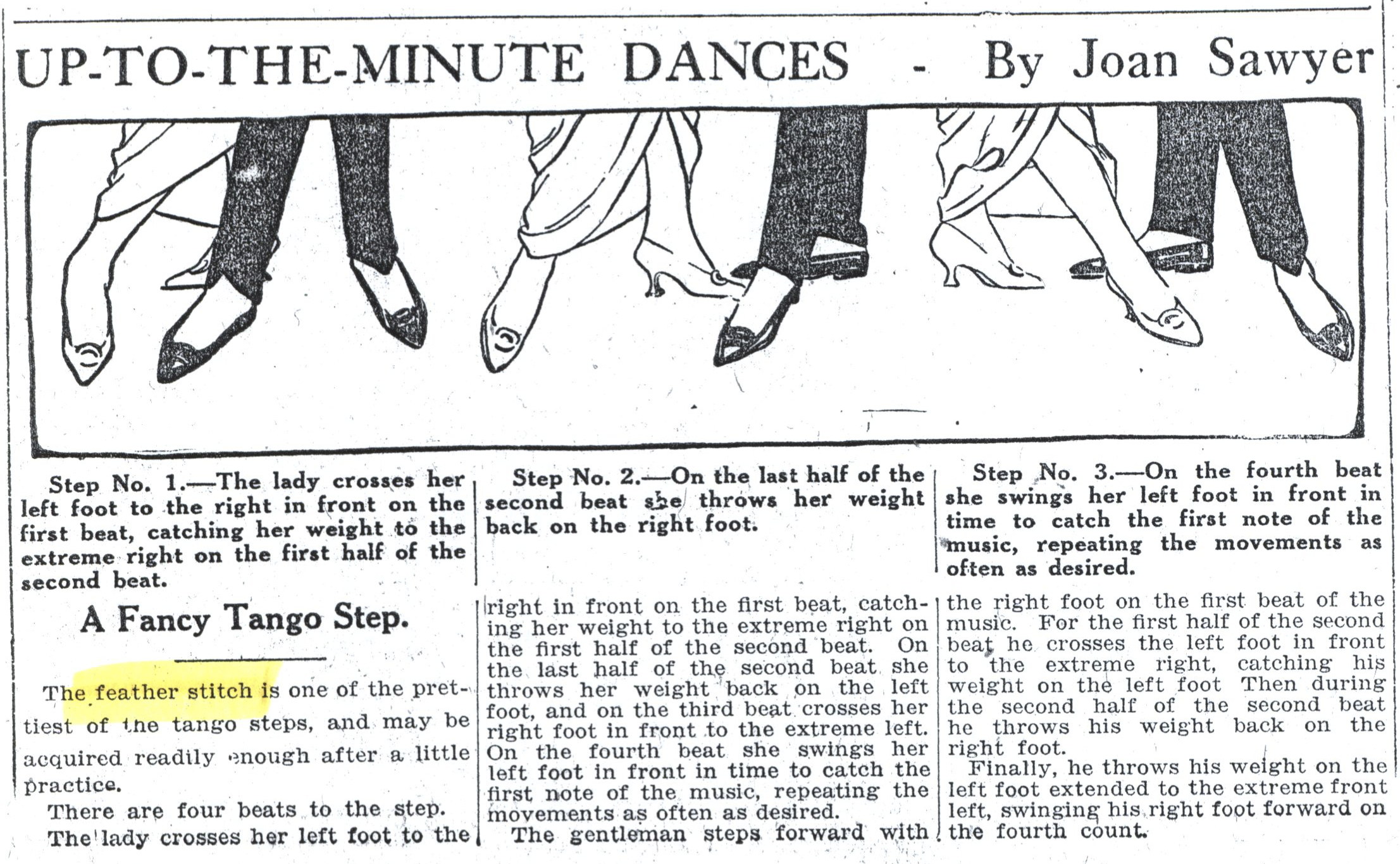
Feather Step of Tango (Sawyer, "Up-to-the-Minute Dances," New York Globe, February 6, 1914):
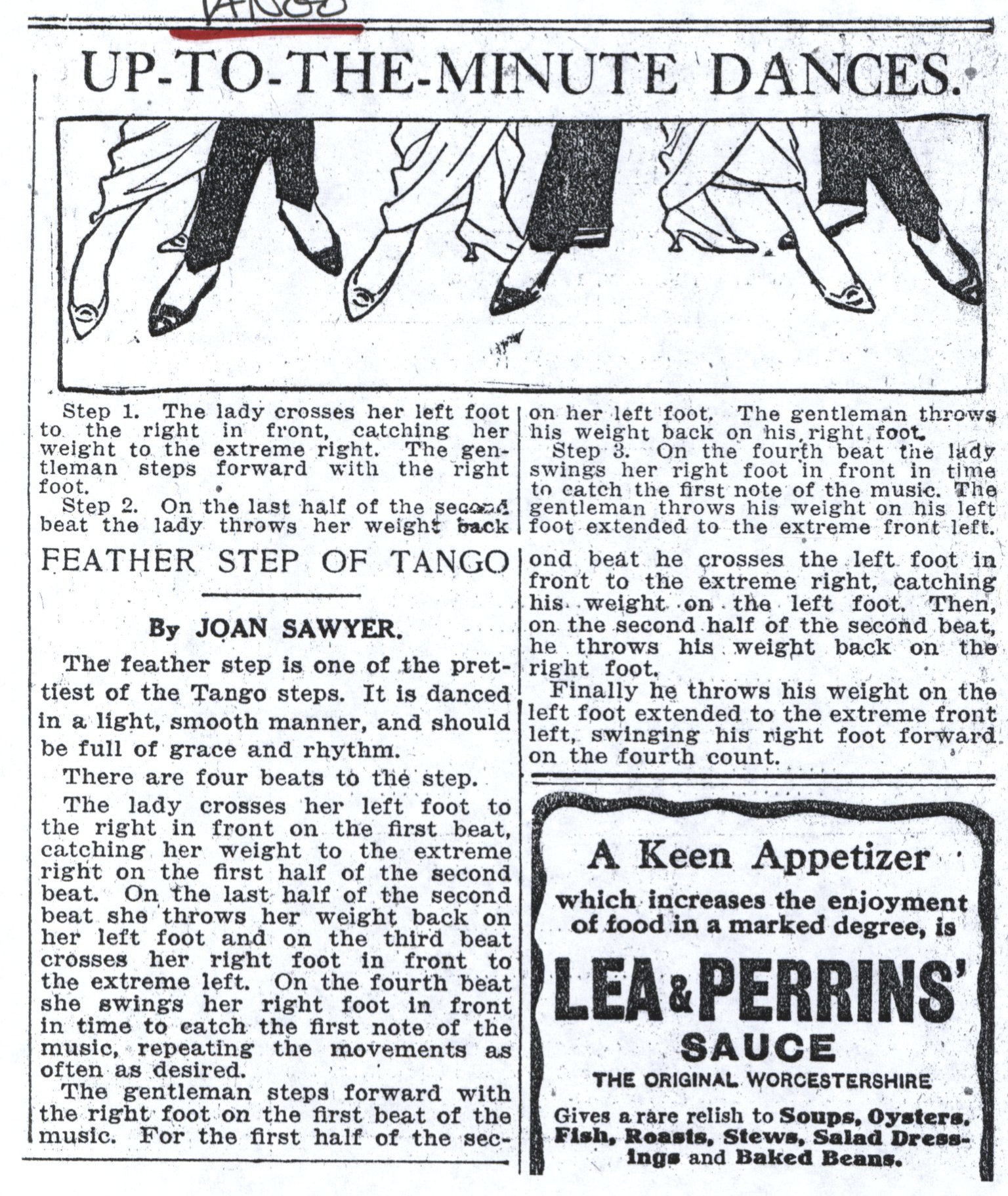
This is a description by Sawyer of the proper style of dipping, sinking to the floor while upright, rather than bending forward.
The illustration shows a lunge, and the description suggests that dips can be inserted into a grapevine at regular intervals.
This was described as a Waltz variation, but can also be applied to Tango, being a combination of of Sawyer's other Tango steps.
He dances the Major Luna, while she dances half Major Luna and half Open Ocho by his side.
Promenade two steps on outside feet (1, 2), then pivot on the second step into counter promenade position (3), and cross the outside foot over (4). Repeat opposite, ending with the inside feet crossed over.
From here, the Lead pivots in place as the Follow circles him, stepping forward right with a stamp and closing left to right, for eight counts.
Then do this Rueda step clockwise, and repeat the Scissors.
This is a repeated side close over the elbows, starting Lead's right and Follow's left, stamping every odd side step.
This is a combination of the Nip Up and Major Luna (actually the Major Scissors).
Promenade two steps, then dance the Major Scissors, with the minor change that the Lead stops and holds back left, and rejoins the Follow on her second cross. Then repeat these six counts.
This is used, along with the Cortez, to link certain steps in the Tango. In particular, it is used after a step finishes with your weight on your outside foot, and you want to step again with your outside foot.
Promenade one step on inside feet (1), then rock the Follow back away from the Lead (at a right angle to his right side) and forward again (2, and), as the Lead steps in place. Then the Follow swings her right foot around into the final step of a Cortez back on the Lead's left (3).
An astute reader might note that this doesn't solve the problem it sets out to solve—you're still on your outside foot. But, if you're clever about it, this step can be used to change the timing. If, instead of holding the Corte pose, you rock forward out of it immediately (on count 4), you will have your outside foot free for count 1. Sawyer doesn't go so far as to describe it this way (she simply ends with the Cortez), but this is one way to achieve her stated goal.
This is described as the Plain Scissors, but with the Lead crossing behind, the Follow in front. Sawyer's Plain Scissors is a two-count Side Step Scissors.
This is a two-count Side Step Scissors: side, cross, cross, side, always crossing in front.
This is a combination dance that shifts from One Step to Waltz to Tango and back to One Step.
Three in One (Sawyer, "A New Dance for You: Three in One Fully Described," Omaha Bee, March 21, 1914):
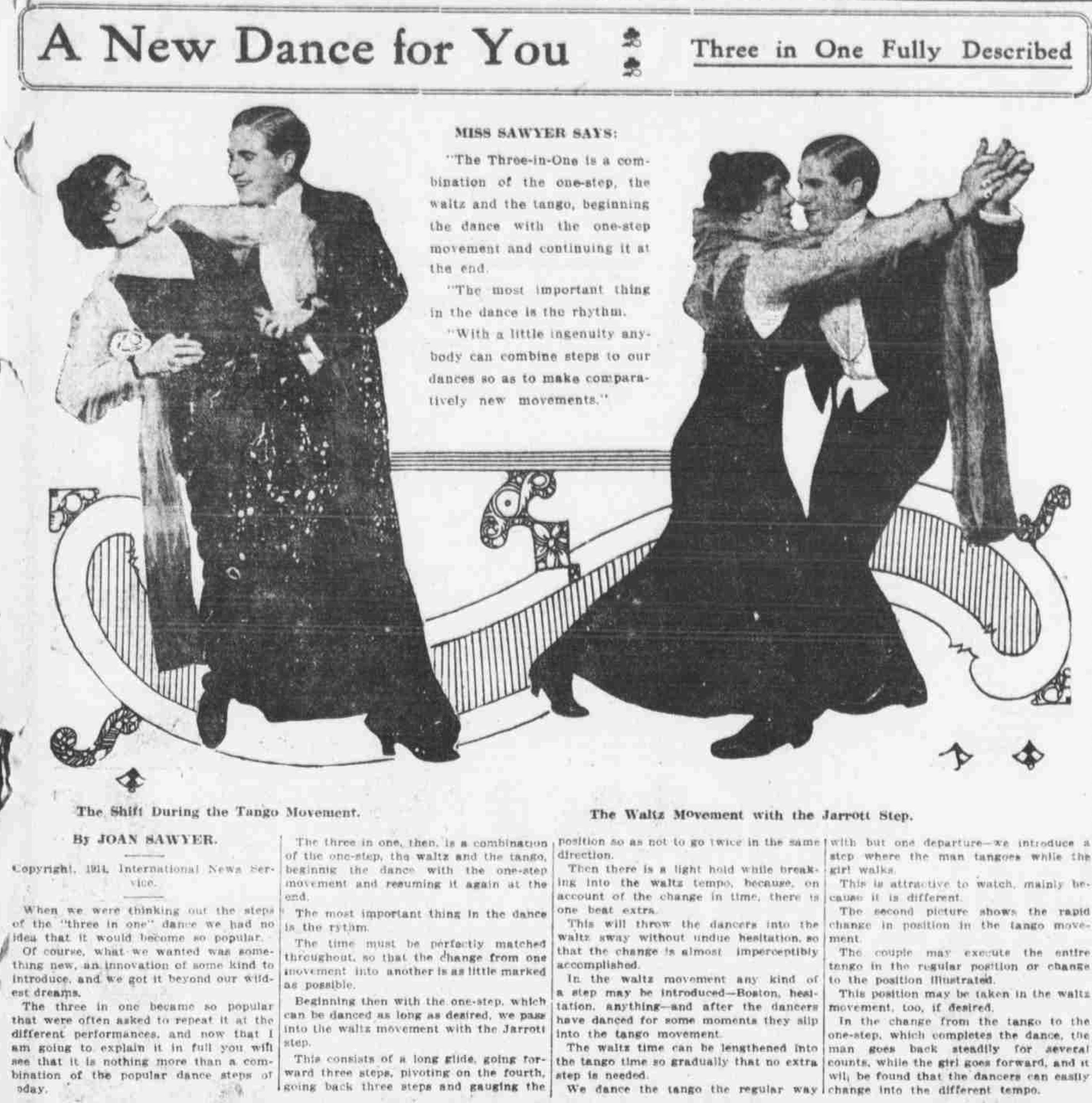
Back the Follow four steps, starting Lead's left.
Then bring the left up to the right, and then back, bending the right knee.
Unclear.
Not entirely clear. Stretch foot to the side, then close up, and waltz to the right. Then the same, but waltzing to the left.
A slow waltz, the hips moving in rhythm.
Unclear, but appears similar to Crozier's Swing Figure, with the Lead turning to the left as the Follow turns to the right.
Ochos (with Swivel styling) together, then the Lead stops to show off the Follow, who dances the cross-steps solo.
Unclear, but something along the lines of Back Ochos, with one partner crossing in front as the other crosses behind.
At the slow places in the rhythm, bend the knees deeply, then rise up again.
Not entirely clear, but suggests a Texas Tommy/Apache arm movement, the Lead taking the Follow's right hand in his right behind her back, and unwinding her.
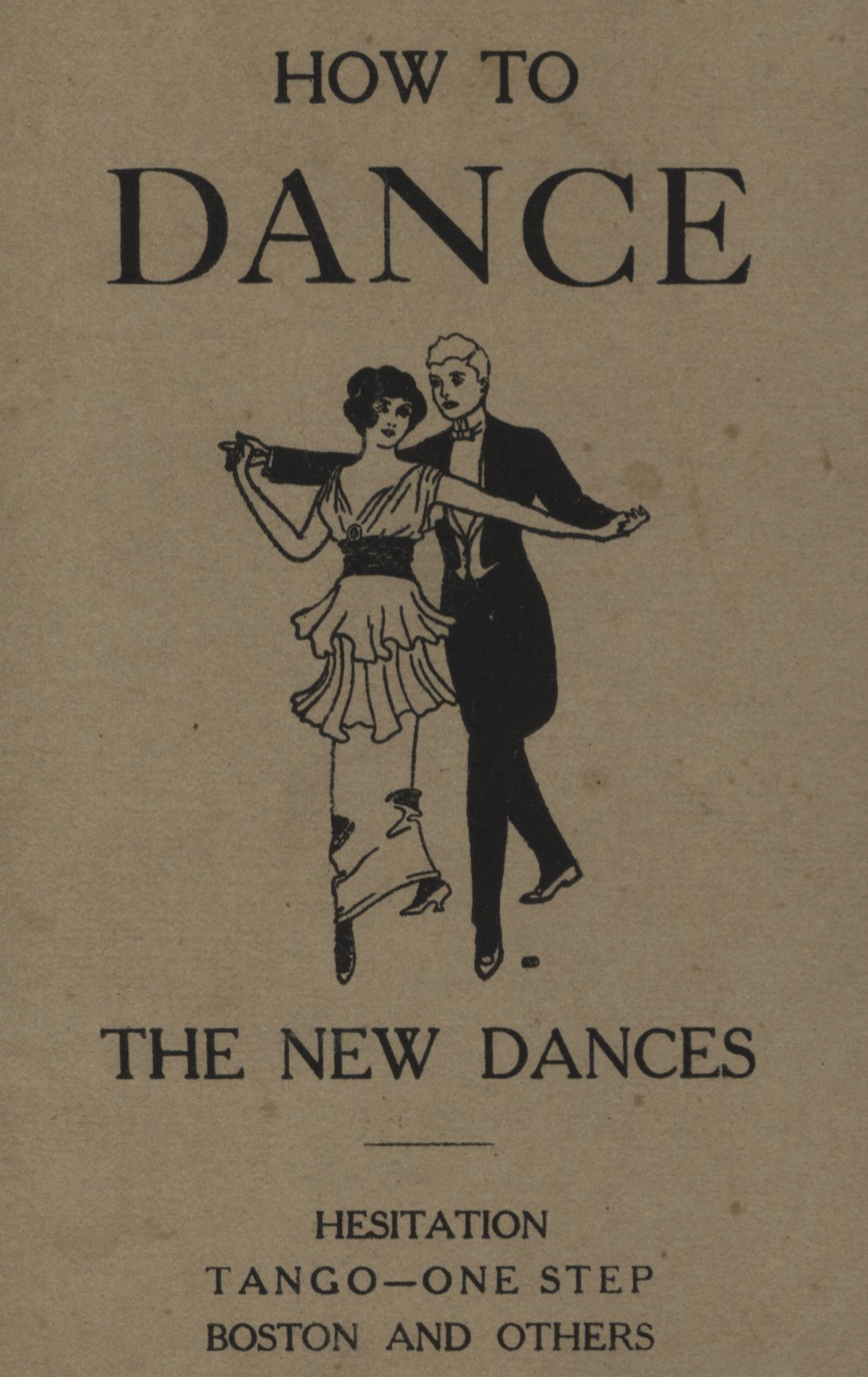
Bell writes, "The Tango, as danced in New York, is a variation of the Argentine Tango. The latter is too complicated for popular usage. The One-step and the Tango known to the general public are practically twins." Therefore, his variations, like those of Johnson and Walker, can be considered more One-Step than Tango, although the four described below are also consistent with Tango.
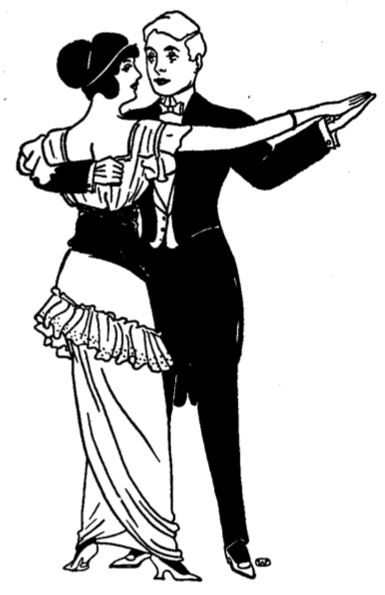
Back the Follow four steps, starting Lead's left, then back the Lead four steps.
Turn the body around in closed position, stepping naturally.
Lead crosses right behind (1), steps side left (2), crosses right in front (3), steps side left (4). Repeat (5, 6, 7, 8). The Follow dances opposite.
Lead steps side left (1), and draws right foot to it (2), pointing right toe to the floor, dipping slightly over to the right side. Repeat (3, 4). The Follow dances opposite.
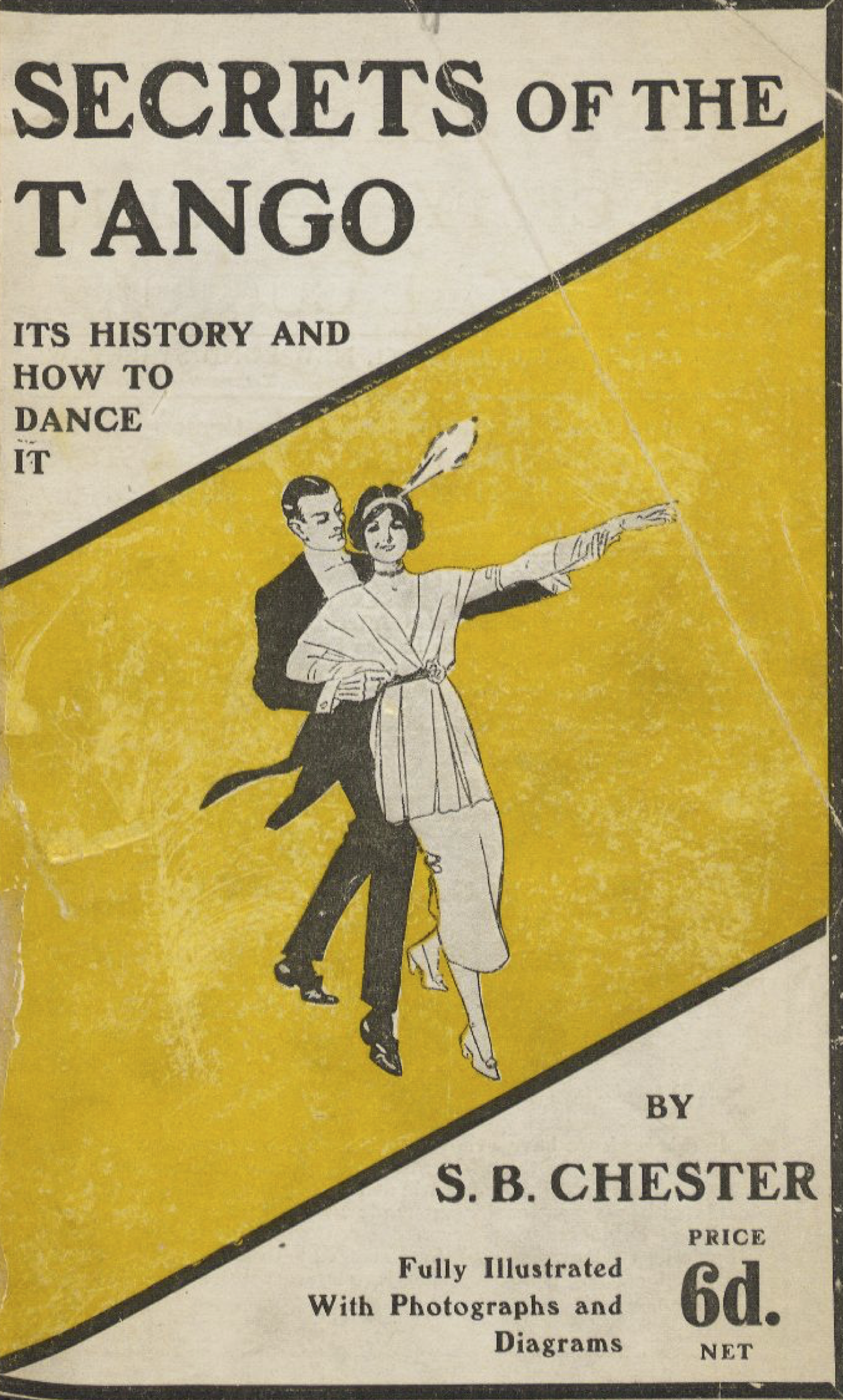
In Dance Mad (1914), F. Leslie Clendenen provides additional descriptions credited to Barrasa, which in some cases shed greater light on his variations, so we have included those descriptions in this section as well.
Back the Follow five steps, starting Lead's right, with a heel lead.
Then the rest of the description is unclear.
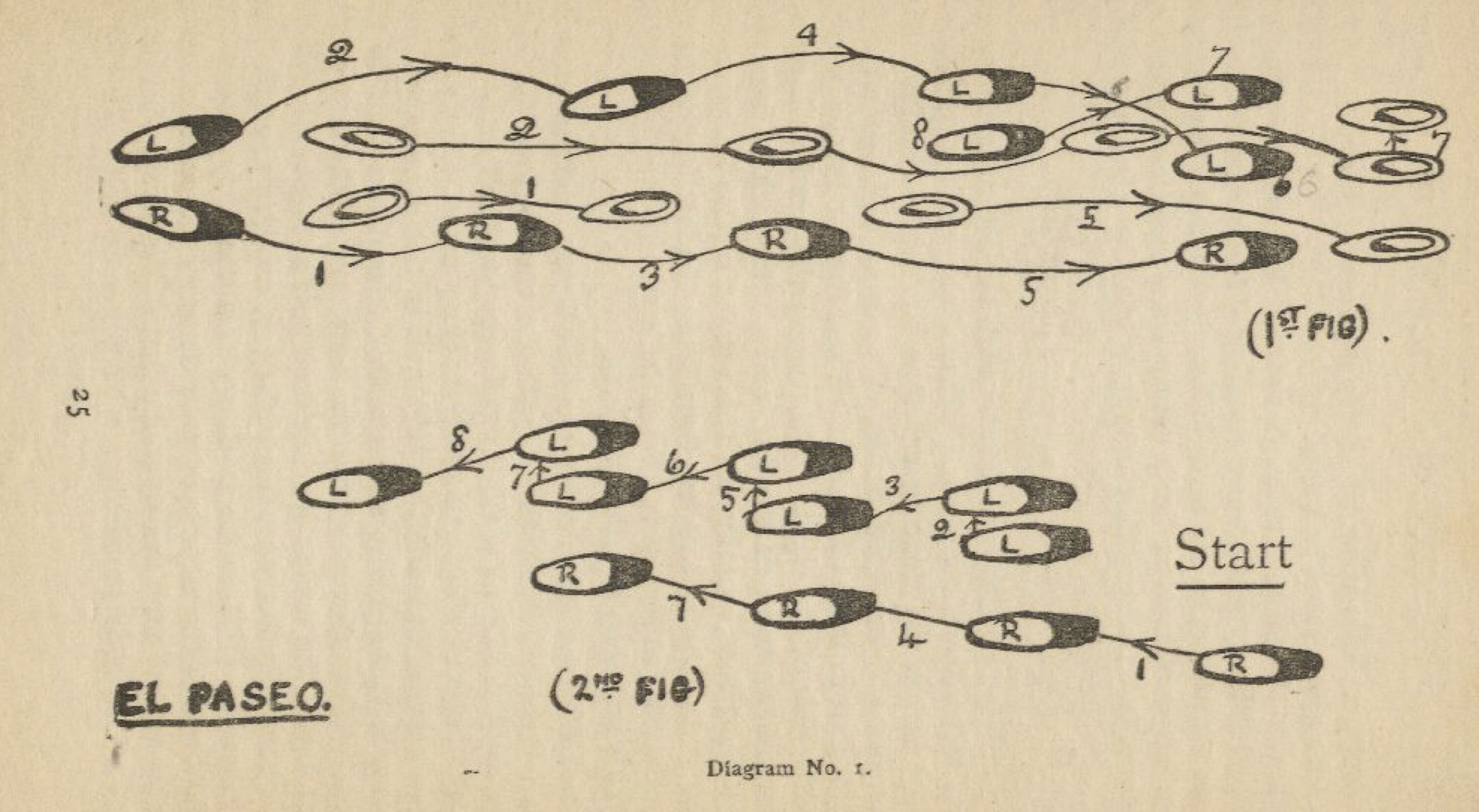
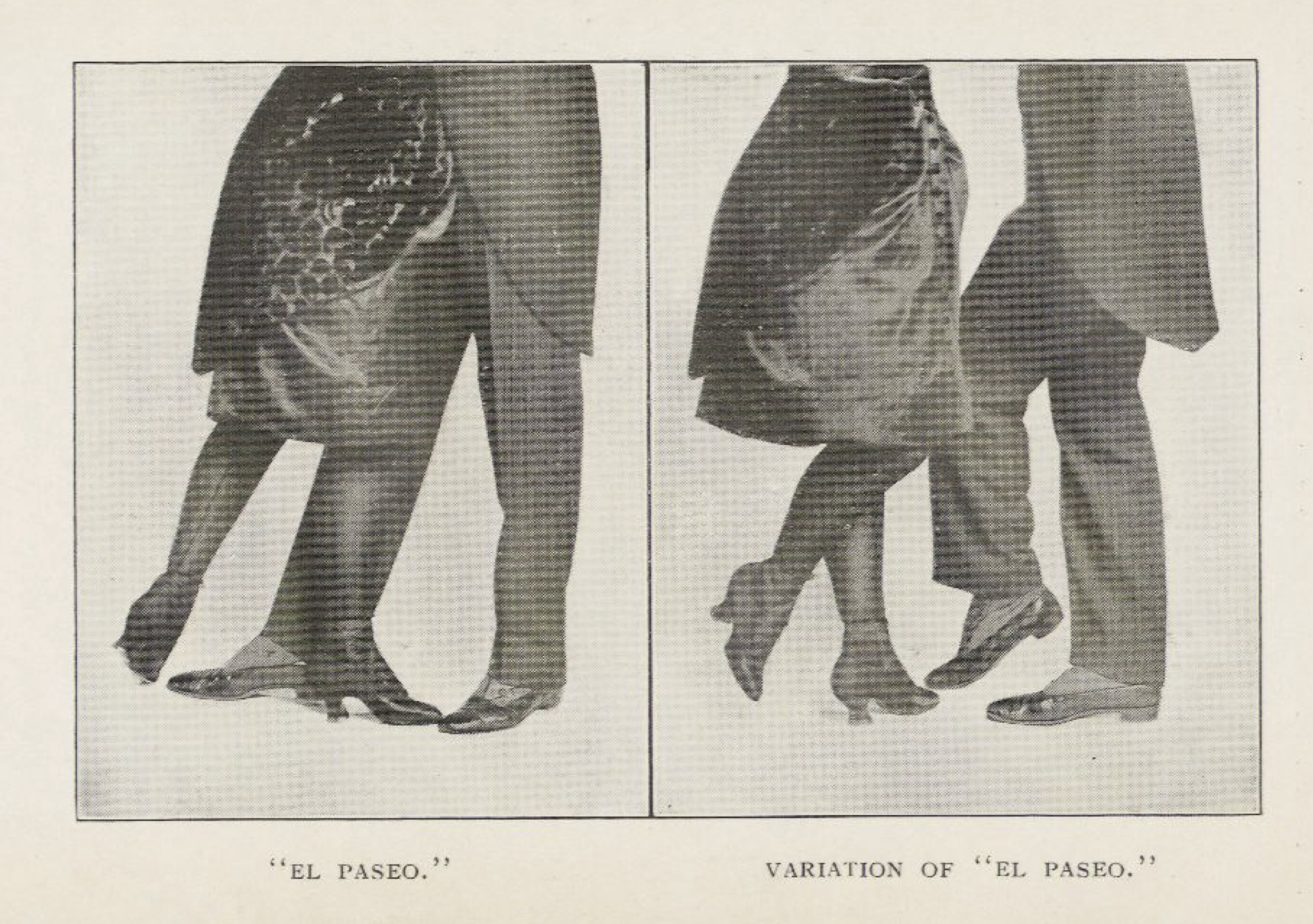
It's unclear exactly what's going on here, but similar to other sources, the Corte is described as ending back on the Lead's right foot.
The pictures suggest it can end up back on either foot. In either case, the Lead's toe and Follow's heel is raised.
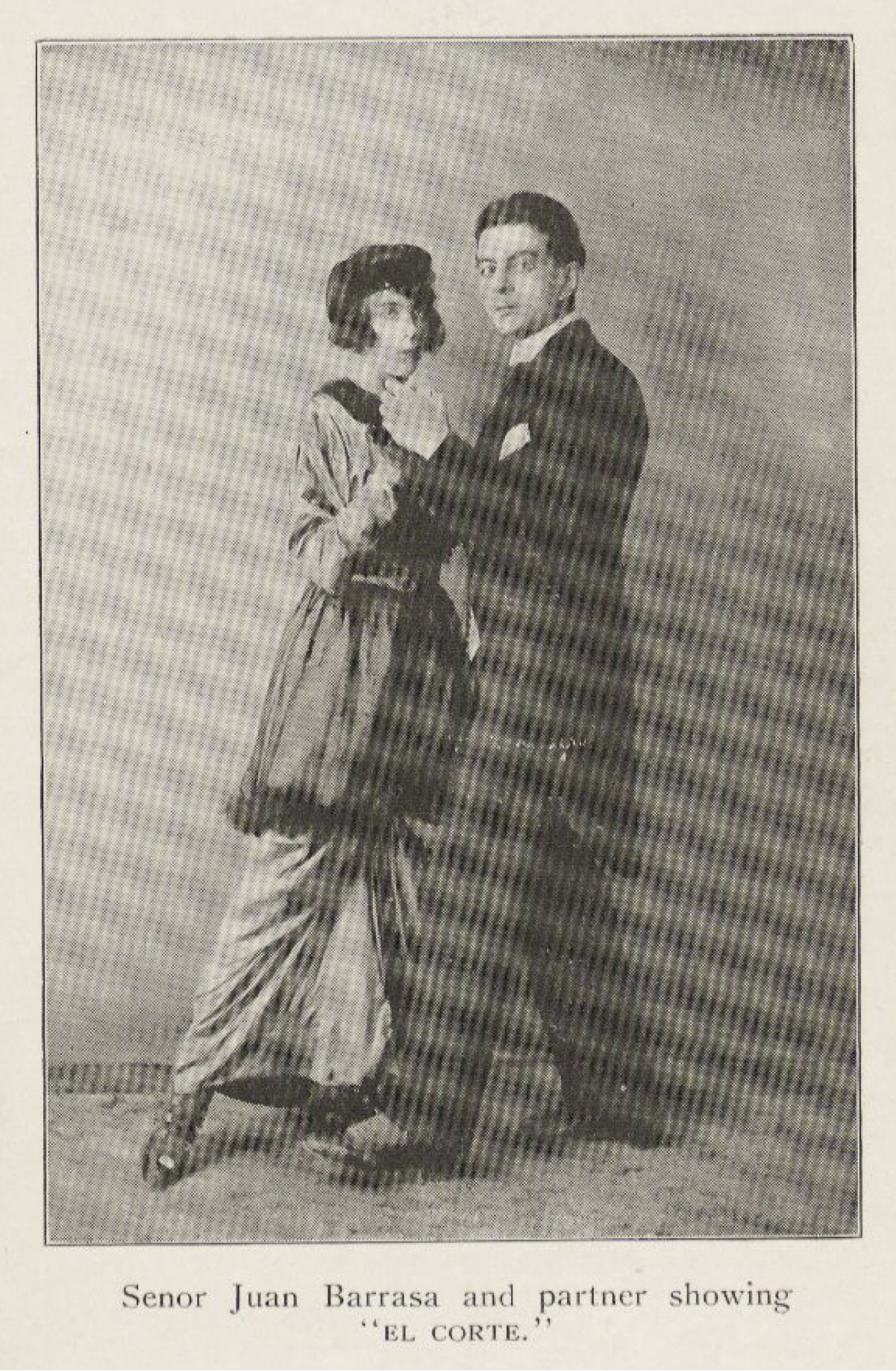
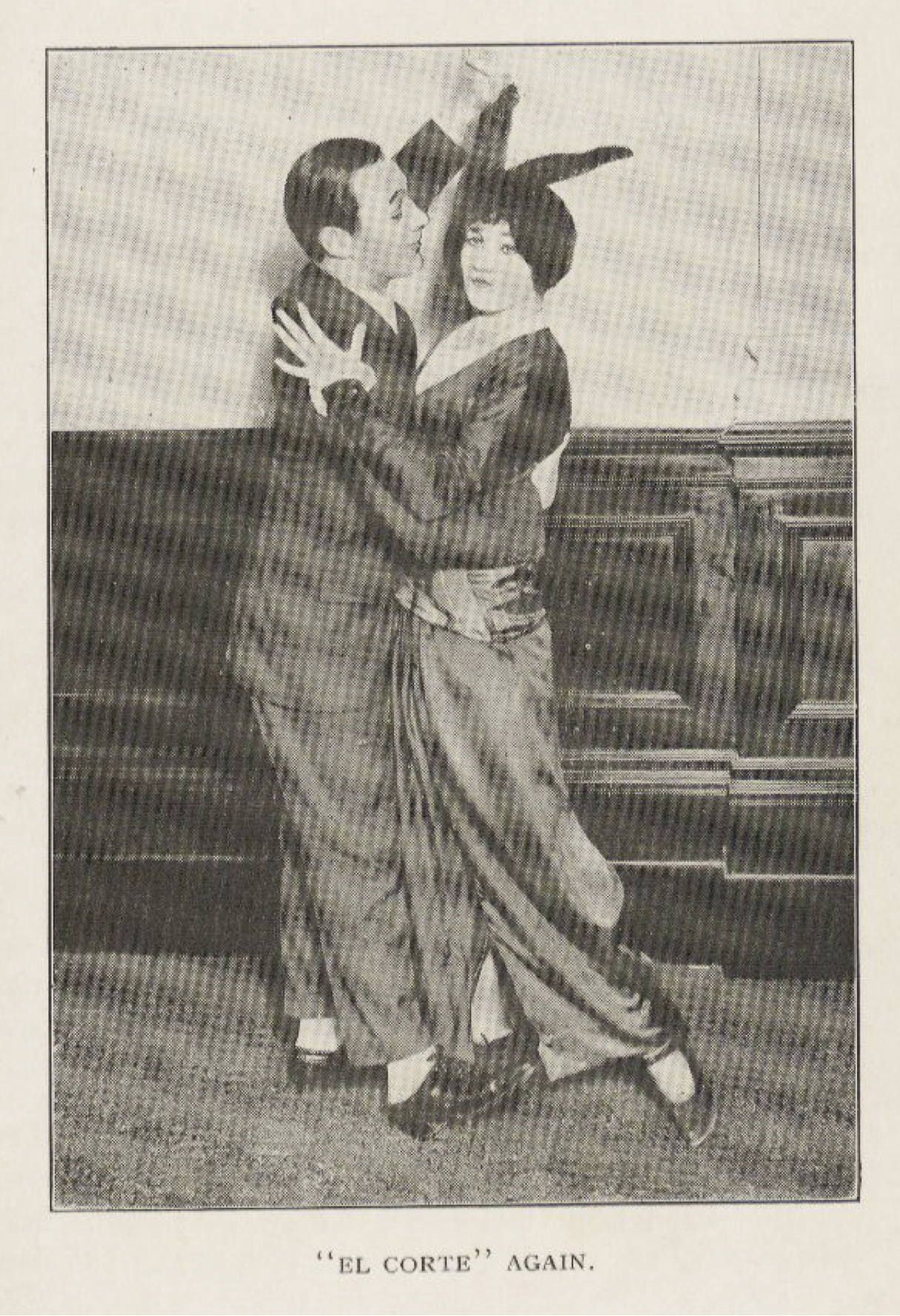
Back the Follow two steps (1, and), then step in place on right (2), then back left (3), hold with right toe touching floor (4). Repeat (four or eight times).
The Lead crosses right over left, then left over right, advancing, as the Follow crosses left behind right, then right behind left, retreating.
"When several steps have been taken forward they stop for a moment, doing a little dip. Afterwards the man starts backwards and the lady forwards, both doing similar steps."
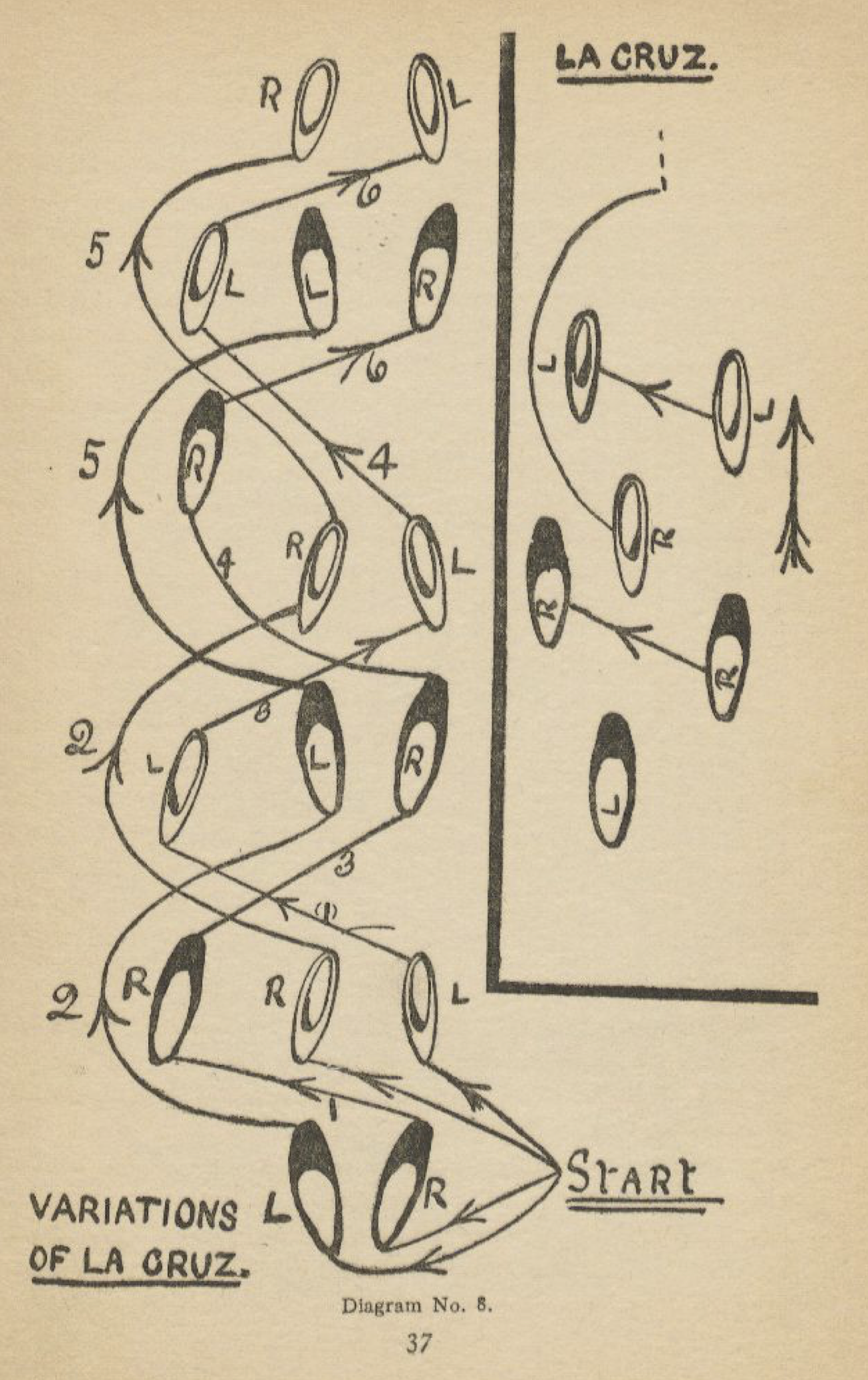
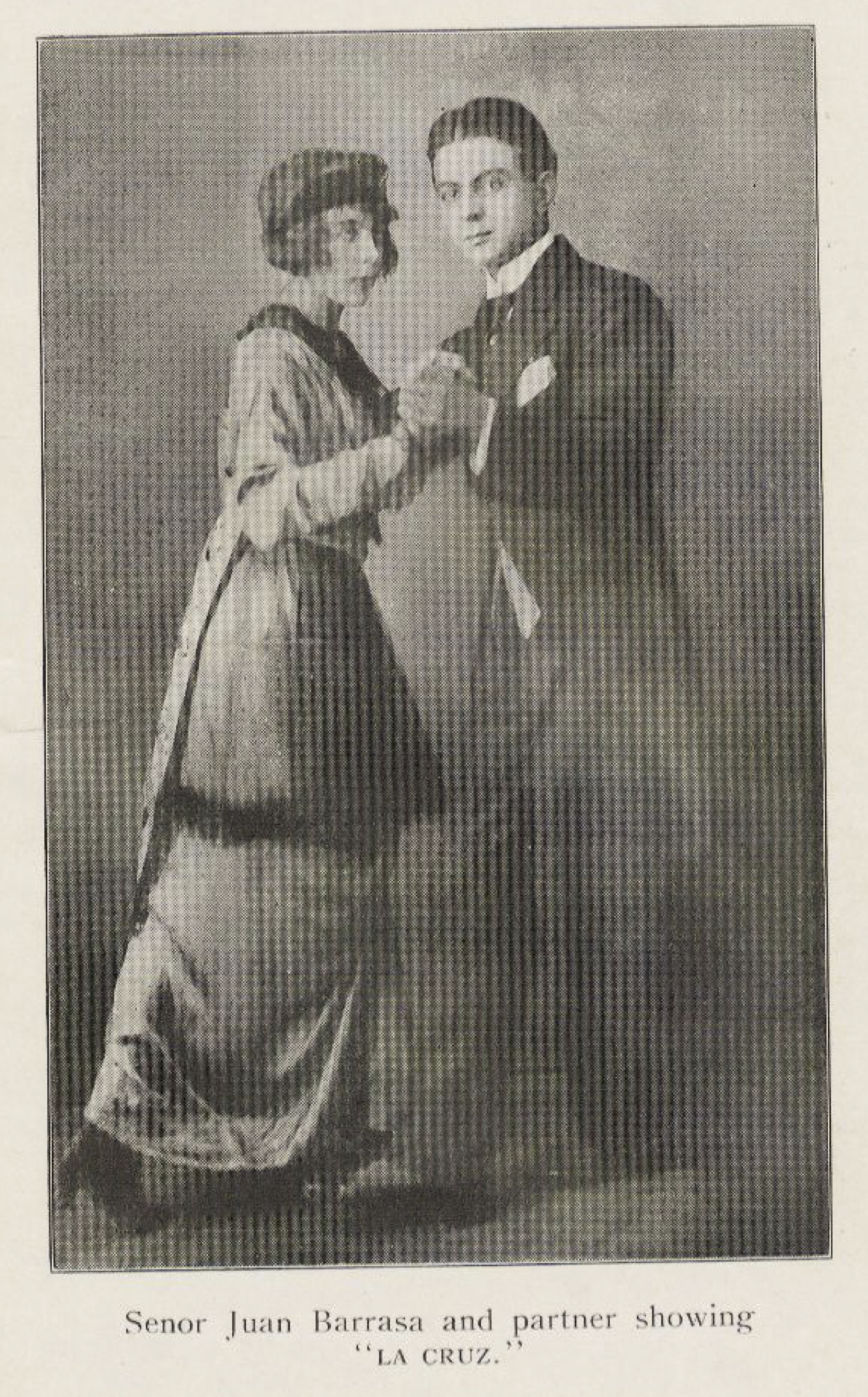
Unclear.
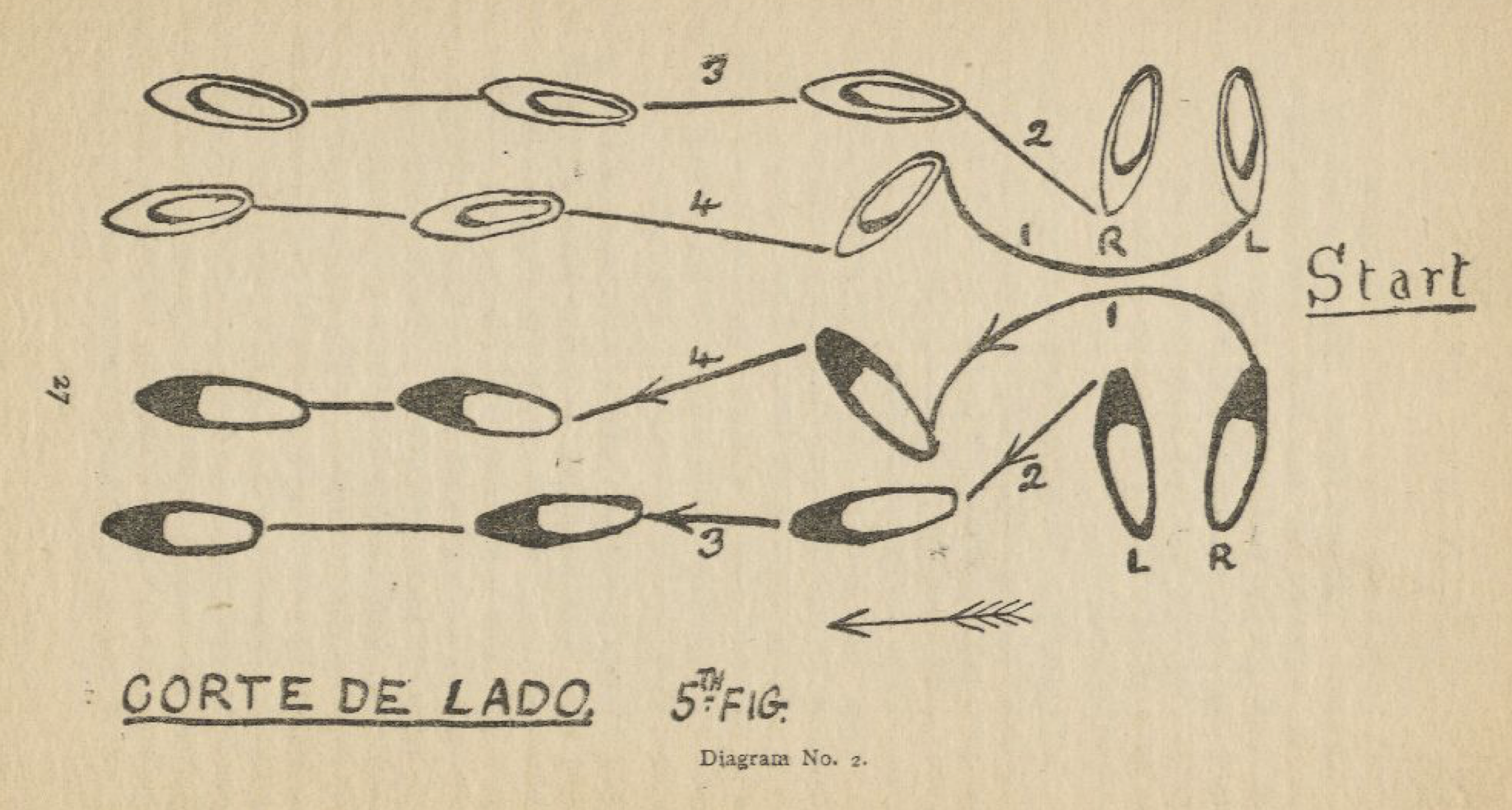
This is an Ocho with cross, point, kick styling in SQQ timing.
Clendenen provides the following sequence: back the Follow four steps, then do 8 counts of Ochos, then finish with a four-count Corte, for a total of 16 counts. Repeat.
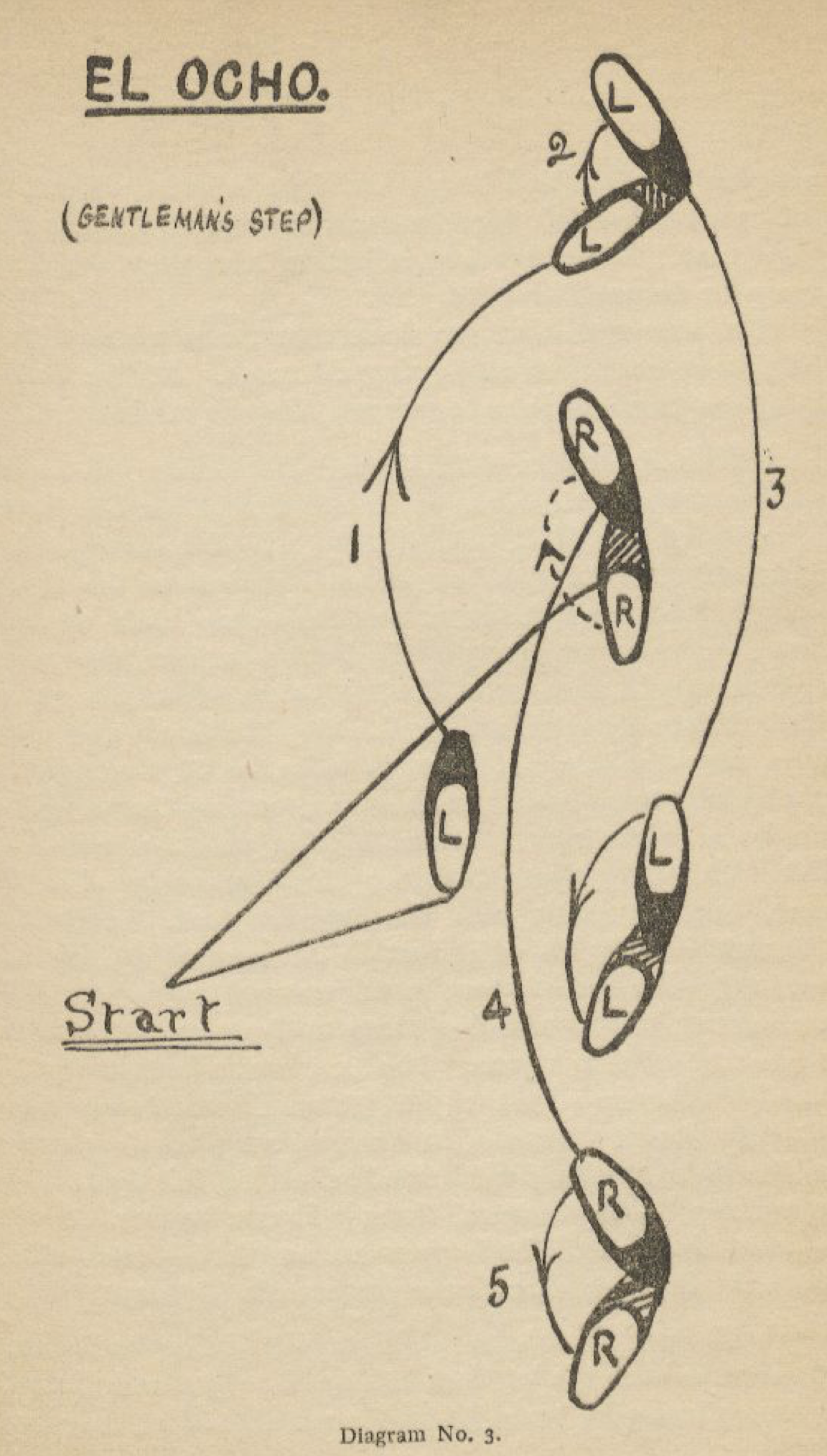
The Lead crosses right over left and pivots on both feet to unwind, as the Follow circles him.
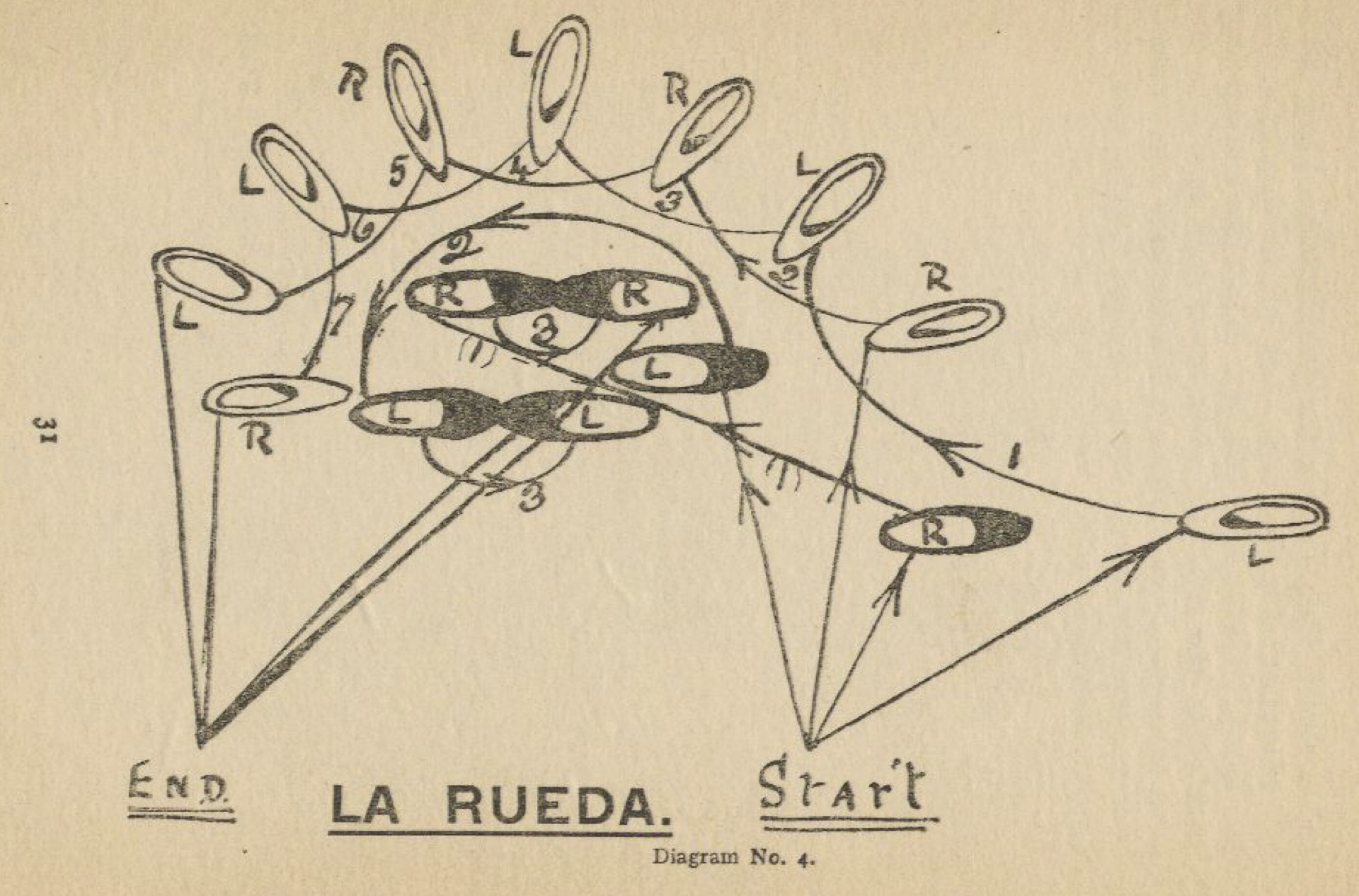
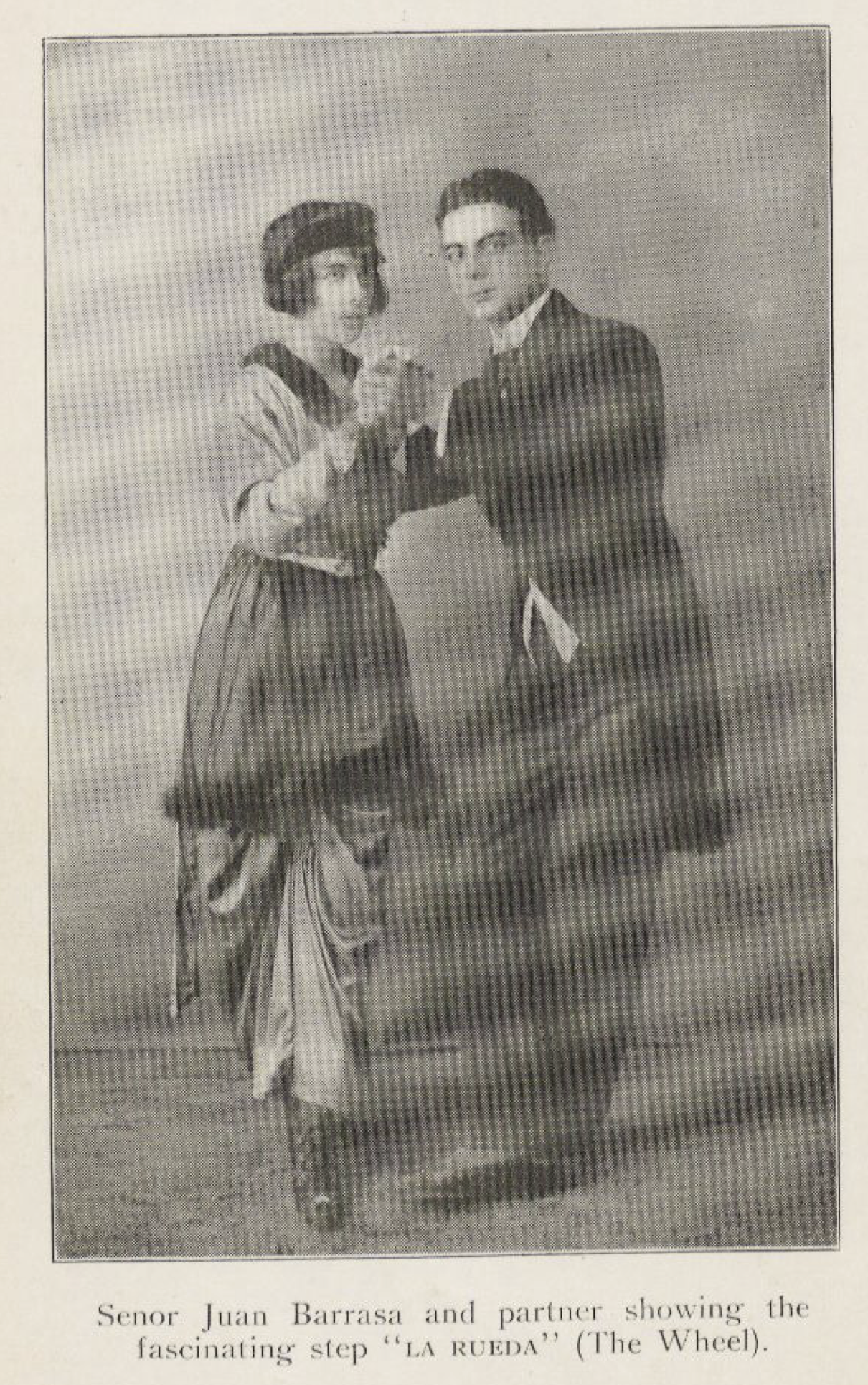
Clendenen describes this as being the same as his No. 20, i.e., forward right (1), side left (and), close right (2), back left (3), back right (and), close left in front of right (4). Repeat.
Lead crosses right in front then side left, as the Follow crosses left behind then side right. The the Lead backs up for two steps as the Follow walks forward for two steps.
Note: Danced explicitly as described and illustrated, it's a bit awkward. Here's a useful way of thinking about it, from Richard Powers, which greatly improves how it feels. Travel the whole figure along LOD, dancing half of a grapevine where the cross step misses your partner (Yale position), and half a grapevine where you're dancing into your partner (Closed position, Lead backing).
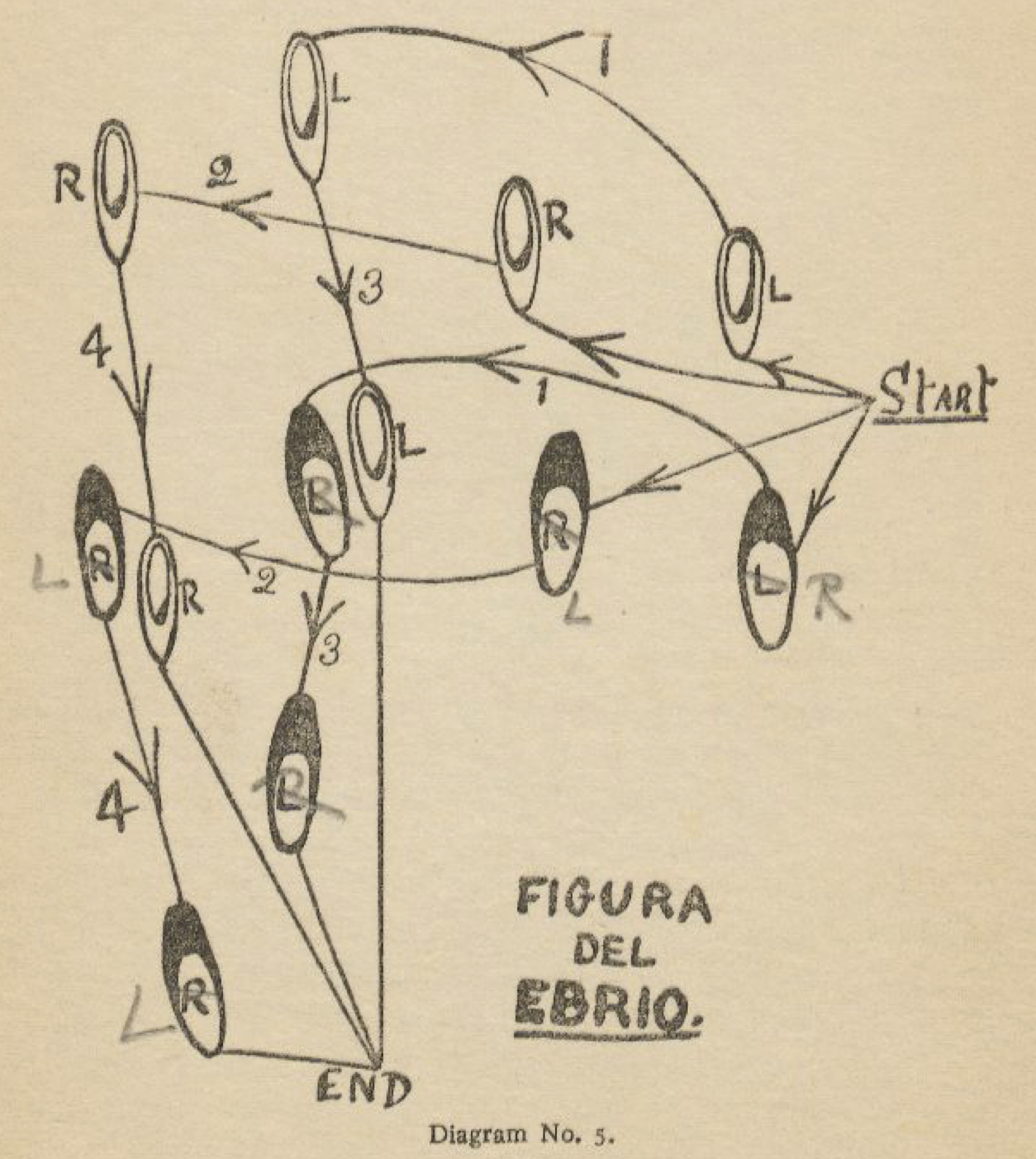
Clendenen's description of this step is different, and is like a two-count Side Step Scissors that starts on the second half: cross, side, back, cross.
After a Corte, kick right forward (1), cross right over, with a dip (2), step side left (3), and hold with right pointed to right (4). Repeat.


This was only intelligible with the help of M. Volinen's La Kriola.
Promenade one step with inside feet, then close outside foot next to inside foot. Rise up on the toes, moving all the heels along LOD, then set down the heels, raise the toes, and move the toes along LOD. Repeat the heel and toe movements, and finish with a Corte.
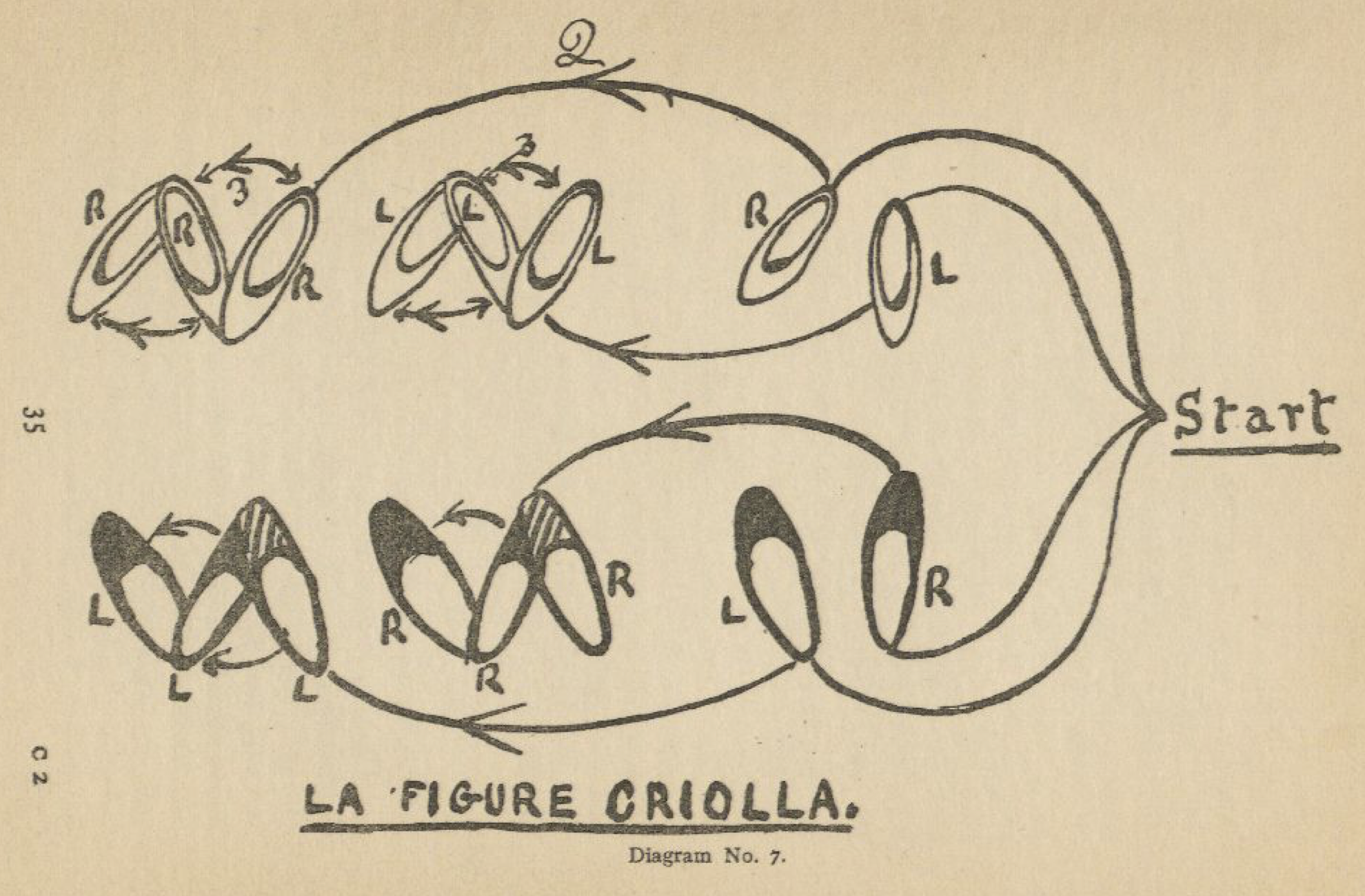
This appears to be the same as La Cruz, simply adding a Corte to the end.

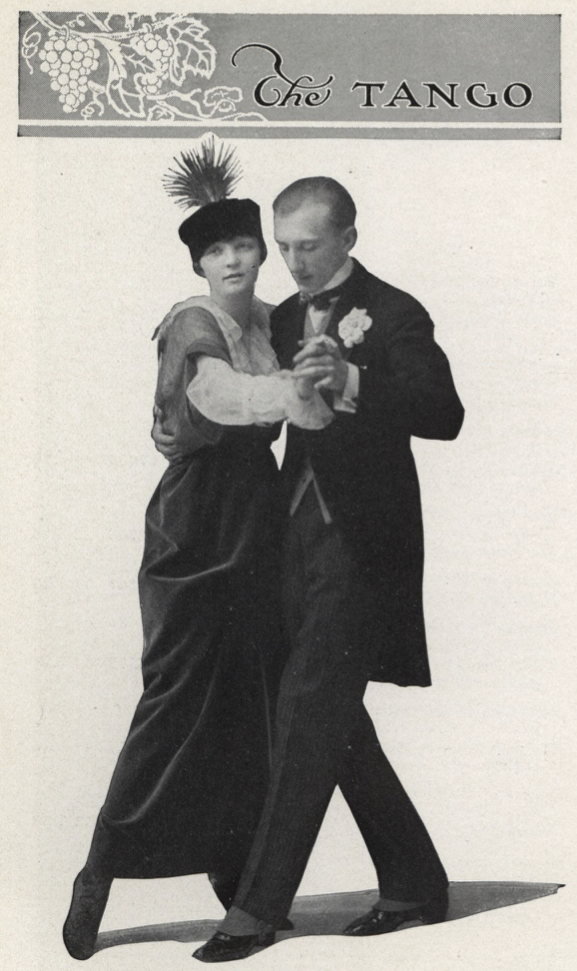
In Promenade position, starting with outside feet, walk forward, forward, forward, close in 1-2-and-3 timing.
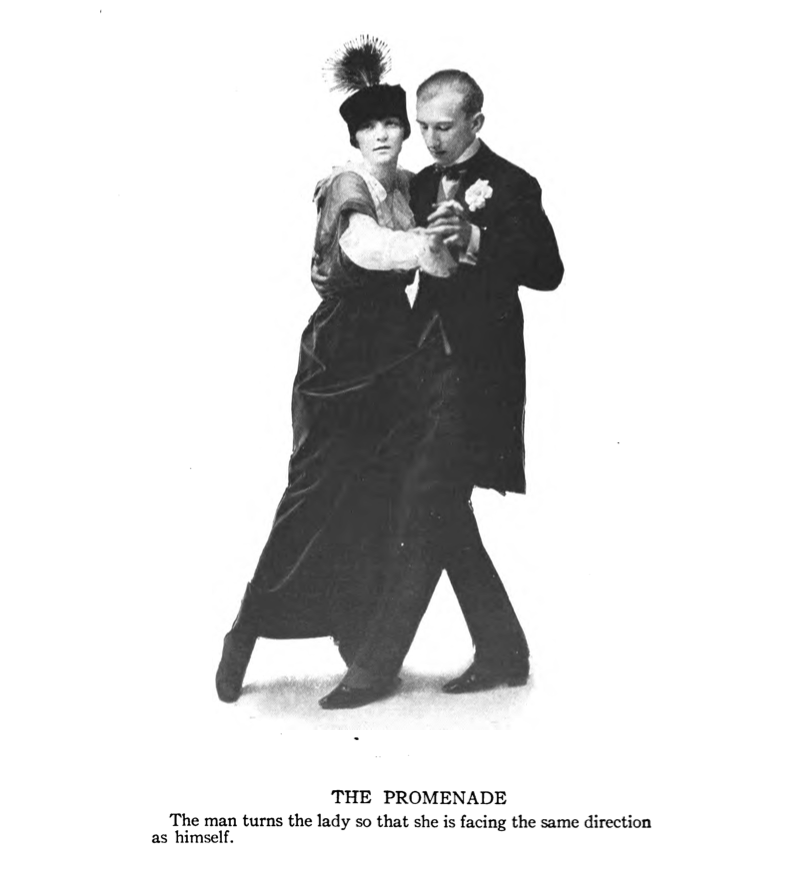
While backing, the Lead steps back left (1), pause (2), back right (3), side left (4), close right behind left (5).
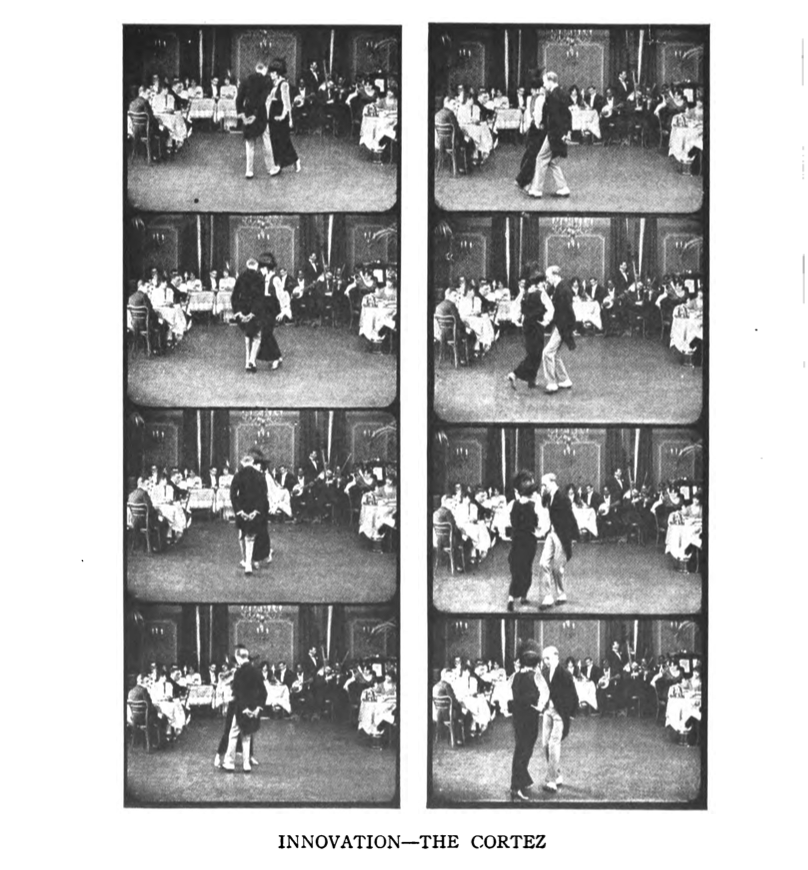
The Lead steps forward right (1) and sweeps forward left (2), then steps back left (3) and sweeps back right (4).
The Follow steps back left (1) and sweeps back right (2), then steps forward right (3) and sweeps forward left (4).
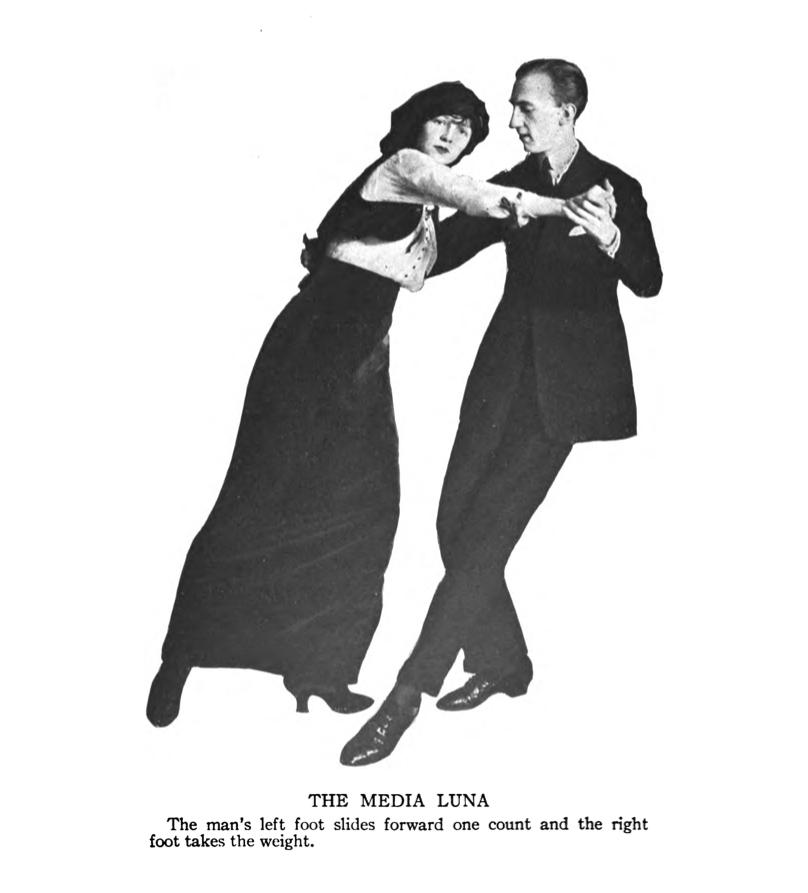
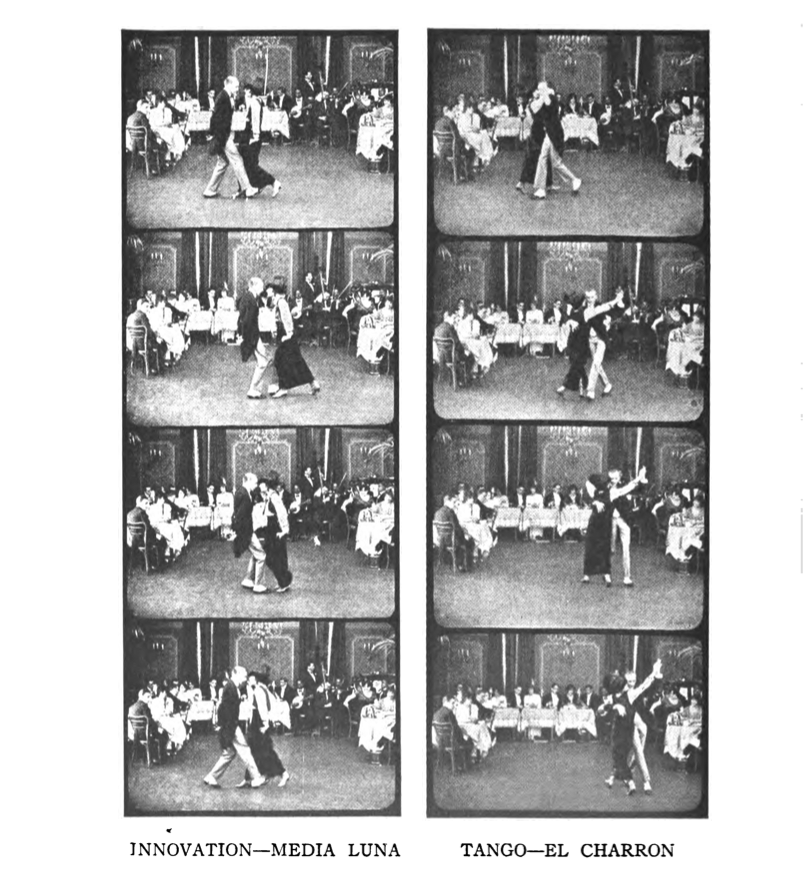
The Castles' description is incomplete, but the pictures suggest an Ochos with Points.
After a promenade step, the Lead crosses right over left (1), points left to the side (2), crosses left over right (3), and points right to the side (4). The Follow dances opposite.
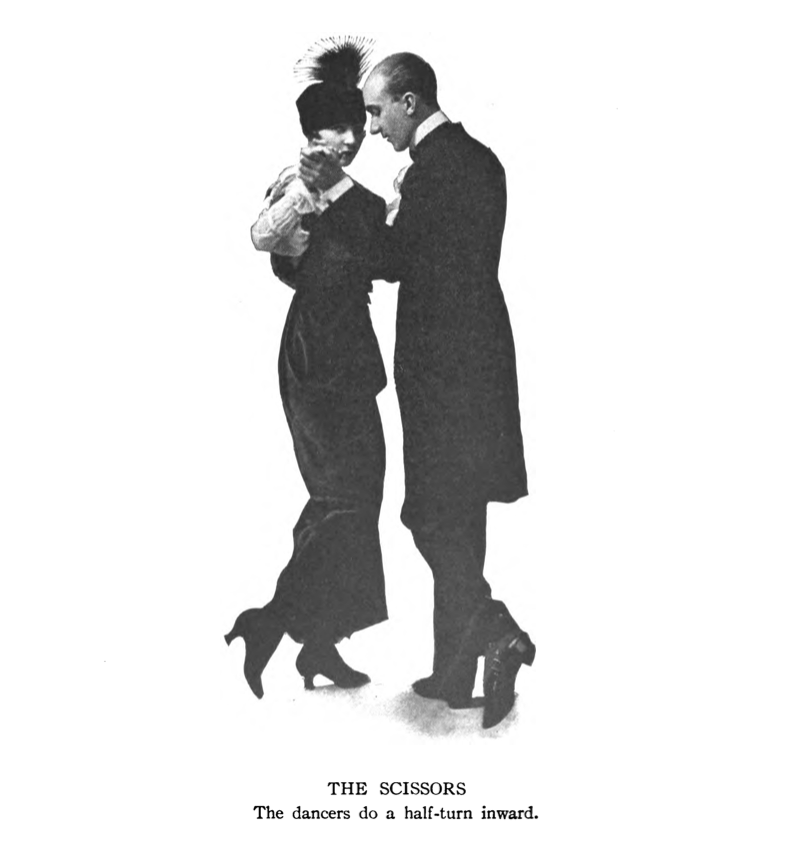
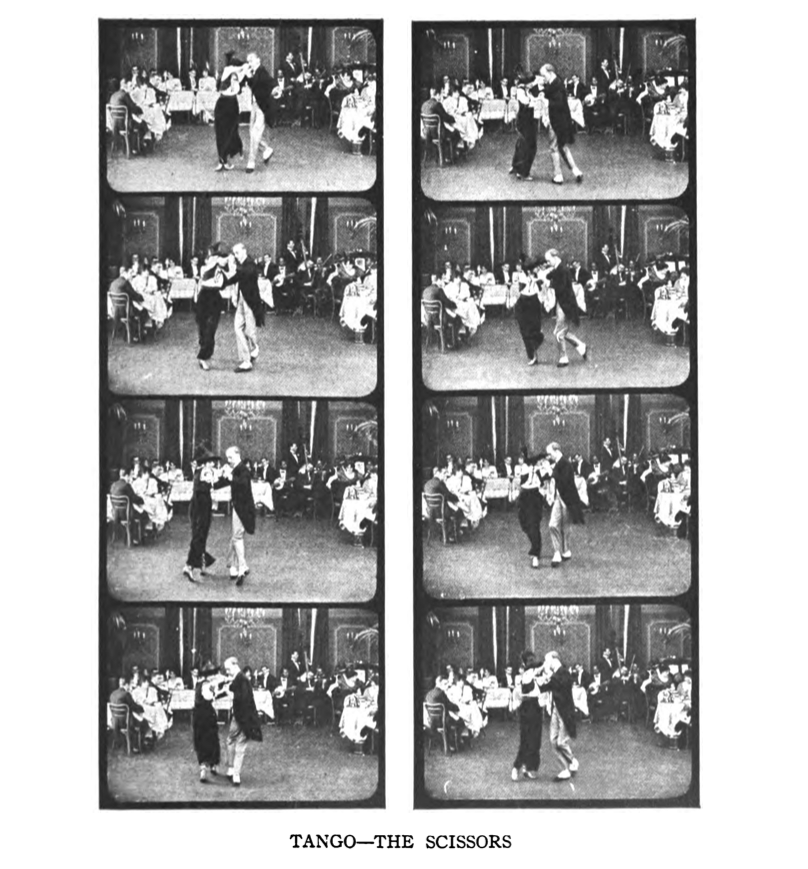
This is simply a Waltz in even timing (1-2-3-4-5-6).
It is described as "a very important and useful step, [which] should be used to fill in between the more difficult steps."
The Lead crosses right over left, and pivots in place to unwind as the Follow chassés around him.
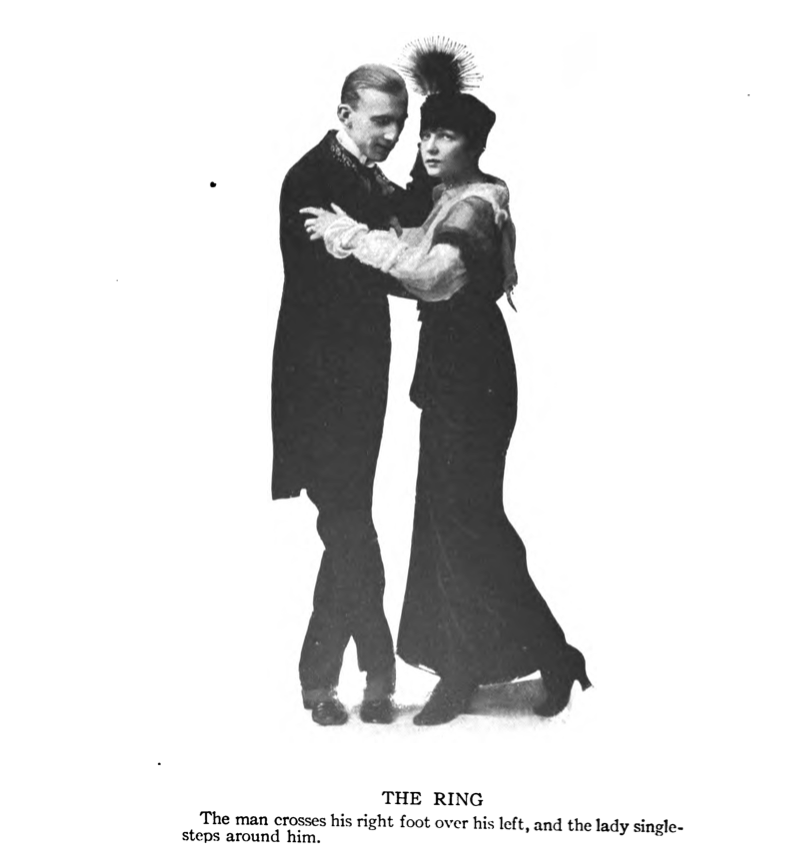
Promenade three steps, turning 90° clockwise on the third step.
Repeat three times, dancing in the shape of a square.
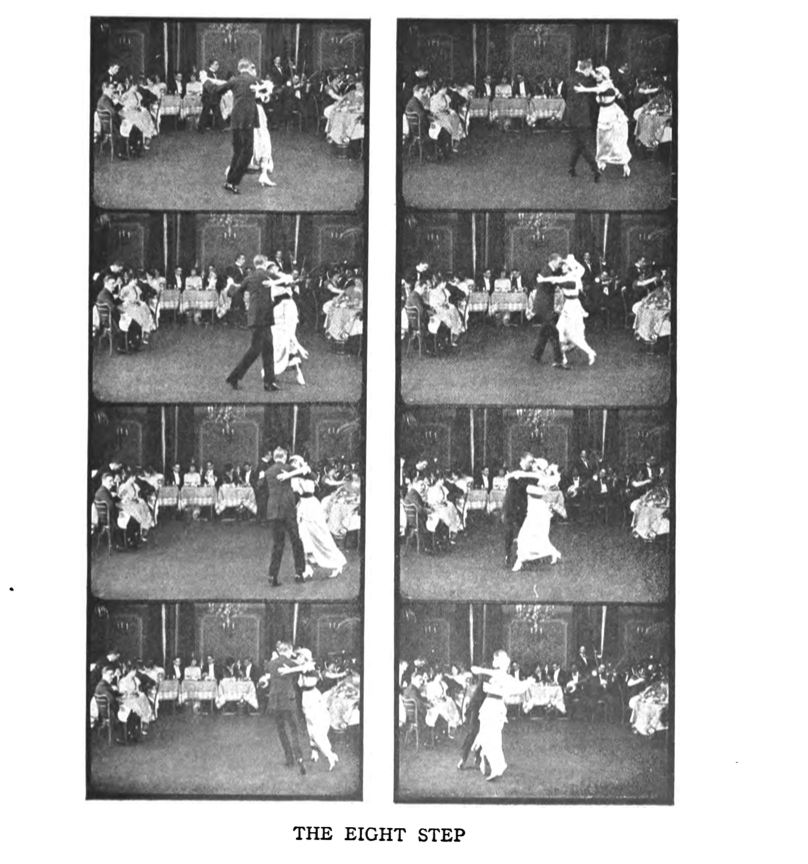
In Yale Position, right hip to right hip, the Lead walks forward three steps, then three steps backward, "turning to the left as much as possible." The Follow dances opposite.

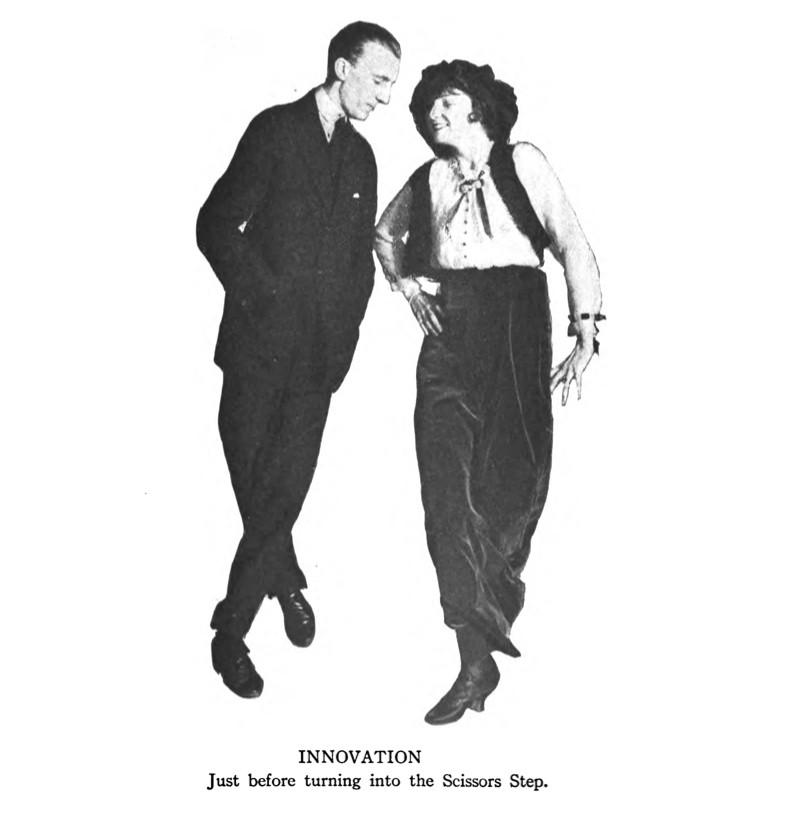
This is best described by the Castles themselves:
The much-talked-of Innovation is nothing more or less than the Tango danced without touching your partner. This is naturally very difficult, and can only be done by good dancers. However, a word of advice may help those who would include it in their repertoire. First of all, the man must learn to lead with his whole body; by this I mean he must convey his steps and direction to his partner by means of head, eyes, and feet. The steps should be broader and more deliberate, and the dancers should travel at the same pace all the time. If by any chance the lady does not follow, and goes into the wrong step, don't stop dancing but get as closely together as possible, and the man must do a plain walk backward. When both are ready the man must try to convey the step in a better way. If, when mistakes happen, you keep dancing, in nine cases out of ten no one will know about it but yourself. On the other hand, no one can miss your mistake if you get confused and stop. The lady should not look at a man's feet in this Innovation, but rather try to get a general view of her partner, so that she may see what he is doing without actually scrutinizing the steps. The hands may be either kept behind your back, on your hips, or in your pockets; look at yourself in a mirror and decide which position suits you best.
Promenade two steps (1, 2), then swing outside forward (3), and back and step on it (4), then step forward inside foot (5), touch outside foot next to inside foot, facing your partner, knee in (6), then point it forward (7).
This is a sequence of Tango steps arranged by the Castles. The sequence itself isn't entirely clear, but here are the social variations that are included in it.
Cortez: Starting Lead's left, walk forward (1), forward (2), forward (3), side (and), close (4), forward (5), forward (6), side (and), close (7), hold (8). This is notable for including both the shape of the later American Tango basic, as well being an early example of the classic T-A-N-G-O (SSQQS) timing. Its placement before a left-turning waltz in the sequence implies that the left foot is kept free at the end. While there's no indication that it evolved into the later basic, it did include all of the elements.
Waltz: A left-turning waltz in QQS timing.
Media Cortez: Starting Lead's right, forward (1), side (and), close (2), back (3), hold (4).
Walk: Back the Follow four "slight Cake Walk steps."
Pivot Turn: Described simply as "Pivot Turn, to right, 4 counts."
Media Luna: Step forward inside foot, forward outside foot, back inside foot, back outside foot, back inside foot, forward outside foot. Timing is unspecified, but based on other figures, could be SSS or SQQ (like a side-by-side version of Sawyer's Media Luna).
Cross Eight Step: Promenade three steps outside foot, turning 1/4 to the right on the third step. Repeat three times to travel in a square back to place.
Running Cortez: Four double time steps (1, and, 2, and) that precede the Media Cortez.
Media Luna: Starting Lead's right, forward (1), side (and), close (2), back (3), side (and), close (4).
Chassé: First part is unclear, but the second part is promenade two steps, then side, close in 1, 2, and 3 timing.

F. Leslie Clendenen's Dance Mad includes a compilation of Tango steps from a variety of sources.
Forward right (1), forward left (2), close right to left (and), back left (3), point right in front (4).
Forward right (1), touch left forward, rolling foot to the left, heel up (2), roll left foot to the right, heel up (3), transfer weight onto left (4).
Forward right (1), point left to side, rising up on right (and), lower right (2), step side left (3), point right forward (4).
Forward right (1), close left in front of right (and), replace right, slightly raising the left (2). Then the second half is impossible as described, simultaneously bending down on and raising the left leg.
Forward right (1), side left (and), close right to left (2), and step back left (3), slightly raising the right in front (4)
Forward right (1), forward left (2), close right behind left (and), close left behind right (3), and close right behind left (4). Repeat, starting on the left foot.
Forward right (1), forward left (2), back right (3), back left (and), forward right (4). What comes next is unspecified, but it could repeat on the left foot, or repeat opposite entirely.
Forward right (1), point left to side (and), and close left to right, raising the right slightly forward (2).
This one, like No. 4, has an conflicting sets of steps with the left foot.
This is the classic Northern Rueda with the Lead pivoting on crossed feet. This description is useful because it specifies that she steps around him for six steps, and on count 7, he steps right foot forward to back the Follow. This is what we always suspected, but it's nice to see it confirmed in writing.
Then it goes on to point the Lead's left diagonally forward on count 8, but you can also just continue to walk out of it.
This is the four count version of the Square. The first and third sides of the square are cross, side, cross, side, while the second ad fourth are side, cross, side, cross.
This version ends with a bend on count 15, and a rise up on count 16.
This appears to be a QQS version of Ochos with a stamp on the third step, but exactly what is going on is unclear.
A side-by-side figure with rotating, alternating cross steps. Exact footwork and timing is uncelar.
Unclear.
This is a four-count Scissors with Kicks styling.
The two-count version is also described.
Forward left (1), cross right over (2), close left (3), bend knees (4). Step back right (5), cross left over (6), close right (7), bend knees (8).
Right forward (1), close left (and), right back (2), forward left (3), close right (and), left back (4).
Back the Follow four steps, with a toe lead, bending the knees slightly as the heels come down.
Forward right (1), side left (and), close right (2), and repeat opposite (3, and, 4).
An elongated version of No. 18. Forward right (1), forward left (2), forward right (3), side left (and), close right (4). Repeat opposite.
It is noted that "a half turn is often made on the catch step."
Forward right (1), side left (and), close right (2), back left (3), back right (and), close left in front of right (4). Repeat.
Described as a "polka" step: forward right (1), close left (and), forward right (2), back left (3), close right (and), back left (4).
Note: The description has the second half also starting on the right foot, but that's physically impossible, and not like a "polka."
This is a right footed Media Luna Entrerriana in QQS timing.
Back the Follow seven steps, starting Lead's right, then step side left on count 8, with a rise and fall. Then repeat, backing the Lead.
Note: There is no No. 24.
Back the Follow eight steps, turning halfway around to the left on count 8, to back the Lead eight steps.
Or Back the Follow four steps, turning halfway around to the left on count 4, to back the Lead four steps.
A parallel Grapevine to the left, starting with a side step, and crossing Lead in front on count 2. There is a slight dip on each cross.
A very slow walk, taking two beats per step: count 1 is the toe, and on count 2, the heel drops.
Cross right over left (1), cross left over right (2), stamp right foot behind with a dip (3), and raise left from the floor (4). Point left foot to side (5), step on it (6), and Corte (3, 4) (which Corte to do is unclear).
Promenade three steps over the hands, starting Lead's left, and back the Lead around on count 3, then repeat opposite over the elbows, continuing to travel in the same direction.
This is the same as No. 15: a four count Scissors with Kicks styling or a two count Scissors (Ocho) with Kicks styling.
This is a fancy version of the Rueda. The Lead crosses right over left (1), left over right (2), and right over left (3), then pivots to unwind (4, 5, 6), as the Follow walks forward around him, counterclockwise. Exit with a Corte (unspecified), or simply walk out of it. Then "reverse the figure." This could be interpreted to mean switching feet with half of a Corte (forward, side, close in QQS timing), then repeating with the Lead crossing left, right, left, and pivoting, as the Follow walks forward around him, clockwise.
This is the same as No. 10.
This is the same as No. 15 and No. 29.
Cross right over left (1), step side left (2), close right behind left (3), point left to side (4). Then repeat opposite. This is similar to a Media Luna Mendocina.
Forward right (1), forward left (and), close right to left (2), step forward left (3), and hold (4). Repeat.
Back the Follow four steps, then turn to Promenade along LOD two steps. Strike outside heel forward (7) and again to the side (8), with a slight hop on the right foot with each heel strike.
This is described as a Grapevine starting by crossing back with the Lead's right.
This appears to be a repeated Sentada No. 1, starting on the Lead's right. Like No. 25, it turns halfway to the left on count 8 to repeat by backing the Lead.
Unclear.
Promenade four half-time steps, starting on the Lead's right. Then back up to place with eight normal-time steps. Follow this up with No. 37.
Two slow swivels (2 counts each), followed by four fast Swivels (1 count each).
Back the Follow four steps (1, 2, 3, 4). Then close right to left with a stamp (5), step side right (6) stamp left to the side (7), and close left to right with a stamp (8). Repeat.
These are five different Argentine tango sequences constructed from the numbered variations described above.
This is another Argentine Tango sequence, with the steps described.
Step 1: Promenade two steps, starting Lead's left, then point left to side, facing partner and rising, and twist back to face line of dance while raising left foot and bending right knee. Repeat thrice more.
Step 2: Do Les Ciseaux for 16 counts. This could either be 4x4, or 2x4 + 4x2.
Step 3 (The Corkscrew): This is a version of the Corkscrew in Promenade position. Both facing LOD, cross outside foot toward partner (1), inside foot away from partner (3), then Promenade four swiveling steps (5, 6, 7, 8). Repeat.
Step 4: Forward left (1), forward right (2), forward left (3), hold (4), rock back right (5), step back left (6), point forward right (7), step forward right (8). Repeat.
Step 5: A clockwise Rueda of seven counts, making one full rotation, ending with the inside foot pointed to the side on count 8. Then repeat with a counterclockwise Rueda.
Repeat the dance from the beginning.
Then Clendenen provides two lists of "recognized" steps for the Tango.
The first list has twelve steps:
This is a random, unclear description of a "Corte" between step lists.
Promenade outside foot (1), inside foot (2), point outside foot to side (3), and close it to inside foot with a rise and fall (4).
Step forward left (1), pivot halfway to the right with a long step forward on the right (2), step back left (3), pivot halfway to the left with a long step back on the right (4).
A pivoting version of Ochos: cross left over right (1), and pivot on the left to face the other way (2). Repeat opposite. This is very similar to modern Argentine Ochos.
This is an extended side (1), cross (2) step to the right (8 counts total), bending on the cross steps. Then pivot around as in The Scissors to repeat opposite.
Promenade two steps (1, 2), lunging on the second (3), and coming back up with a 1/4 turn. Repeat 4 times to travel around a small square (it's unclear exactly how).
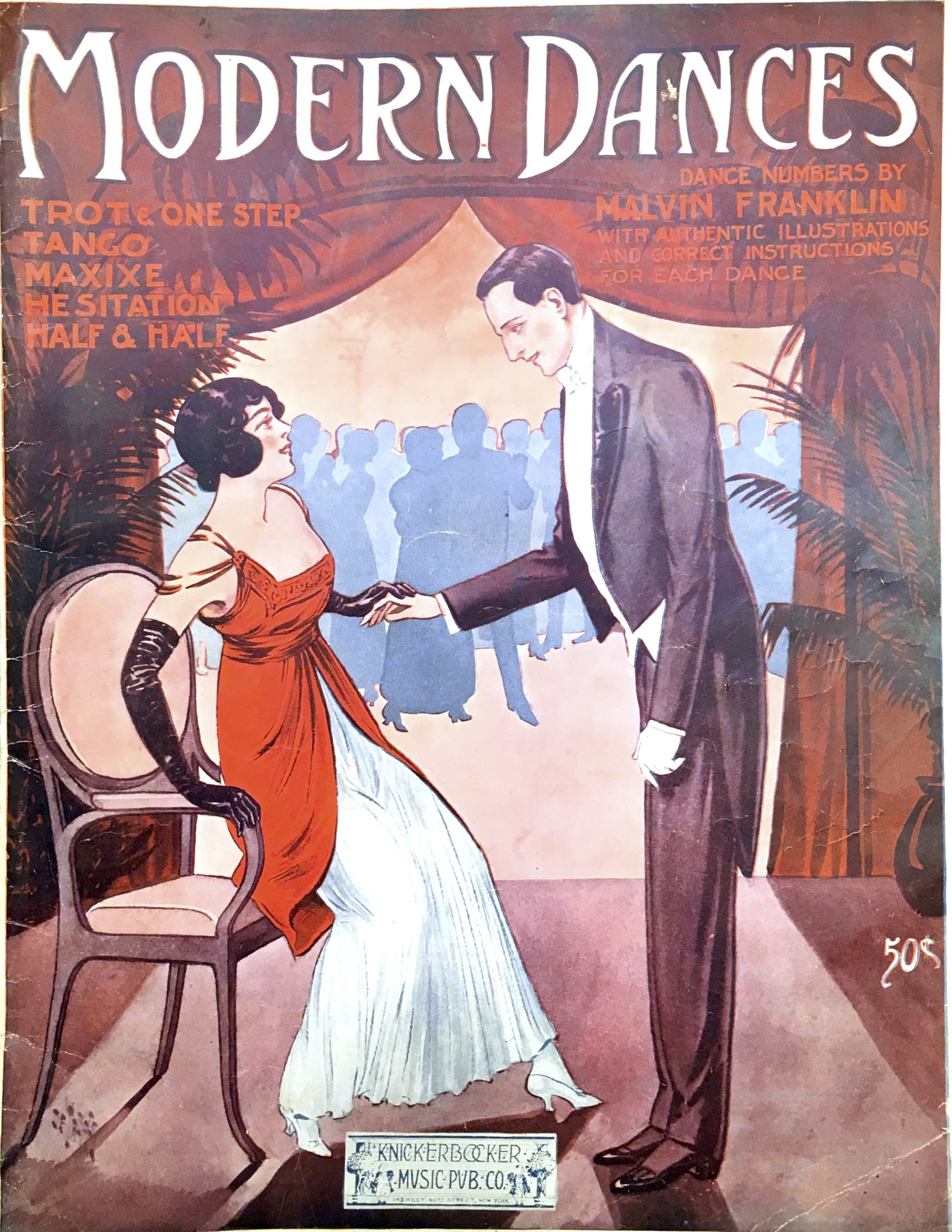
Back the Follow four steps, starting on Lead's left foot.
Promenade three steps, starting outside foot.
On the fourth count, raise the outside foot.
Starting with outside feet crossing over elbows, four swiveling Ochos.
Back the Lead four "swinging" steps, starting on the Lead's left.
Back the Follow four steps. It's not clearly described as such, but this is likely the repeat, as Tangos 1 through 5 add up to a square 16 slow counts.
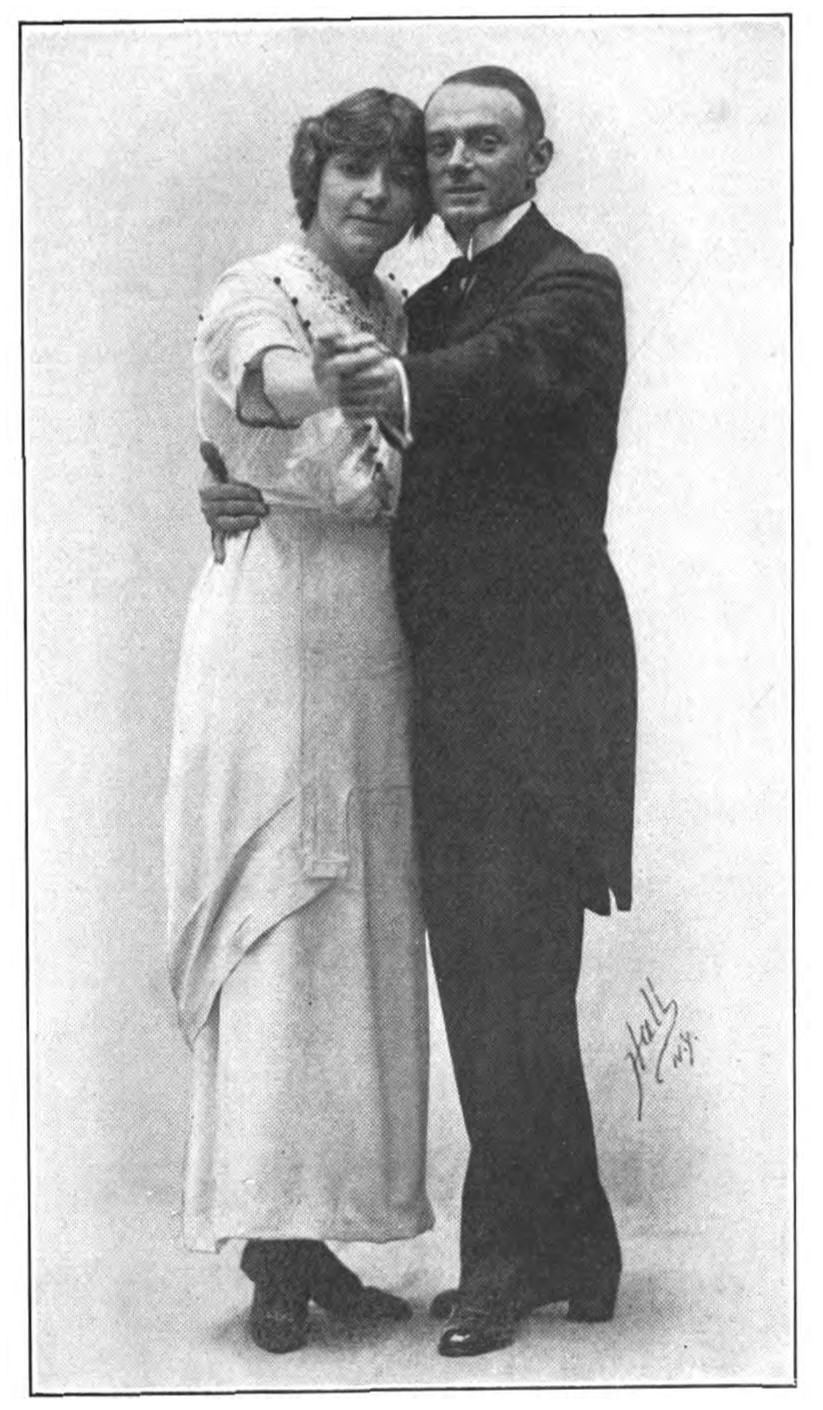
This book has a variety of Tango sequences. Many of the steps are not entirely clear, but there are some unique gems in this source.
Back the Follow four slow steps (1, 2, 3, 4), then Lead points left forward on 5, holding 6, then points left back on 7, holding for 8.
Not entirely clear. Three steps in the form of a half circle, with a point on count 4. Then reverse the turn. The point is specified as a toe point (not flat-footed), and the head and shoulders are inclined toward the point.
Not entirely clear. Back two steps with a quarter turn, then two steps straight back. Another quarter turn in two steps, then two steps straight forward.
Promenade three steps, then close inside foot to outside, kicking the outside foot forward, and bringing it back to the inside instep. Timing is SQQSS. As Step Five starts on the outside foot, this implies that the close to the instep is without weight.
Promenade outside feet (1), lunge inside feet (2), replace back outside feet (3), and step back inside feet (4), at the same time drawing outside feet closed to inside feet. Be careful not to lean forward on the lunge.
Take right hands and half circle around partner with three steps. On fourth count, point, changing hands to left in left, and repeat opposite to return to place. The arms are held such that the elbows as touching.
An eight count grapevine, starting with a side step to the Lead's left followed by the Lead stepping back. Unclear if it's a parallel grapevine, or an interlocked (i.e. "fully drunk") one.
Complete turn on two counts (i.e., a full pivot), then promenade two steps. Repeat.
Unclear.
Unclear.
Unclear.
Same as Step One, but taking two instead of four Tango steps.
Unclear.
One full grapevine: side, behind, side, in front, then two full pivot steps.
It is noted that in this dance, all turns are to the left.
Back the Follow four steps, starting Lead's left, with a slight dip on the steps with the second foot. After count 4, pivot halfway to the left.
Similar to Step One, but backing the Lead for four steps, still starting Lead's left.
A sweeping version of Ochos, starting by crossing Lead's right over left. Timing is unspecified, so this could be Sweeps or Swivels.
Not entirely clear. Promenade inside foot, sweep outside foot forward, and bend onto it. Then repeat opposite.
Unclear.
Four counts of a grapevine (probably as described above), then a complete turn to the left (footwork unspecified, but probably pivots as above).
In this description, it is noted that "the real Tango Step, the brushing or sweeping of the toe to the floor, occurs in all figures, and one should practise this movement to make it long and in a circle from back to forward or forward to back, according to the way you are going."
In addition, "knees are bent inward, as well as the toes turned inward as against the toes and knees outward as in ordinary dances."
It is noted that the entire dance can be done in Skaters' position as well, side by side with the right hands at the Follow's right hip, and the left hands clasped in front.
It is noted that steps 1, 3, and 5 of the Maurice Tango and Steps 3, 5, and 6 of the Santley Tango can also be performed in this position.
Back the Lead eight slow steps along LOD, changing weight on the "and" of 8 to transition to counter promenade position with the Lead's right foot free.
Promenade over elbows seven steps along LOD, starting Lead's right. Then change step on "8-and" to pass the Follow in front of the Lead to the outside lane in preparation to promenade over the hands LOD.
Point outside feet along LOD (1), then transfer weight to outside feet (2), cross through with inside feet (3), promenade with outside feet (and), and close inside feet to outside feet (4). Repeat (5, 6, 7, and, 8).
This is similar to Crozier's Tapping Figure. Promenade two steps, and sweep outside foot for two counts: Crozier's forward, back, and through is most elegant. Repeat.
This is a four-count Scissors, starting by crossing the Lead's right over left. The change is a point to the side (with weight) and close halfway up to it. Then repeat opposite. The timing is SSSQQ.
A repetition of Step Five, but without changing directions at the very end, so you can continue to travel over the hands.
This is the same as L'Eventail, i.e., promenade three steps, Lead backing around on count 3, then repeat opposite, traveling along LOD the whole time.
This is a repetition of Step Seven.
This is another description of the Castles' Innovation:
This tango was introduced lately in New York, and can be taken with any of the foregoing Tangos. The object of this dance is that you not touch your partner, taking the steps with arms akimbo, or, in other words, with hands on hips. You will have to take your steps exactly the same, but without the assistance of your partner, which will mean practice, so that you will not be pulling away from your partner. The object of the Innovation is to get away from the idea some people have that these dances are improper. Try one of the simpler Tangos—one which has few turns, and then take the more difficult ones.
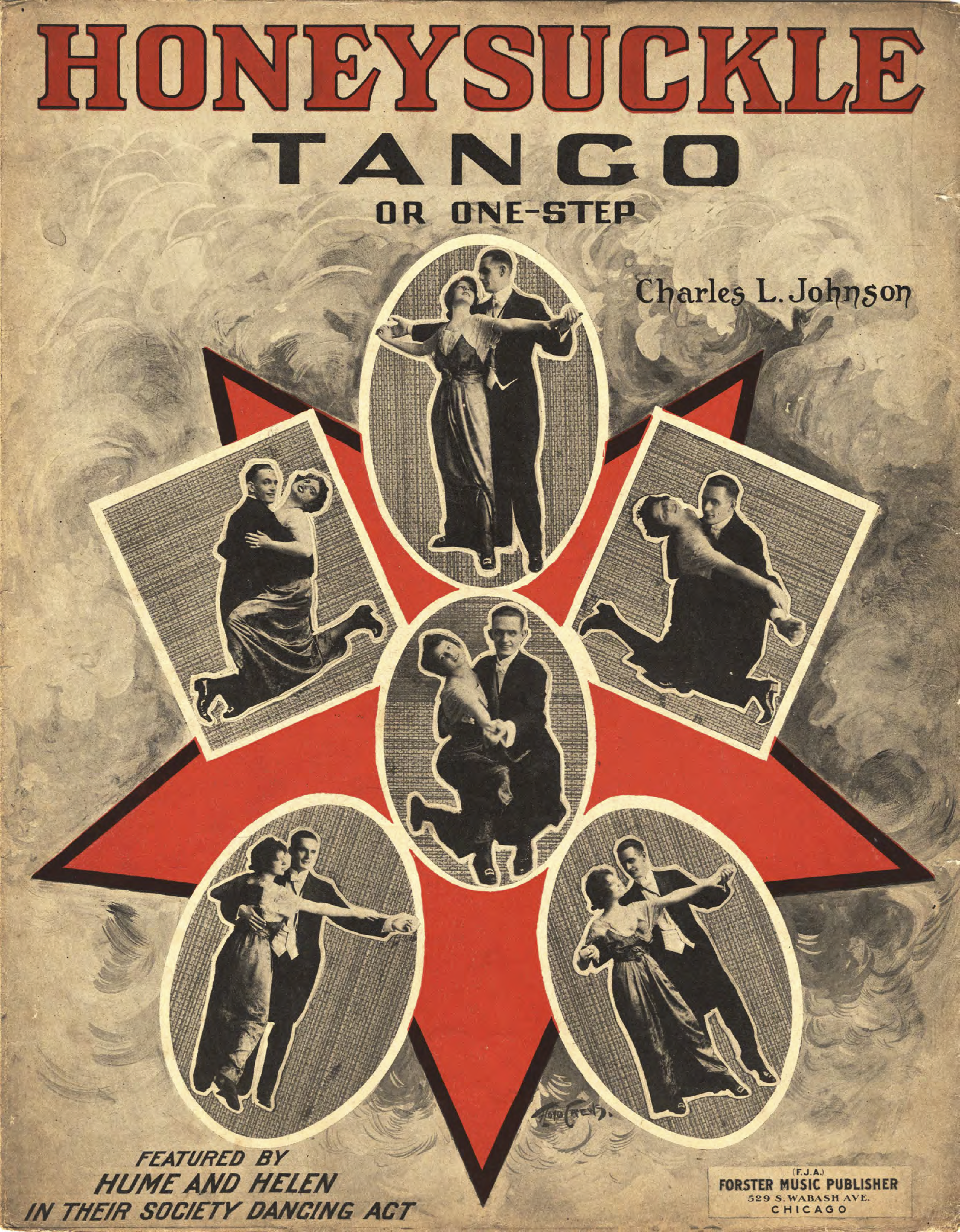
Here is another case (like Bell and Walker) in which the lines between Tango and One-Step are blurred. Notice how the cover of the sheet music says "Tango or One-Step."
According to Johnson, the Tango always starts by backing the Lead four steps, starting on the left foot.
The Lead steps back left (1), brings right to the side of the left without weight (2), steps back right (3), and pauses, bending the right knee (4).
This is a three-step promenade with a slight kick on count 4.
Step forward outside feet (1), cross over (2), and turn (3) to repeat opposite. It's not entirely clear what that means, but it may be an Open version of Ochos.
Promenade four steps toward the hands, then turn and promenade four steps toward the elbows.
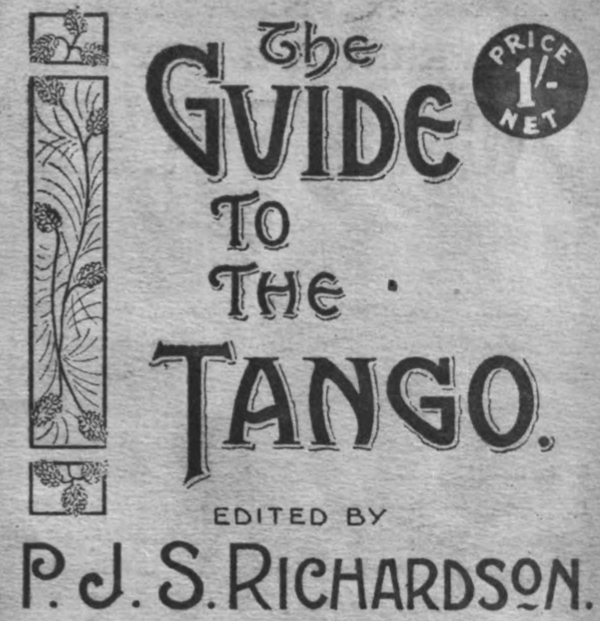
This is a book which compiles many different descriptions of the Tango.
Back the Follow four slow steps, starting on the Lead's right and Follow's left.
Lead steps forward right (1), side left (and), closes right to left (2), back left (3), and hold (4), raising the right toe slightly off the floor. The Follow dances opposite.
The Lead crosses right over left (1), promenades two steps (2, 3), and points left to the side, turning to face the elbows (4). Repeat opposite (5, 6, 7, 8). The Follow dances opposite.
The Lead crosses right over left (1), and points left to the side, turning to face the elbows (2). Repeat opposite (3, 4). The Follow dances opposite.
The Lead steps forward left (1), crosses right over left (2), draws left up to right (3), then steps back right (4), crosses left over right (5), and draws right up to left (6). The Follow dances opposite.
The Lead steps forward right (1), side left (and), and closes right to left (2), then steps back left (3), side right (and), and closes left to right (4). The Follow dances opposite.
The Lead steps forward right (1), forward left (and), brings right up to left (2), then steps forward left (3), and pauses one beat (4). The Follow dances opposite.
Same as Simmons' La Marche.
Same shape as Simmons' Corte. The timing is unspecified.
The Lead steps side left, crosses right in front, and steps side left, then steps side right, crosses left in front, and steps side right. The Follow dances opposite, also crossing in front. The timing is unspecified.
Same shape as Simmons' Media Luna. The timing is unspecified.
Grapevine to the left, starting with the Lead stepping side left then crossing right in front. Vandyck notes that you can repeat it to the left, then turn and repeat it in the same way to the right. The Follow dances opposite, also crossing in front.
The Lead steps side left (1), crosses right over left (2), side left (3), crosses right over left (4), then sweeps the left around to cross it over right (5), steps side right (6), crosses left over right (7), and steps side right (8). Then repeat with two steps instead of four: Lead steps side left (1), crosses right over left (2), crosses left over right (3), and steps side right (4). The Follow dances opposite throughout, also crossing in front. If you dance the first part once, and the second part twice, you have a nice 16 count sequence.
The Lead steps back right (1), side left (2), forward right (3), side left (4). The Follow dances opposite.
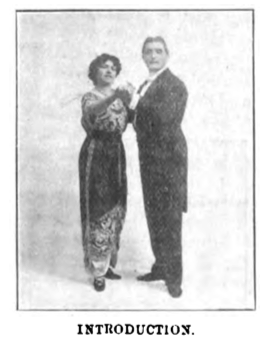
Very slow steps (two slow beats per step), forward or backwards. The toe is placed on the first beat, and the heel comes down on the second (while the other foot comes up on the toe).
Slow steps (one slow beat per step), with a slight bend on the completion of each step.
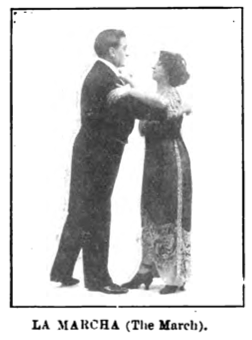
The Lead steps forward right, forward left, then strikes the right foot behind the left, before sitting back on the left foot, right toe off the floor, as in the Cortes above. Timing is unspecified.
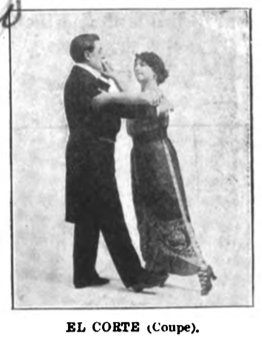
Back right (1), pass left to side of right, slightly pivoting outwards (2), back left (3), pause (4).
Lead steps forward right (1), forward left (2), and closes right to left, striking the floor (and). Repeat opposite (3, 4, and). The Follow dances opposite.
The Lead crosses right over left (1), crosses left over right (2), strikes right behind left (and), then points left toe to the side (3), and steps on the left heel (4). Repeat (5, 6, and, 7, 8).
Alternatively, step on the left foot on count 3, and repeat from there, dancing against the music.
Same as Crozier's Tango Waltz, i.e., slow Cross-Step Waltz.
Same as Simmons' Ciseaux en Quatre, but with a slight kick to the side after pointing the toe, as in Barrasa's Ocho Argentino.
Givre says it can be done in either four steps, or two, in which case it's a Kicks version of Ochos.
The Lead crosses right over left (1), left over right (2), and right over left (3), then pivots in place, as the Follow crosses opposite, then walks five steps forward around the Lead (4, 5, 6, 7, 8).
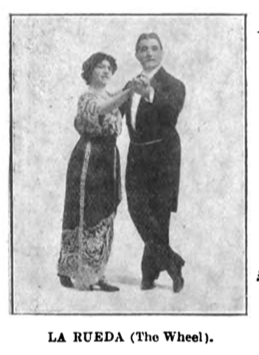
Señor de Alvez's descriptions are significantly more opaque than those of his colleagues, but they do include several unique elements not seen in the other descriptions in this book.
Slow steps, forward or backward, starting with the Lead's left foot. There is a slight bend of the knees with each step.
The Lead steps forward right, forward left, strikes the floor with the right, closes left to right, and steps back right. The timing is unspecified.
Ocho-esque, but unclear.
Unclear. Involves alternating crosses of the feet, moving slowly around the room, on the same foot as your partner, holding the Follow "sidewards," with the intention of kneeling at each step.
While walking (El Paseo), knock right heel on the floor and step side right, then knock left heel on the floor and step side left.
Similar to other descriptions of La Rueda, with the Lead crossing one foot over the other and pivoting to unwind. This version has the Follow chasséing around the Lead, and ends with a slight pause.
Unclear.
This was only comprehensible with the help of Clendenen. It is described as a "polka" step: forward right (1), close left (and), forward right (2), back left (3), close right (and), back left (4).
Back the Follow seven slow steps along LOD, starting Lead's right (1, 2, 3, 4, 5, 6, 7), then step side along LOD, extending other foot (8), and back the Lead along LOD (1, 2, 3, 4, 5, 6, 7, 8).
Lead steps forward right (1), forward left (2), back right (3), back left (and), and pause, leaving the right heel on the floor in front (4). Repeat two or three times.
Humphrey notes that El Paseo and Le Corté are intermediaries for the other figures.
The Lead swings right foot around the side to the front (1), glides left foot past the right and crosses in front (and), then closes right up behind left (2). Then he swings the left foot around the side to the back (3), glides right foot past the left and crosses behind (and), then closes left in front of right (4). The Follow dances opposite, starting on count 3.
1st Part: An ornamented version of Simmons' Les Ciseaux en Quatre. Lead crosses right over left (1), steps side left (2), crosses right over left (3), then steps side left, moving right foot about three inches toward the left (and), and points left foot to the side (4). Repeat opposite. The Follow dances opposite, also crossing in front.
2nd Part: An ornamented version of Simmons' Les Ciseaux en Deux. Lead crosses right over left (1), then steps side left, moving right foot about three inches toward the left (and), and points left foot to the side (2). Repeat opposite (3, and, 4). Then cross right over left (5), left over right (6), right over left (7), then side left, rising on it and extending right foot to the side (8). The Follow dances opposite, also crossing in front.
Danced "standing side by side." Four very slow steps (two beat per step) forward (1, 3, 5, 7). Then four slow steps backward (1, 2, 3, 4), followed by "Tango Step twice" (5, 6, 7, 8). It's unclear exactly what the "Tango Step" is. There is a "Tango" step below, but it's already four counts. So I suspect Humphrey means "Le Corté twice," because that's the only two count figure he describes.
The Lead steps forward right (1), touches left toe forward (and), and steps back left (2). Repeat "ad lib."
The Lead steps forward right (1), points left behind (2), forward left (3), points right behind (4). Repeat (5, 6, 7, 8). Then the Lead steps back right (1), points left behind (2), back left (3), points right behind (4), steps back right (5), points left behind (6), steps back left, rising up (7), and points right to the side (8). The Follow dances opposite.
Starting left foot, back the Follow four steps (1, 2, 3, 4). Then open up to promenade two steps (5, 6), then strike the floor twice with the free heel, first in front (7), and then to the side (8).
The Lead crosses right behind left (1), steps side left (2), closes right to left (3), and points left to side (4). Then he crosses left in front of right (1), steps side right (2), closes left to right (3), and points right to side (4). The Follow dances opposite, crossing in front when the Lead crosses behind, and vice versa.
The Lead crosses right over left, and pivots in place to unwind his feet as the Follow chassés around him (1, 2, 3, 4, 5, 6). End by crossing in front with Lead's right and Follow's left (7), then pointing the other foot (8).
Right forward (1), close left (and), right back (2), forward left (3), close right (and), left back (4).
Vandyck's Tijeras pattern (2x4 plus 4x2) with Givre's kicking style.
Rest on right foot at side (1), then step lightly on the left (and), then undercut left foot with right, the right foot taking the left's place (2), then step side left, extending right behind (3), pause (4). Repeat three times to the left, but on the fourth time, transfer weight to the right foot at the end to repeat opposite.
Appears to be similar to a Corté: right forward (1), left forward (and), close right (2), back left (3), pause, pointing right heel forward (4).
The Lead crosses right over left (1), steps side left (2), crosses right over left (3), then steps side left (4), turning a quarter clockwise. Then he steps side right (5), crosses left over right (6), steps side right (7), and forward left (8), turning a quarter clockwise. Repeat to finish the third and fourth sides.

These are Tango steps described by Troy and Margaret West Kinney (and demonstrated by John Murray Anderson and Genevieve Lyon) in both Social Dancing Of To-Day and The Dance: Its Place In Art And Life. In the case of Tango, those books contain identical descriptions.
Slow steps, backing the Follow, or the Lead, starting with the Lead's left.
To advance, "the step brings the advancing foot to position squarely in front of the supporting foot, both (by the present mode) pointed straight forward. The full weight is transferred to the advanced foot as soon as possible, the knee of the leg in posterior position promptly relaxed, the posterior foot resting, for a moment, lightly on the point. The step in advance is made with a light gliding movement."
To retreat, "start the foot with a glide, letting it rise from the floor toward the end of the step, meanwhile toeing inward; plant the foot squarely to the rear of the supporting foot. At the moment of placing the retreating foot, the knee of the advanced leg is relaxed, and the advanced foot is turned inward, the heel remaining placed as a pivot."
From 1st position, the Lead steps right foot in place (1), left forward (and), closes right beside left (2), left back, rising on the balls of the feet (3), and drop heels to the floor with a bend of the knees (4).
Repeat the figure by bringing the right foot back, slightly behind the left, on count 5.
The Follow dances opposite.
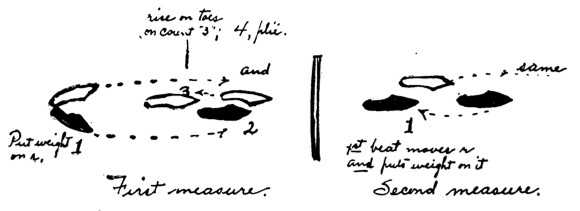
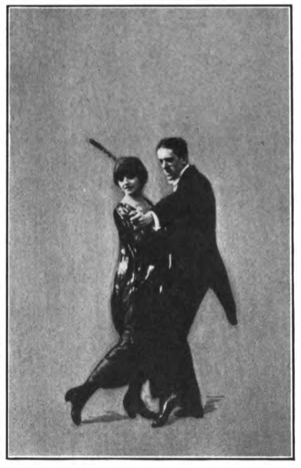
The Lead points right foot to the side (1), kicks heel out (and), and crosses right over left (2). Repeat opposite (3, and, 4). The hips turn, but the shoulders remain facing partner. The Follow dances opposite.

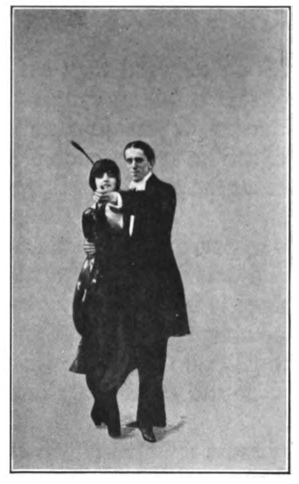
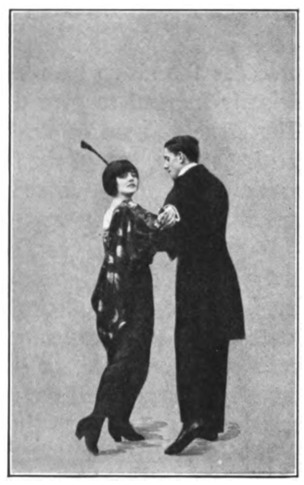
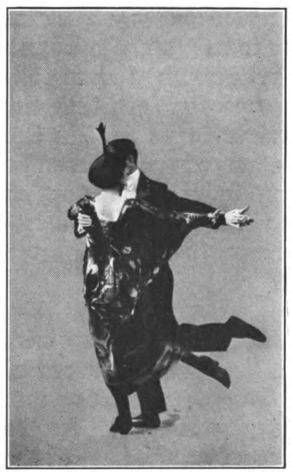
Alternatively, the Lead crosses right over left (1), touches left to the side (2), and kicks heel out (and). Repeat opposite (3, 4, and).

The end of the description alludes to a Follow's solo Scissors Rueda, where the Lead crosses right over left, and the Follow unwinds him by dancing Scissors steps solo around him.
A QQS box step starting Lead's right forward: Lead steps forward right (1), side left (and), and closes right to left (2), then steps back left (3), side right (and), and closes left to right (4). The Follow dances opposite.
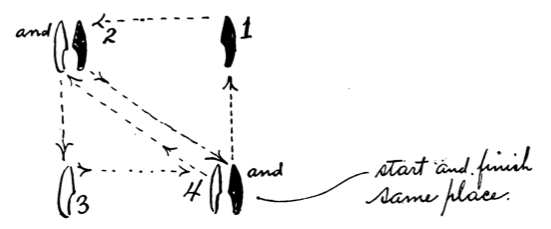
Cross right over left (1), close left beside right (and), step back right (2), turning to the right, then cross left over right (3), close right beside left (and), and step forward right (4).
Can be danced on opposite feet in closed position, or on the same feet side by side in open position.
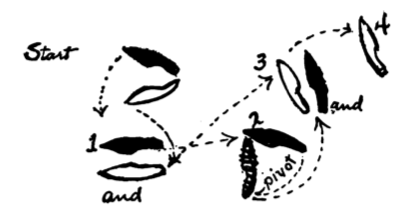
Unclear.
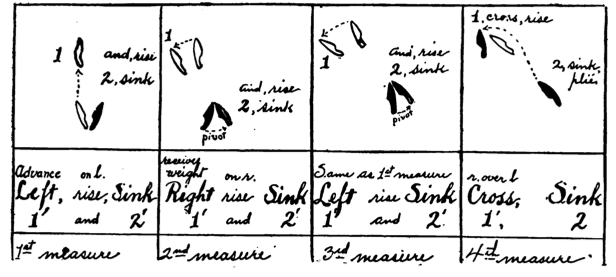
Unclear.
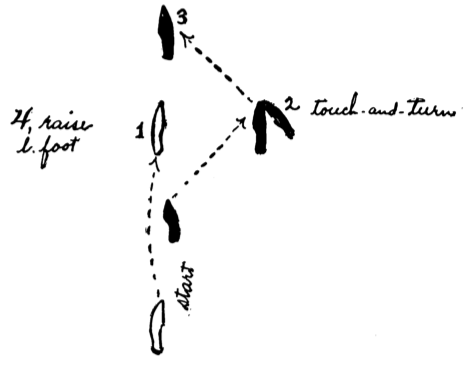
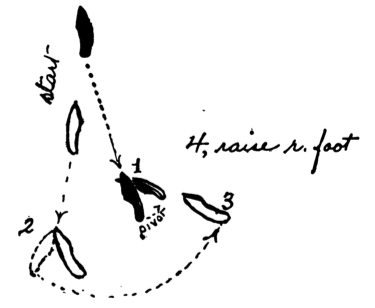
Promenade one step, starting Lead's left, with a stamp (1), then lift the inside foot through the frame a point in the air under the hands (2), swirl the lifted foot through the frame to a lifted point under the elbows (3), and fall onto it into a low lunge (4).
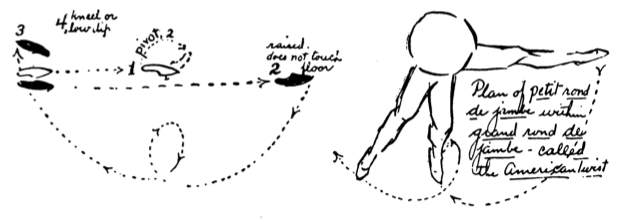
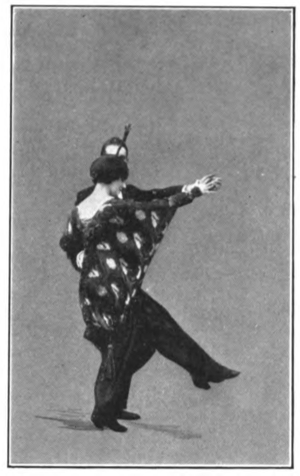
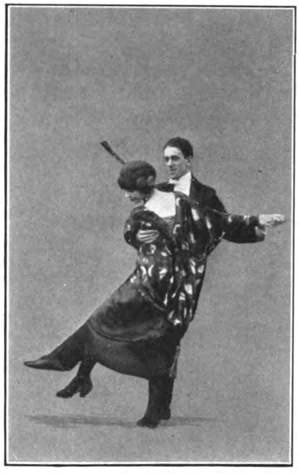

Similar to Vandyck's Volteo, but on the other foot: the Lead steps side right (1), forward left (2), side right (3), back left (4). The Follow dances opposite.
These variations don't have full descriptions, simply pictures with short captions.
The captions read: "Man's foot displaced woman's," "Woman's foot displaces man's," and "Each displaces the other's foot."
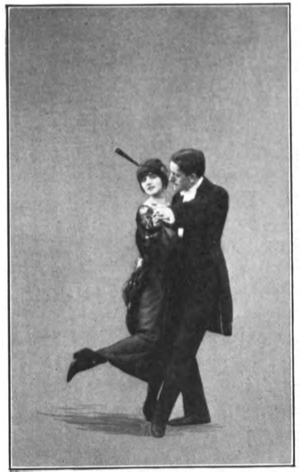
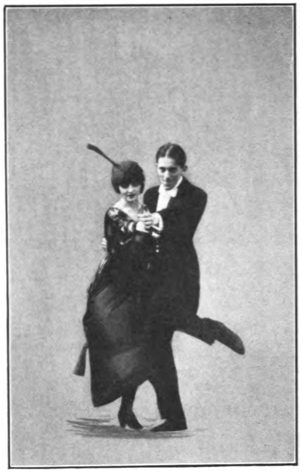
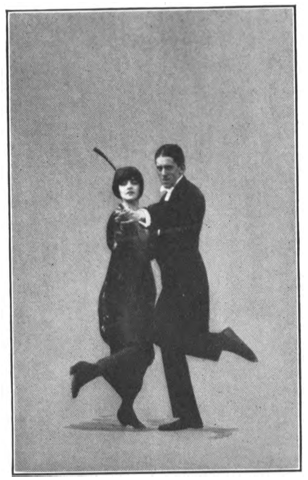
In addition to the foot displacements, Kinney's tango (as demonstrated by John Murray Anderson and Genevieve Lyon) features several other unique elements that are not often seen in Early Tango descriptions.
The first is an underarm turn, which breaks Lima's cardinal rule about remaining in the arms of your partner.
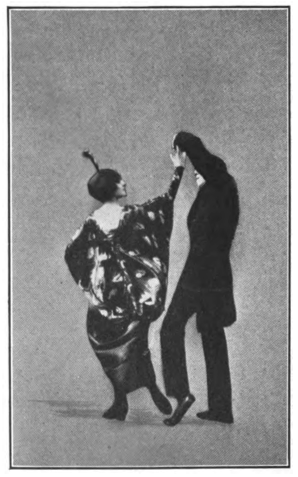
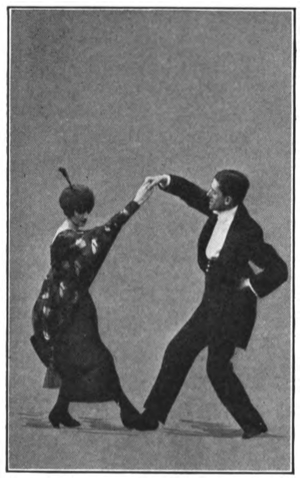
The second is a variation in which the Follow walks around the Lead, touching his shoulders with her left hand.
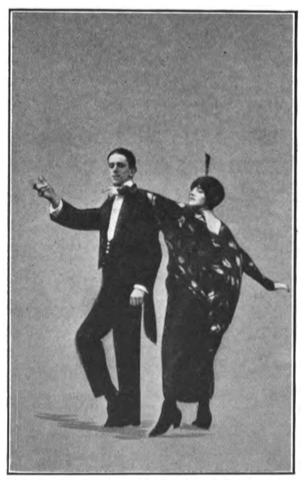
The third is a variation where the partners end up back to back, not touching each other, similar to the Castle's Innovation, or Crozier's Swing Figure.
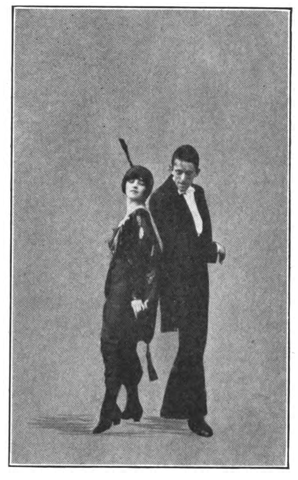
The fourth is described as "position of the hands [down by the Lead's left hip] sometimes assumed to emphasize the end of a phrase."
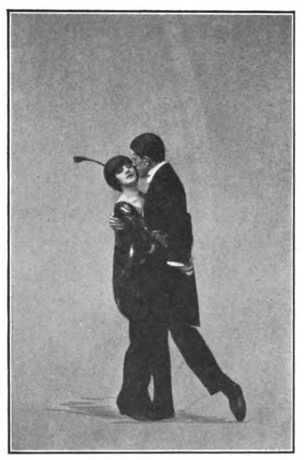
The fifth is a variation in tandem position, with the Lead behind the Follow, holding same hands and on the same feet.
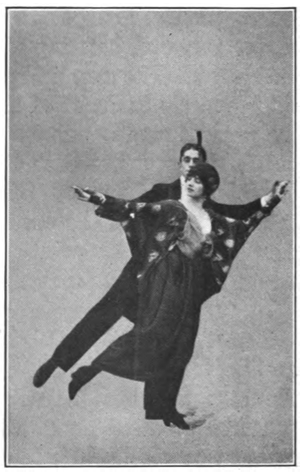
The sixth is a tango dip, similar to the style we expect today. This kind of dip was not original to the Tango, but instead, was borrowed from the Apache.
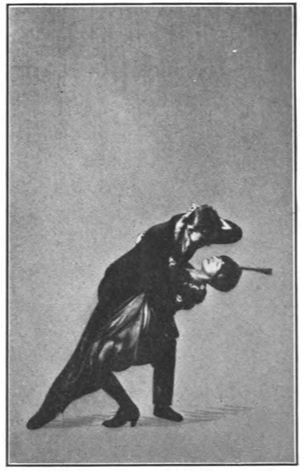
In addition to these unique variations, the historical descriptions below feature many other photographs showing the general style of the Kinney's tango.

Back the Follow with slow steps.
The lead steps forward right (1), points left forward (and), and pauses (2), then steps back left (3), and pauses (4). During the second pause, the Lead's right toe and Follow's left heel is raised.
This is similar to the Cortez, except that the Lead takes two steps back and holds for two counts, instead of taking one step and holding for one.
This is the same as the Double Cortez, except that steps 1 and 3 are cross steps, instead of straight forward and back.
The Lead crosses right over left and stays there, leading the Follow to dance the Scissors step solo.
This appears to be a simple walk in promenade position toward the hands, touching the toe to the floor before stepping on it. To return to closed position, the Lead simply rotates the Follow around in front of him.
The Lead crosses right over left, and the Follow walks forward around him until his left foot is crossed over his right.
It is usually danced following the Scissors, and it is followed by the Cortez. After the Cortez, the Follow can circle back around the Lead the other way.
This manual, like many others, notes that the Walk and the Cortez are the key elements of the tango, and if you can do them, along with one of two variations, that's really all you need. It notes that there are many other steps out there, but these can be picked up by watching talented tango dancers.
The Downes write, "Since the introduction of [Mr. Castle's 'Half and Half'], other tempos have been introduced, amongst which we may modestly mention our 'Moderation,' which is the combination of Tango and Waltz, written in seven-quarter time, combining four beats or half a measure of Tango and three beats of the Waltz. This allows the use of the single Cortez and Waltz step."
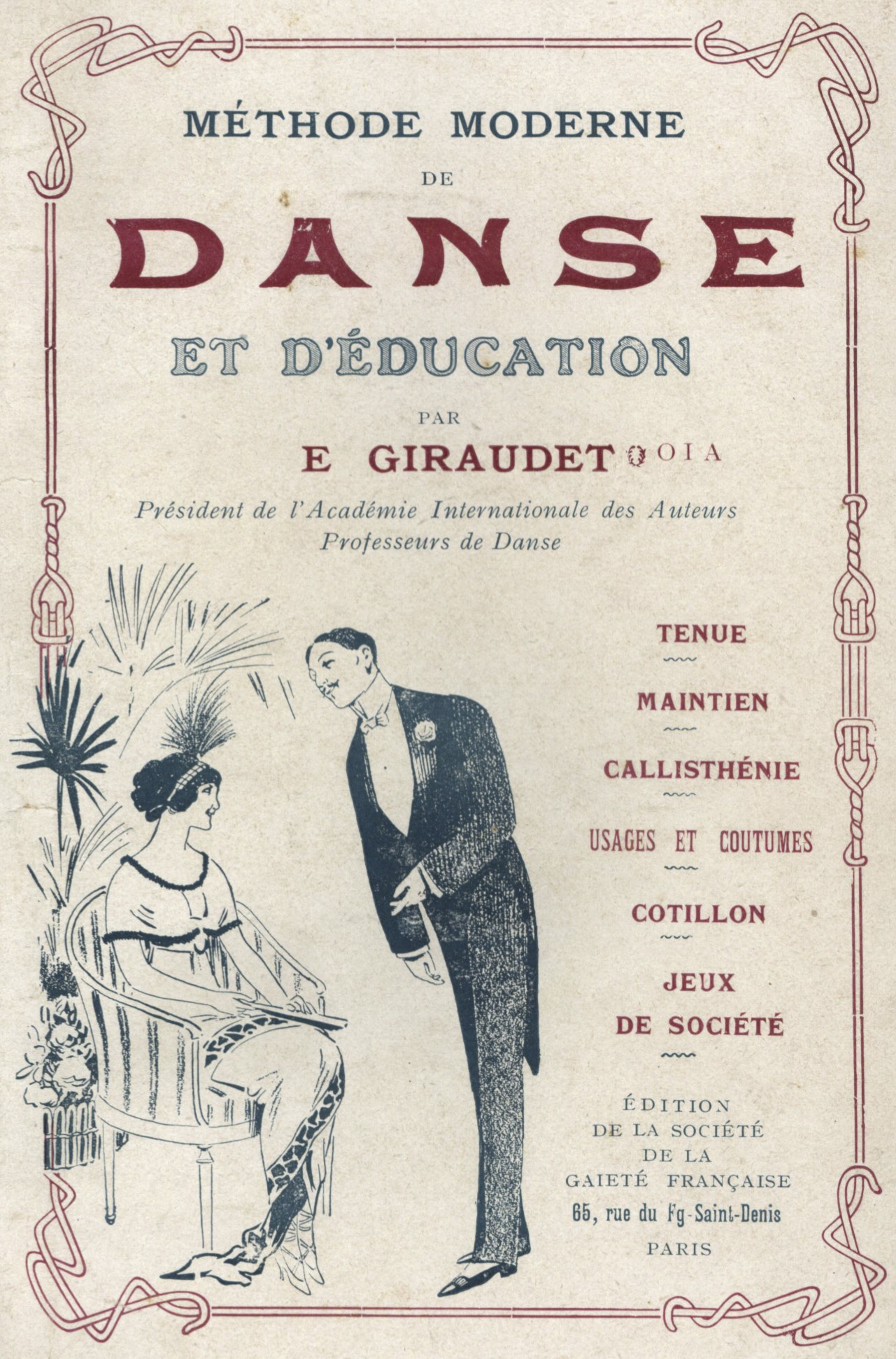
A very slow walk (2 counts per step), backing the Follow, starting Lead's right, bending the supporting knee and raising the free heel on count 2.
A slow walk (1 count per step) of 8 steps, leading with the toes, backing the Follow, starting Lead's right.
Forward right (1), forward (2), close (and), back (3), and hold (4), bending left knee and leaving right stretched straight forward. Repeat 4 times in total.
The same in reverse: back right (1), back (2), close (and), forward (3), and hold (4), bending left knee and leaving right stretched straight behind. Repeat 4 times in total.
Figures 3 and 4 can be connected with a SQQ waltz. The whole sequence is quite complex: full turn of left-turning waltz back right (SQQ, SQQ), then forward right (odd momentum), bend on right, then rock left and right. Then Figure 3 four times starting left forward. Then Figure 4 four times starting left back. Then full turn of left-turning waltz forward left (SQQ), left forward and bend, then rock right, left.
As usual, a half corte forward and back: forward, forward, close, back, back, close. The body sways forward and back, imitating the path of a hanged man: when the feet are forward, the body is back, and vice versa.
Two full sets of Four-Count Scissors with Points, starting with right crossing over left. Repeat (two full times over and back). Then four full sets of Ochos with Points, to fill 16 measures.
An Eight Count Scissors to the left and to the right is also described.
Unclear.
A Back and Forward Ocho: Cross right over left, side left, back right, cross left over right, side right, forward left. Repeat 3 more times (12 measures total).
Lead crosses right over left and pivots to unwind (finishing with left crossed over right). The Follow crosses through with him, then chassés around him in a circle, her left foot chasing her right. The figure takes 8 counts.
Forward right (1), sweep forward left (2), sweep back left (3), sweep forward left (4), sweep back left (5), sweep forward left (6), sweep back left (7), sweep forward left (8), presumably putting weight onto it to step forward out of it on count 1.
L'Eventail danced in a square, turning 1/4 every three steps.
Cross left over right (1), right over left (2) (Follow crossing behind), then rock forward left (3), back right (4), forward left (5), back right (6). Repeat these 6 counts 3 more times (24 counts total). Finish with a half waltz (SQQ, to the left), and a Medio Corte.
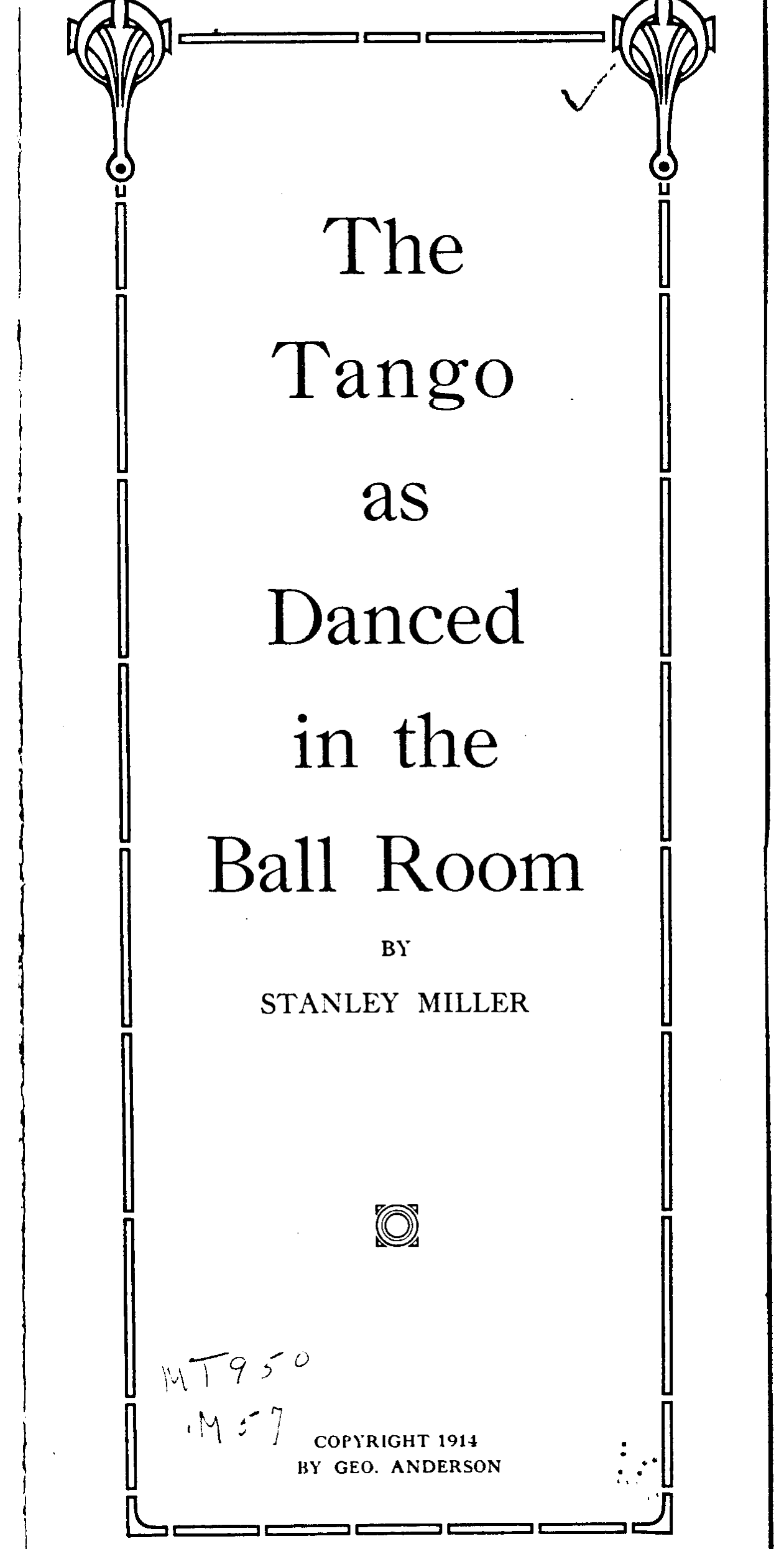
Back the Lead five steps, starting with his left foot.
Then rotate 45° to the right in two steps.
And back the Follow five steps, starting Lead's right [text says Follow's right, but diagram shows Lead's right].
Then back the Follow four steps, rotating 135° to the right, ending up to the right side of where you started, facing the opposite direction.
Finally, a grapevine to the Lead's left [exact description is unclear].
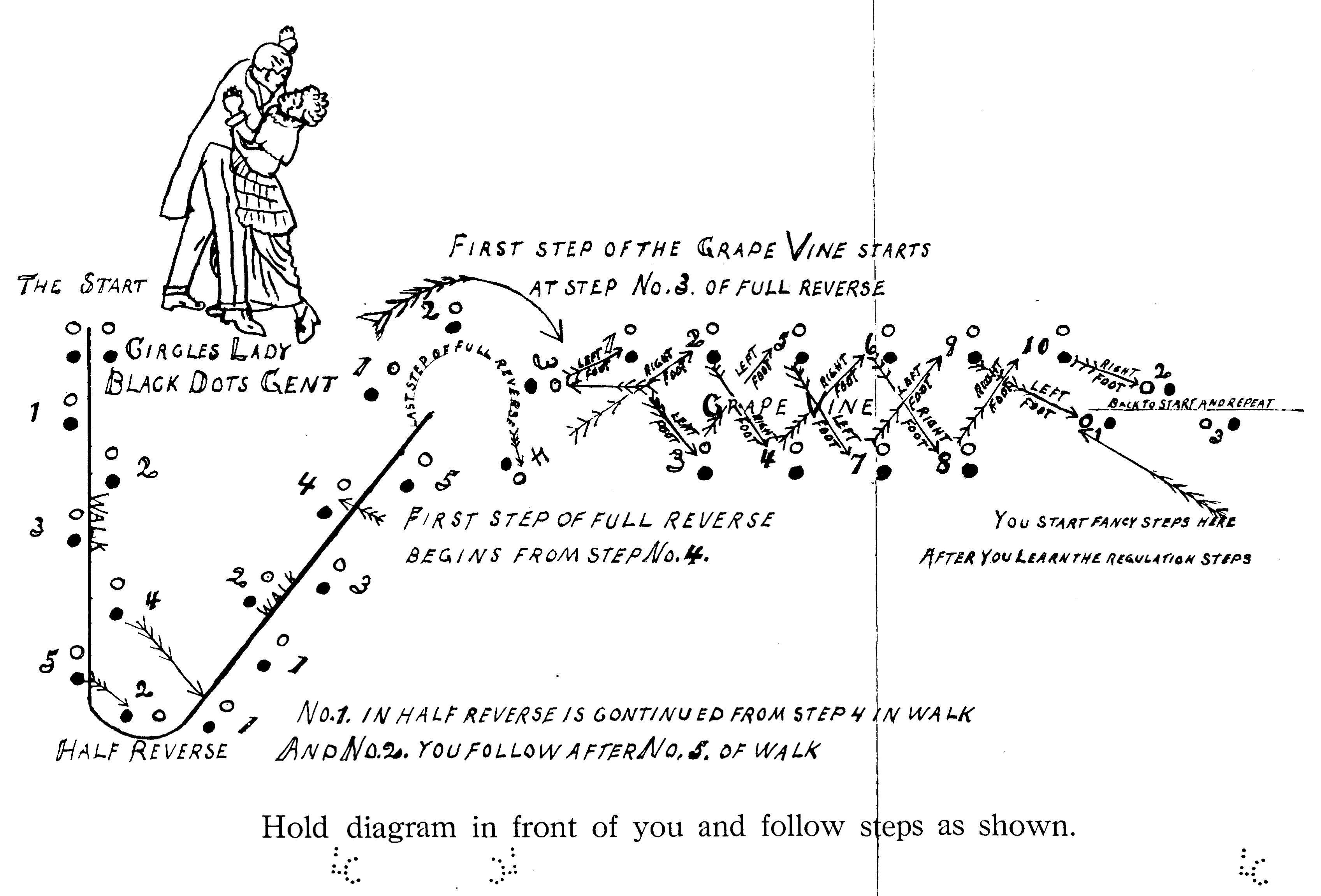
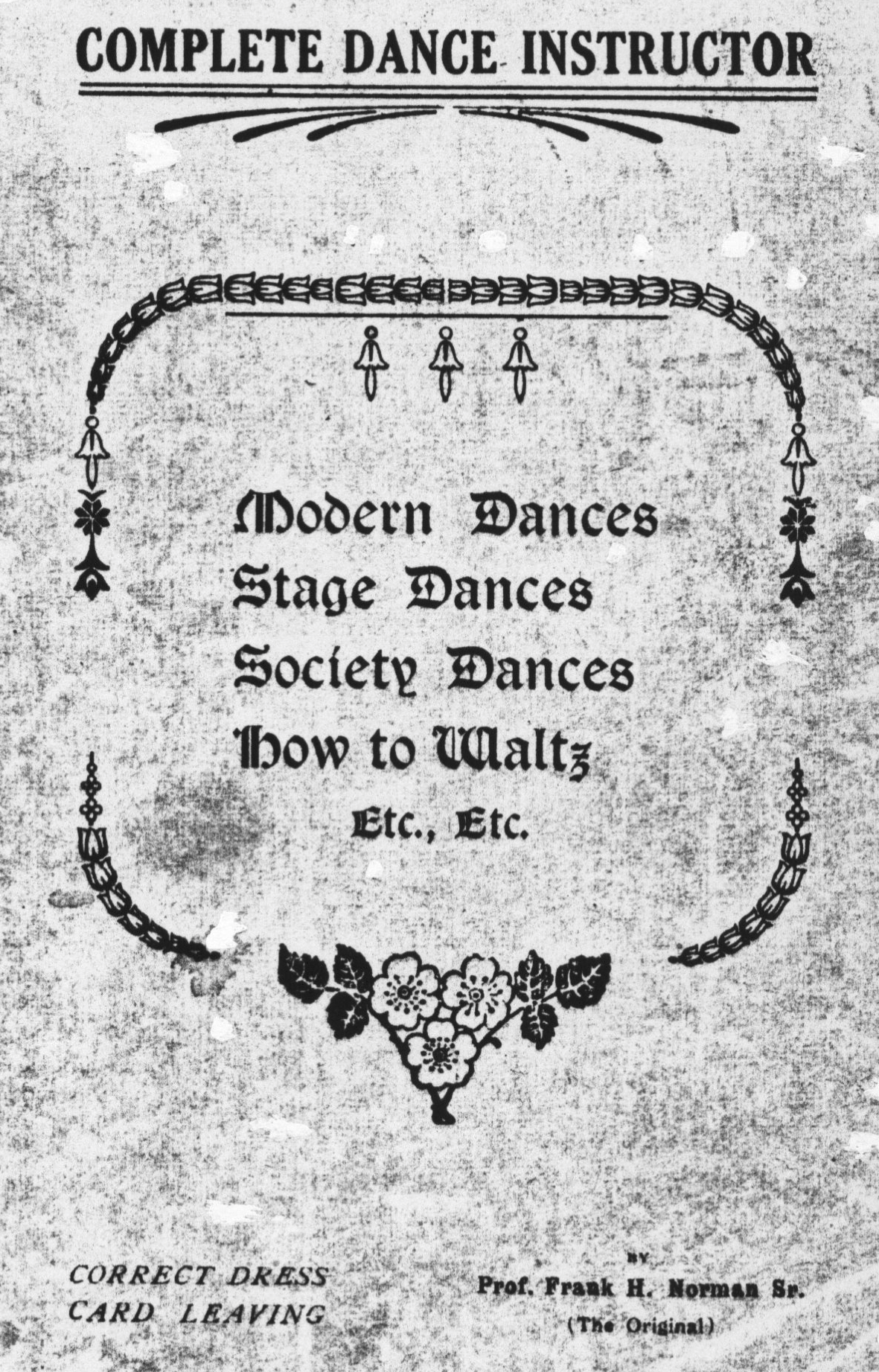
Very slow steps (two slow beats per step), backing the Follow, starting with the Lead's right foot. There is a slight up down undulation to the step, up on 1 and down on 2.
Slow steps (one slow beat per step), backing the Follow, starting with the Lead's right foot. There is a slight bend on each step, as if "walking on eggs."
Lead steps forward right (1), side left (2), close (and), back left (3), and hold (4).
Continue on to El Corté.
El Corté Backward: Lead steps back right (1), side left (2), close (and), back left (3), hold (4).
El Corté Forward: Lead steps forward left (1), side right (2), close (and), forward right (3), hold (4).
Change from Corté Backward to Corté Forward: After dancing El Corté Backward, dance a left-turning Vuelta (i.e., Reverse Waltz), backing the Lead on his right foot, in QQS timing (1, and, 2), to turn halfway around and dance El Corté Forward.
Change from Corté Forward to Corté Backward: After dancing El Corté Forward, dance a left-turning Vuelta (i.e., Reverse Waltz), backing the Follow on her right foot, in QQS timing (1, and, 2), to turn halfway around and dance El Corté Backward.
The changes can also be executed in succession (a continuously turning Vuelta in QQS timing), before stopping to dance the appropriate Corté.
In Promenade position, cross inside foot through (1), walk forward with outside foot (2), close inside foot to outside foot (and), and walk forward with outside foot (3). Repeat (4, 5, and, 6).
Variation: When stepping with the outside foot, the Lead can back around in front of the Follow, and continue traveling the same direction, but over the elbows.
The Lead steps forward right (1), side left (and), and closes right to left (2). Repeat opposite, back and to the right (3, and, 4). The Follow dances opposite.
The One-Step Cruzado: When the right foot is free, the Lead crosses right over left (1), point left foot to the side (and), and pivot on both feet to face right (2). When the left foot is free, add a side step left before the cross (1, 2, and, 3).
El Chasé plus El Cruzado: Side left (1), cross right (2), side left (and), close right (3), side left (4), cross right (5), point left (and), turn to face opposite (6), cross left (7), point right (and), turn to face opposite.
The Three-Step Cruzado: When the right foot is free, add an extra cross step (1) and side step (2) before the One Step Cruzado (3, and, 4). Or an extra side step before that if the left foot is free, dancing the Cruzado itself on 4 and 5.
Cruzado Solo: After crossing the right over left, the Lead stays in place while leading the Follow do dance the Cruzado alone. He rejoins her by mirroring her initial cross-step, sending her in front of him to his left, and dancing the last three counts of the Medio Corte.
The Lead crosses right over left (1), steps side left (2), and steps back right (3), then crosses left over right (4), steps side right (5), and steps forward left (6). The Follow dances opposite, also crossing in front.
El Ocho Argentino can also be combined with the One-Step Cruzado, for an eight-count combination.
Promenade three steps, turning halfway around on the third, to continue promenading in the same direction.
The Lead crosses right over left, and pivots in place as the Follow chassés around him.
As a variation, dance El Rueda turning to the left, followed by El Rueda turning to the right. The Follow switches directions with a Cruzado, as the Lead crosses the opposite foot in front.
As another variation, the Follow can stand in place, pivoting on crossed feet, as the Lead circles her.
In Promenade position, step forward with inside foot (1), forward with outside foot (2), and close inside foot behind outside foot (and), step back with outside foot (3), step back with inside foot (4), and close outside foot in front of inside foot (and). On 2 and 4, imitate "the movement of a floor polisher, sliding (really rubbing) the foot on the floor alternately forward and backward."
Unclear.
This is the same as Lima's Cruces de Pie Avanzando, starting with the Lead's right foot crossing in front. After four crosses, finish with a Medio Corte.
While Promenading, make an abrupt about-face by following one cross-step with another cross-step in the other direction.
Alternatively, he can make the about-face as she makes a Cruzado.
Norman gives this combination, describing it as "a musical phrase of 8 bars."
1st Part: Back the Lead four steps, starting on the left foot (1, 2, 3, 4). Balance on left foot (5, 6), balance on right foot (7, 8). Repeat, backing the Follow instead of the Lead (1, 2, 3, 4, 5, 6, 7, 8). Side, close, side to left, and pause (1, 2, 3, 4). Repeat to the right side (5, 6, 7, 8). Four Boston steps (1, 2, 3, 4, 5, 6, 7, 8).
2nd Part: Promenade outside foot (1), raise inside foot and hop (2). Promenade inside foot (3), raise outside foot and hop (4). Balance to the left and to the right (5, 6, 7, 8). Repeat (1, 2, 3, 4, 5, 6, 7, 8). Repeat the last 16 counts of Part 1.
The position is noted as "Gentleman holding lady's r. h. in his l. and both these hands placed at gentleman's back."
El Promenade: Back the Follow six steps, swaying slightly (1, 2, 3, 4, 5, 6), then make three tapping steps, as the Lead turns 1/4 to the right, to Counter Promenade position (7, 8). Then Promenade six steps over the elbows, dipping slightly (1, 2, 3, 4, 5, 6), then pass the Follow in front to Lead's right side with three tapping steps (7, 8). At the end of this part, bring the hands up to a normal waltz position.
El Corté: Forward left (1), close right behind (and), and close left behind, displacing the right (2), then step forward right (3), and hold (4). Repeat.
Media Luna, or Half Moon: Forward left (1), forward right (2), sweep left around in a half moon and back to closed, rising up on toes (3), and falling (4).
Sissonne, or Scissors: This is a Scissors, Big and Small (2x4 + 4x2) with Points, starting with the left crossing over right. When traveling to the right, bring the hands behind the Lead's back.
Tango Walk: This is L'Eventail danced in a Square. When traveling over the elbows, the hands are placed behind the Lead's back. Repeat.
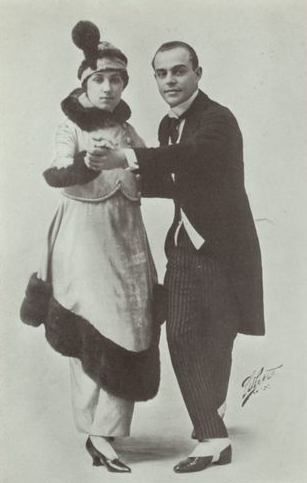
Back the Lead four or eight steps.
Back right (1), close left beside right (2), forward left without weight (3), back left (4), and bend left knee (5).
The Lead steps forward left (1), crosses right over left (2), steps side left (3), and closes right to left (and). Repeat (four times).
Not entirely clear, but consistent with L'Eventail.
The Fan or Eight Crossing (Mouvet, The Tango And The New Dances For Ballroom And Home, 1914, p. 16):
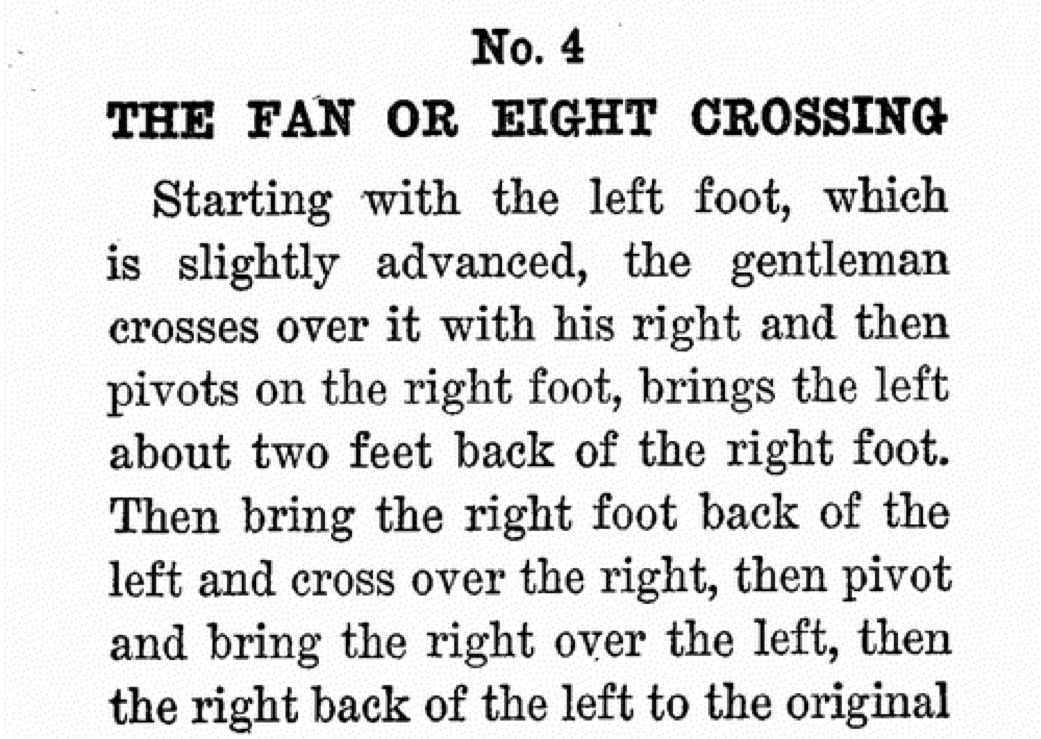
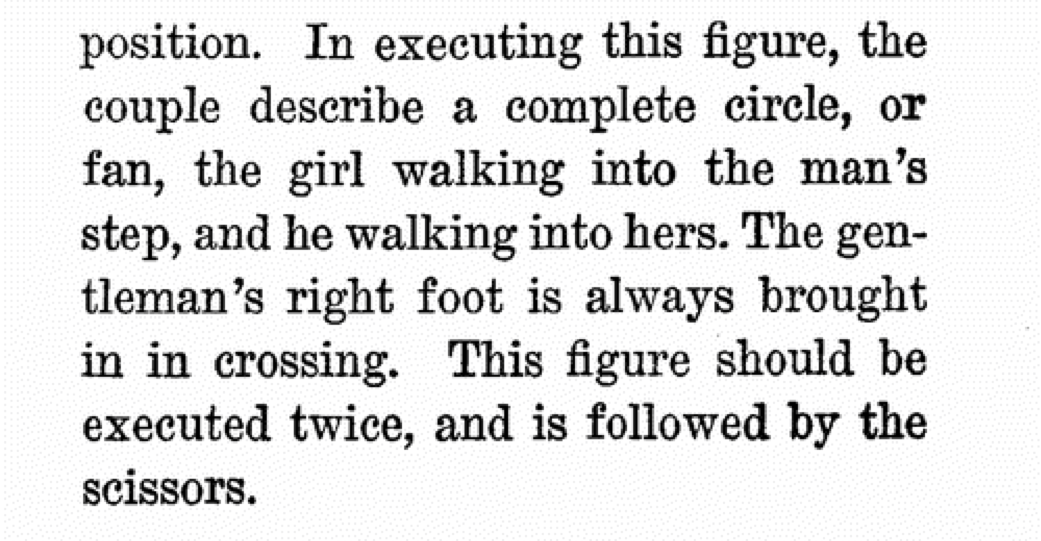
The Lead crosses left over right (1), then right over left (2), standing in one spot.
The Scissors, or Double Crossing (Mouvet, The Tango And The New Dances For Ballroom And Home, 1914, p. 17):
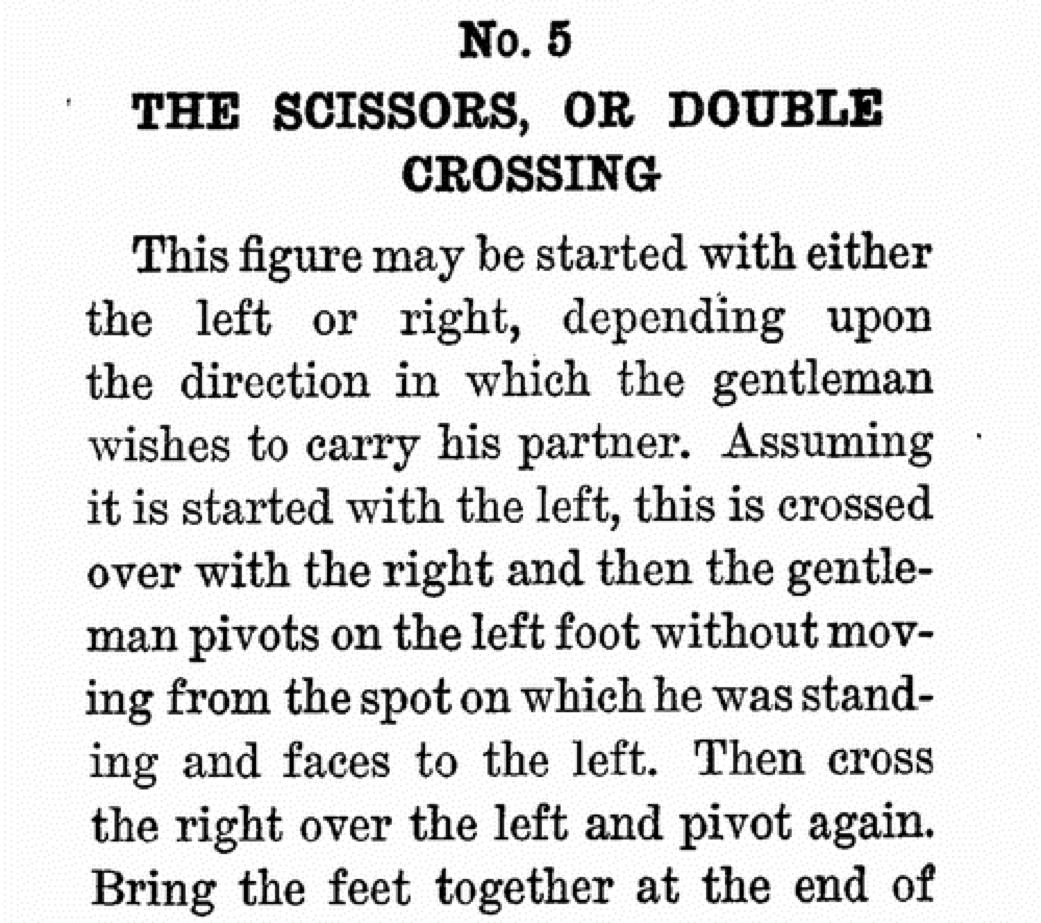

The Lead steps forward right, forward left, and closes right behind left with a heel strike, then steps back left, back right, and closes left in front of right. Timing is unspecified, but is likely SQQ.
The Half-Moon or Media Luna (Mouvet, The Tango And The New Dances For Ballroom And Home, 1914, p. 18):
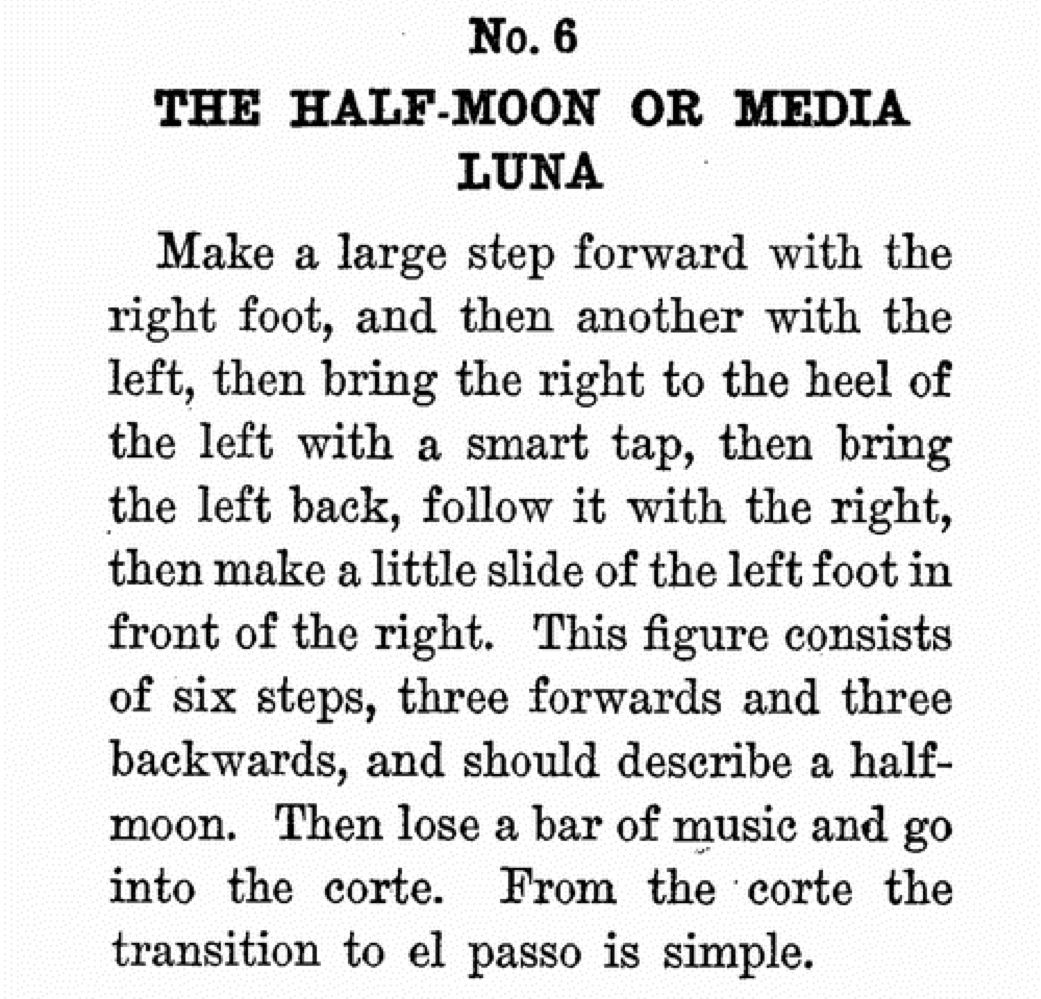
Unclear.
Unclear.
The Promenade: Back the Follow four steps, starting Lead's right.
The Half Cortez: Forward right (1), touch forward left, turning slightly to the right (2), back left (3), and hold, with Lead's right toe raised (4). Repeat twice more.
The following picture shows the "wrong position: leg must remain on floor."

Pas Chassé: Back the Follow two steps, then side close diagonally forward to the left.
The Half Moon or La Media Luna: Forward right (1), forward left (and), close right to left (2). Repeat opposite. Repeat all, then Half Cortez twice.
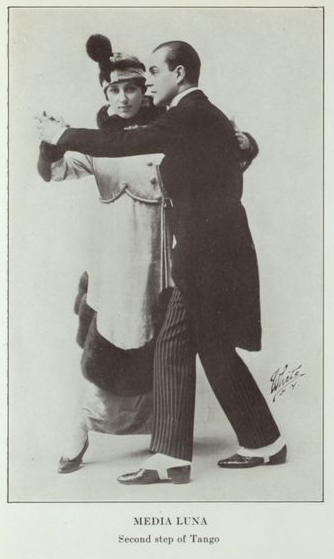
The Cortez: Forward right, diagonally forward left, close right to left, forward left, and pause. Timing is unspecified, but probably QQSS, hold.
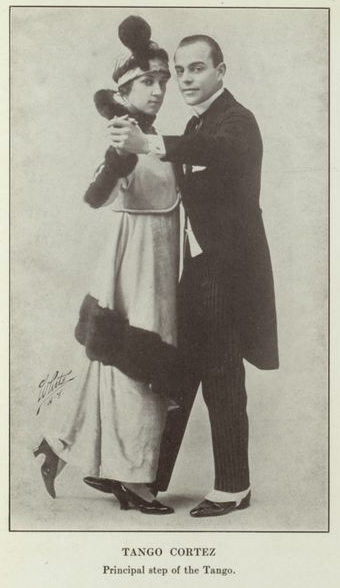

Forward right, close left to right with "a little click."
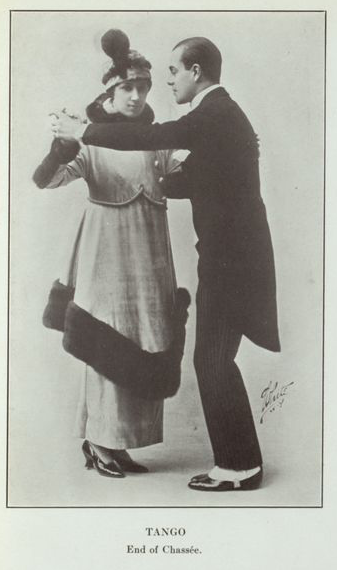
Mouvet notes that this is often replaced with the Single Three: back left, bring right slightly behind left, back left, and close with the same little click.
He also notes that the click is "taking the place of the rather unpleasant stamp that was a conspicuous feature of the Tango two or three years ago."
Cross right over left, then left over right. Repeat as often as desired.
The picture illustrating an incorrect style of kicking in the Scissors suggests there is also a correct Kicks styling.



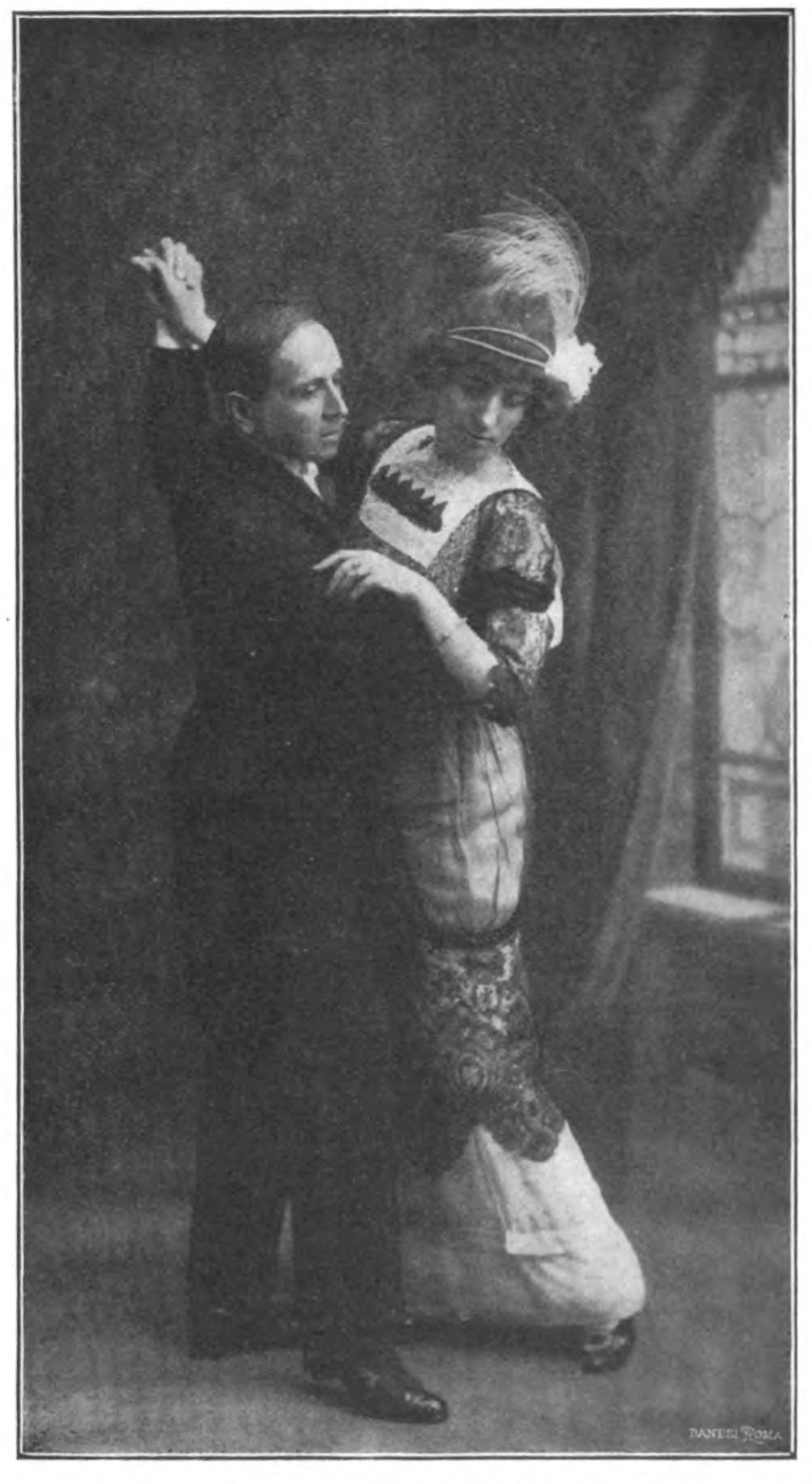
Paseo: Back the Follow four steps, starting on the Lead's right.
Medio Corte: Step forward right, side left, replace right, and back left, leaving the right heel forward to the floor, toe raised. Timing is unspecified, but probably SQQS, hold.
Media Luna: Step forward right, forward left, and cut under left foot with your right, leaning to the right, and repeat opposite. Timing is unspecified, but could be SQQ or QQS.
Unclear by itself, but based on El Cruzado (below) clearly being a four-count Scissors, this appears to be a Kicks version of Ochos.
El Corte: Right foot back, left foot close beside right, replace right in place, step back left, as in the Medio Corte. Timing is unspecified, but probably SQQS, hold.
El Valse: A left-turning waltz starting back on Lead's right. Timing is unspecified: it could be SQQ or QQS.
This is a four-count Scissors with Kicks styling, to the left, and to the right. Then do one set of El Chasé (Ochos with Kicks), and end with a Medio Corte.
La Rueda: One set of El Chase (Ochos with Kicks), then cross into a 6-count Rueda counterclockwise, and finish with a Medio Corte.
La Rueda: Half a set of El Chase (Ochos with Kicks), then cross left foot over into a 6-count Rueda clockwise, and finish with a Medio Corte.
This appears to be a turning, traveling Cross-Step Waltz, starting on the cross step, and finished with a Medio Corte.
This appears to be two steps of a promenade, plus a Media Luna in promenade position. Repeat, and end with a Medio Corte.
Unclear.
Two sets of Ochos with Kicks styling, followed by four quick Swivels and a Medio Corte.
I've yet to translate and reconstruct this source. If anyone else has, please let me know.
The Tango descriptions (in German) are reproduced below.
George W. Salinger, who claims to have traveled to Australia from the Continent only to be overwhelmed with people demanding that he teach them the Modern Dances, produced a book called How to Lead the Turkey Trot, Hesitation Waltz, & Tango in 1914 in order to compile "absolutely authentic and correct illustrations of steps, accompanied by explanatory matter, so that the reader will be able to easily acquire these much-discussed and condemned dances."
Which was a great idea, except that his descriptions (and illustrations) of the Tango are extremely odd, bearing very little resemblance to other contemporary descriptions. Even where the names are the same, the descriptions and illustrations are completely different—and entirely opaque.
In fact, we find ourselves unable to reconstruct a single variation that Salinger describes. The descriptions are so nonsensical, and some of the illustrations so strange that it leaves us seriously wondering whether Mr. Salinger was serious, or whether we was simply messing with the Aussies.
Take a look at the illustrations below, read the descriptions, and see what you think.
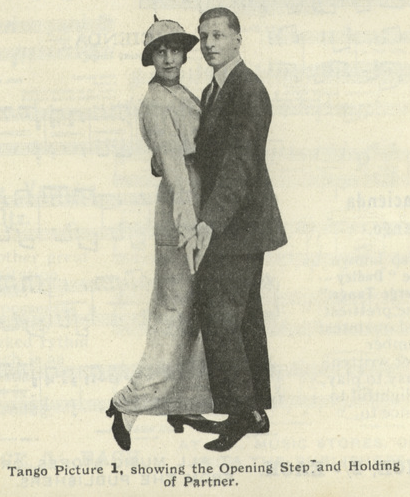
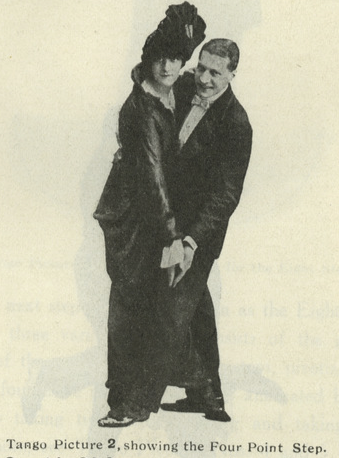
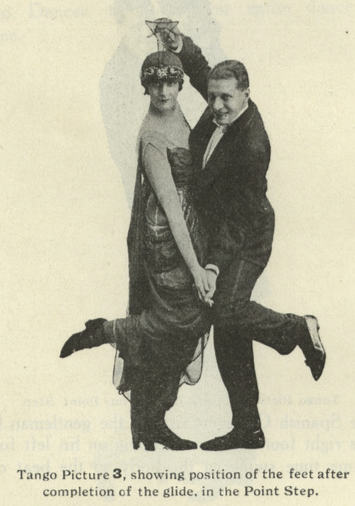
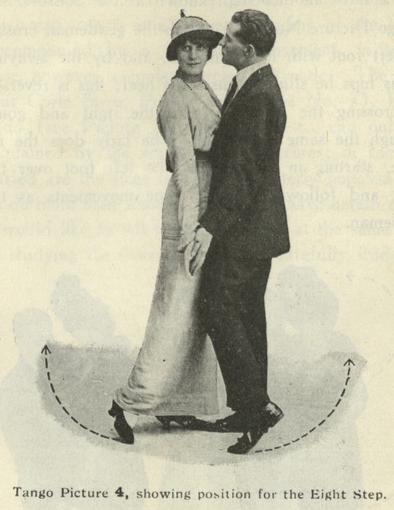
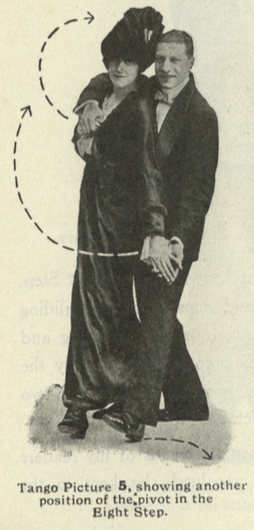
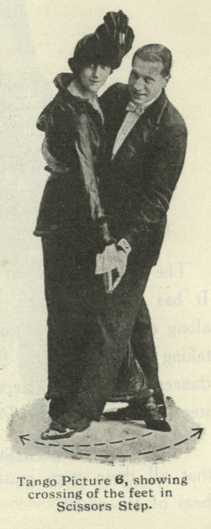
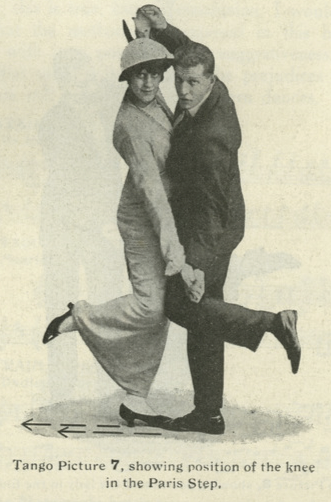
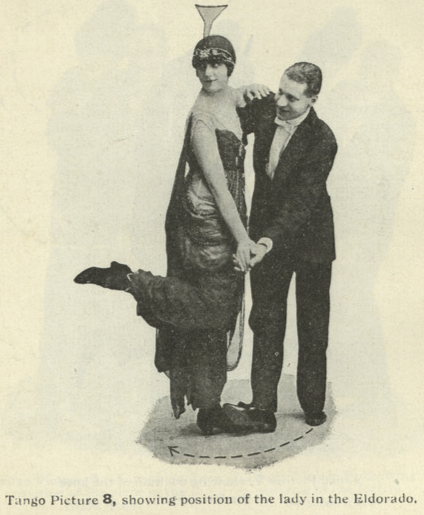
Salinger notes that "One must not forget that one must dance Ragtime to Ragtime Music, Waltz to Waltz Music, and Tango to Tango Music; one cannot dance Ragtime to Tango Music or try to dance a Tango to some of the Wagnerian operas."
For Tango music, Salinger recommends the following tunes:

These Tango descriptions were written by M. Volinen, credited as a "Parisian Dancer Par Excellence of the Leading Continental, English, and American Theatres," and published in the Pocket Tango Guide produced by Cole's Book Arcade in Melbourne, Australia.
In addition to some interesting descriptions of popular Tango variations, Volinen provides some interesting commentary on the Tango, writing:
I think the worst faults that Tango enthusiasts commit are that they do not show a sufficiently discerning judgment in selecting a teacher. There are a great many so-called Tango teachers, but many of them unfortunately only teach their own versions, with the result that the pupils find, although he or she can Tango quite excellently in the particular style in which their teacher has taught them, when they enter a ballroom they discover that their partners "Tango" in an entirely different manner, therefore, when learning the Tango it is advisable to select a teacher who follows out some popular and fixed method of initiating pupils into this most fascinating dance "craze."This is quite still relevant to Tango (and other dances) today.
You must not depend too much on the names of the steps because Parisian, English, and American exponents name them to suit themselves, and they all vary from the original Argentine name . . . Do not be disconcerted at the apparent multitude of Tango steps that you may see done. They look different, but directly you try them you will find they are very much the same. If the steps are correct they are similar wherever taught or learnt. All the variations are little tricks and inventions of different dancers.
One of the most important points to remember when doing the Tango is to dance it as smoothly as possible, also as quietly and gracefully as possible. There should be no violent movements of the arm and shoulders, all the movements must be done with the legs. There must be no jumpy steps, nor violent dips or stoops. To dance the Tango in a jerky manner is an unpardonable offence. A natural fault of a beginner is to look down to see whether he or she is moving the feet in a correct manner, but the mere action of looking down is sufficient to upset the grace of deportment which is absolutely essential to dancing the Tango. The partners should both carry themselves in a straight position. At all times you must be quite sure of your balance, that you are keeping your knees supple, and—what is very important—that you are not holding your partner too tightly. The left hand should be held with a slight arch, and the right hand should not be held tightly all the way round the lady's waist, but should rest in the small of the back, or just below her left shoulder. At all times the arms should be held loose. The whole of the movements are directed by the thumb and finger, and the Tango dance quite slowly and to the time of the music. Remember, the whole of movements must be done from the hips downward. The main responsibility of initiation and guidance rests almost entirely on the male partner for, so far as the lady is concerned, all that is required of her is intelligent anticipation.Volinen also provides this useful advise for aspiring Tangueros:
Would-be Tango dancers should take every opportunity of witnessing performances of the dance, but remember that exponents on a stage are often compelled to exaggerate the movements to obtain the desired effect, and those who base their style on movements they have seen on the stage would be well advised to subdue that style before giving an exposition of it in the ballroom.
Volinen recommends the following Tango tunes, which are "the most favoured by professional Tangoists":
The Lead places his right hand on the Follow's back, just below her shoulder, with fingers pointing downwards, giving an arch to the wrist. The Follow's left hand is near the Lead's right shoulder, resting her left elbow on the bend of the Lead's right arm. Her right hand grasps the Lead's left thumb.

Back the Follow four slow steps, starting on the Lead's right, with a heel lead.
Not 100% clear, but in the classic Northern shape: forward with right, moving to the left, and ending back on left.
The illustration shows a toe-to-the-floor style of Corte.
On the importance of the Corte, Volinen writes
Of all the figures the most important and at the same time the most characteristic is "El Corte." The pupil who has mastered the peculiar time and rhythm of this figure will have practically overcome the greatest difficulty of dancing the Tango, as it should be danced. After doing a step you always come back to the "corte." This gives the gentleman time to consider which figure to do next.
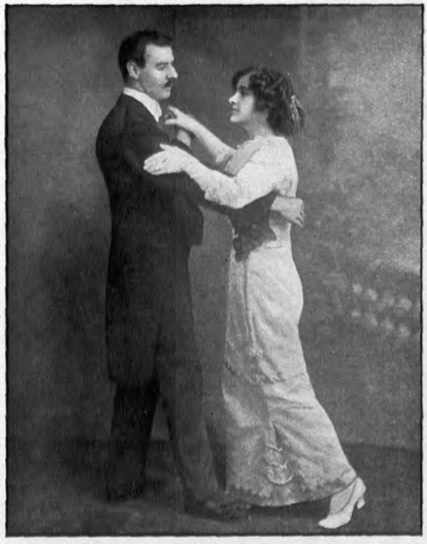
Unclear.
Not entirely clear, but a reversed version of El Corte.
The Lead crosses right over left, then left over right.
Then proceed to Back the Follow several steps and do a little dip, then back the Lead.
Point left to side, kick left heel, cross left over right, then point right to side, kick right heel, and cross right over left.
Repeat, and finish with a Corte.
Unclear, but matches the common Northern description of a Media Luna as an alternating Corte repeated forwards and backwards.
Unclear.
After a Corte, the Lead crosses right behind left, left behind right, and right over left, then leads the Follow to circle him, ending with a Corte.
Promenade three steps towards the held hands, then promenade three steps over the elbows.
Coincidentally, this is the same as an Open Ocho in SSS timing, starting on the outside feet.
Unclear.
Lead crosses right in front then side left, as the Follow crosses left behind then side right. The the Lead backs up for two steps as the Follow walks forward for two steps.
See "Note" on Barrasa's Figura del Ebrio for advice on how to make it more dynamic.
Promenade one step with inside feet, then close outside foot next to inside foot. Rise up on the toes, moving all the heels along LOD, then set down the heels, raise the toes, and move the toes along LOD. Repeat the heel and toe movements, and finish with a Corte.
The Lead steps forward left, crosses right in front of left (Follow also crossing in front), and closes up, then steps back right, crosses left in front of right, and closes up.
Then both partners make a turn, and repeat the steps the opposite way.
Cross inside feet, point outside feet to the side (along LOD) without weight, and bring feet together (outside feet close back to inside feet). Repeat.
Caroline Walker described two different dances called the "Tango." One was based on the One Step (like Bell and Johnson's descriptions), while the other was based on the Argentine Tango. While the One Step version has some steps that don't really feel like Tango, we're still including it here because some of the other steps still do.
The Lead takes four slow steps forward, followed by four slow steps backward, as the Follow dances opposite.
The steps are described as "running, slightly springy steps," made in "a slow easy run, barely lifting the feet from the floor."
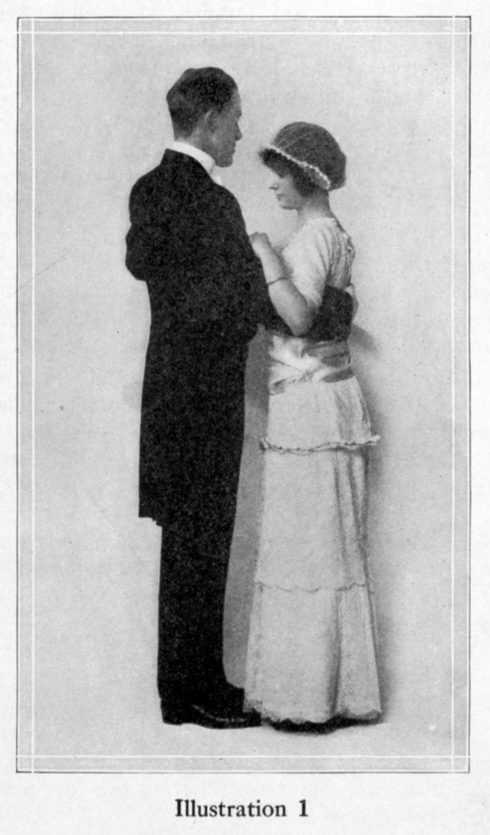
These walking steps can also be done in Promenade position.
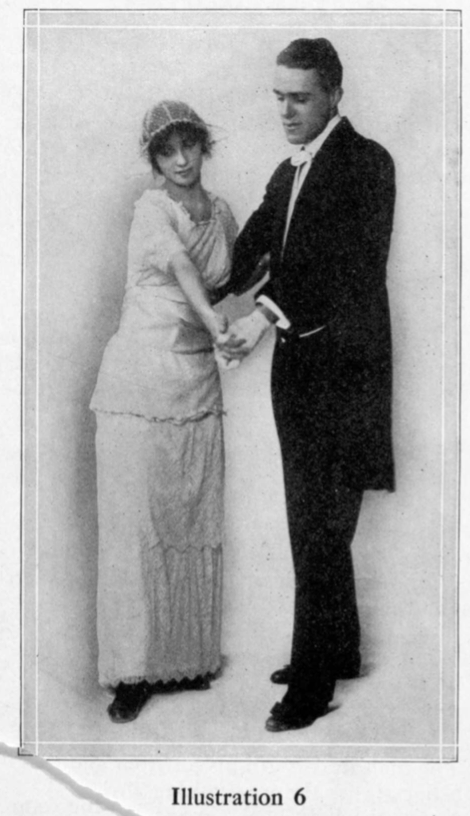
This appears to be the same as the quick version of the rocking turn in Newman's sequence tangos, turning to the left, with the Lead's right foot back, left foot forward.
You complete two full turns in eight counts.
The Lead places right behind left (1), then steps side left (2), places right in front of left (3), and steps side left (4).
Repeat three times, for a total of sixteen counts. The Follow dances parallel.


Slow side (1) and close (2) to Lead's left, with a slight sway (see illustration). Repeat three times (3, 4, 5, 6, 7, 8).
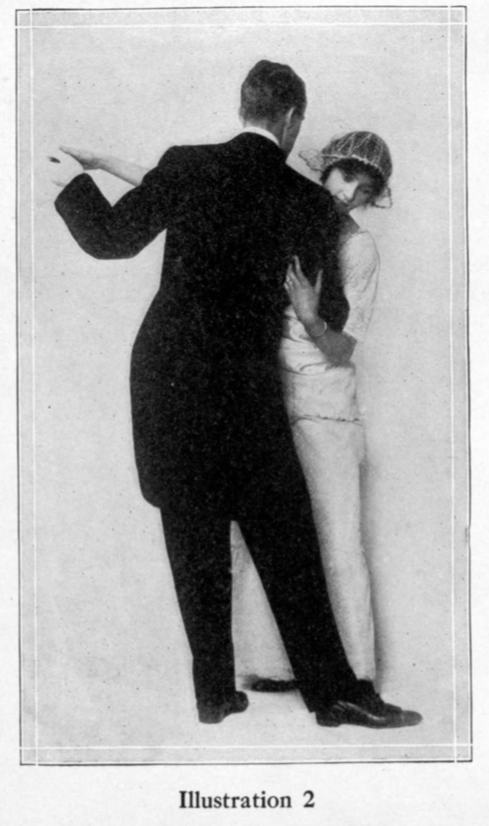
Walker proposes the following sequence of these four basic Tango steps: "Four Steps Forward and Back, Circle twice, Grape Vine, Circle twice, Draw, Circle twice and then repeat."
Part I: In Skaters' position, both take four steps forward (1, 2, 3, 4), starting on the left. On count 5, about face to Skaters' position on the other side and take three steps forward (6, 7, 8). On count 9, about face to original Skaters' position and take three steps forward (10, 11, 12).
Part II: Then step side to the left (1), dip back right (2), and repeat for ten to twelve steps.
Part III: Repeat Part I.
Part IV: Grape Vine side by side, dipping on each cross behind with the right foot.
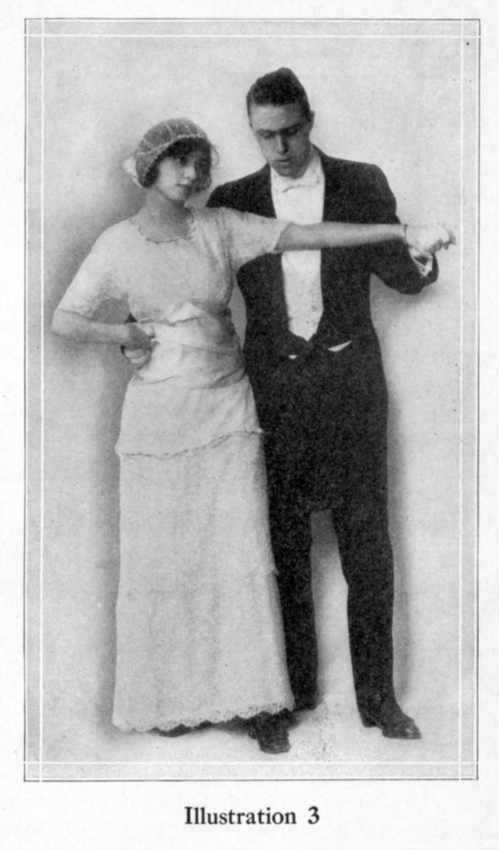
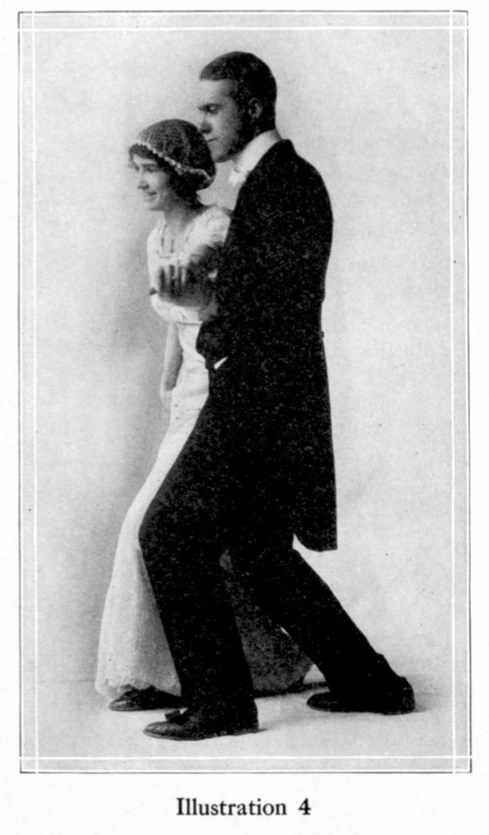
In Closed position, back the Follow four steps diagonally along LOD to the outside, then turn a quarter to the right and back the Lead four steps diagonally along LOD to the inside. Repeat, zig zagging across the room.
This can also be done side by side in double Skaters' position, both starting forward on the left foot.
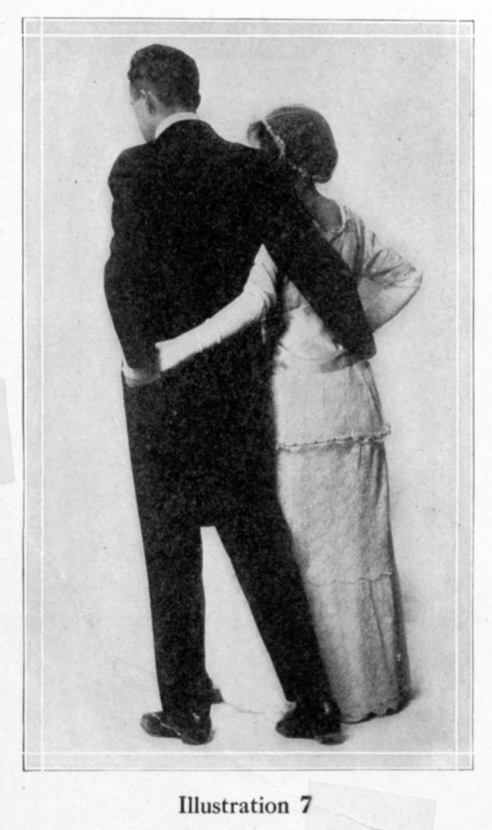
Same as the Grape Vine, but dipping on the Lead's cross behind and Follow's cross in front.
Promenade six steps in open position, then flip to reverse open position and promenade home.
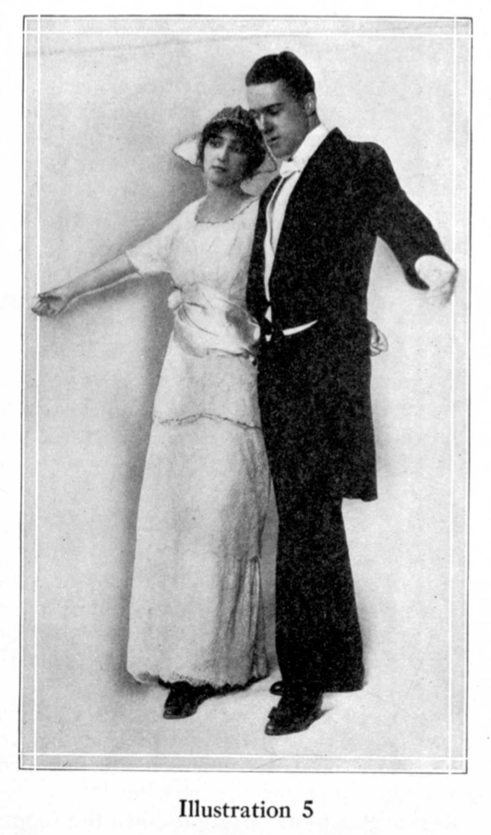
Promenade slow steps, dipping on each step of the inside foot.

In closed position, the Lead steps forward left (1), forward right (2), and taps forward left (3), back left (4). Repeat. The Follow dances opposite.
From open two hands, pull partner by, passing forward by right shoulders (1, 2, 3, 4), and back by left shoulders (5, 6, 7, 8).
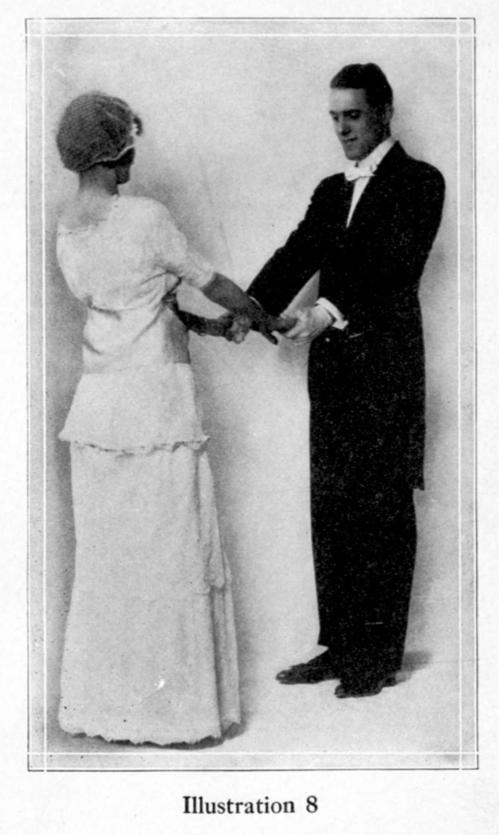
The Lead places the Follow's right hand in his right behind her back, and she rolls out to right-in-right hands. Then rolls back in to closed position.
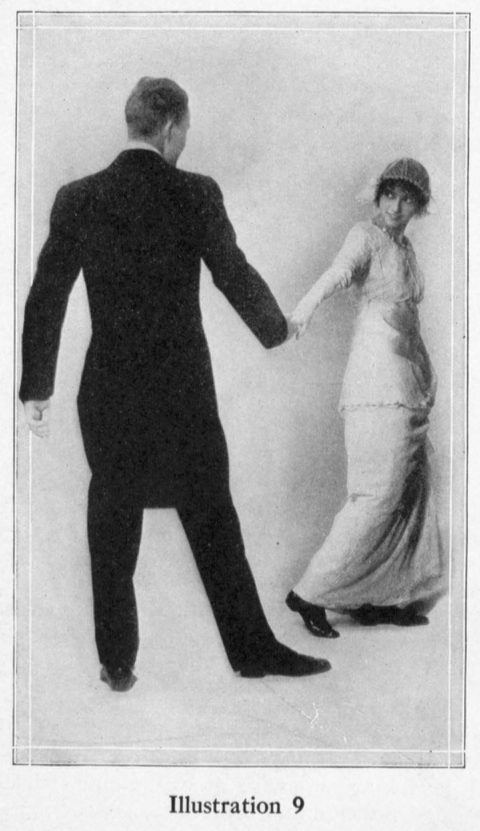
The Follow makes two complete turns under the Lead's left hand as he steps to the side beside her. Finish with a dip in closed position.
Back the Lead four slow steps, starting Lead's left, with a slightly bending motion.
Promenade four slow steps, bend on the fifth step, and straighten up and turn to face the elbows on count 6 (see illustration below). Hold 7 and 8.
Repeat over the elbows on the other foot.
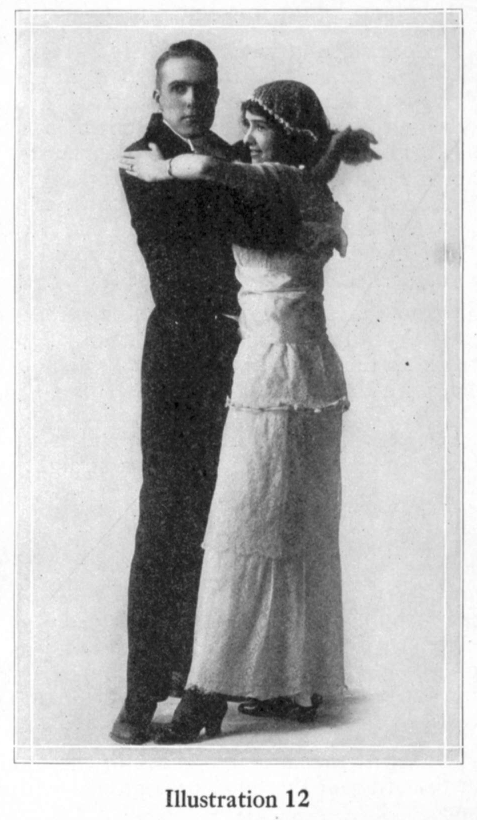
Promenade two steps, bending on the second (1, 2), then extend the outside foot along LOD pointing toe in and facing partner (3), and point toe out and face forward LOD (4).
Promenade four steps (1, 2, 3, 4), then cross the outside foot through the frame (under elbows), bending the leg and facing partner (5). Then straighten up, facing the elbows (6), and point the new outside foot forward under elbows (7). Hold (8). Repeat opposite.
Starting with inside foot, promenade three steps (1, 2, 3), then touch outside foot forward, and resting "weight on it for the fraction of a second, give a short, quick 'brush' with the toe" (4, and). Repeat opposite.
As a variation, do it in two counts, with a single cross step before the brush (1, 2, and).
The Lead crosses right over left and the Follow circles around him.
Back left (1), touch back right (2), brush back right (and), forward right (3), and bend (4).
Back left (1), touch back right (2), brush back right (and), forward right (3), point left heel forward (4). This is done with no hands (both have hands on hips).
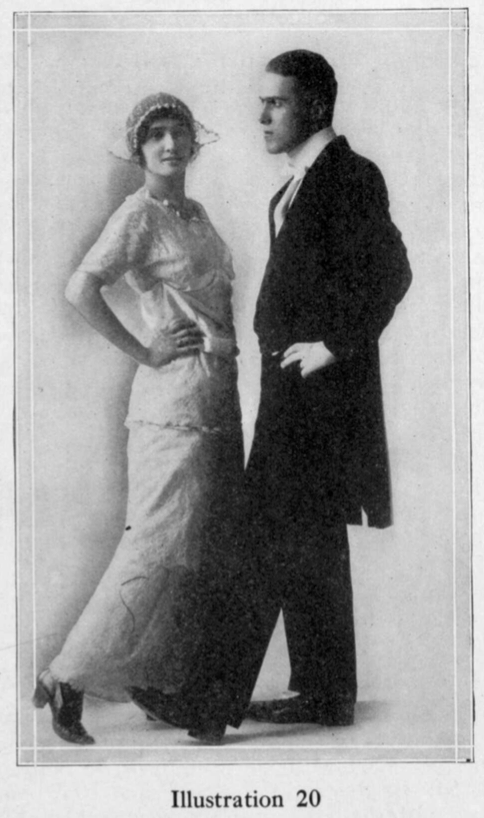
Promenade one step onto the heel of the outside foot (1), then chase it with the inside foot (taking only a very short step, not closing all the way, so the outside foot remains extended). Then promenade one step onto the toe of the outside foot (3), and once again chase it with the inside foot, but not all the way (4).
This is followed by Follow performing this step around the Lead, making a quadruple turn under his left arm as she circles him completely.
I've yet to translate and reconstruct this source. If anyone else has, please let me know.
The Tango section of the book is reproduced below.
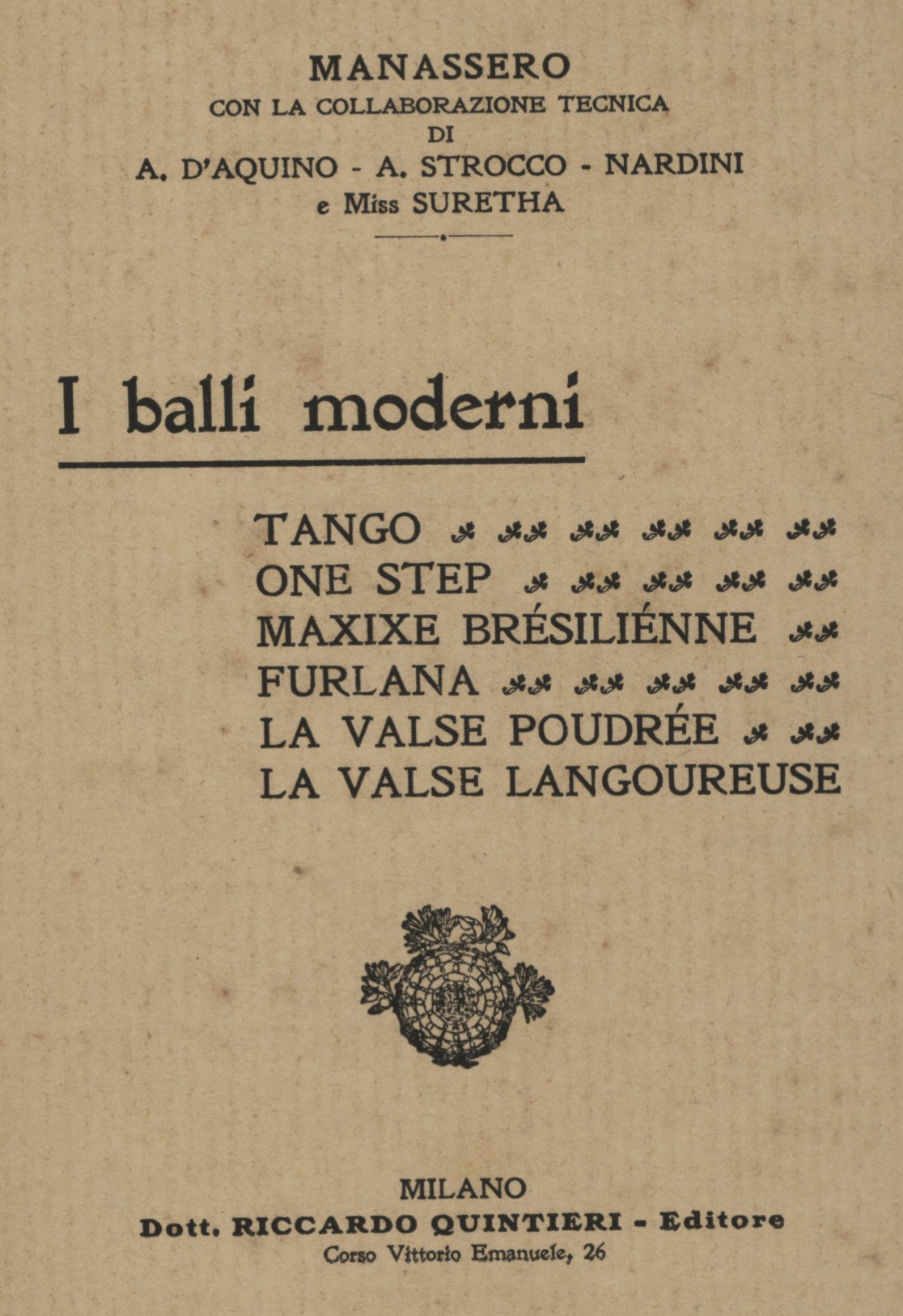
Paseo: Back the Follow four steps, starting Lead's right.
Medio Corte: Then step forward right (1), side left (2), replace right (and), back left (3), and hold (4), toe raised.
Media Luna: A QQS box step starting forward right.
Unclear.
Back right (1), side left (2), stamp right in place (and), back left (3), hold (4), toe raised. Repeat.
Then a full waltz to the left, starting back on the Lead's right, and repeat the Corte.
A Four Count Scissors with a chassé to change directions. Then more chassés (unclear) and finish with the Medio Corte.
Same as Figura 3. (Perhaps with role-reversed footwork? Otherwise it's unclear why it would be listed again.)
This is L'Eventail: Promenade three steps on outside feet, turning halfway around on the third, then repeat opposite. Then finish with a Medio Corte.
An "open" version of the Media Luna, but it's unclear exactly how. You can do it side by side in Promenade position, but that doesn't feel very good. If you ignore the "side" aspect of the Media Luna, it works: forward, forward, close, back, back, close in Promenade position.
Chassé into (and the Follow chassés through) a pivoting Rueda. This can also be done to the other side, crossing Lead's left in front.
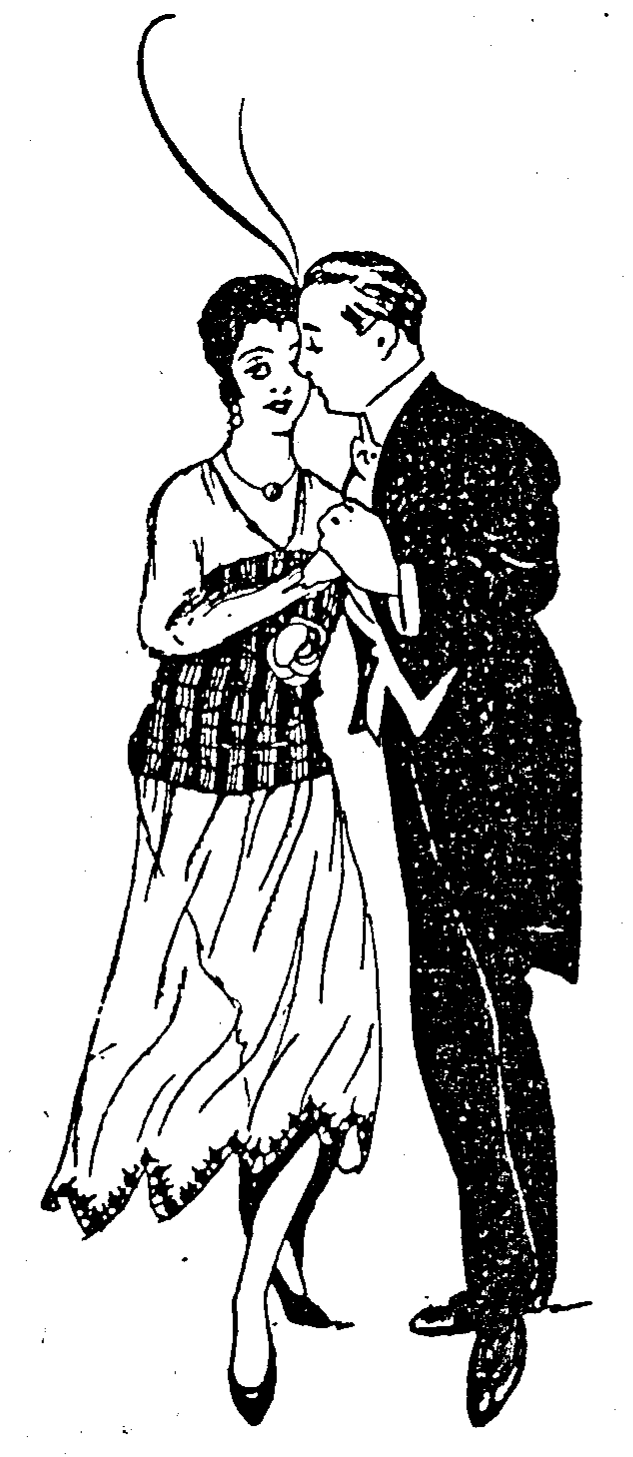
Back the Follow four steps, starting Lead's right (1, 2, 3, 4), then bring the right up next to the left without weight (5), step side right (6), close left (7), and step forward right (8). Then repeat forward right (8), forward left (9), close right next to left without weight (10), side right (11), close left (12).
Then step forward left (13), close right beside left with weight (14) [pausing for a moment, 13 and 14?], side left (15), close right with weight (16), and back into Corte pose, Lead's toe raised (17), hold 2 counts, and step forward left out of it (18).
Another version of the Corte has forward right (1), forward left (2), replace right (3), back left (4). No hold is specified, which makes this a Follow-backing double hesitation.
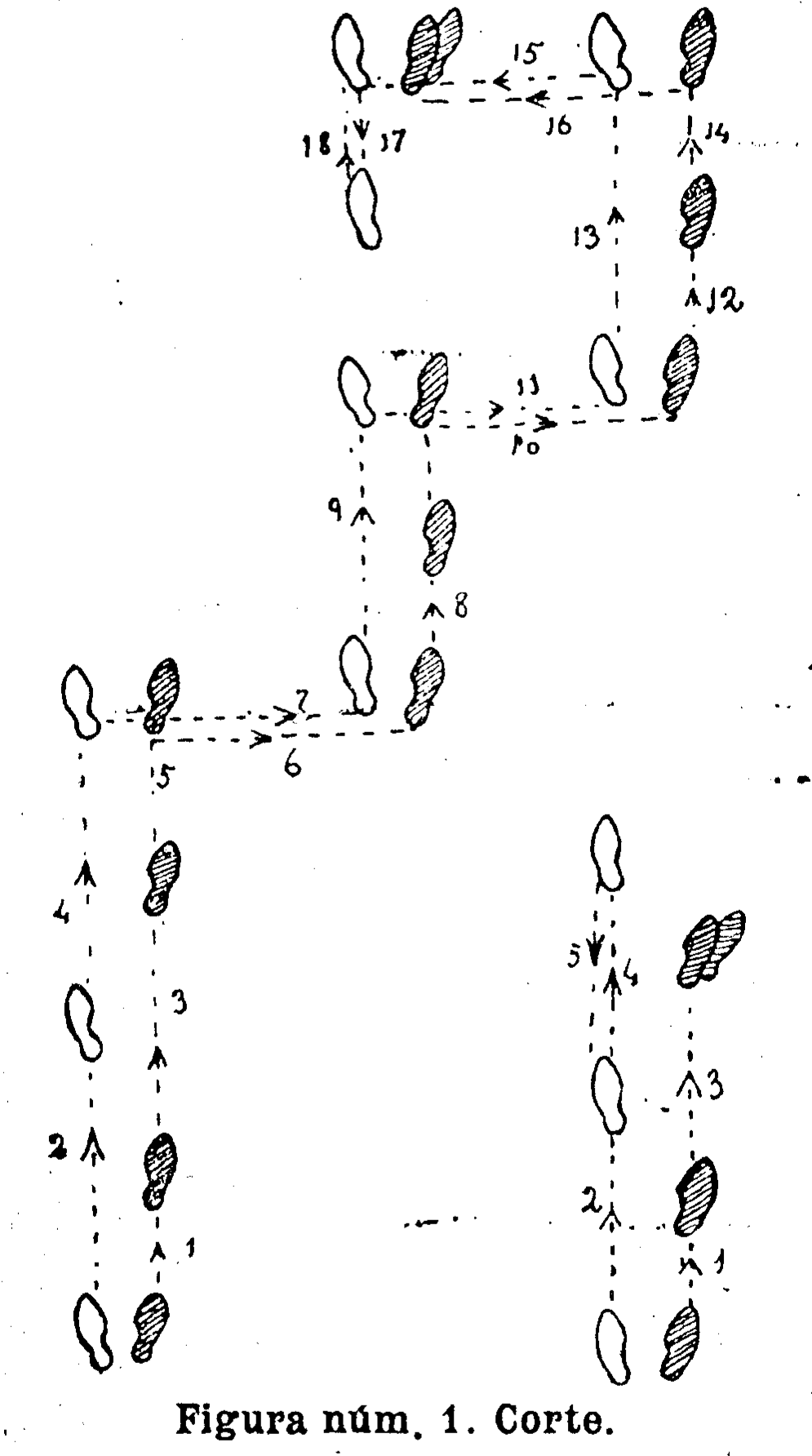
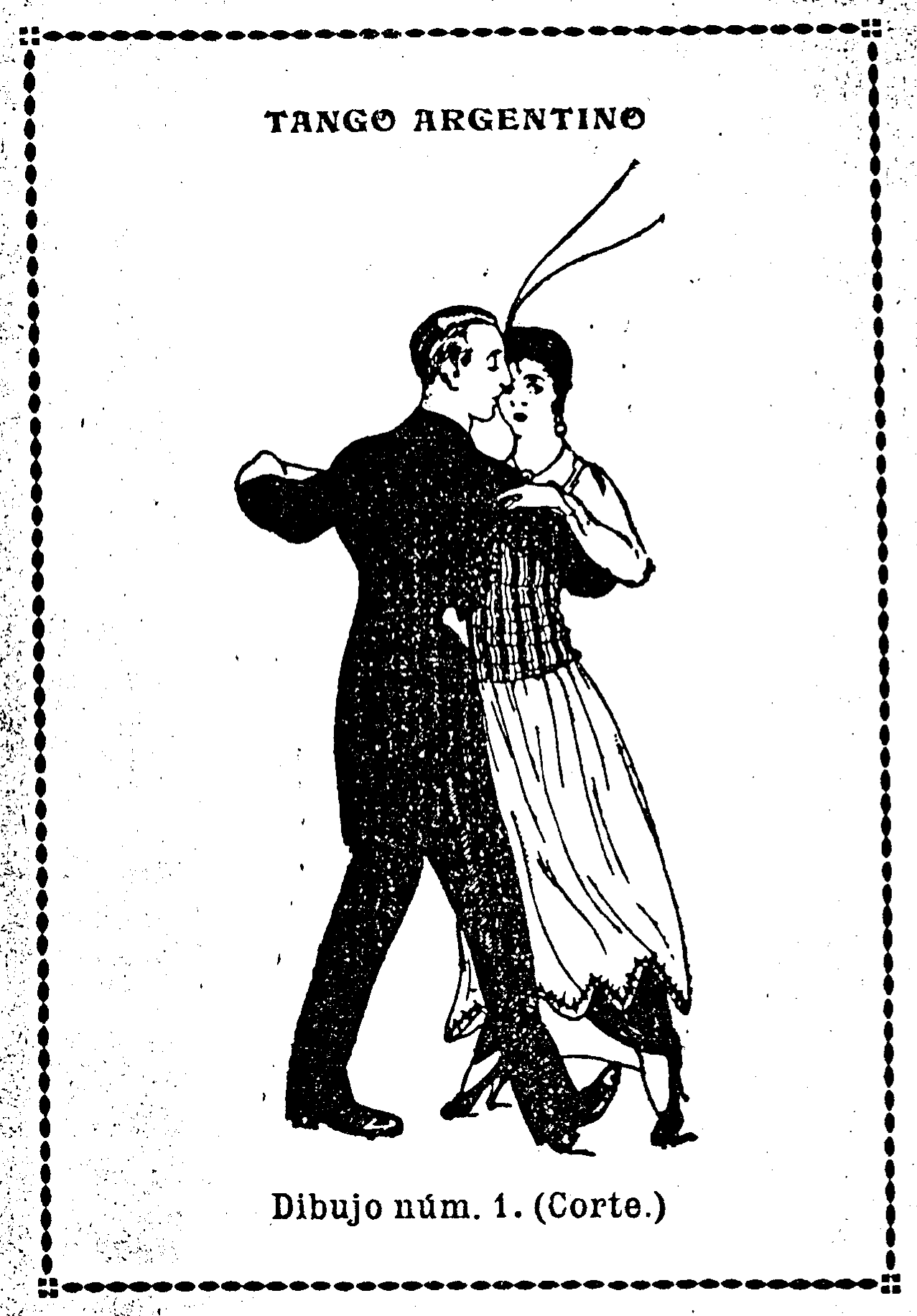
This is a Four Count Scissors with Points followed by a Two Count Scissors with Points, leading straight into a Rueda. The Follow circles him, crossing the left in front of the right repeatedly. Then finish with a Corte.
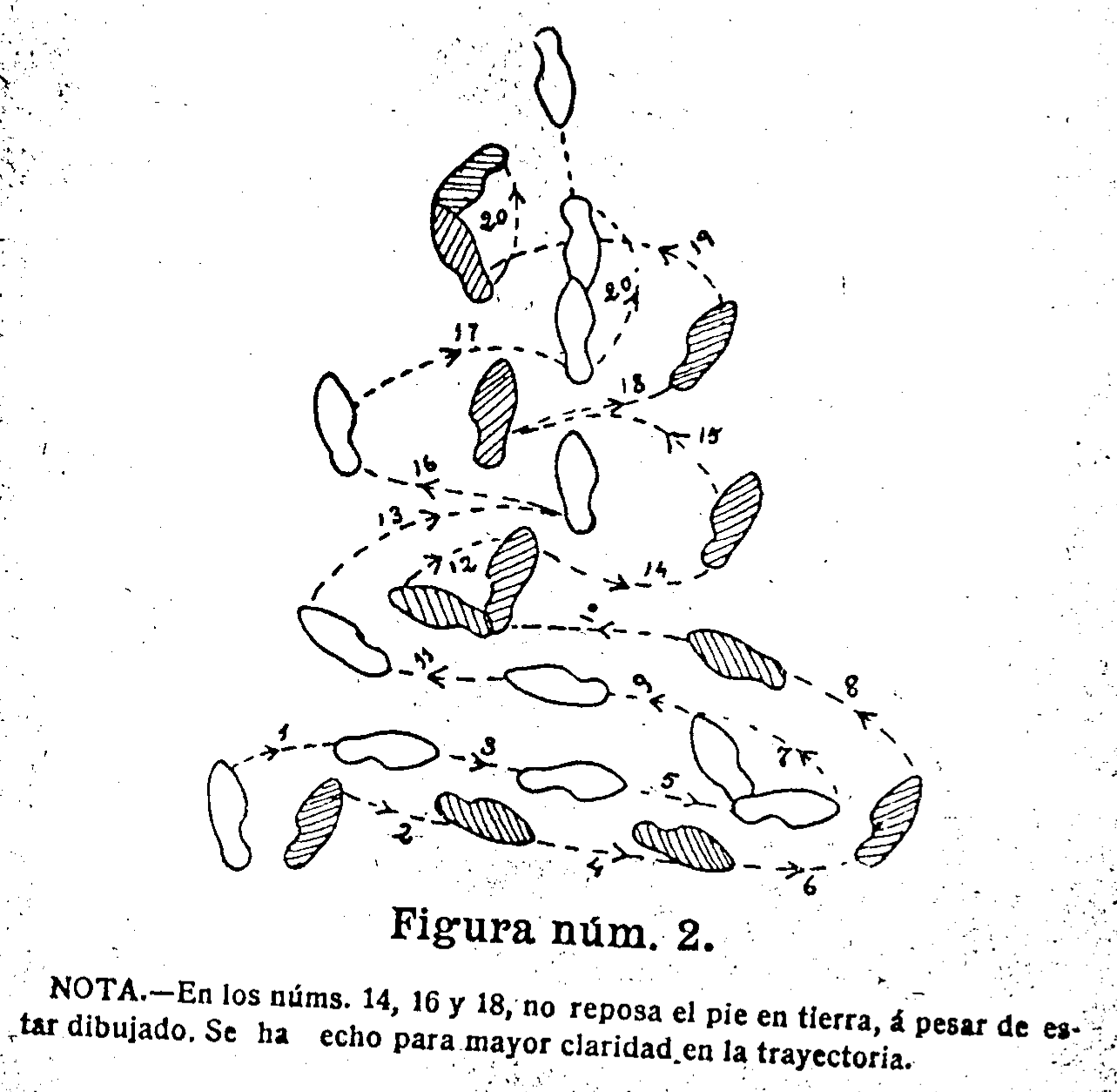
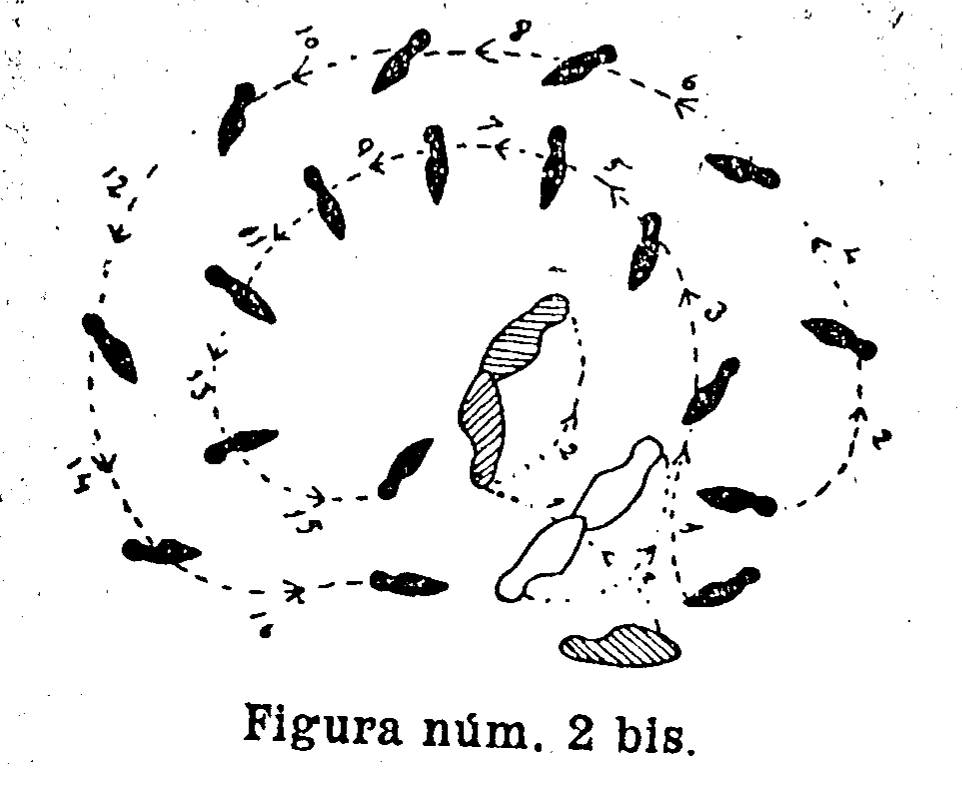
Cross inside foot through, facing partner (1), then open up to point side away from partner (2), and close outside foot beside inside foot, facing partner (3). Repeat 3 or 4 times, then repeat opposite, crossing the outside foot through under the elbows.
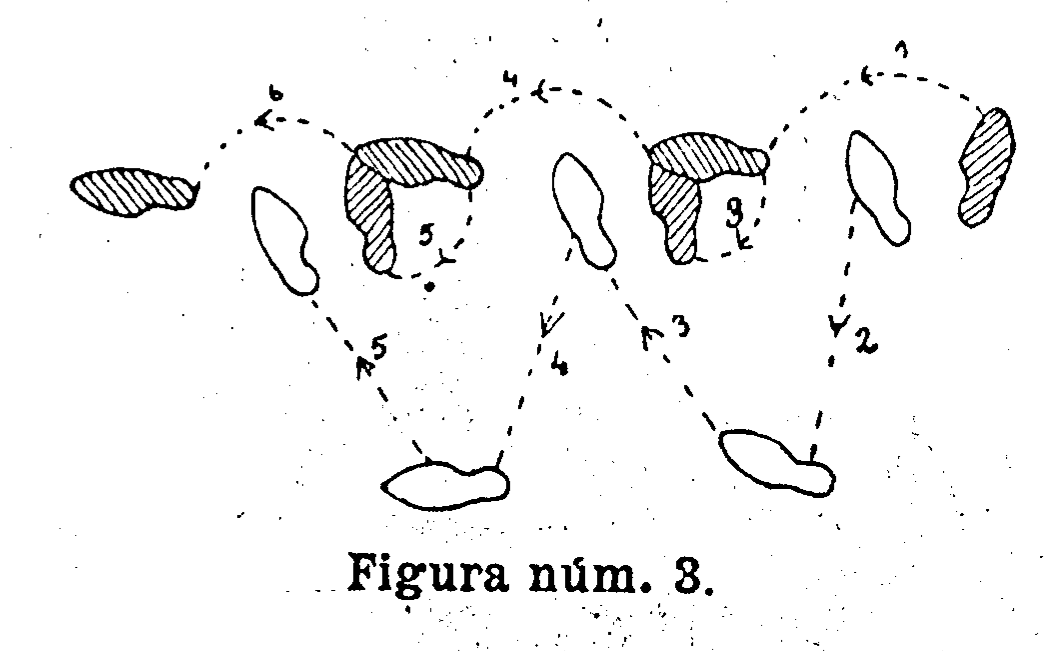
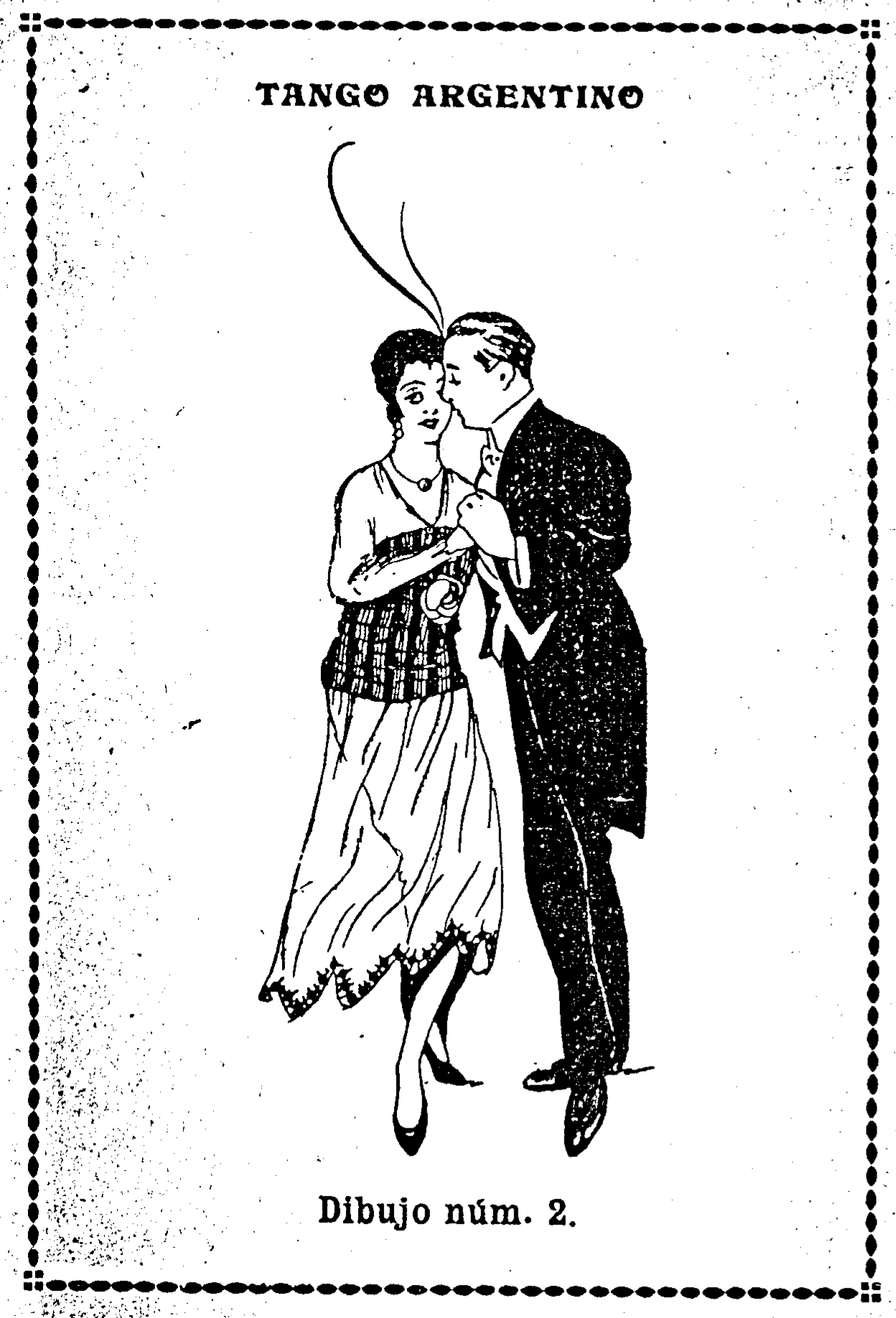
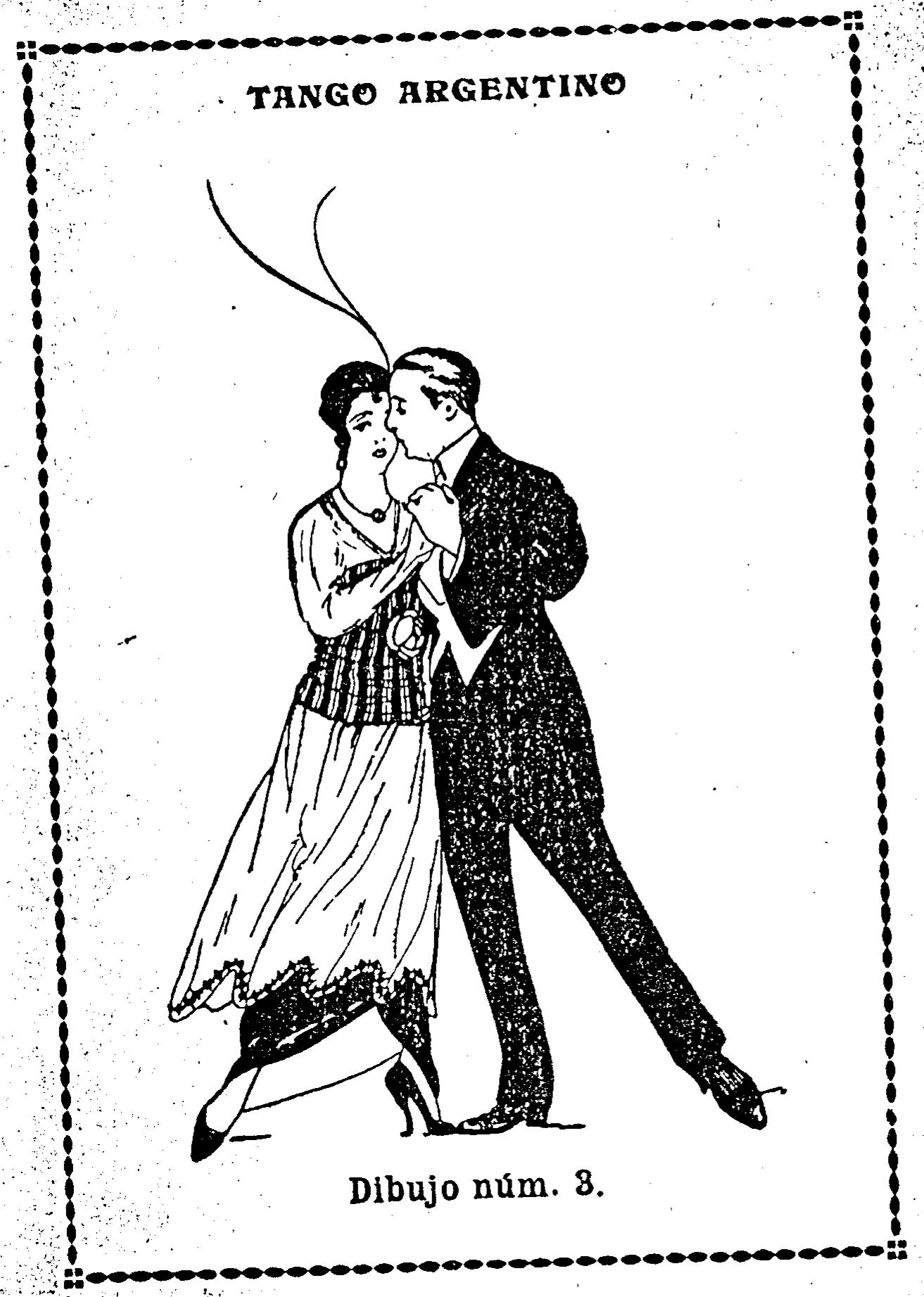
The first six steps are a crossed box similar to a Lima Media Luna. Cross right over left (1), diagonally side/back left (2), close (3), cross left behind right (4), diagonally side/forward right (5), close (6). Then promenade for a bit and start the figure on the second half, and finish with a Corte.
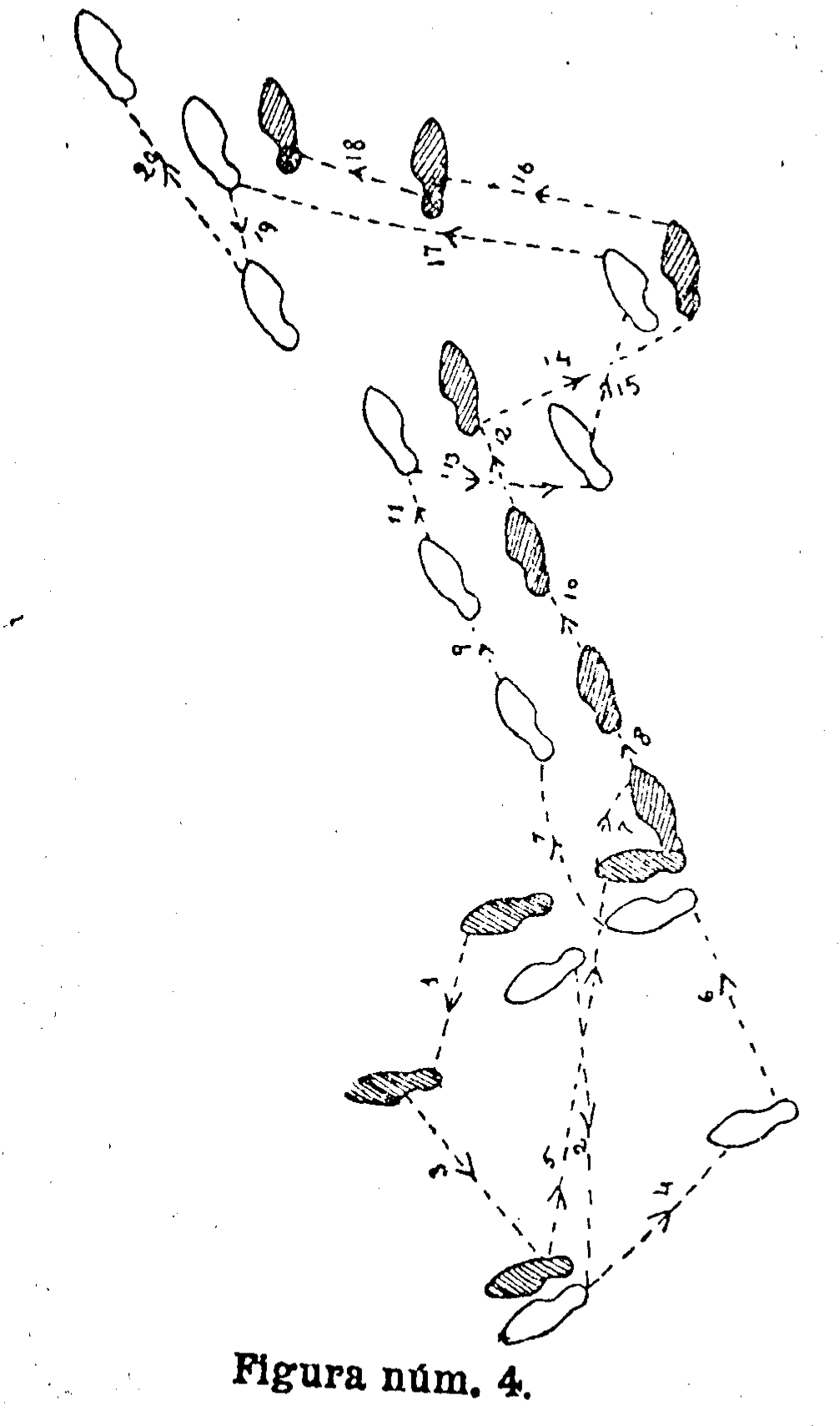
This is non-crossing version of Crozier's Sheaves: forward right, point left (pivoting on right), forward left, point right (pivoting on left).
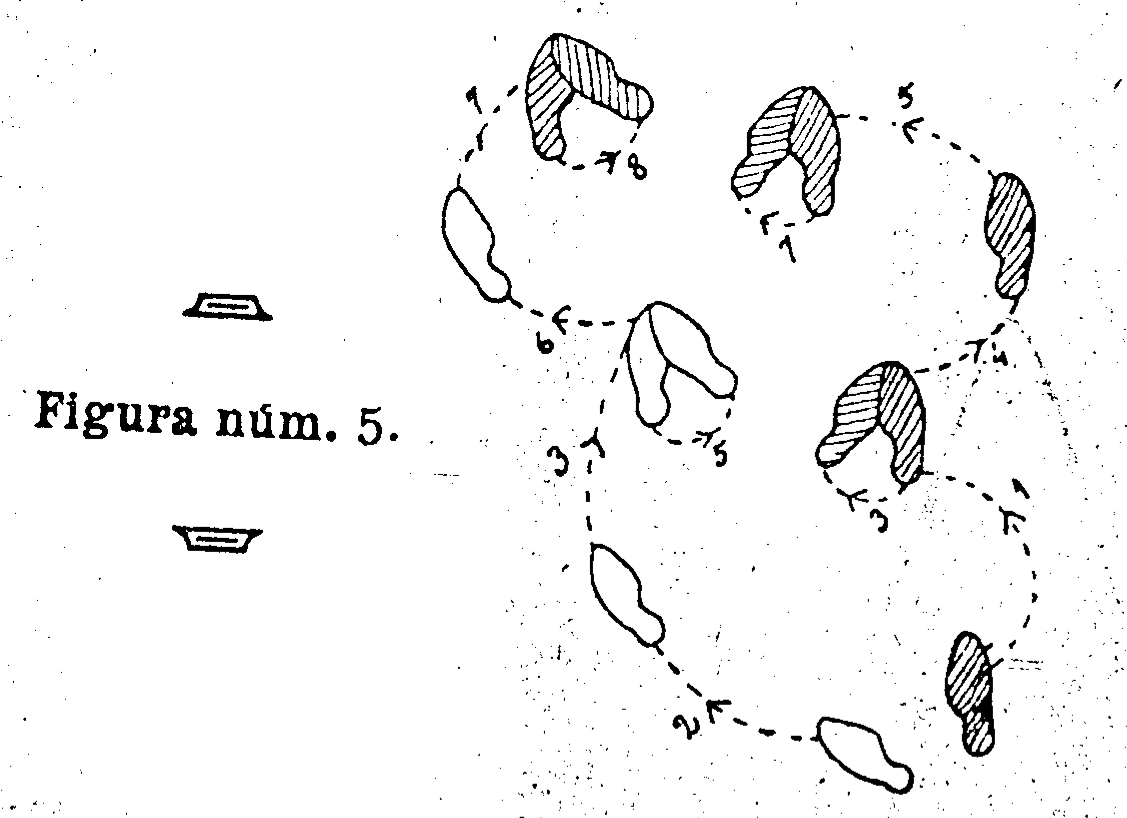
This is a double hesitation traveling to the left (as in Lima's Paso Pique), swiveling the elbows side foot as in La Criolla. The heel moves LOD on the rock forward, and the toe moves LOD on the rock back.
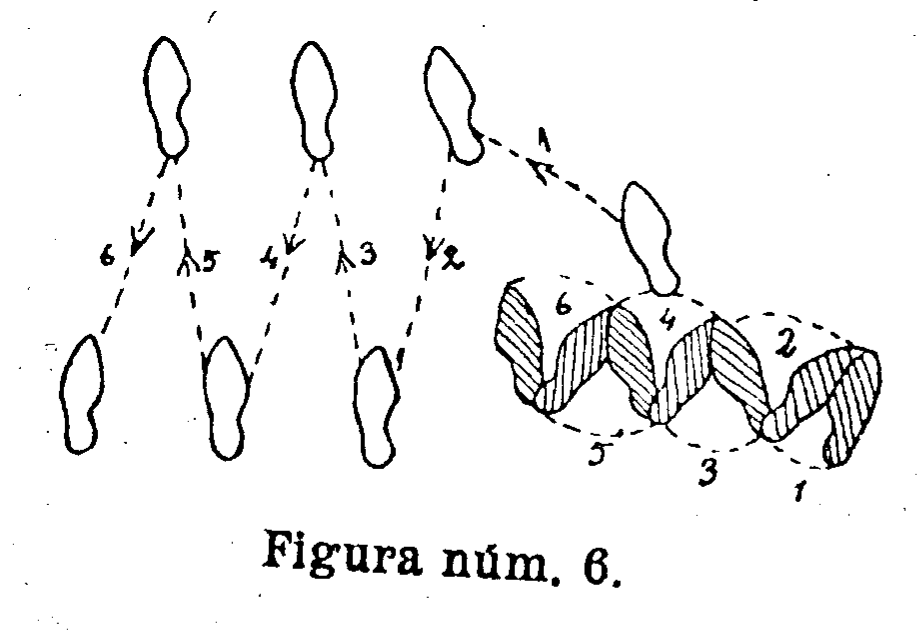
This is a Ragtime sequence dance, described as being in Tango time. There are four parts of four slow count each.
Part A: Four gliding steps forward for the Lead, starting on the left, as the Follow steps back four gliding steps, starting on the right.
Part B: Four pivot steps.
Part C: Four grapevine steps.
Part D: Four pivot steps with slight dip - Lead balancing backward.
Sheafe provides two opaque descriptions of short "Tango" sequences, both of which rely heavily on the Two-Step.
Unclear.
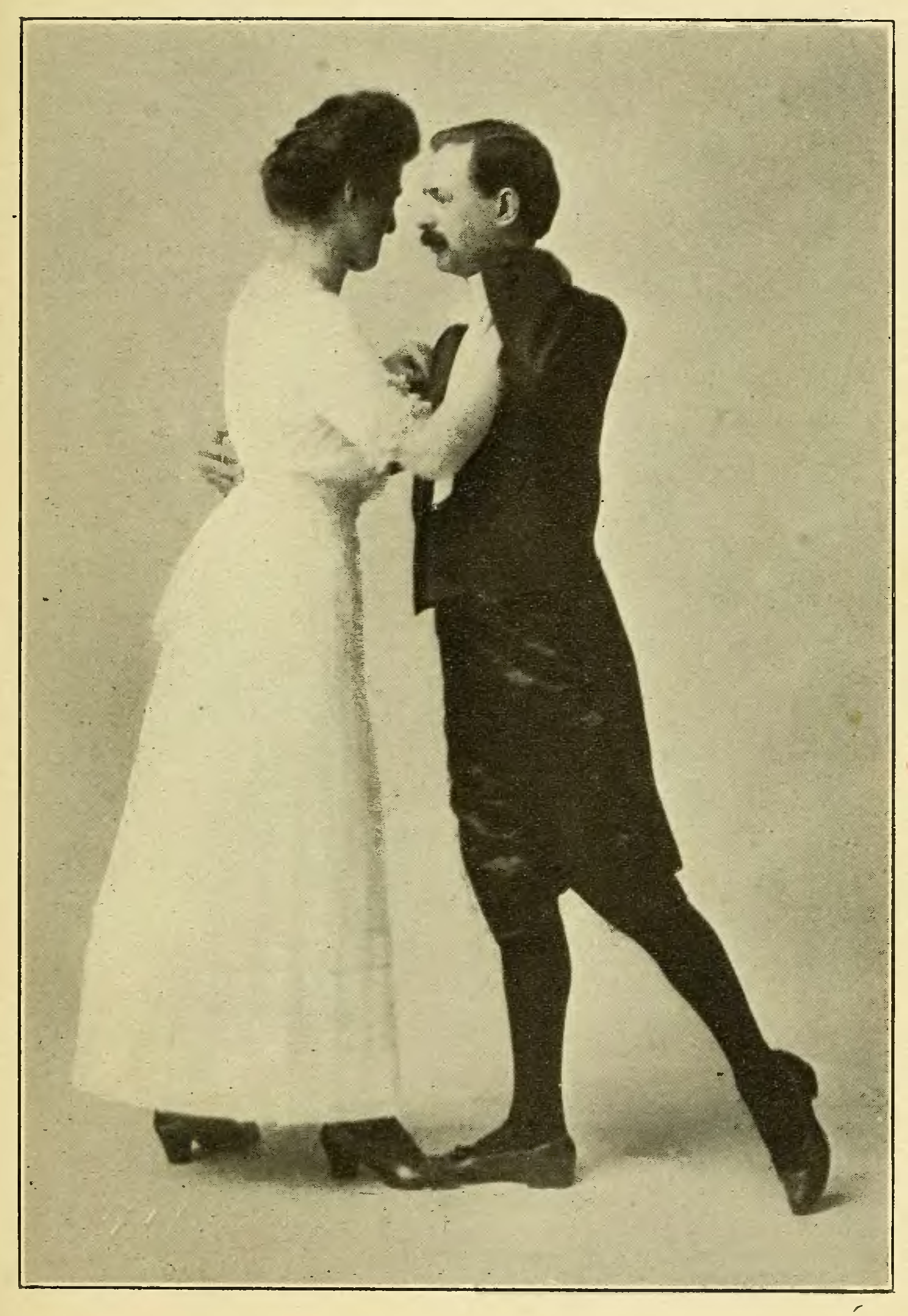
Unclear.
This is an easy, 16-count* tango sequence described by F. Leslie Clendenen of St. Louis in 1914.
Closed position.
Start with the Lead facing back against LOD, Follow along LOD.
Part I - Back the Lead (4 counts): Back the Lead four steps along LOD (1, 2, 3, 4).
Part II - Swirl (4 counts): A four count rocking turn to the right in closed position (5, 6, 7, 8). The Lead steps back left in front of the Follow, as she steps forward toward him. Then they rock back and forth three times, turning to the right. Rotate 3/4 of a turn in total, to have the hands pointing along LOD.
Part III - Draws (4 counts): Step side along LOD (1), draw trailing foot closed to it (2). Repeat (3, 4).
Part IV - Grapevine (4 counts): Lead steps side left (5), cross right behind (6), side left (7), cross right in front (8).
Repeat from the beginning.*
* Reconstruction Note: This is an abbreviated version of the whole sequence, the description of which is clearly missing something. After the four-count grapevine, Clendenen says to repeat it (5, 6, 7, 8), but at that point, it should be (1, 2, 3, 4). After the repeated grapevine, there's a repeat of Part III, followed by a repeat of Part II, before it all starts over again. But that's only 7 sets of four counts, for an odd 3.5 phrases of music. Given that there's nothing new in the second half, it seems reasonable simply to cut it out, and repeat everything from the beginning. Oddly, even though the page was re-typeset, this error wasn't fixed in the late 1914 edition.
Tango No. 1 (Clendenen, Dance Mad [Early 1914 Edition], 1914, p. 62):
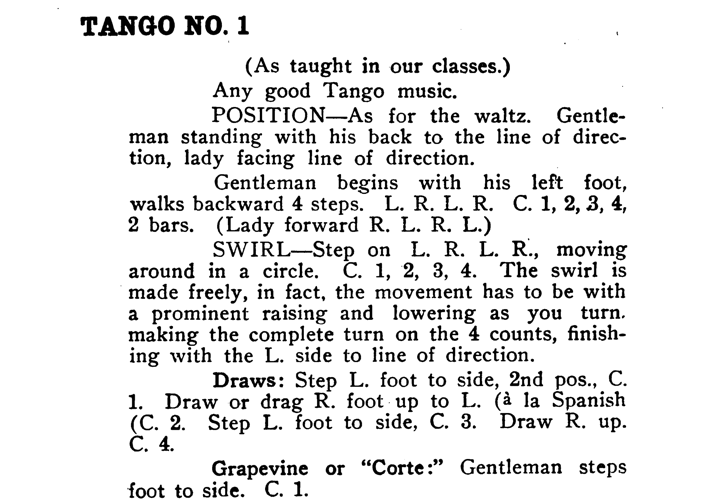

Tango No. 1 (Clendenen, Dance Mad [Late 1914 Edition], 1914, p. 23):
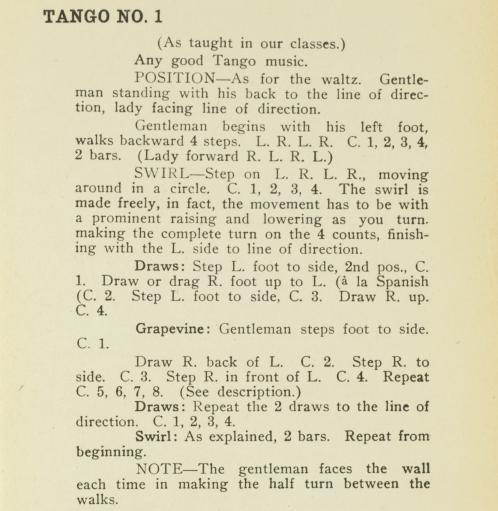
This is a very short sequence of an odd 12 counts.
Part I - Back the Lead, Back the Follow (8 slow counts): Back the Lead four steps along LOD (1, 2, 3, 4), pivoting halfway around on count 4, then back the Follow four steps along LOD.
Part II - Swirl (8 fast counts): Four counts of rocking turn to the right, followed by four counts of rocking turn to the left.
South Indian "Harem Tango" (Clendenen, Dance Mad [Early 1914 Edition], 1914, p. 35):
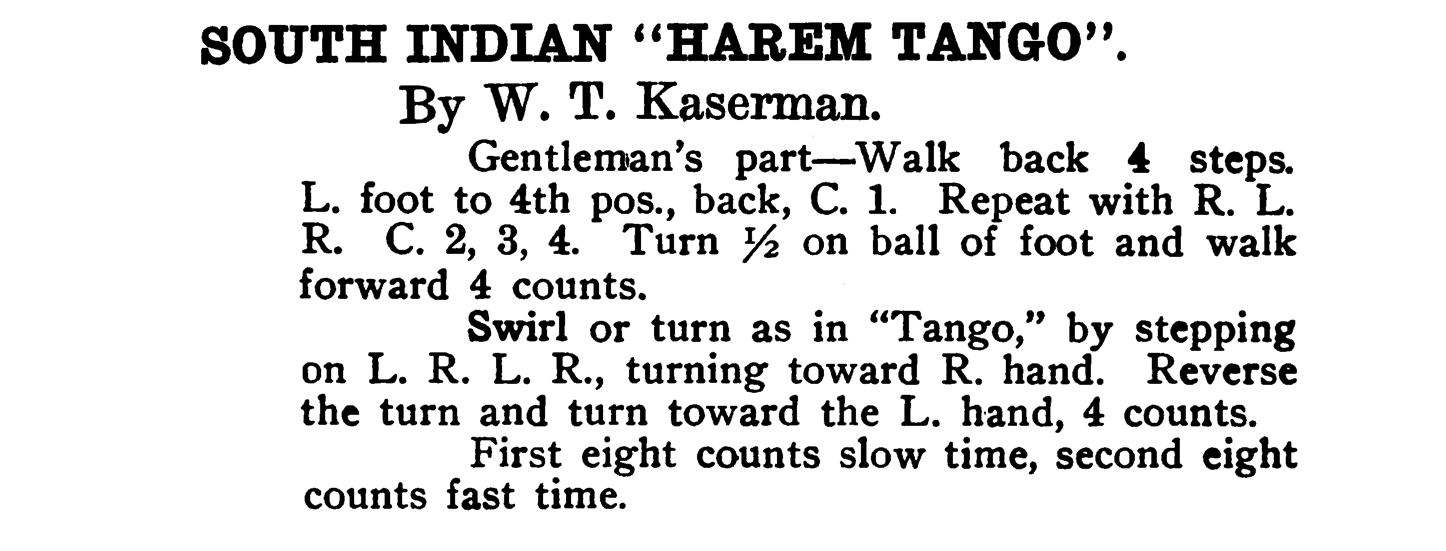
South Indian "Harem Tango" (Clendenen, Dance Mad [Late 1914 Edition], 1914, p. 24):
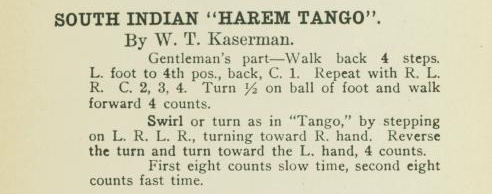
Back the Lead four steps, starting Lead's left (1, 2, 3, 4). Then Corte as follows: step side (5), point side, rising (and) and falling (6), step side (7), point side (8). On 5, 6, 7, 8, there is a half turn. Repeat these 8 counts, backing the Follow, and finishing with the Lead's back to the center.
Media Luna: Step back left (1), point back right (and), and raise and lower heel (2), step right forward (3), point left forward (and), and raise and lower heel (4). Repeat these 4 counts.
Hitch Step: Promenade two steps on outside foot (1, 2), then close outside foot and rise and fall (3). Repeat (4, 5, 6). Promenade four steps (7, 8, 1, 2). The Lead crosses over as in "El Ocho" (L'Eventail). The repeat the last 8 counts (this isn't entirely clear).
Corté in Turn: Unclear: step back left (1), point side right (and), rise and fall (2), step side right (3), step side left (4), turning 1/2. Then repeat to complete a full turn.
Scissors Step: Scissors step (No. 29) for 16 counts.
Repeat from the beginning.
Position is described as "Vis-vis [face-to-face] with hands clasped and extended to side," probably open two hands.
Part I: Four counts of Grapevine starting Lead's side left and cross right behind (1, 2, 3, 4). Then side (5), draw closed (6), and half of a two step, Lead backing around (7-and-8). Repeat opposite, continuing to travel the same way (1, 2, 3, 4, 5, 6, 7, 8).
Part II: Lunge back onto left foot (1), then close right behind (2), and repeat opposite (3, 4). Then step side left (5), cross right behind and honor partner (6), and repeat honoring opposite (7, 8).
Part III: Single Scissors with Points Styling: cross left (1), point right (2), cross right (3), point left (4). Then a four count rocking turn to the right (5, 6, 7, 8).
Repeat it all from the beginning.
Tango (Clendenen, Dance Mad [Early 1914 Edition], 1914, p. 63):

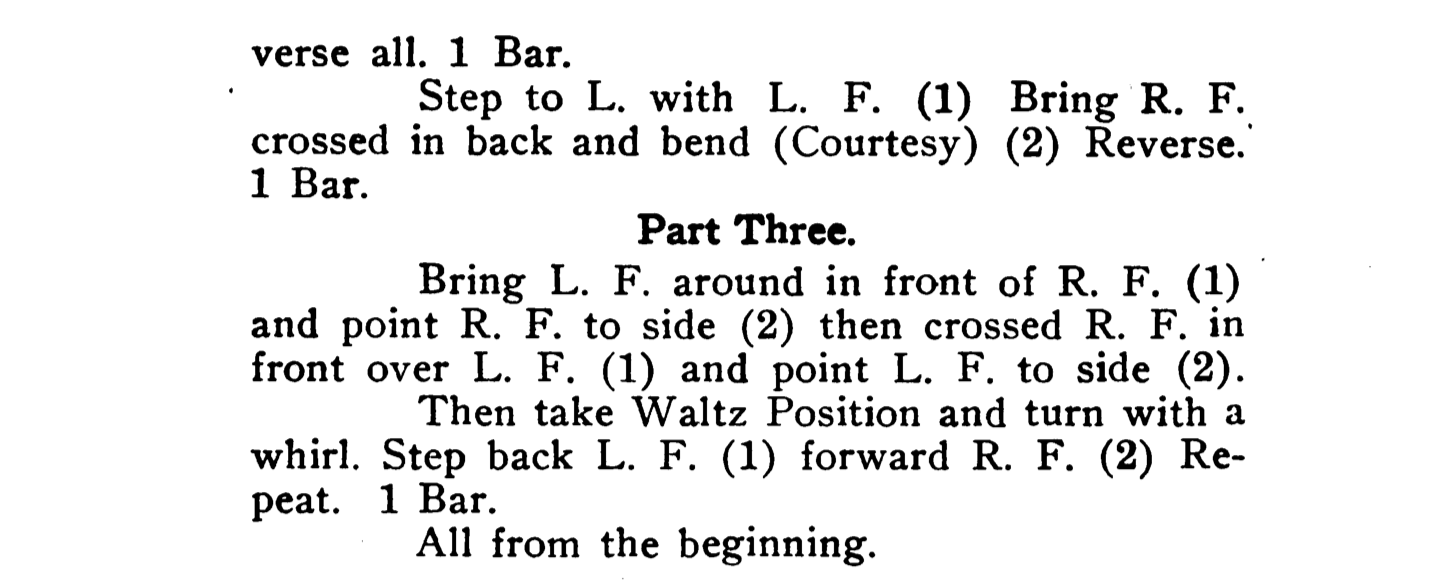
Tango (Clendenen, Dance Mad [Late 1914 Edition], 1914, p. 99):
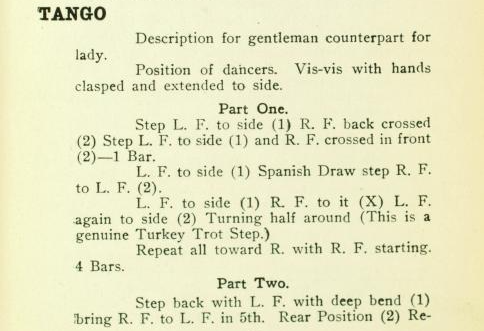
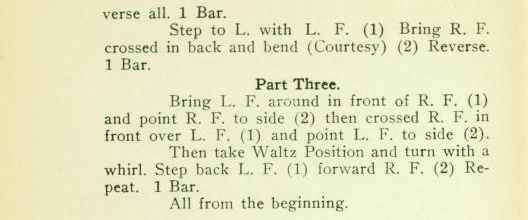
This is a short (24 count) Tango sequence in Shadow position.
Part I - Over and Back and Grapevine (8 counts): Beginning on right foot for both, walk forward 4 counts. Pivot quickly to the right, and repeat to return to place. Then grapevine 8 counts, starting back right.
Part II - Honor Partners (4 counts): Disengage left hands as the Follow turns to face away partner and back toward partner, then bow and courtesy.
Part III - Balance and Pose (8 counts): Keeping right hands, approach partner, rise and fall (1, 2), then take waltz position, and step back left as in a Corte (3, 4). Then two side draws with a rise and fall (1, 2, 3, 4).
Part III - Walk Around (4 counts): Walk around each other for four counts, then take Shadow position and repeat the dance.
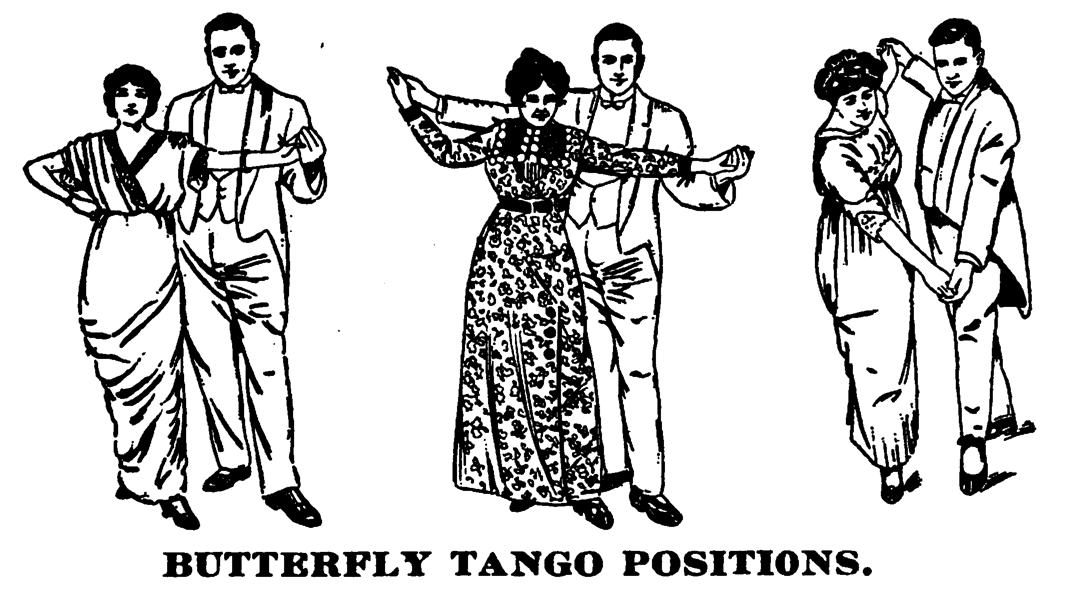
The Butterfly Tango (Clendenen, Dance Mad [Late 1914 Edition], 1914, p. 37):

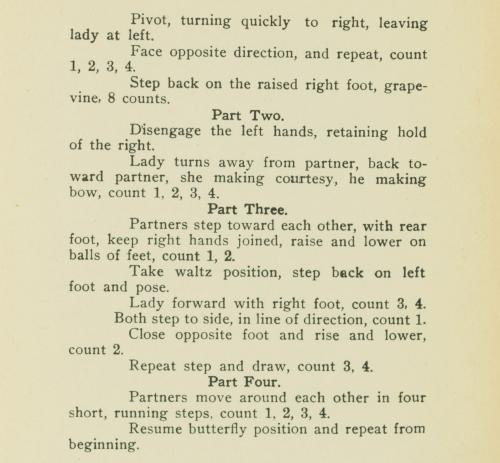
The Butterfly Tango (Clendenen, Dance Mad [Late 1914 Edition], 1914, p. 24):


This is a long 64 count tango sequence.
Part I - Side Step Scissors (8 counts): Starting with outside feet, promenade four steps over hands (1, 2, 3, 4), then cross outside foot over to promenade four steps over the elbows (5, 6, 7, 8).
Part II - Sweeps and Grapevine (8 counts): Sweep Lead's left forward, Follow's right back (1, 2), then sweep Lead's left back, Follow's right forward (3, 4). Then grapevine four steps (5, 6, 7, 8).
Part III - Draw and Grapevine (8 counts): Side (1), close (2), rise (3), fall (4). Then grapevine four steps (5, 6, 7, 8). Repeat this count of 8.
Part IV - Promenade and Point (8 counts): Side (1), cross (2), point side with weight (3), close pointed foot without weight (4). Repeat opposite, traveling to the right (5, 6, 7, 8).
Part V - Back the Lead, Back the Follow (16 counts): Back the Lead eight steps along LOD (1, 2, 3, 4, 5, 6, 7, 8), pivoting halfway at the end to back the Follow eight steps along LOD (1, 2, 3, 4, 5, 6, 7, 8).
Part VI - Side Step Square (8 counts): Four side closes, pointing the side-stepping foot (with weight) (1, 2, 3, 4, 5, 6, 7, 8). This step turns 1/4 to the right every two steps, making a very small side-step square with the Follow in the middle of it.
It is noted that the body leans toward the stepping foot on each step.
Tango (Clendenen, Dance Mad [Late 1914 Edition], 1914, p. 38):

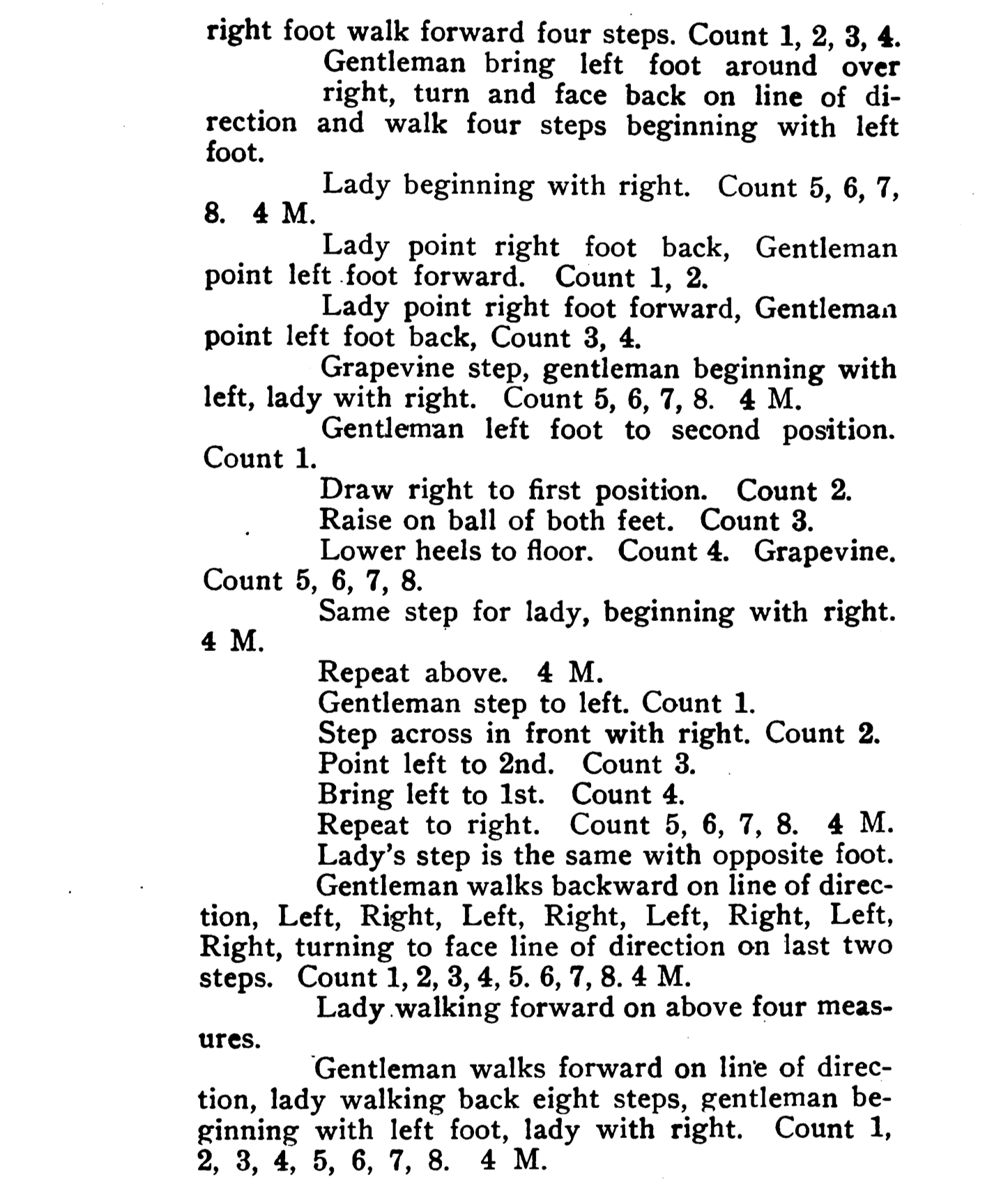

Tango (Clendenen, Dance Mad [Late 1914 Edition], 1914, p. 25):

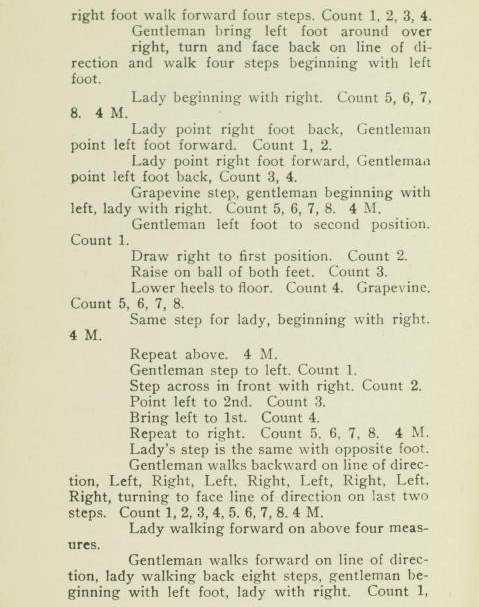

This is an easy 32 count Tango sequence.
Starting with outside feet, promenade four steps over hands (1, 2, 3, 4), then cross outside foot over to promenade four steps over the elbows (5, 6, 7, 8).
Point to side without weight (1), close back to place (2), rise (3), fall (4). Then grapevine four steps (5, 6, 7, 8).
A four count Scissors with Points, starting with the outside foot, traveling over the elbows (1, 2, 3, 4, 5, 6, 7, 8).
Two side draws (1, 2, 3, 4), and a four count rocking turn (5, 6, 7, 8).
Repeat from the beginning.
"Mixed Pickles" Tango (Clendenen, Dance Mad [Late 1914 Edition], 1914, p. 40):
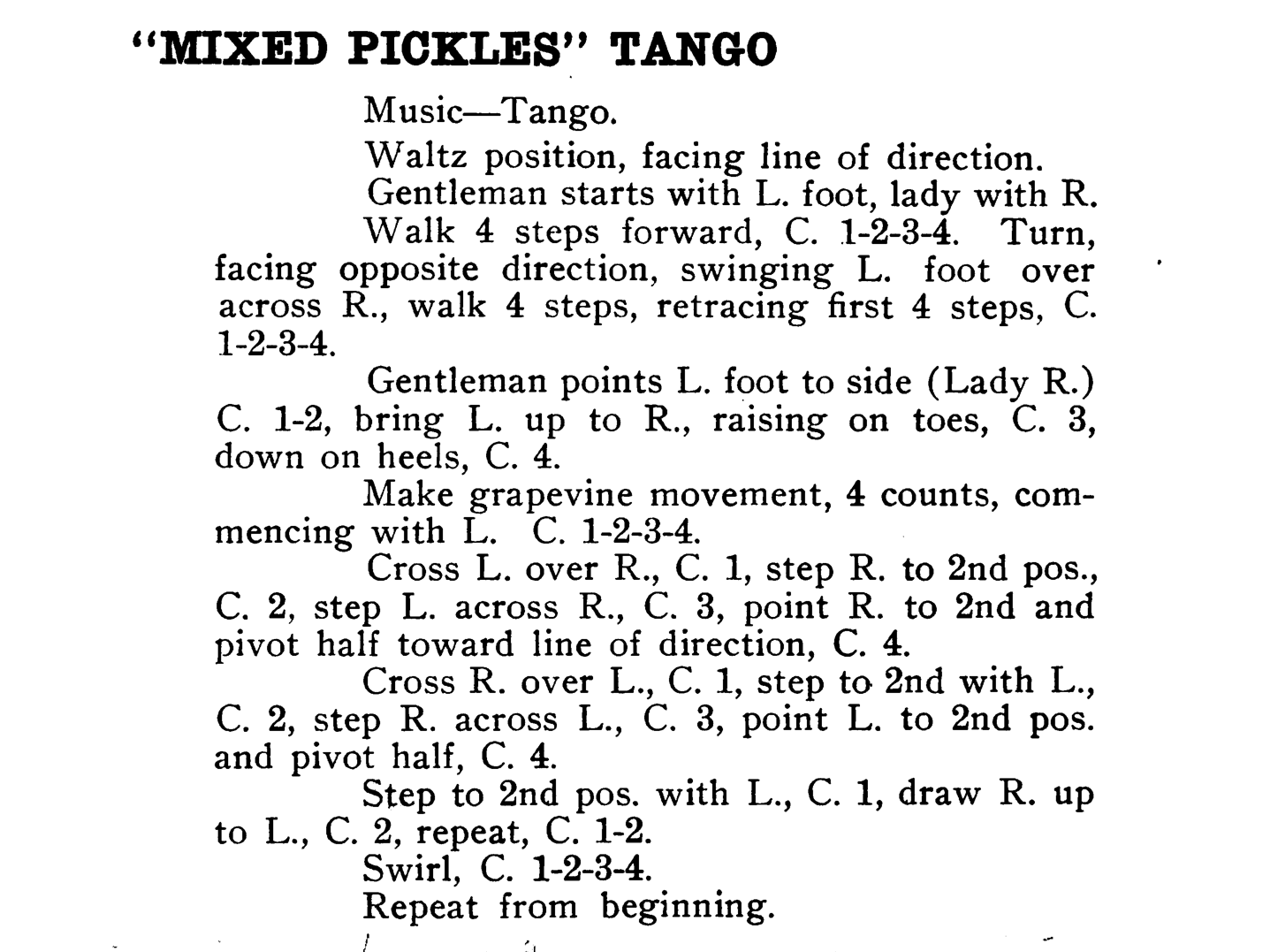
"Mixed Pickles" Tango (Clendenen, Dance Mad [Late 1914 Edition], 1914, p. 27):
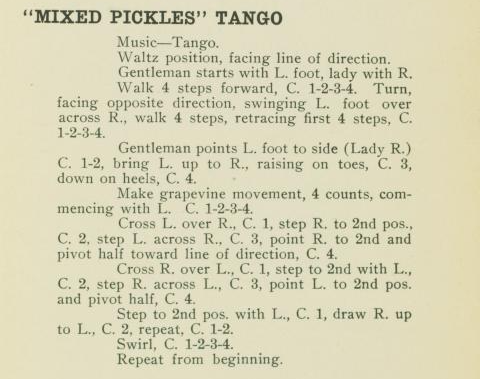
Promenade three steps, and close, turning 1/4 to the right. Repeat to form a square, four counts to a side. Then do the same with two counts to a side.
Back the Follow four very slow steps (2 counts per step), dipping on each step. Then Back the Lead the same way.
Promenade three steps (1, 2, 3), dipping on the third, then stand up straight (4), facing the other way. Repeat opposite. Then spring forward onto left foot (Follow back), raising the right foot behind, and spring back onto right foot, raising the left in front. Repeat rocking forward and back. Then repeat all of Step Three.
A four count Scissors starting by crossing left over right, with Kicks styling. Then do a two count Scissors with Kicks. Do each part for 8 counts (i.e., 2x4 + 4x2).
Circle left foot around and behind the right (1, 2), then do the same with the right (3, 4). Then dip back on the left, raising the right (5), and replace forward right (6). Then two-step forward left (7-and-8).
Side, close x 4. Then rocking turn x 4.
Promenade two steps on outside foot (1, 2), then point-kick as in Ochos (3-and), turn back to face the original direction, pointing the kicking foot forward (4). Repeat three more times.
Forward left (1), forward right (2), circle left around in front of right, raising right behind (3), then close right to left, raising left in front (4). Then push left forward, bending knee (5), and step forward right (6), then spring back on left, raising right in front (7), and step right in front (8). Repeat.
Stamp left forward (1), and hop three times with the right raised behind (2, 3, 4). Repeat for 8 bars. For a change, this can be done moving around each other alternately.
In Skater's position: back left (1), back right (2), dip back left (3), close (4). Repeat, moving forward. Repeat for 16 bars.
With open two hands, raised to shoulder level, cross right (1), close left behind (and), repeat for 8 counts. Then cross left over right and repeat opposite.
This is a Rocking Turn, left foot back, raising the free foot. It can also be done traveling to the side for 8 counts, and then turning for 8 counts.
Grapevine for 8 counts, dipping on the cross-steps. Then rocking turn for 4 counts, then step forward with a deep dip (1, 2), and repeat the deep dip (3, 4).
This seems to be a version of the Texas Tommy move. The Follow drops to her right knee as far to the side as the arms with allow. Then rewind the Texas Tommy movement, and back the Lead four steps. Repeat.
In Shadow Position, walk forward outside foot (1), inside foot (raising outside foot back) (2), then step back outside foot (3), close inside foot (and), and step forward outside foot (4). Repeat three times.
Rocking turn for 6 counts, kneel on right (7), and stand up (8). Repeat. Then pivot around the stage.
Two slow crosses (2 counts each), followed by four quick crosses (one count each).
Cross left across right, dipping on it, the step side right. Repeat sideways around a circle.
Unclear.
Unclear.
Unclear.
Shadow Position, with the Lead holding the Follow's wrists, as illustrated below. Both have the right foot in front, in 3rd position.
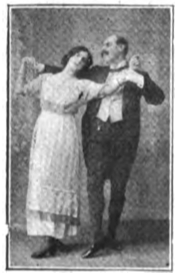

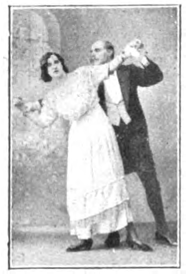
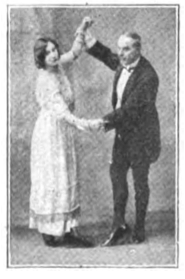
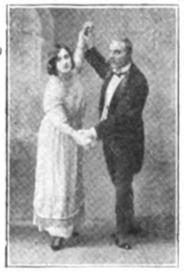
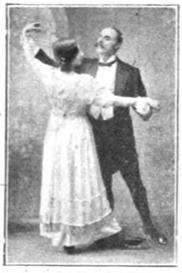
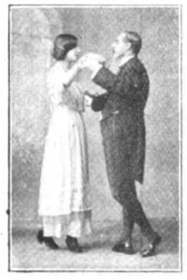
No music is specified, but the dance requires 24 bars.
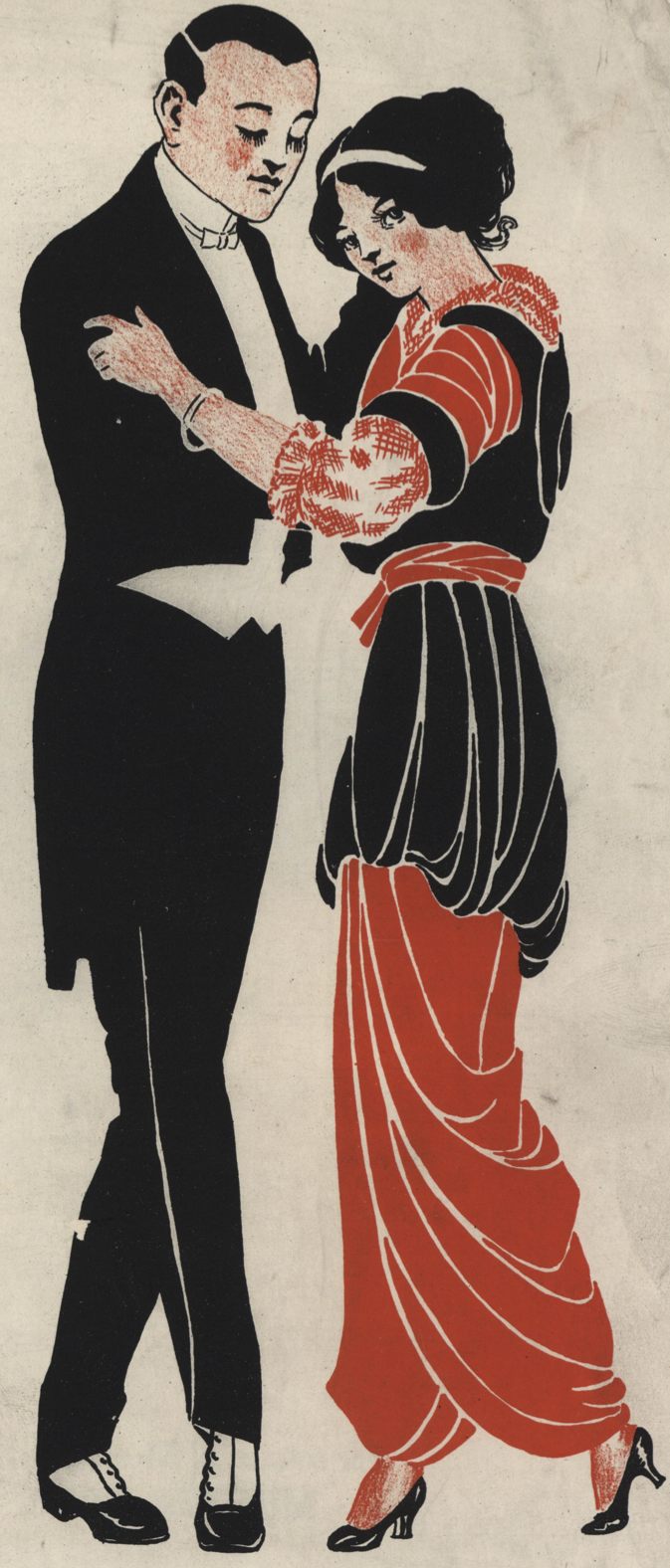
A four-part sequence, accompanied by Mentel's Tango (1914) by Louis H. Mentel.
This is an easy, 32-count tango sequence with one step per beat throughout, choreographed by Albert Newman of Philadelphia in 1914, and described by Newman as well as Frank Norman and F. Leslie Clendenen.
Tango Position and Closed Position, as illustrated below.
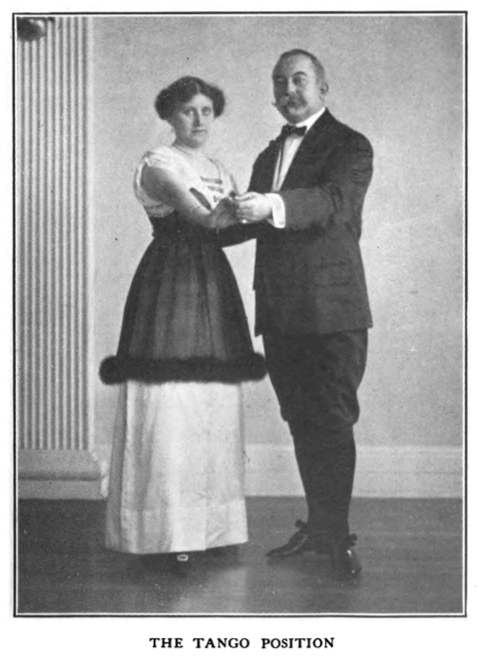
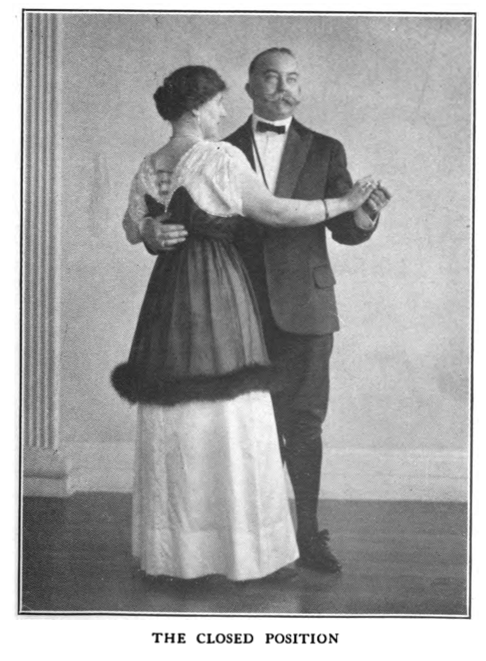
Part I - Promenade and Point (8 counts): Promenade two steps LOD (1, 2), then point outside foot forward, turning to face partner, rising on the inside foot (3), and fall on the inside foot (4). Repeat (5, 6, 7, 8).
Part II - Rocking Turn (8 counts): Lead steps back left as the Follow steps forward right. Then the Lead rocks forward right, as the Follow rocks back left, turning 1/4 to the right. Repeat three more times, rotating one full turn in total.
Note: The sources note that Part II can also be done turning to the left (with the Lead's left rocking forward, rather than back), or turning to the left and then the right (two rocks with the Lead's left foot in back, then shift to the Lead's left in front for the second two), or vice versa.
Part III - The Square (12 counts): This is a phase-shifted, quarter-turning Ocho in even timing, performed in a square. The Lead steps side left along LOD, then crosses right in front of left along LOD, then steps side left along LOD, as the Follow steps side right, crosses left in front, and steps side right. On the third step, the couple turns a quarter to the right, so that the Lead is facing against. Repeat opposite to travel toward the center of the room, the Lead stepping right, cross left in front, right, and the Follow stepping left, cross right in front, left, both turning a quarter to the right at the end, so that the Lead is facing into the room. Repeat both halves to complete the square and end up where you started.
Note: The sources note that if there are couples in your way, you can turn more than a quarter on the third step to travel in a straight line and navigate around them. This turns the step into half-turning, LOD-traveling Cross-Step Waltz (starting on count 6), a decade and a half before it was danced as such in waltz timing as the French Valse Boston.
Part IV - The Walk Out (4 counts): The last four counts are simply four walking steps (likely a promenade along LOD). Alternatively, the sources note that it could be four walking steps backwards, although it is unclear what exactly this means (Follow backing LOD, Lead backing LOD, or something else).
"The Newman Tango," written specifically for this dance, or any other square tango tune of the era.
The sources note that it is to be danced to Tango music, not Ragtime.
Minuet Tango, The Minuet of the Twentieth Century (Newman, Dances of To-Day, 1914, p. 123):
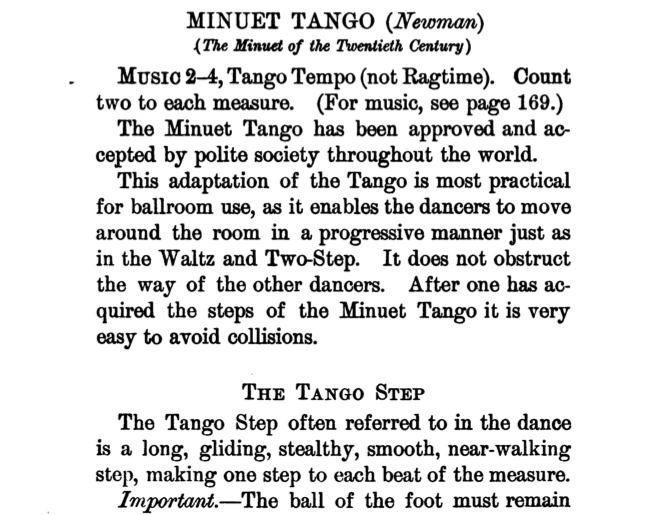
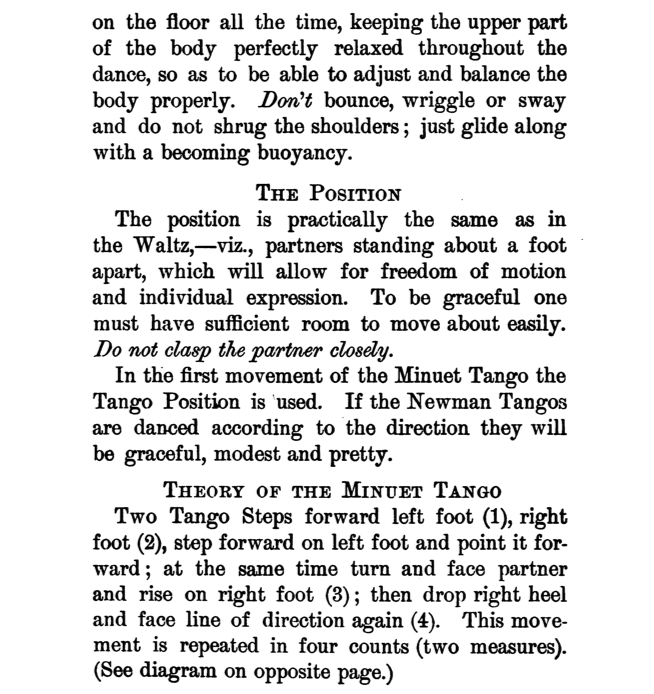
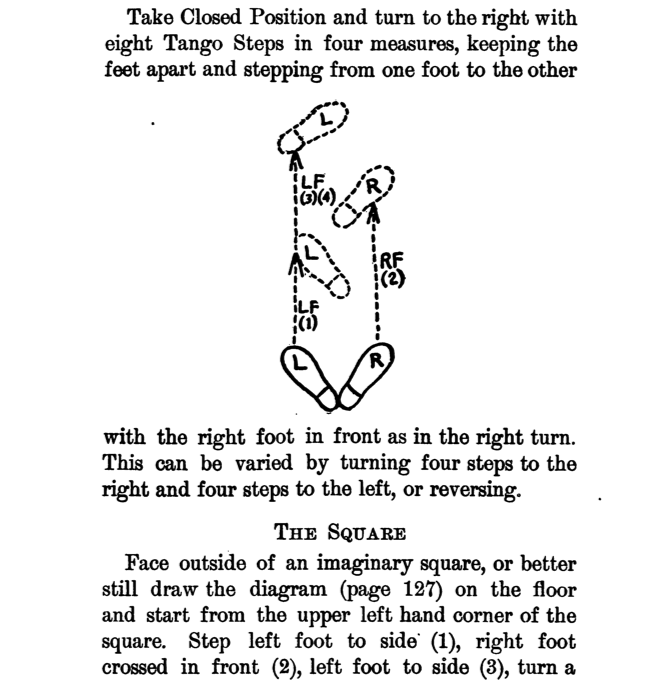
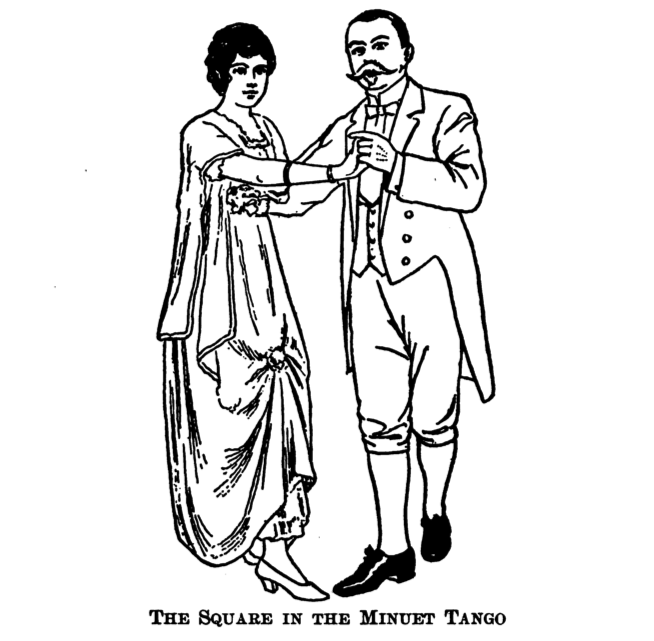
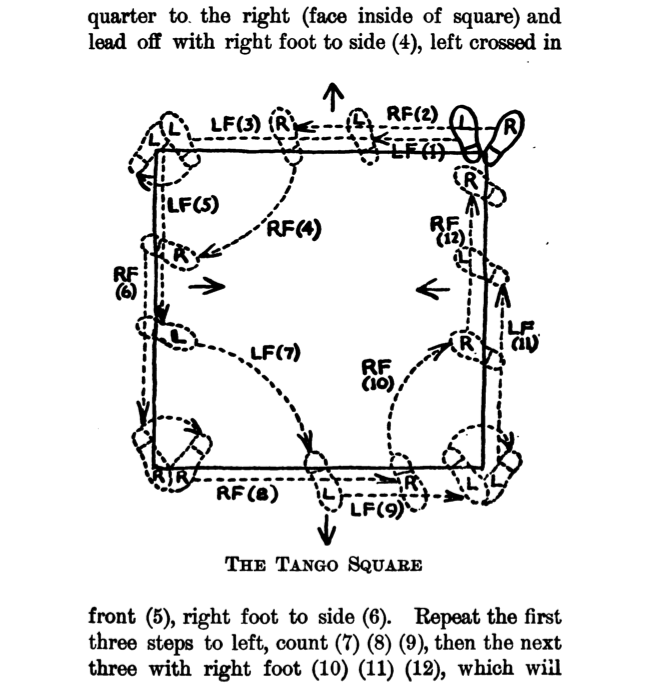
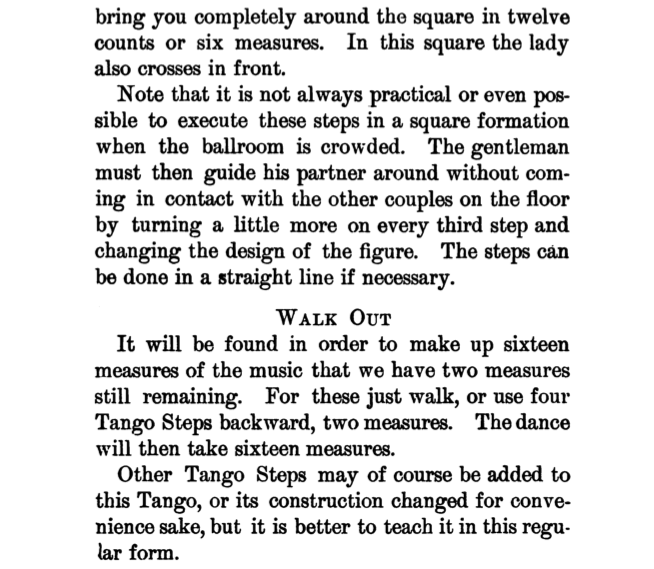
Newman Tango, The Minuet of the Twentieth Century (Clendenen, Dance Mad [Early 1914 Edition], 1914, p. 60):
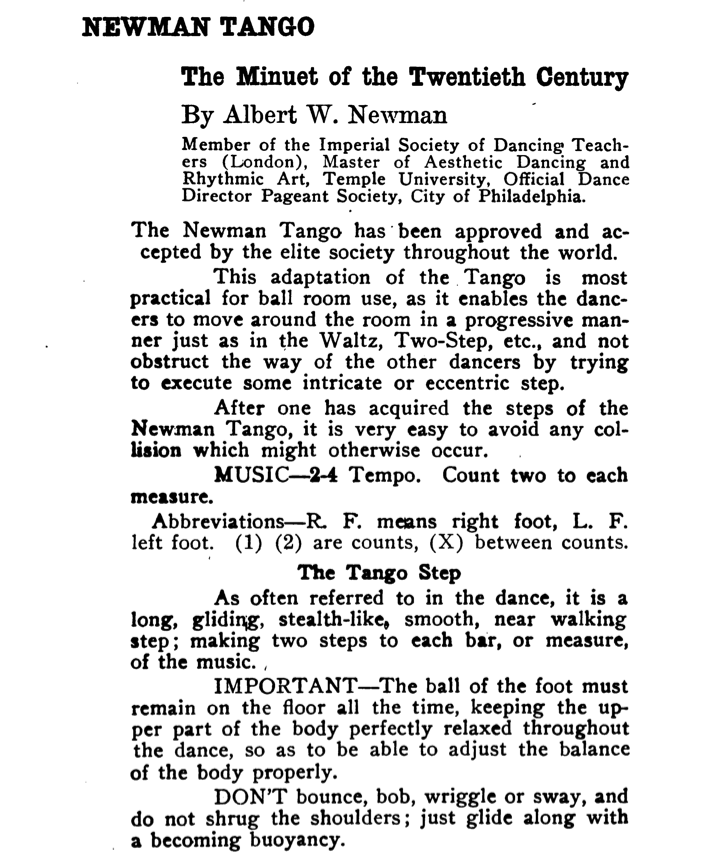
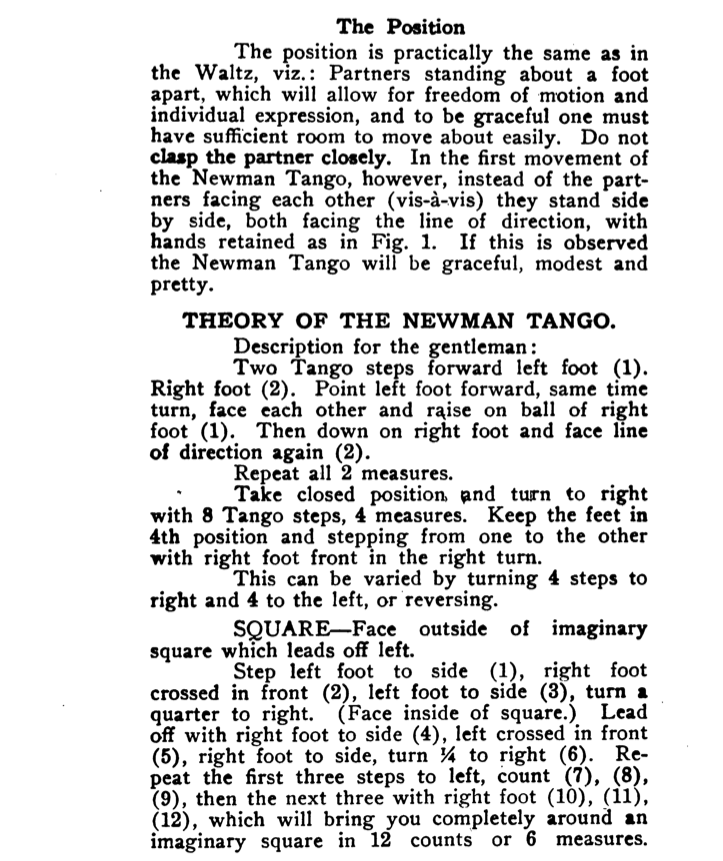
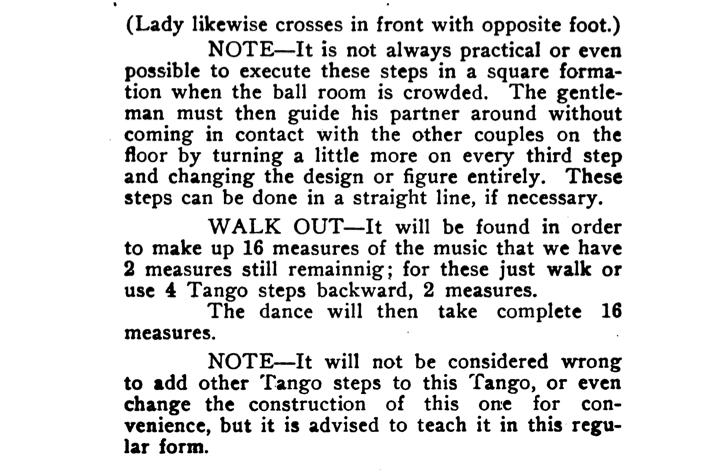
Newman Tango, The Minuet of the Twentieth Century (Clendenen, Dance Mad [Late 1914 Edition], 1914, p. 96):
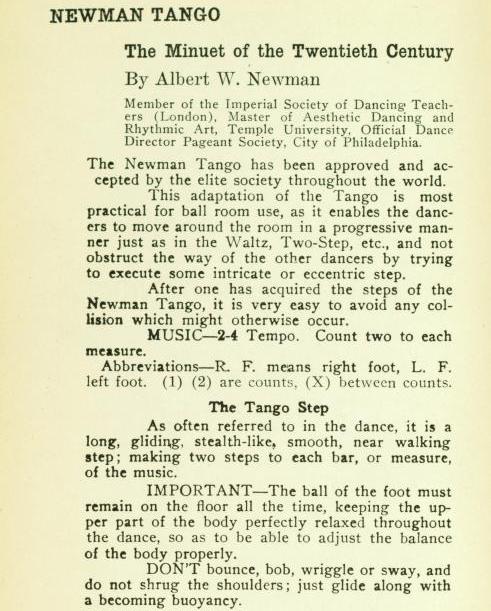
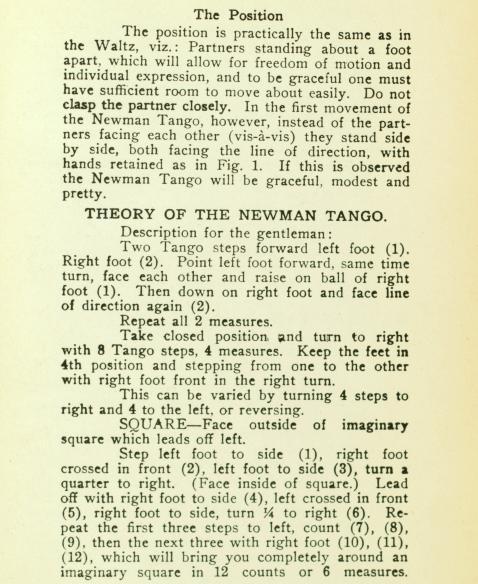
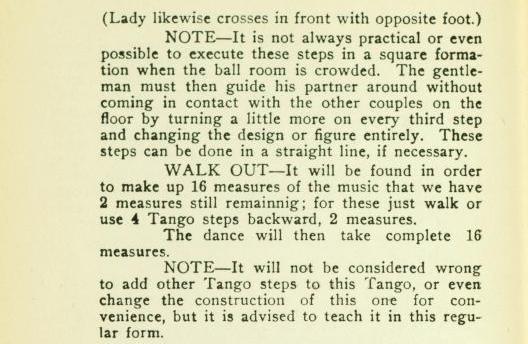
Minuet Tango (Norman, Complete Dance Instructor, 1914, p. 16):
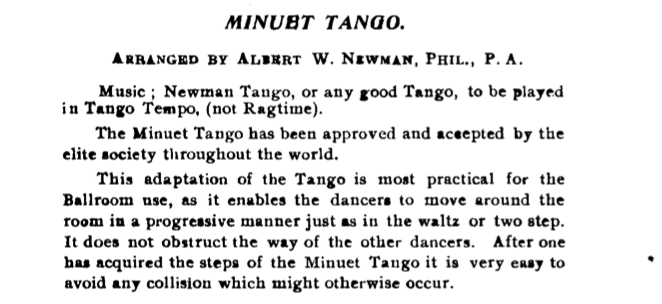
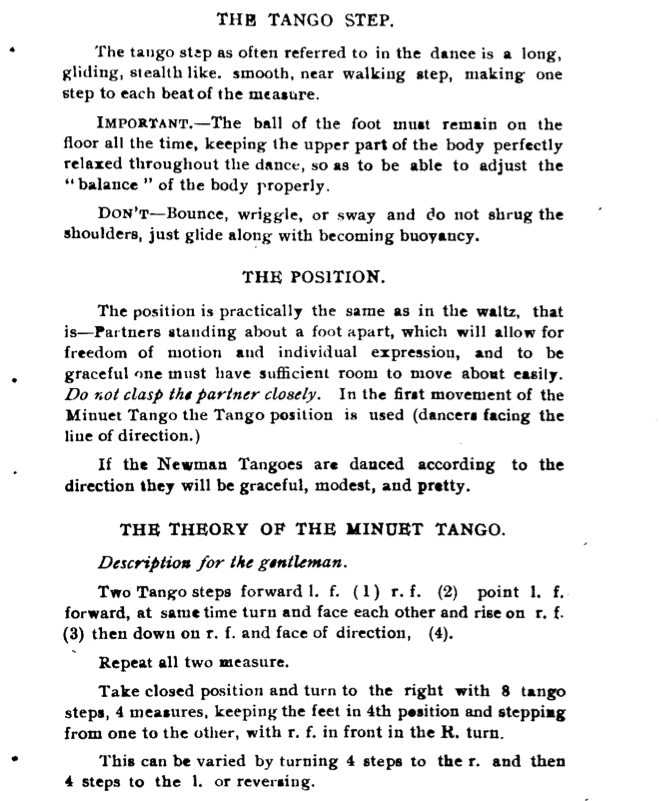
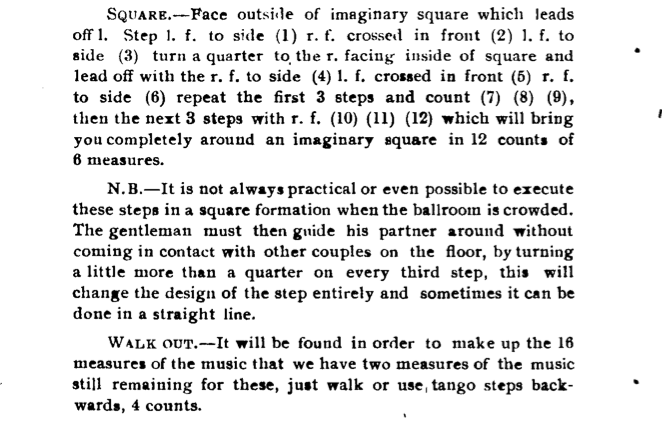
This is a short, easy tango sequence of only 16 counts, choreographed by Albert Newman of Philadelphia in 1914, and described by Newman and F. Leslie Clendenen.
Tango Position and Closed Position, as illustrated above.
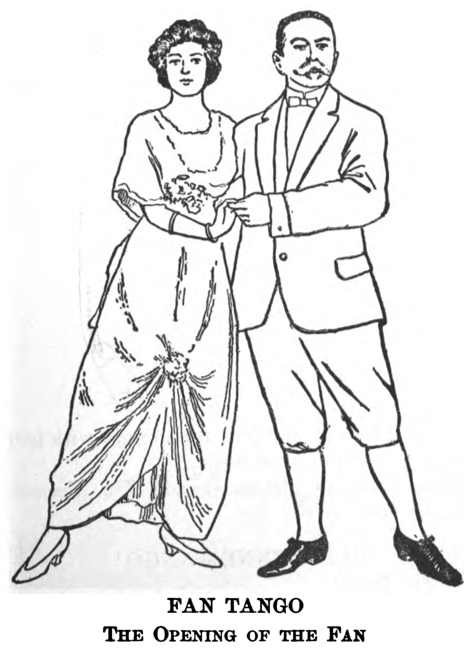
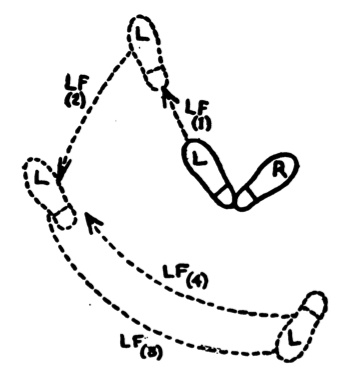
Fan Tango (Newman, Dances of To-Day, 1914, p. 134):
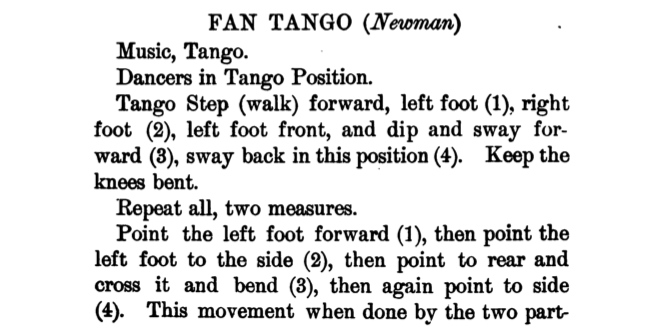
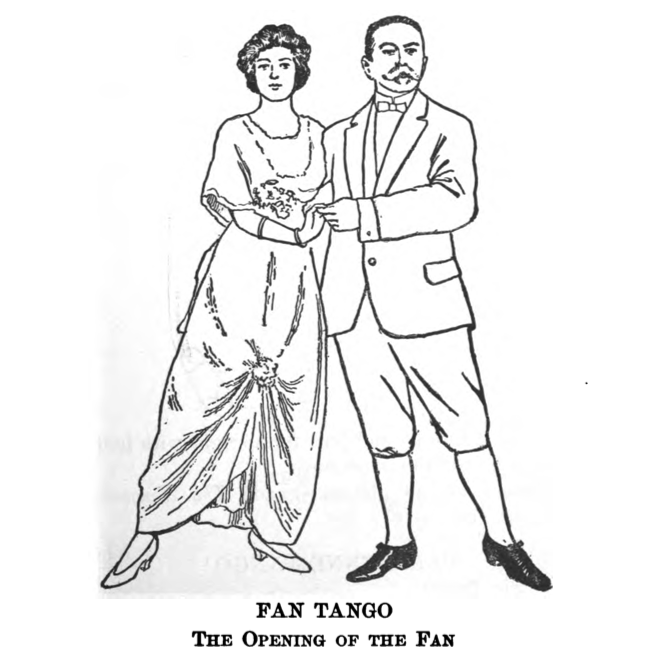
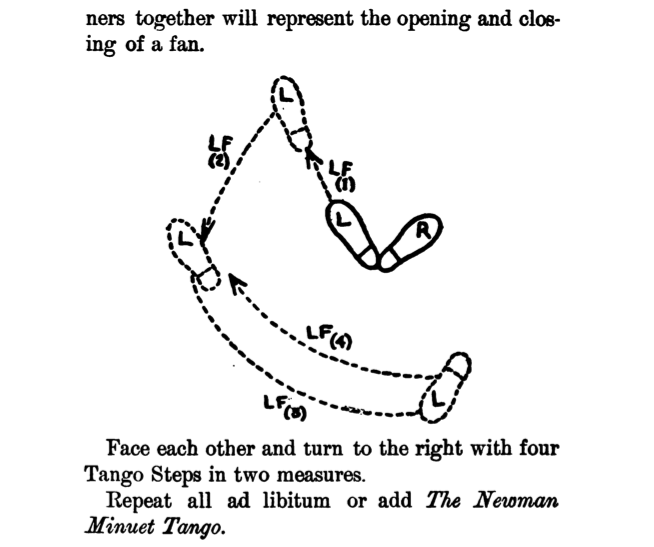
Fan Tango (Clendenen, Dance Mad [Early 1914 Edition], 1914, p. 64):
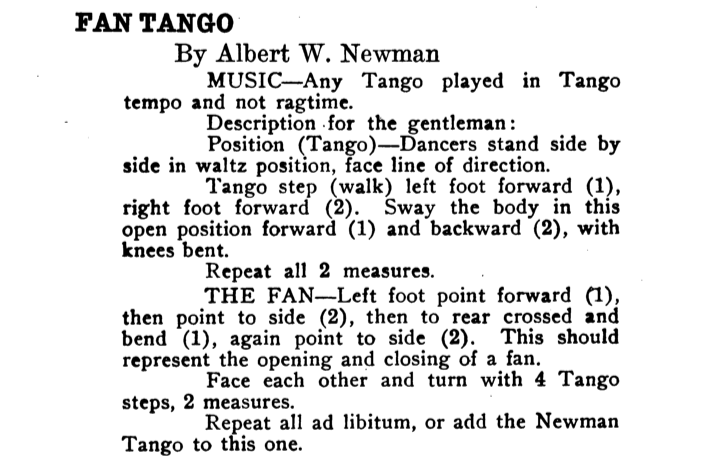
Fan Tango (Clendenen, Dance Mad [Late 1914 Edition], 1914, p. 100):
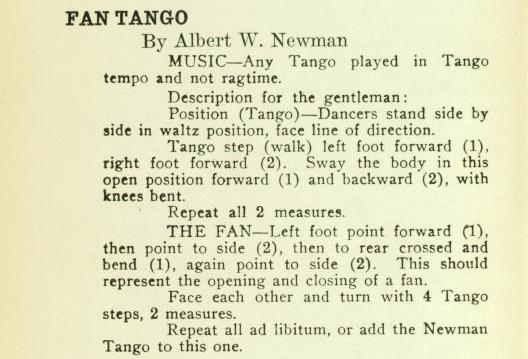
This is an easy, 32-count tango sequence described by Albert Newman of Philadelphia in 1914.
Tango Position and Closed Position, as illustrated above.
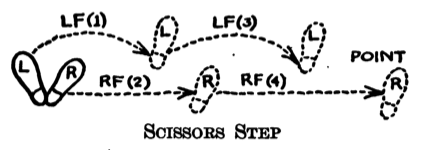
Newman Tango "Argentine" (Newman, Dances of To-Day, 1914, p. 128):

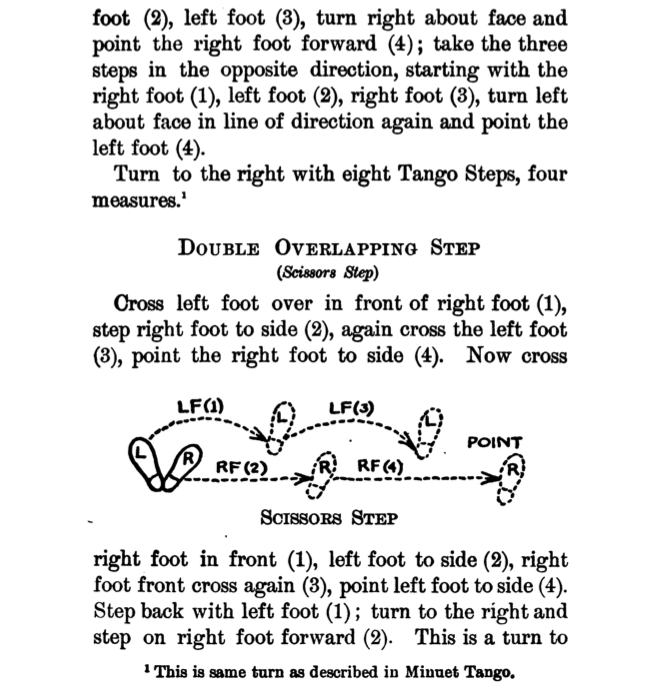
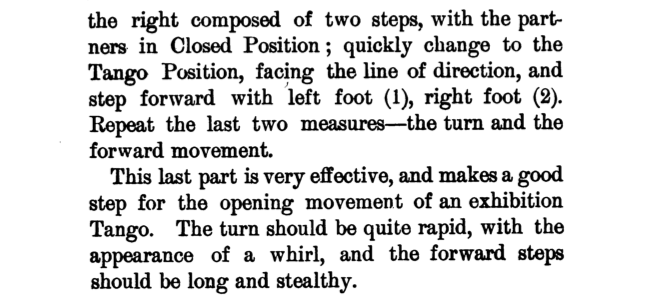
Newman Tango "Argentine" (Clendenen, Dance Mad [Early 1914 Edition], 1914, p. 62):
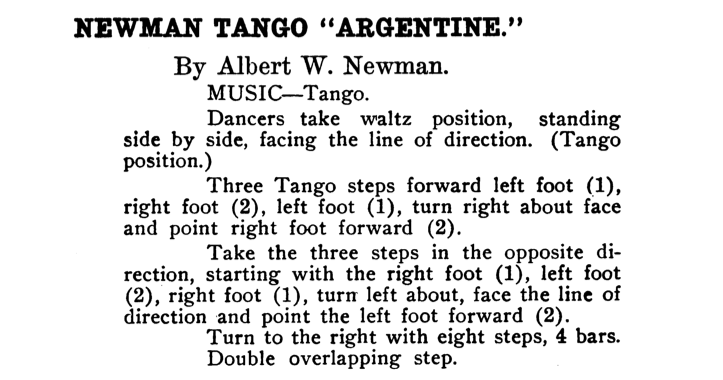
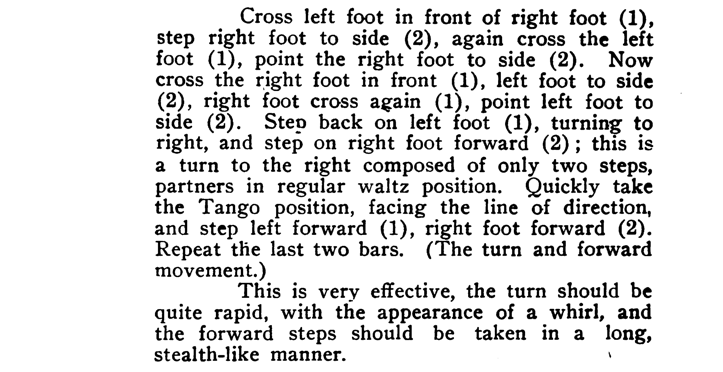
Newman Tango "Argentine" (Clendenen, Dance Mad [Late 1914 Edition], 1914, p. 98):
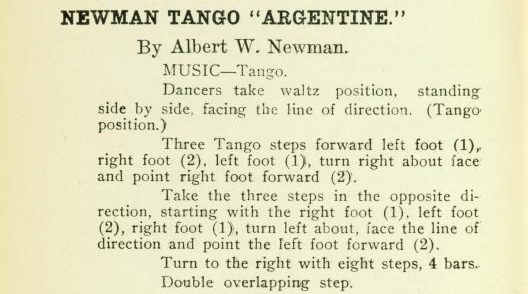
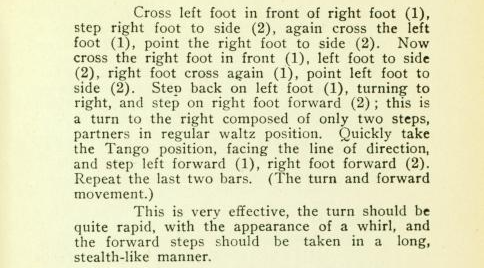
This is an easy, 32-count tango sequence described by Albert Newman of Philadelphia in 1914.
Tango Position and Closed Position, as illustrated above.
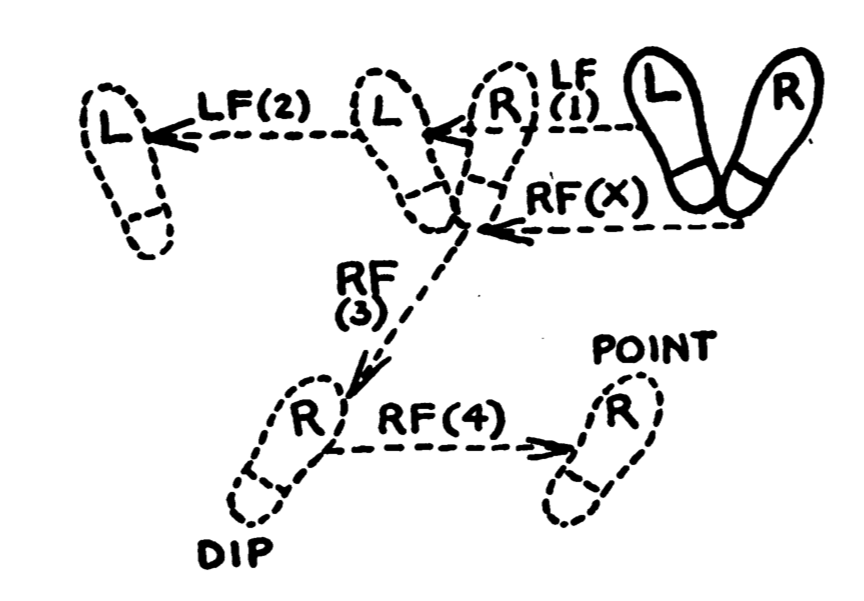
This is an easy, 32-count tango sequence described by Albert Newman of Philadelphia in 1914.
Tango Position and Closed Position, as illustrated below.


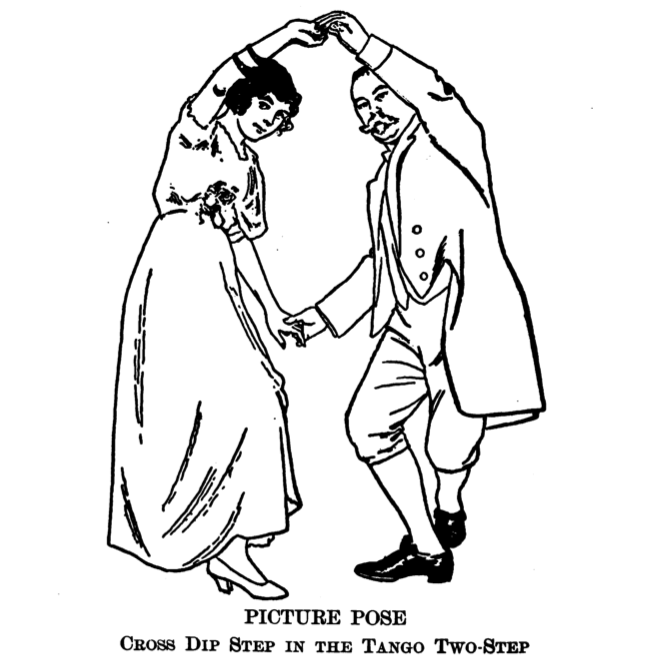
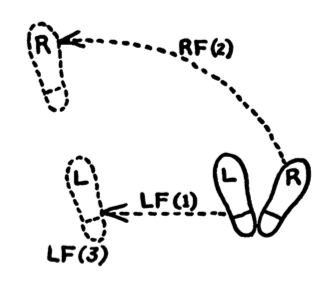
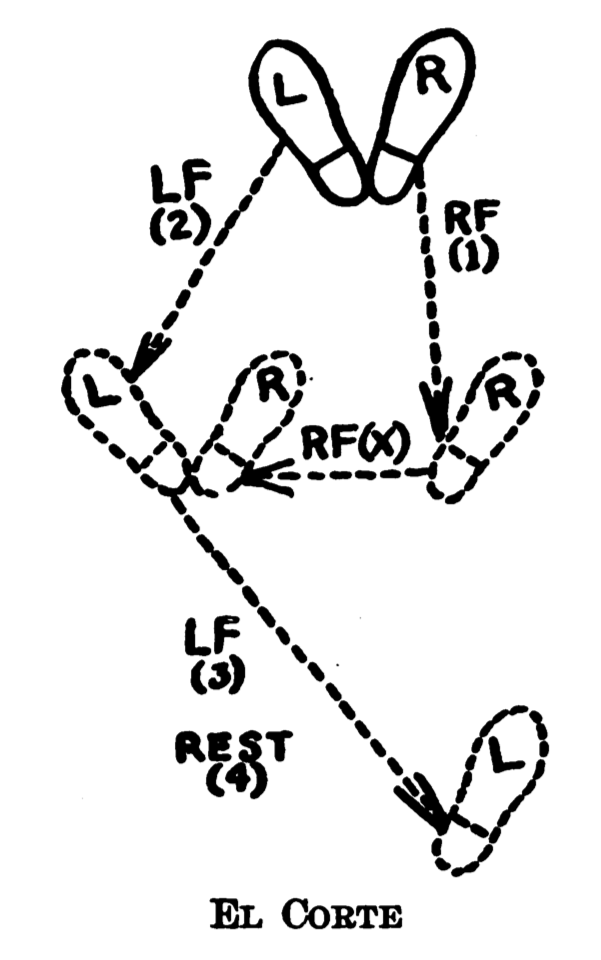
In 1914, Miss Eileen Swepstone described this Tango which includes four parts, each composed of four movements of eight counts each.
What makes Miss Swepstone's description of the tango unique is that she describes all of the steps for the woman, simply saying that "the gentleman's steps are the counterpart of the lady's," inverting the centuries' old bias the other way.
All four parts of Swepstone's tango (which she simply calls "The Tango") can be danced together, or each part can be danced individually, or the variations within can be mixed and matched at will.
Tango position.
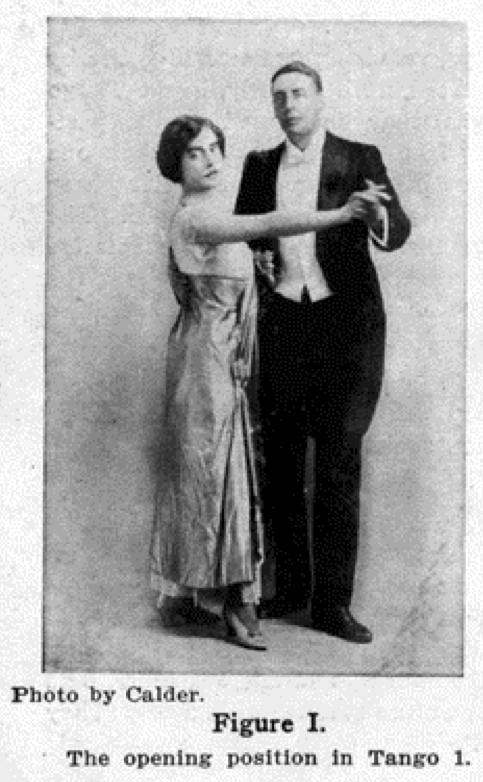
Movement I - Tango Walk (8 counts): Beginning in tango position, the Lead walks three steps forward along LOD (1, 2, 3), three steps back along LOD (4, 5, 6), and two steps forward along LOD (7, 8), while the Follow walks six steps forward, and two steps back.
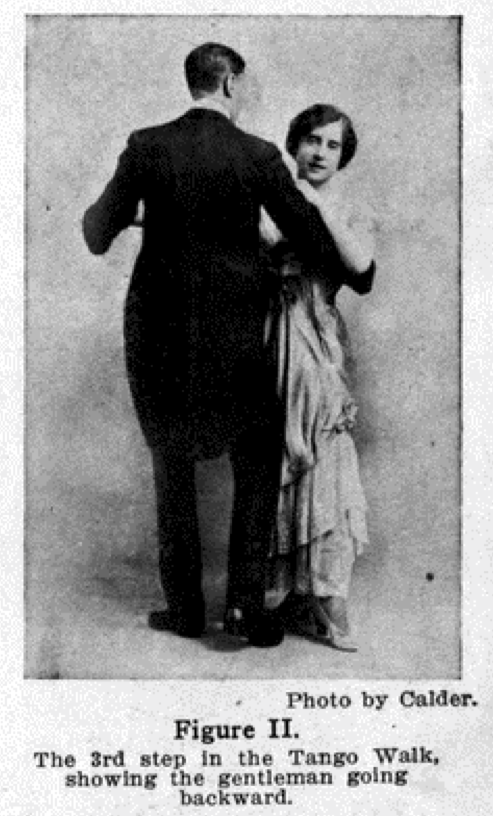
Movement II - Drag and Pivot (8 counts): Side, close, side, close, pivot x 4. (It's unclear from the description whether this is two full turns with traveling pivots, or a single turn with pivots in place.)
Movement III - Grape Vine with Dip (8 counts): Grapevine six steps, the Lead crossing back on count 2 and the Follow crossing in front (1, 2, 3, 4, 5, 6). Then dip on the second foot, leaving the first foot extended to the side, toe touching the floor (7), then bring first foot up to second foot, with even weight on both (8).
Movement IV - Half Grape Vine, Dip, and Pivot (8 counts): The Lead takes two steps forward, as the Follow takes two steps back (1, 2). Then dip on the second foot (3), and bring the feet together, even weight on both (4). Pivot x 4 (5, 6, 7, 8).
Movement I - Position and Two-Step (8 counts): Small step to the side with first foot (1), then point second foot to the side, over the elbows (2). Follow-backing two-step, i.e., forward-close-forward for the Lead (3-and-4). Repeat (1, 2, 3-and-4).
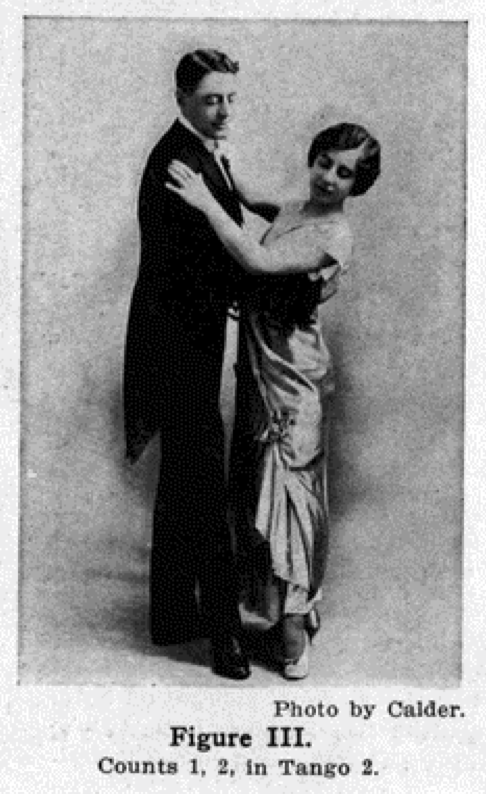
Movement II - Dip, Two-Step, Walk, and Circle Foot (8 counts): Promenade one step (1), then dip onto it (2). Two-step with inside foot, forward-close-forward (3-and-4). Promenade two steps (5, 6), then the Follow sweeps her right foot around counterclockwise to face the Lead (7, 8).
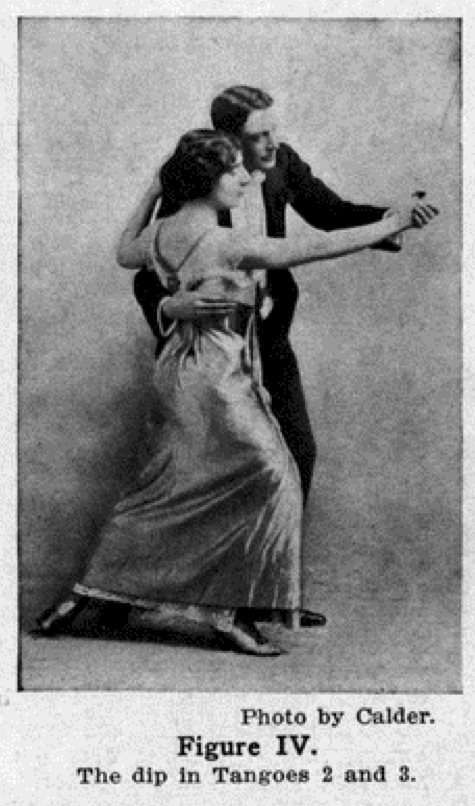
Movement III - Double Scissors (8 counts): The Lead crosses left foot in front of right (1), steps side right (2), crosses left in front of right (3), and points right to the side (4). The Follow dances opposite, also crossing in front. Repeat opposite (5, 6, 7, 8).
Movement IV - Single Scissors (8 counts): The Lead crosses left foot in front of right (1), points right to the side (2), crosses right in front of left (3), and points left to the side (4). The Follow dances opposite, also crossing in front. Repeat (5, 6, 7, 8).
Movement I - Reverse Walk (8 counts): Promenade four steps in tango position. Then turn toward the elbows and continue to promenade backward for four steps.
Movement II - Dip and Turn (8 counts): Dip back on the first foot (1, 2). Turn for three counts (3, 4, 5), then she dips backward as he dips forward (6, 7), then bring feet together (8).
Movement III - Dip, Two-Step, Walk, and Circle Foot (8 counts): Promenade one step (1), then dip onto it (2). Two-step with inside foot, forward-close-forward (3-and-4). Promenade two steps (5, 6), then the Follow sweeps her right foot around counterclockwise to face the Lead (7, 8).
Movement IV - Lady Pirouettes, Gentleman Walks (8 counts): The Follow stands on her right foot, crosses left over right, and turns slowly on the toes in place, as the Lead walks eight steps around her.
Movement I - Sway and Balance (8 counts): Sway Follow to her right, rising on the stepping foot, and leaving the free foot pointed to the side (1, 2, 3, 4). Then sway Follow to her left (5, 6, 7, 8).

Movement II - Sway Turning (8 counts): Sway Follow to her right, rising on the stepping foot (1, 2). Then sway Follow to her left (3, 4). Repeat (5, 6, 7, 8). The couple completes a full rotation with these four sways.
Movement III - Walk and Swing (8 counts): Promenade three steps (1, 2, 3), then point second foot to the side behind (4). Swing second foot in front (5), to side behind (6), in front (7), and step on it, crossed over (8).
Movement IV - Walk and Swing (8 counts): Repeat Movement III.
Swepstone says: "Perhaps the best musical composition for the Tango is Tres Moutard [the classic One Step]. Another good one, not quite so well adapted to the rhythm of the dance, but more tuneful, is La Petite Coquette. There are also Tangoland and the Maurice Tango."
While it's called the Tango Two-Step, this is really more of a Two-Step sequence than a Tango.
Veleta position, holding inside hands.
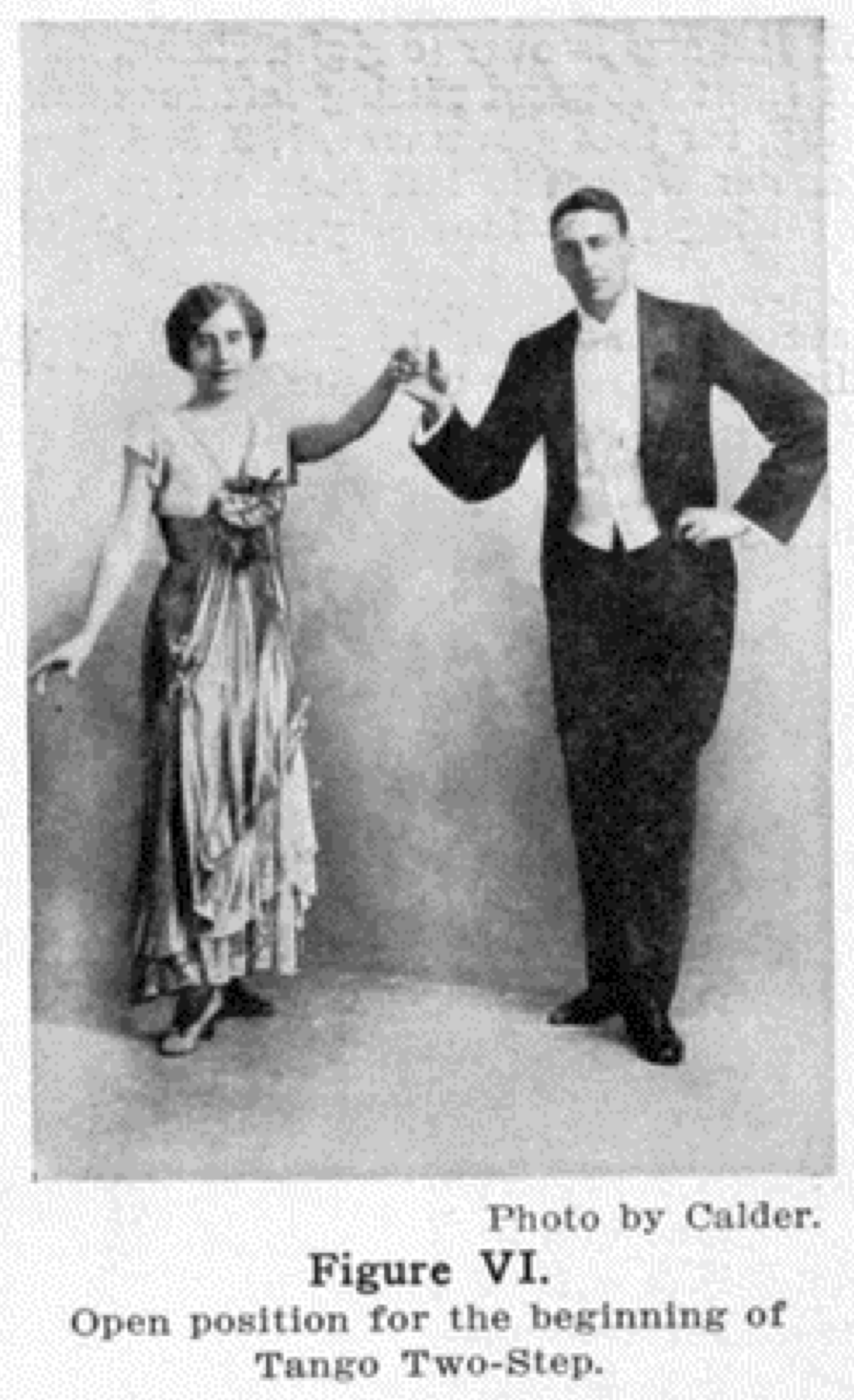
Promenade two steps, starting outside feet (1, 2), then close outside foot and bend knees, facing partner (3). Then promenade two steps starting inside feet (4, 5), then close inside foot and bend knees (6). Promenade two more steps (7, 8), closing into waltz position.
Then do the Dip and Two-Step from Tango No. 2, twice.
Then do four turning two-steps.
Then dip onto outside foot (1, 2), and two-step forward with inside foot (3-and-4). Repeat (5, 6, 7-and-8). Then dance 32 counts of turning two-step.
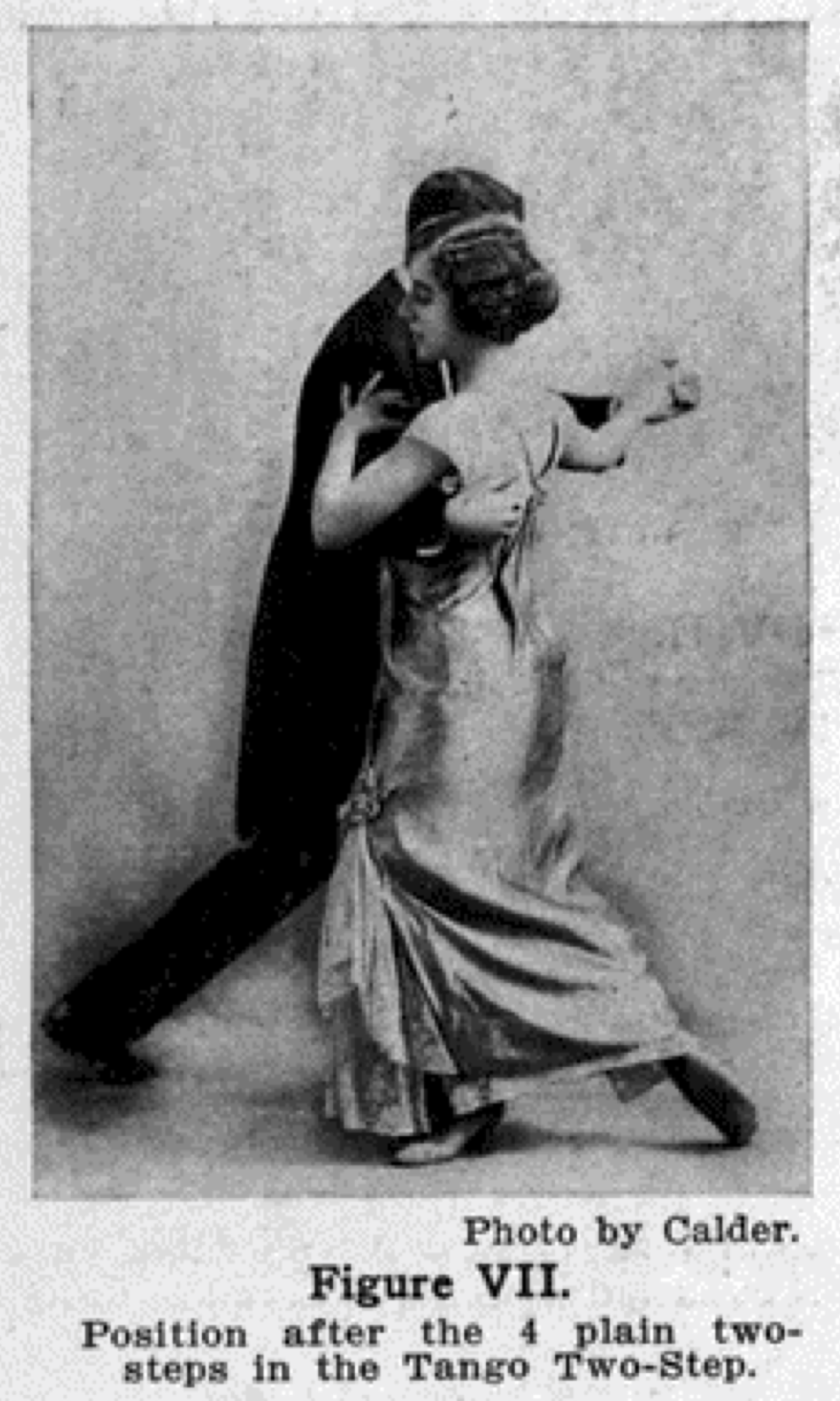
F. Leslie Clendenen also describes a "Two-Step Tango," which appears to be related, but is less complex.
Tango Two-Step (Swepstone, The Tango, 1914, p. 10):
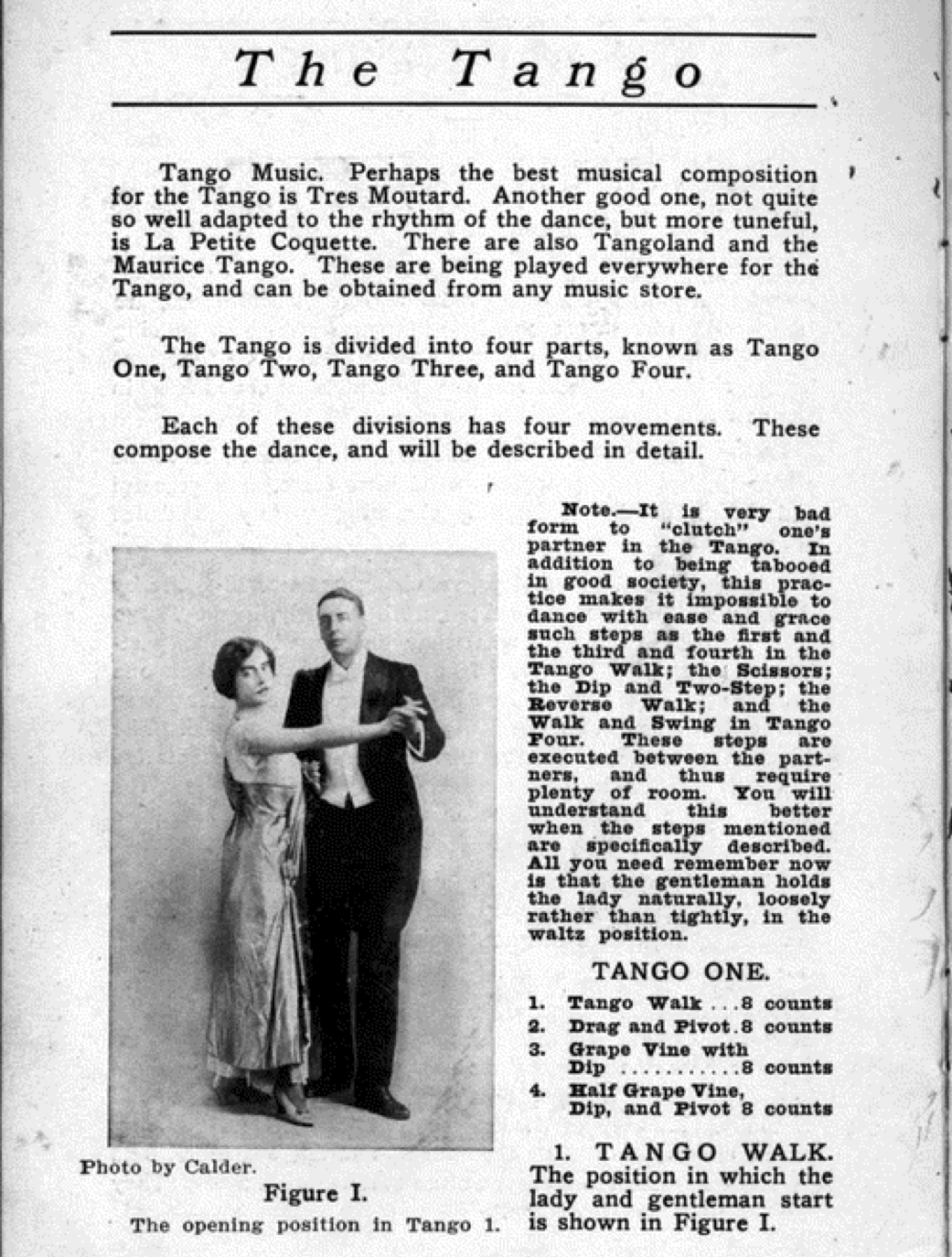
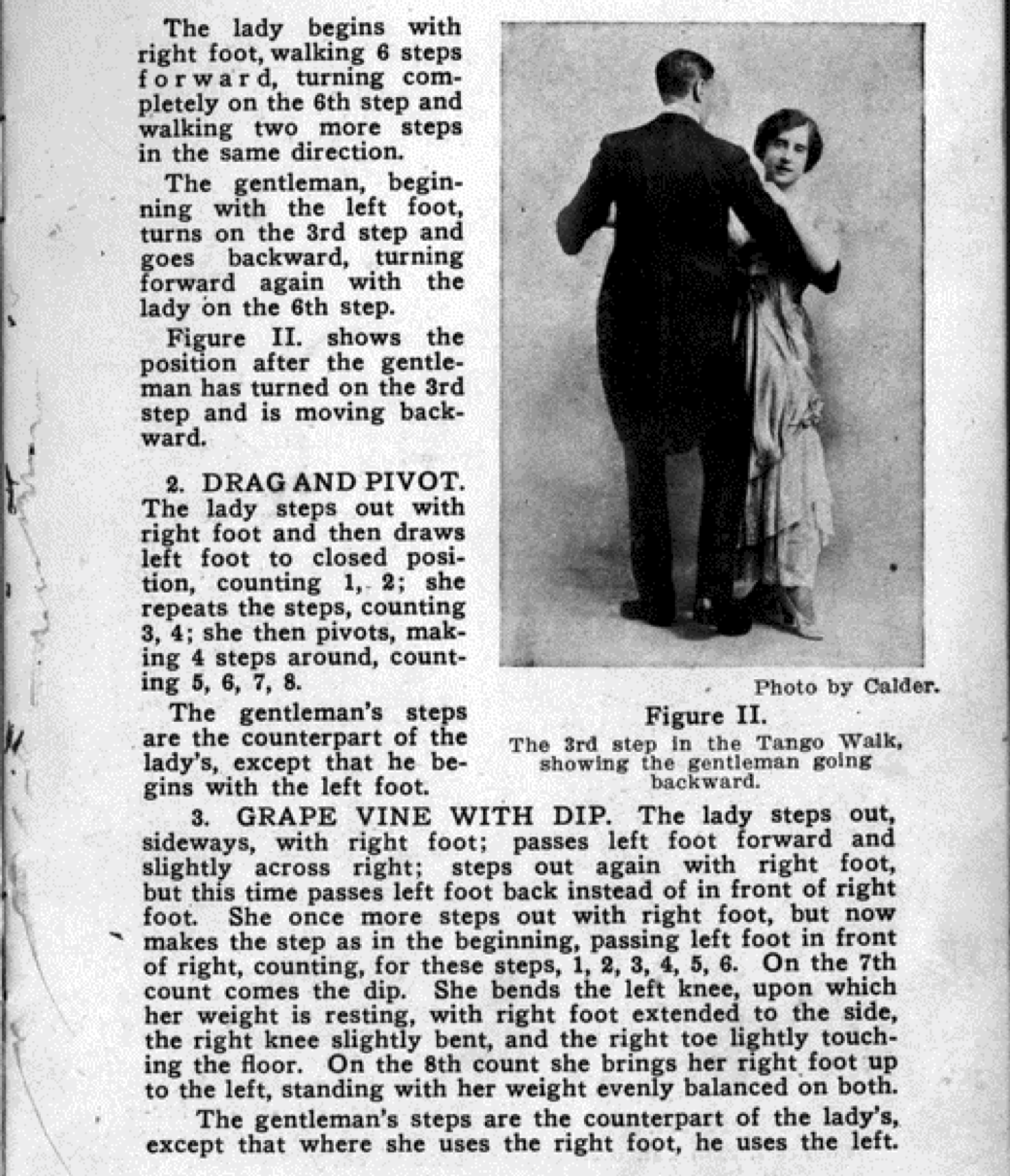
Two-Step Tango (Clendenen, Dance Mad [Early 1914 Edition], 1914, p. 35):
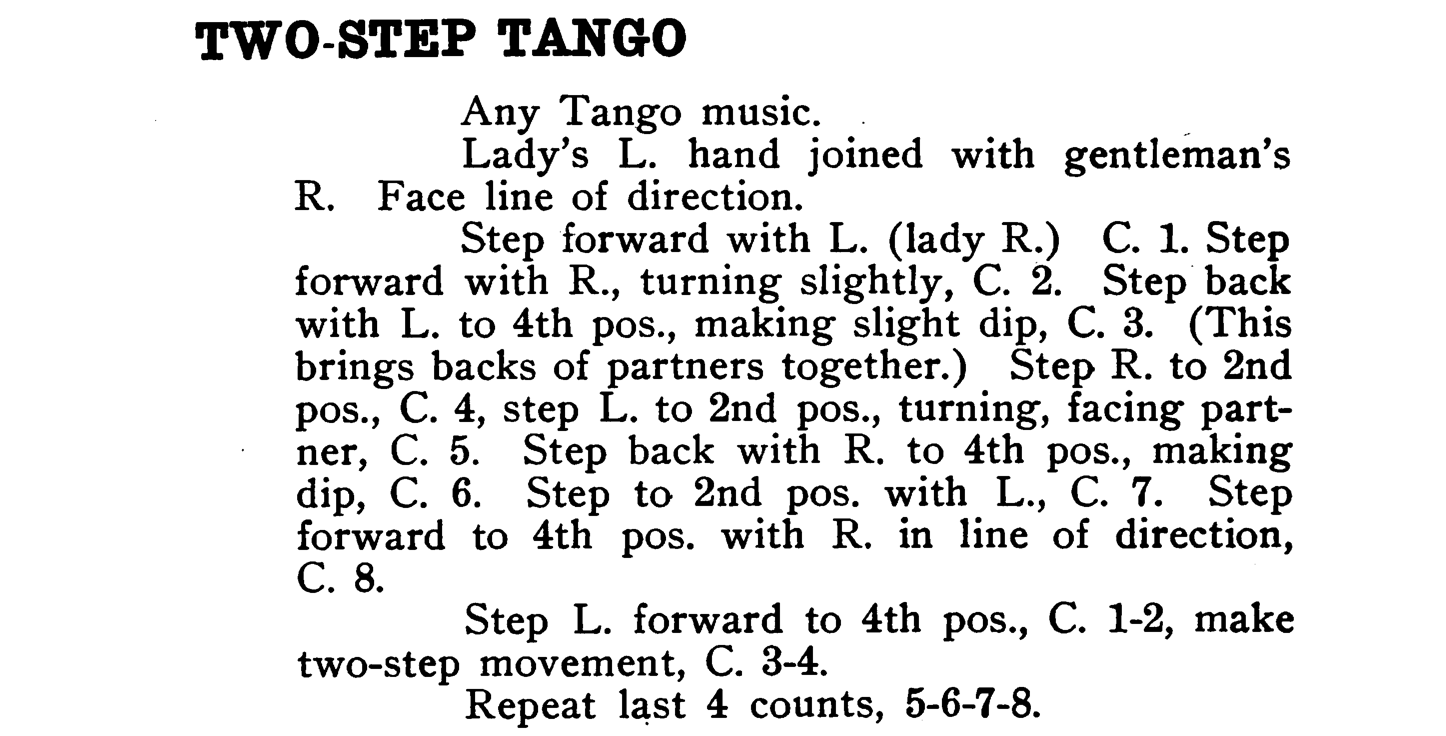
Two-Step Tango (Clendenen, Dance Mad [Late 1914 Edition], 1914, p. 23):

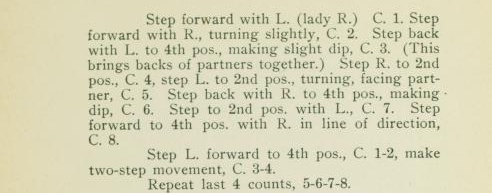
Back the Follow an uneven number of steps, starting on the Lead's right. The steps are "made lightly as if one did not wish to make a noise when stepping."
Point left back (1), step back left (2), step back right (3), step back left and draw right to side of left (4).
Variant 1: Half of the Pas Corte, just counts 1 and 2.
Variant 2: Same order of steps, but 1 and 2 are backward, 3 and 4 forward.
The classic Northern Media Luna box step in QQS timing. Can be done in a square, or "turning as in the waltz."
This is the square version of L'Eventail.
Promenade two steps (1, 2), point forward (3), turn in to face partner (4). (A variant leaves out facing your partner.)
Then there is a long choreography made up of these Tango steps, but it is noted that "those who are expert dancers of the Tango do not follow any particular sequence of steps: this, however, requires considerable practice."
Parisian Tango (American National Association Masters of Dancing, Description Of Modern Dances, 1915, p. 13):
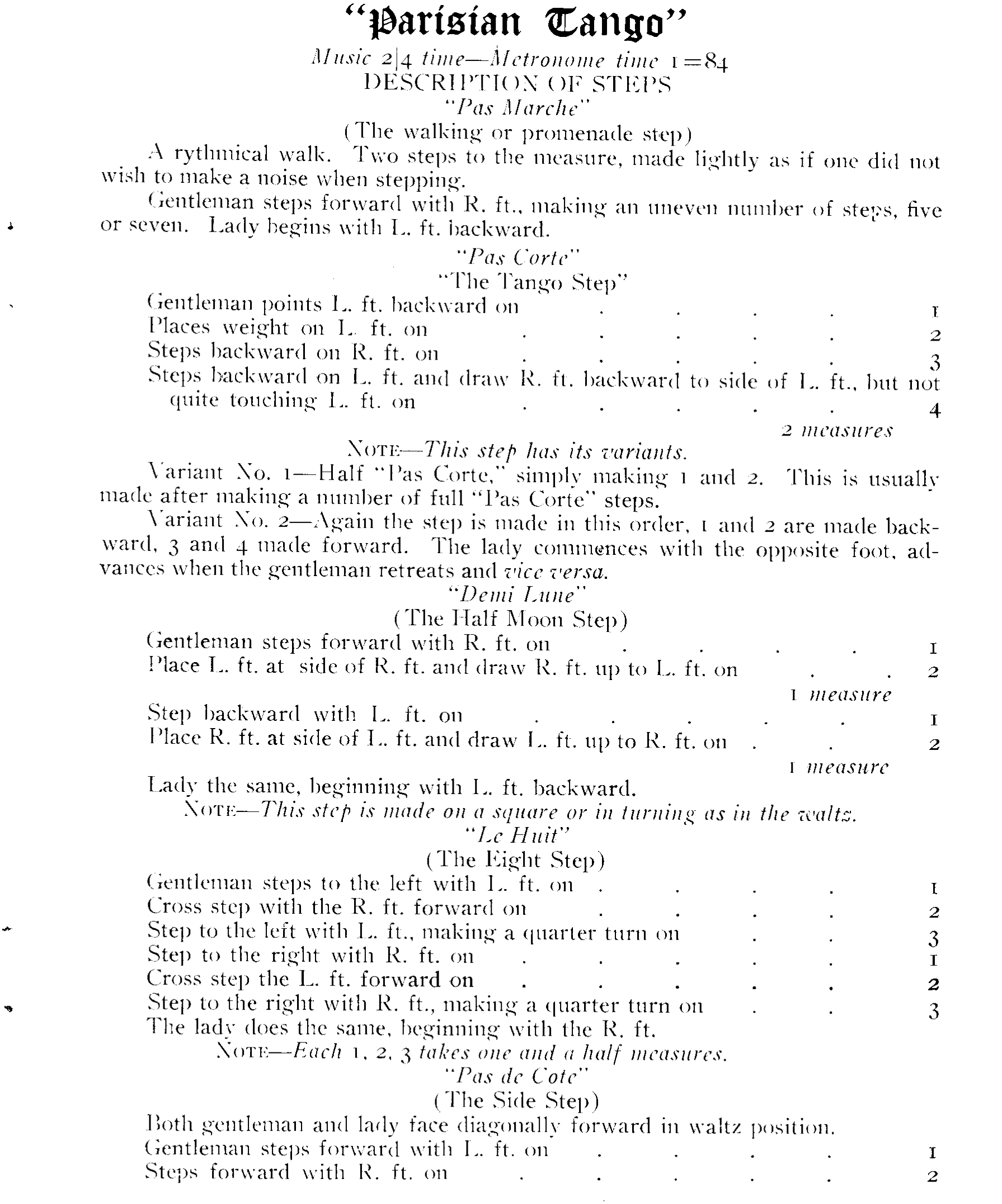
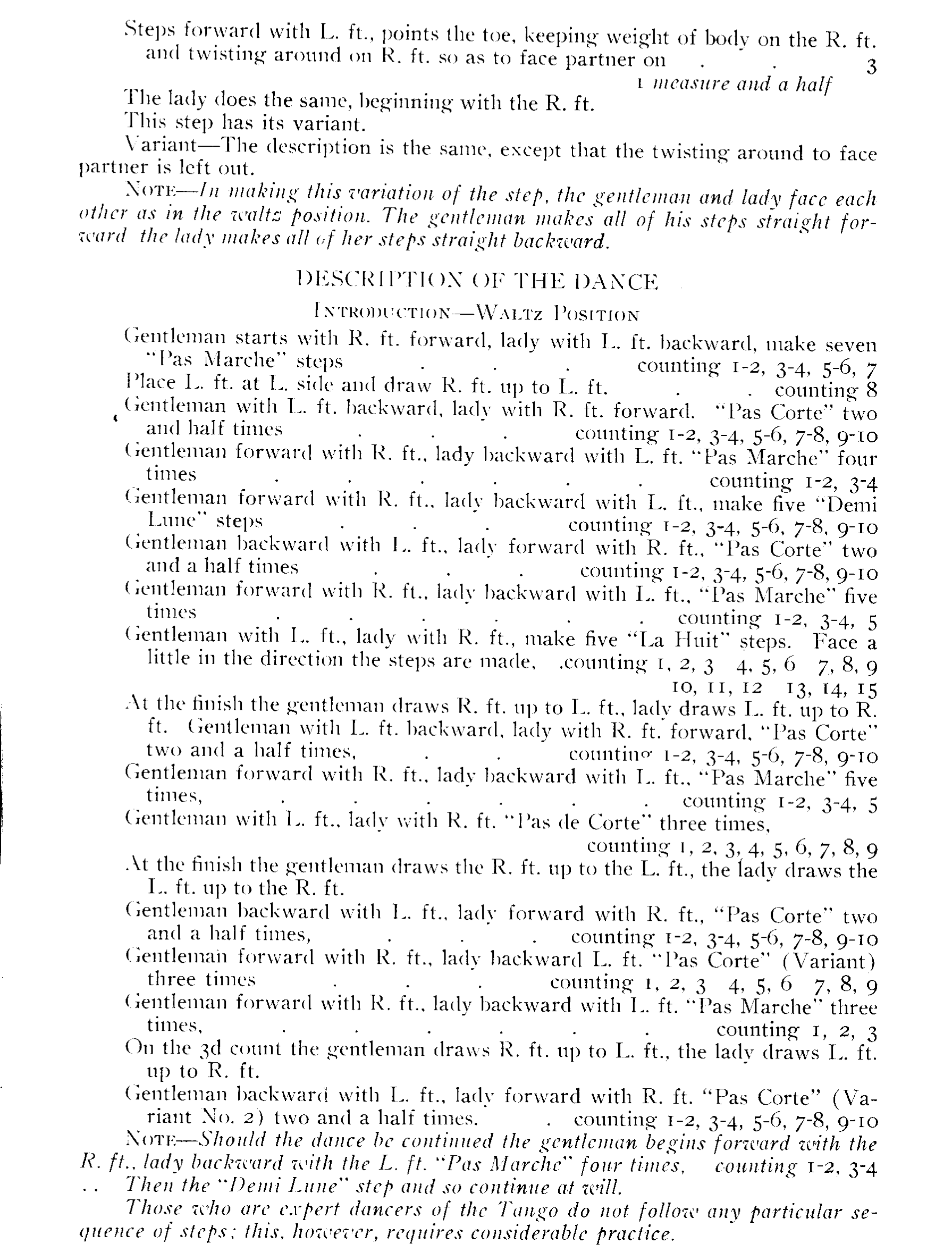
If you or your community is interested in learning Early Tango, .
© 2015-2017 Nick Enge
For more dance descriptions, see our three books on dancing:
The Book of Mixers: 100 Easy-Teach Dances for Getting Acquainted (2022) by Richard Powers and Nick & Melissa Enge,
Cross-Step Waltz: A Dancer's Guide (2019) by Richard Powers and Nick & Melissa Enge, and
Waltzing: A Manual for Dancing and Living (2013) by Richard Powers and Nick Enge.
Home About Dances Manuals Search